- Search Please fill out this field.
- Manage Your Subscription
- Give a Gift Subscription
- Sweepstakes
- Airlines + Airports

20 Tips First-time Fliers Need to Know
Whether you're flying domestically or internationally, here's how to make your first flight more enjoyable.
Congratulations, you’ve booked your first flight! Pat yourself on the back, because there are only a few more steps between you and a seamless flying experience. If you’re like most people, exploring something new — like the cabin of an airplane — can be daunting. While not every first-time flier will mistake the emergency exit for the bathroom, there are some common errors newbie travelers frequently make. To help you have a smooth and stress-free journey, we've compiled 20 tips first-time fliers should know.
Book a specific seat.
If you prefer aisles or windows to middle seats, be sure to choose your seat early. Select your preferred option when booking your ticket or log onto the airline’s website before your flight. Many airlines list the airplane model on their ticketing page, but you can also use a third-party site like SeatGuru to view seat maps. Don’t see a spot you love? Sign up with the website ExpertFlyer , which alerts you when your seat of choice frees up and is available to book.
Download your airline's app.
Skip the long lines at the airport by using your airline's app to check in, grab your boarding pass, and head straight to security. You can also use the app to check your flight status, including delays, cancellations, or gate changes in real time. Many airlines let passengers access in-flight entertainment through their app, so download it in advance if you want to watch movies on your own device.
Buy travel insurance.
Even if you plan everything perfectly, things can go wrong when you travel, from flight delays to lost luggage. Travel insurance can compensate you for some of these expenses and, at the very least, provide you with peace of mind. Whether you're looking to purchase flight insurance or a comprehensive plan that covers medical expenses like emergency evacuation, plenty of options are available. Some credit cards offer some degree of protection, such as lost baggage or flight cancellation insurance, so it's worth checking your perks before your trip.
Pack light.
The general rule when you pack for a trip is that you don’t need as much as you think you do. Traveling with only a carry-on can save you time at the airport and help you avoid the hassle of lost luggage, but you'll want to pack efficiently to maximize space. We've got a handy-dandy carry-on packing list to make sure you don’t overthink it.
Make sure your carry-on is the right size.
Domestic and international travel each have a different set of rules when it comes to carry-on bag sizes. Before you head to the airport with your carefully packed bag, check your airline’s carry-on size restrictions and if you have an additional tote, make sure it qualifies as a personal item.
Avoid packing large liquids in your carry-on.
If you’re not checking a bag, remember that carry-on liquids, gels, and aerosols have to be 3.4 fluid ounces or less and fit in a clear, quart-size bag. We recommend using a TSA-approved toiletry bottle set to transport your shampoo, conditioner, and other liquids without any issues.
Check your passport expiration date.
There is nothing quite like the panic that comes from booking a spontaneous vacation and realizing your passport is expired — or not realizing that you need a passport to visit Canada or Mexico. Adding to the challenge is that some countries won’t allow you to visit within six months of your passport’s expiration date in case you take an extra-long vacation. In short, it never hurts to check your passport’s expiration date and, if necessary, renew it before your next big trip. Also, if you're flying domestically, make sure your state-issued ID is valid for travel per TSA's identification rules .
Review your itinerary.
Traveling between time zones or around the world can be confusing. That’s why it always pays to take a tip from Santa Claus and make a list and check it twice. Go through your itinerary, confirm your airport (Did you book Heathrow or Gatwick? JFK or Newark?), your connection times (How long does it take to get to the train station? Which time zone is that?), and your plane tickets, including whether or not your name is spelled correctly on your documents.
While you’re working your way through the list, confirm your reservations for everything from hotels, flights, trains, buses, and tour groups.
Arrive at the airport early.
Most airlines recommend arriving at the airport three hours before an international flight or two hours before a domestic flight. If you're a first-time flier, give yourself extra time, especially if you’re flying during the holidays, traveling with kids, or checking bags. You can speed up the process by checking in online, booking a business class ticket with priority check-in privileges, flying with a carry-on only, or signing up for TSA PreCheck or Clear , which allows you to get through security faster.
Figure out your phone plan.
If you're flying out of the country, contact your service provider in advance to buy data roaming and an international calling plan. If you do not want to use your phone while traveling abroad but have it with you, shut off the data roaming on your device or risk a hefty phone bill. Download travel apps before your trip and use them when you’re on the hotel’s Wi-Fi or purchase a local SIM card so you text, call, and use data while abroad.
Be respectful of your fellow passengers.
Plane cabins are cramped spaces, so it's important to be mindful of how your actions impact the people around you. There are several unwritten rules of airplane etiquette, such as wearing headphones while listening to audio, avoiding smelly food and fragrances, and sticking to your assigned seat. Most of these are common sense, but it's a good idea to review some of the unspoken rules of air travel , especially if it's your first time flying.
Adjust to your new time zone as soon as possible.
If you're traveling across time zones, you'll likely experience jet lag. To quickly recover, get a head start on resetting your body's internal clock by adapting to your new time zone during the flight (or even a few days before you depart). On a long-haul flight, set your watch or phone's clock to the new time zone so you can sleep when it's nighttime in your destination and arrive feeling relatively refreshed. Plane cabins are notoriously dry environments, so staying hydrated and avoiding caffeine and alcohol while in the air can help you mitigate the effects of being at a high altitude.
Don't exchange too much money before you travel.
It’s a good idea to have some of the local currency on hand when you land, but don’t overdo it. Too much cash invites disaster if it’s stolen or lost. Figure out your budget and grab some cash at your bank or an airport ATM. If you do run out of cash, it’s easy to withdraw more at a local bank or ATM in most countries.
Alert your bank of your vacation plans.
There are few things more frustrating than having your credit card frozen when you’re on vacation because your bank thinks your card has been stolen. While most banks are now sophisticated enough to know when you're traveling based on your recent purchases (e.g., flights, hotel reservations, etc.), you may want to notify your credit card company’s fraud department that you’re leaving the country just in case.
While you’re on the phone with your credit card company, ask them to send you a credit card with a chip in it (if you don’t already have one). While most places can still swipe your card’s magnetic strip, many countries are relying on chip technology for things like train ticket machines, gas stations, and food purchases. Having a chip card option can make your life easier when you travel.
Bring backup entertainment.
Most airlines offer free onboard entertainment, including movies and TV shows you can watch on a seatback screen or your personal device. Some carriers have limited options, so it's a good idea to check your aircraft's amenities while booking your ticket. In any case, it's wise to bring a book, laptop, or tablet you can use in case the in-flight entertainment system isn't available. Make sure you pack your charger or a portable power bank in your carry-on and bring your own headphones for better sound quality.
Wear comfortable clothing.
Whether you're taking a red-eye or a shorter domestic flight, you'll want to dress comfortably for the journey. Opt for loose-fitting, breathable clothing, including an extra layer in case you get cold on the plane, as well as shoes you can easily slip on and off while going through security. Vacation is not the time to break in a new pair of kicks, so make sure you wear a tried-and-true comfy pair to the airport.
Bring your own snacks.
Don’t wait until you get to the airport to buy snacks for your flight. The restaurants and stores after security are notoriously pricey and often have limited options. Instead, pack your favorite nibbles that comply with the TSA’s rules. Stick to solid food items that don’t require refrigeration, such as protein bars or dried fruit and nuts.
Schedule a recovery day.
Many of us have limited vacation days, meaning we have to cram a lot of sightseeing, culture, food, and relaxation into an incredibly short time span. While you might be tempted to hit the ground running as soon as you land, scheduling some downtime after your flight can help you fully recover from any fatigue or jet lag. The same goes for the flight home — if you can, take a day off to relax and unpack before diving back into your usual routine, or you might end up needing a vacation from your vacation.
Use credit cards for purchases.
Back in the day, travel lore was to stick to cold hard cash (or traveler’s checks) while abroad. These days, the best exchange rates are often found using your credit card. When the sales clerk asks if you want the charge in dollars or the local currency, always opt for the local money as you’ll usually end up with a better rate.
That said, check whether your credit card charges foreign transaction fees and, if it does, apply for a new one before your trip. Chase Sapphire Preferred card and Platinum American Express are just two options that don't charge these fees.
Don't panic if things go wrong.
Follow Douglas Adams' advice from The Hitchhiker’s Guide to the Galaxy : “The most important thing a traveler needs to remember whether making their way through time and space or simply to Cleveland is this: Don’t Panic.” Things happen both at home and on the road and while missed connections, lost train tickets, or disappearing hotel reservations can be incredibly frustrating, panicking helps nothing. Stay organized and keep a cool head. By the end of the trip, you’ll probably have a great story to tell.
:max_bytes(150000):strip_icc():format(webp)/Julia-Eskins-Headshot-Julia-Eskins-2000-422db59e8e3a4b15b4c26bc7bfa75413.jpeg)
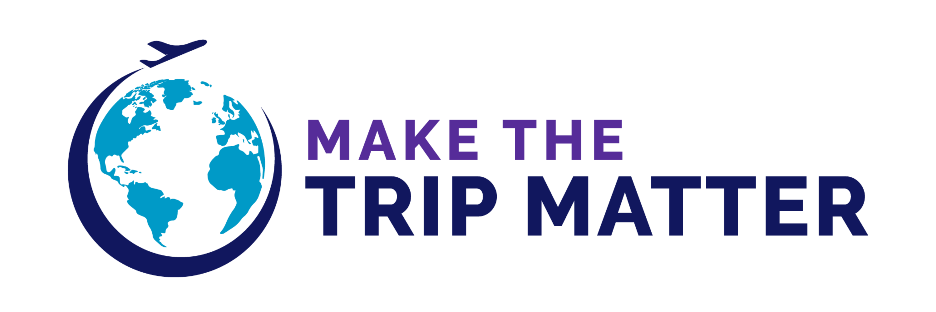
First Time Flyer Guide and Checklist: Top 50+ Tips

From the first time I can remember flying as a kid, my parents would have me “lead” them around the airport and ask me to figure out what we had to do next. Even still, I was a nervous wreck on my first solo trip as an 18-year-old! But the trip went smoothly, and I quickly realized how EASY it can be to fly . This post gives advice for first-time flyers and a detailed airport guide and flying checklist to alleviate any stress before flying for your first time.
What Is It Like Flying for the First Time?
Flying for the first time is not nearly as scary as it feels like it will be!
Did you know that air transportation is actually the SAFEST form of travel?
My best piece of advice for first-time flyers is to be prepared for their flight (just follow this guide!) and know what to expect because the most stressful part of flying for the first time is getting through the airport.
Once you are on the plane it’s just a matter of relaxing until you land!
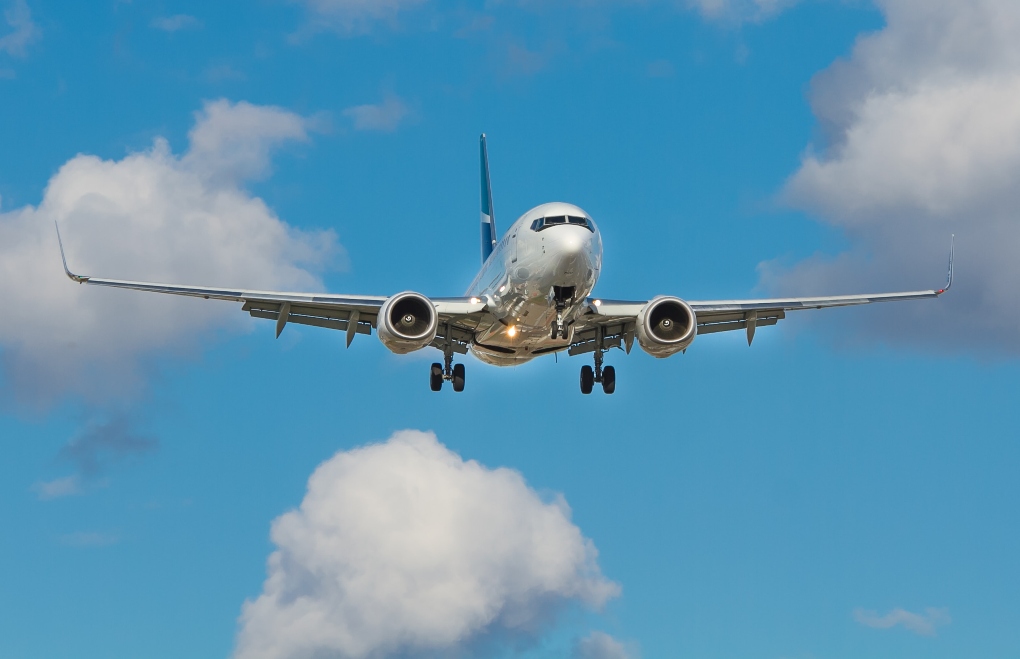
The actual experience of being on an airplane, I think, can be quite fun. Take off and landing will feel a bit like being on an elevator or a very calm rollercoaster. The airplane will begin to “taxi”, which is where they drive around the airfield to get into the proper position on the runway. Then, the plane will speed up and lift off.
When you get close to landing, there will be an announcement letting you know to prepare for landing. Landing is much quieter than take-off, the only thing you might feel is a small jolt when you touch down.
There may be some turbulence during your flight, this is normal! Turbulence happens when the airplane goes through a patch of irregular air. The captain may warn you first if there is a big patch of turbulence, but for the most part, it will just feel like light bumps and is nothing to worry about.
The ONLY Checklist You NEED for a Trip Abroad
Even after traveling the world… I STILL use this list before every trip!
Unsubscribe at any time.
How Do You Calm a First-Time Flyer?
It is normal for people to feel anxious about their first flight. If you or someone you are traveling with is on their first airplane, the best way to calm them is to prepare them. Become familiar with the process of going through the airport and what to expect during the actual flight.
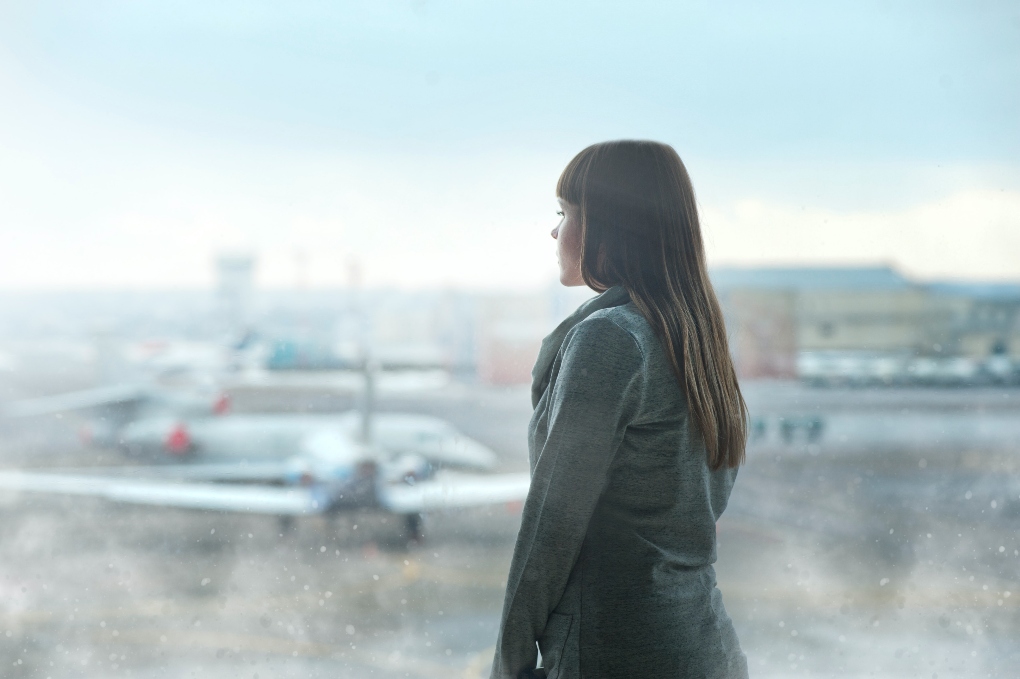
Something that helps me is reminding myself that air travel is the safest form of travel, it’s FAR safer than driving even, which we do all the time.
If you want to know the statistics: There is 1 fatal accident per 16 MILLION flights. With fatal car crashes, the odds are 1 in 144. Insanely higher! So just remember that you are much much safer on an airplane.
Tips for First Time Flyers With Anxiety
Anxiety is normal for many people who travel by air. Even I can get a bit anxious on a plane, and I have been on more planes than I could even begin to count in my life. Here are a few helpful tips for a first-time flyer’s guide to experiencing anxiety:
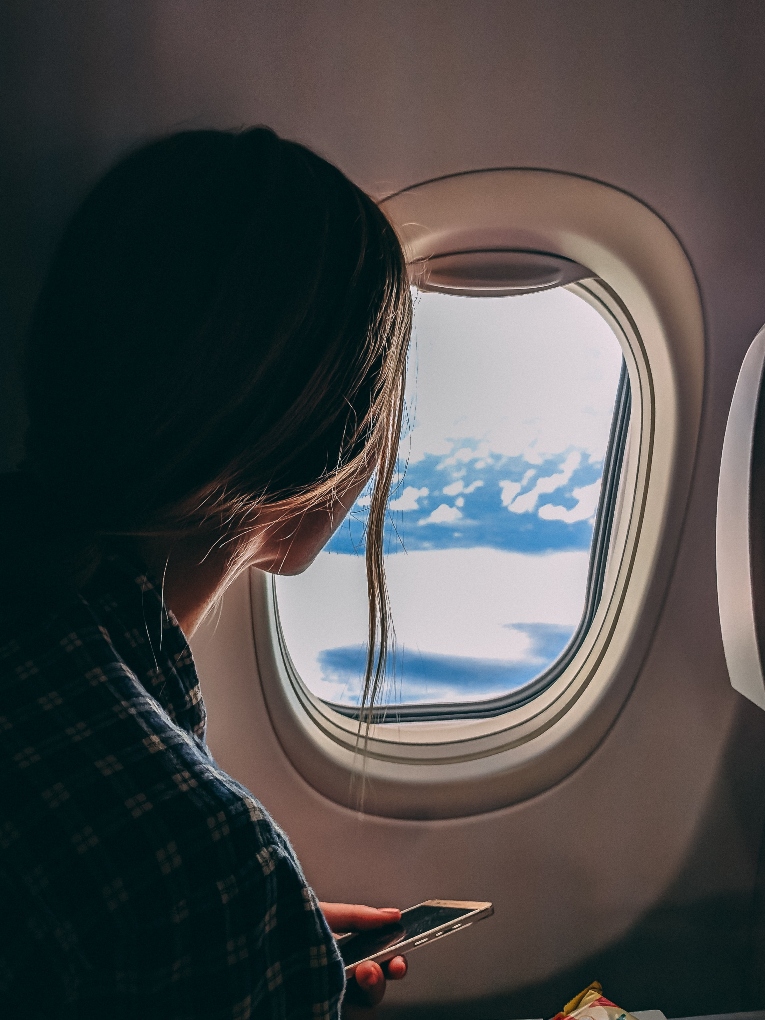
- Get to your gate early. A big part of people’s anxiety starts with worrying about missing their flight.
- Being at your gate early lets you settle in. Take a walk, do some light stretches, or start listening to a calming book or music.
- For some people, having a drink or two (just don’t go crazy!) beforehand might help to calm the nerves – it’s why airport bars are popular!
- On the plane, if turbulence or something is making you anxious, practice calming breaths and clearing your mind of the anxious thoughts.
- Some flyers find it comforting to walk the plane and do some light stretches in the back.
- When we hit especially bad turbulence, I focus on breathing in and out slowly and repeating a phrase that calms me down. Often, I have to repeat, “It’s just a bit of turbulence, we’ll be through it soon.” Even though I logically know turbulence is completely normal!
- If you are prescribed anxiety medications , make sure to take your meds regularly or ask your doctor about how to take them to help specifically with flight anxiety.
ONE OF THE BEST PRODUCTS FOR FIRST-TIME FLYERS Memory Foam Neck Pillow + Eye Mask + Ear Plugs
Can I Use My Phone on a Plane?

Yes, you can use your phone on a plane if it’s in airplane mode. Some airlines and flights may ask that you turn your phone off completely during take-off and landing, especially if there is a bout of bad weather or the airport is busy.
For the most part, you can use your phone throughout the flight so long as airplane mode is turned on. This means you will not be able to use data but will have all other phone functions. Most airlines nowadays offer WiFi onboard the plane , but almost always for a fee.
What Do You Do at an Airport for the First Time?
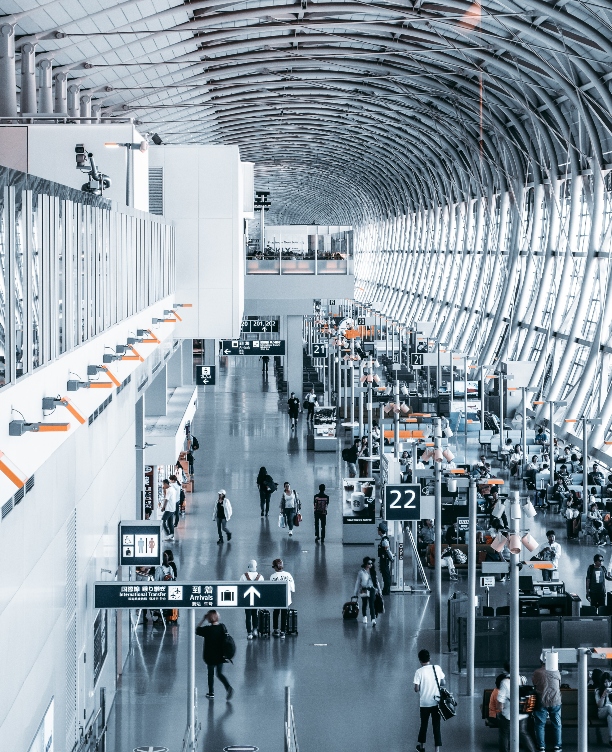
This first-time flyer guide will outline what to expect for flying and exactly what to do at the airport step by step. Some airports are big and confusing, others are small and straightforward. Either way, once you know what to do at the airport it will be easy to navigate any airport , as they all follow the same structure.
Enjoy being at the airport! Maybe I’m just an oddball travel junkie, but I think airports are so much fun. There is great people-watching and seeing the destinations on the boards makes me think about all the possibilities of places to visit and how big the world is.
BUYING PLANE TICKETS FOR YOUR FIRST FLIGHT
1. how to pick your destination.
If you don’t already have a destination in mind but know you want to take a trip, there are a few things to keep in mind:
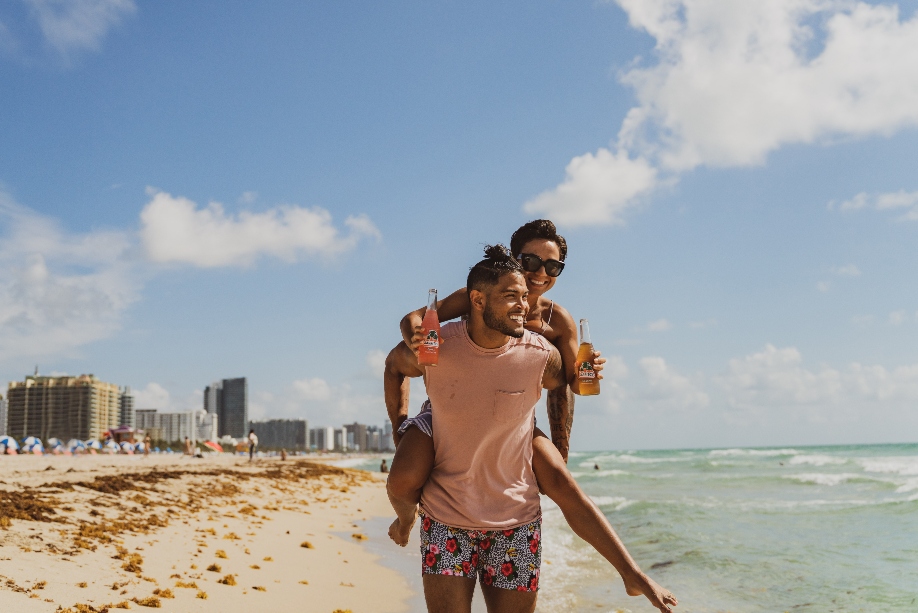
- Weather – What time of year are you trying to travel? Look up the weather of your possible destinations during this time of year.
- Length of flight – For your first flight it might be better to pick somewhere closer that has a shorter flight.
- Price of flight – If you aren’t familiar with flying, you won’t have much of an idea of the price range of flights. Use a search tool such as Skyscanner to check for destinations and see what options for pricing you will have.
- Accommodation availability – There is nothing worse than buying a flight somewhere and THEN realizing there aren’t many options for places to stay or the options are out of your budget.*
- Be spontaneous – My favorite thing to do is pull up Skyscanner’s “Search Everywhere” tool and see what cities or locations have the best deals and cheapest flights. This is the perfect tool for someone who has a time frame in mind for a trip, but no idea where to go.
❗ *Still looking for accommodation? I use HostelWorld to find the best global hostels and Booking.com to find the best global hotel deals.
International vs Domestic Flights:
As a first-time flyer guide, it will be easier to pick somewhere domestic. However, first-time flyers shouldn’t be afraid of going international! There are so many amazing places to see, don’t limit yourself to staying local . For your first time going international, try to pick somewhere with a familiar culture and/or a language you speak.

💡 Browse through some of my destination guides for inspiration , and take a look through my travel resources page for the best tools that I use for both domestic and international trips.
2. How to Buy Plane Tickets
Once you know where you want to go, the next step is keeping an eye on flight prices. If you have an airline you have been recommended or have researched and would prefer to use, it’s best to just keep an eye on their website directly .
Otherwise, do some initial searches on flight prices to see if they are in your budget. If they are a little high, or you are far enough out you have the flexibility to see if the price will drop, then set up a ‘flight alert’ on Skyscanner to get notified when the ticket price goes down.
3. When to Buy Plane Tickets
Generally, you want to book plane tickets well in advance of your trip. Occasionally you can find great fare drops right before the flight, but that is a pretty risky gamble as they usually actually spike in price the last few. days before a flight.
For domestic flights, roughly 3 weeks to 3 months is a good time to buy tickets.
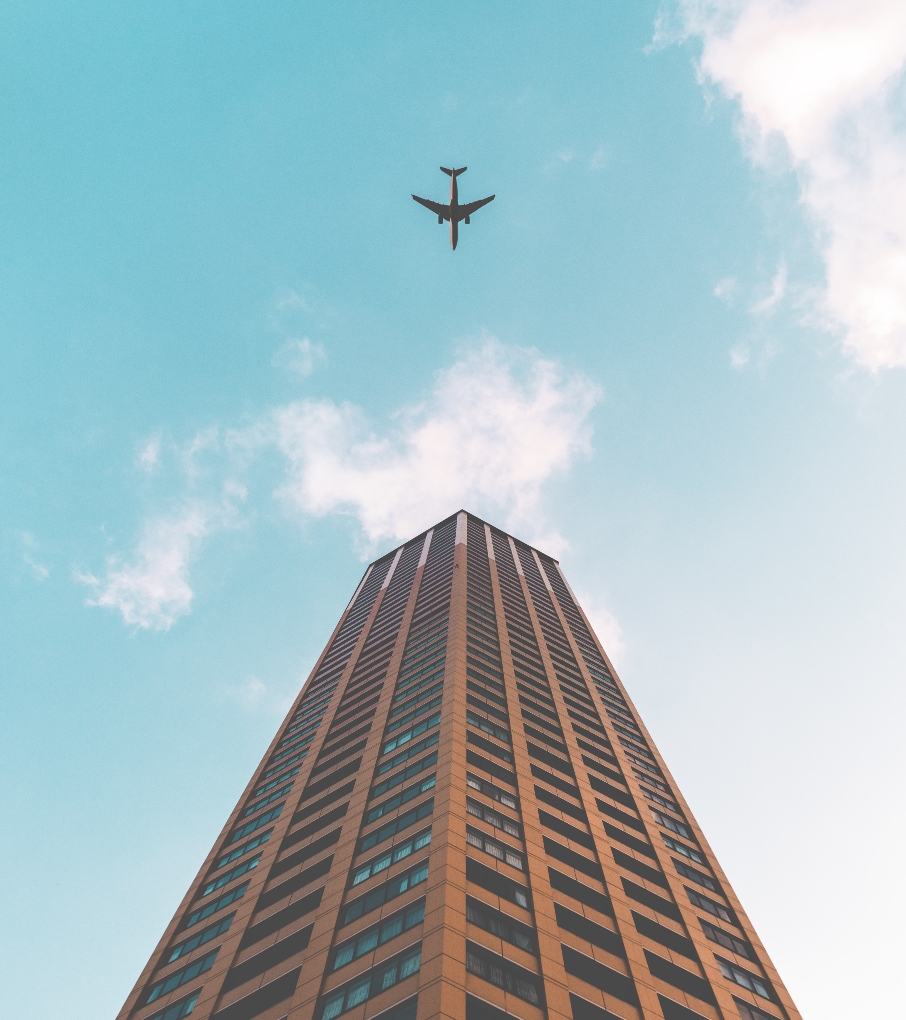
For international flights, give yourself even more time. Book at least one month out, but the best times to book range from three to five months out.
Keep in mind the time of year you will be flying in too. If you are flying during popular travel times such as the holidays or the summer, you probably want to look at flights even further out.
Another tip : I book most of my flights on a Tuesday or Wednesday. Flight prices tend to drop by a little bit during the week.
4. Where to Look for Plane Tickets
There are quite a few flight search engines that claim to find the best prices. Buying affordable plane tickets is the art of finding the right timing, staying patient, and researching across platforms.
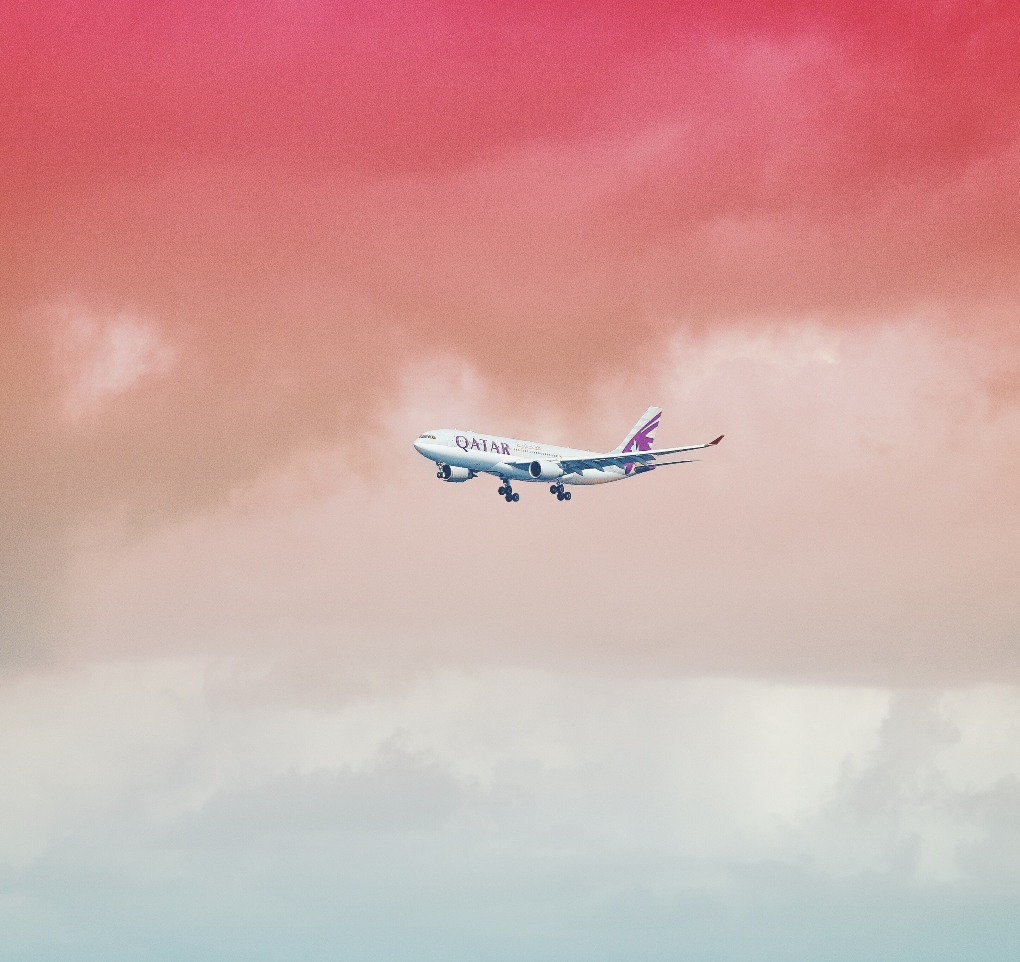
The best way to buy plane tickets is to buy directly from the airline if they have a decent price for the flight. Otherwise, these are the flight search engines that I use and recommend:
Going (Formerly Scott’s Cheap Flights):
This is a FREE email list that sends you flight deals and fare drops from your home airport. I highly recommend everyone to sign up for this free service, you never know when they will send a deal for somewhere you are looking to go.
This list is perfect for the spontaneous traveler who doesn’t have a destination in mind. I have found many great deals through Going , and my friend once found a roundtrip ticket to Australia from Los Angeles for under $500!
➡️ CLICK HERE TO SIGN UP FOR GOING
Skyscanner :
This is my favorite flight comparison tool for finding the best deals on flights. Skyscanner searches across airlines to find the cheapest flights. Plus, I love that you can search “everywhere” and “anytime” to find the cheapest flights. If you are flexible on the days you can fly, while searching you can see what days have the lowest prices.
➡️ CLICK HERE TO SIGN UP FOR SKYSCANNER
❗Is Skyscanner legit? Read my review of Skyscanner HERE
Google Flights :
This is another favorite tool of mine to check for cheap flights across airlines. Google Flights is easy to use and reliably provides great deals.
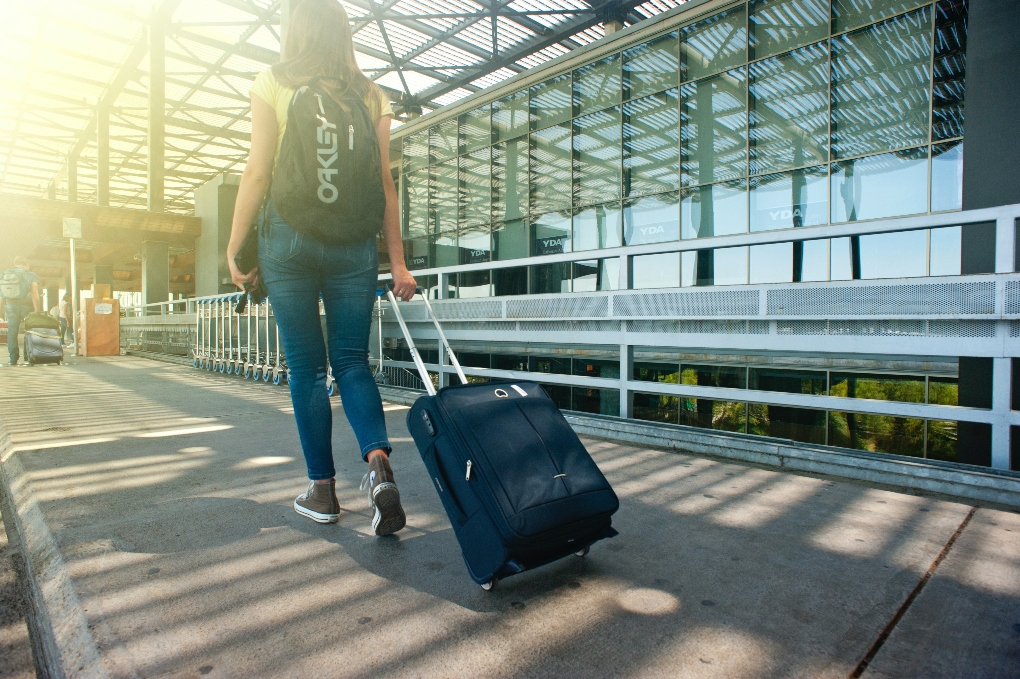
5. Understanding Flight Add Ons
Of course, buying plane tickets is never as straightforward as it should be. Airlines will upcharge for just about everything nowadays.
While buying your ticket you will have plenty of places where the airline tries to add on features (i.e. extra legroom, meal service, baggage options). You can look through each option and decide what you want to add to your flight, or simply skip through and stay with the base rate.
6. Choosing Your Baggage Needs
Pretty much every airline nowadays will charge you a fee for checking a bag . Most airlines will allow you one carry-on (a small suitcase size and has to fit in the overhead bins) and a personal item (either a purse or as large as a standard backpack).
The budget airlines might not even allow you a carry-on without an extra fee or weight restrictions.
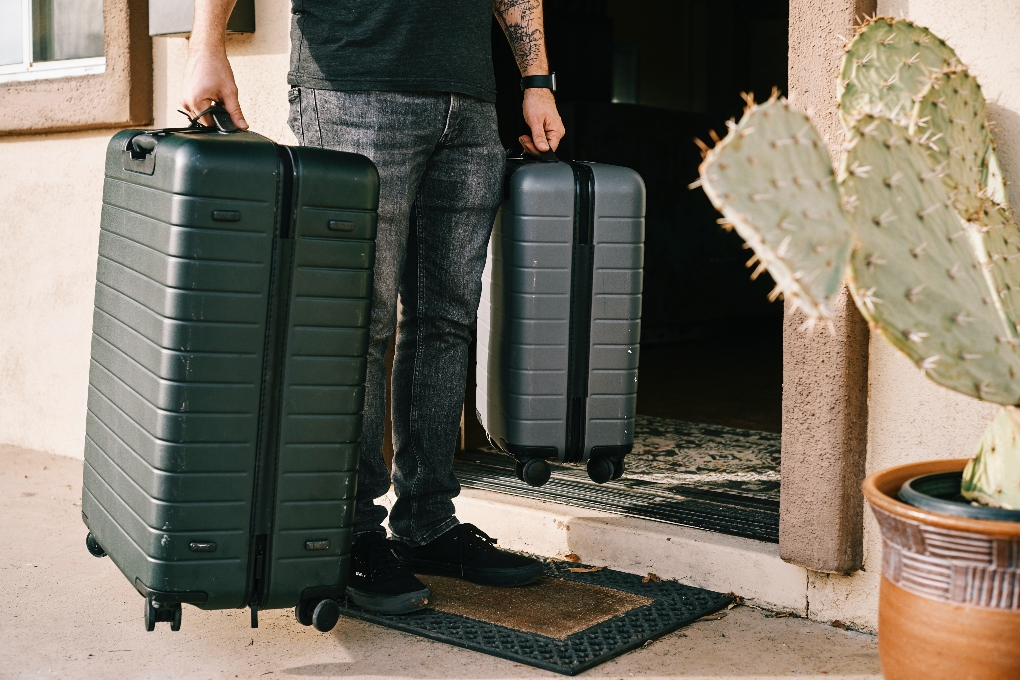
Usually while buying your ticket the airline will give you the option to choose how much baggage you will be bringing. Otherwise, check the airline’s website for their policy on baggage and what they allow to be carried on board. You will also be able to check online for the restrictions on dimension and weight that each airline allows.
🔻 One of the BEST travel carry-on backpacks! 🔻
Some flights will have a randomized seating selection, meaning it is the first available seating when you get on the plane. Most airlines let their passengers pick their seats ahead of time but may charge you to pick a seat and will certainly charge extra for better seats.
If you are traveling alone or are comfortable having your seat pre-assigned by the airline you might be able to save some money on not choosing a seat.
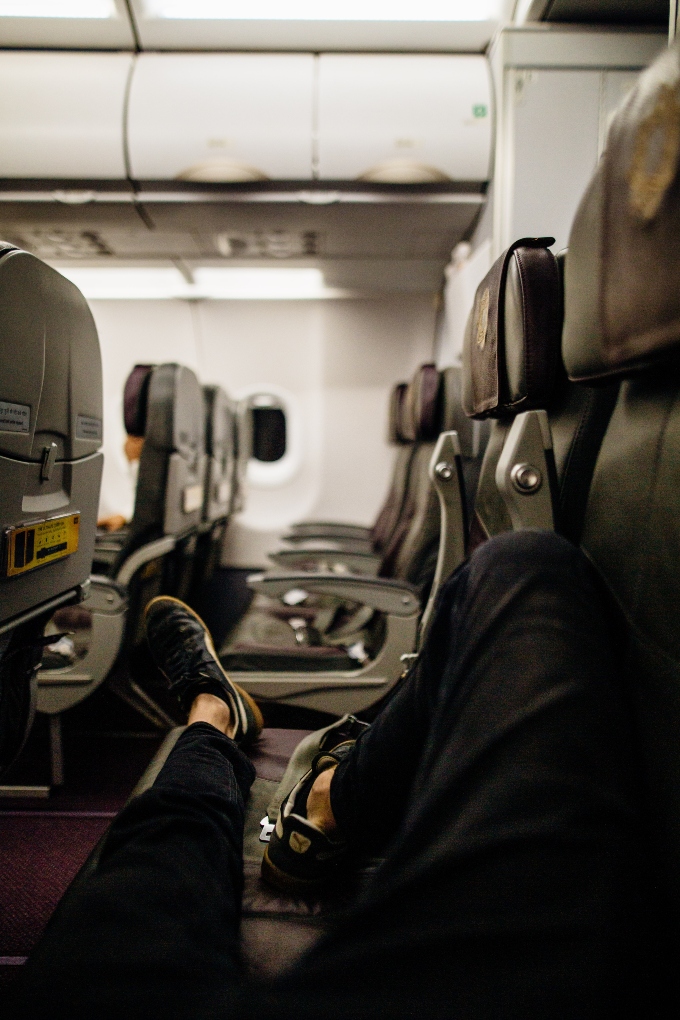
FIRST-TIME FLYER’S GUIDE TO PREPARING FOR YOUR FLIGHT
8. have the proper identification for flying.
To fly within the U.S. you will need a valid form of identification. As of May 7th, 2025 every passenger over the age of 18 will need to have a “Real I.D.” or a passport .
Depending on your destination and vaccination status, you may also need to show proof of a negative COVID-19 test or proof of vaccination.
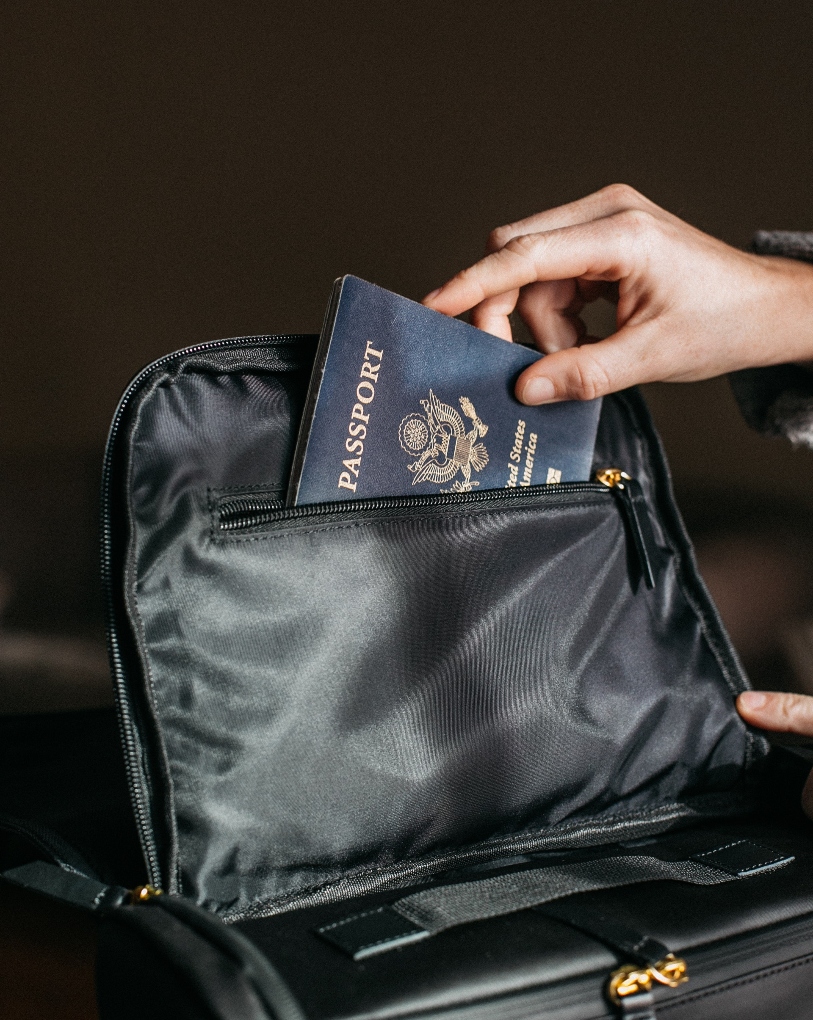
9. Buy Travel Insurance
Any time you travel you should always have travel insurance to cover you in case of an emergency. This is different from your normal health insurance and covers emergency travel situations such as delays, lost baggage, natural disasters, etc.
I use and recommend SafetyWing for medical and travel insurance. It is affordable, reliable, and flexible insurance that is specifically designed for digital nomads who will be traveling long-term, though it mostly covers emergencies which is perfect for short-term travelers and first-time flyers as well.
For an idea of how much insurance will cost you, use the tool below. Or, to purchase insurance directly from SafetyWing, CLICK HERE.
10. Know When Flyers Need to Be at the Airport
Domestic flyers:.
The standard recommendation for domestic flights is to arrive 2 hours before your flight.
This is to give you plenty of time to check in, check your bag, make it through security, and arrive at your gate before boarding starts.
As a first-time flyer’s guide, I encourage you to stick to this recommendation to give you plenty of time to make your way around the airport without worrying about being late.
However, if you are not checking a bag and you are at a smaller airport, you might have more wiggle room and could probably arrive an hour and a half to one hour before your flight, depending on your comfort level.
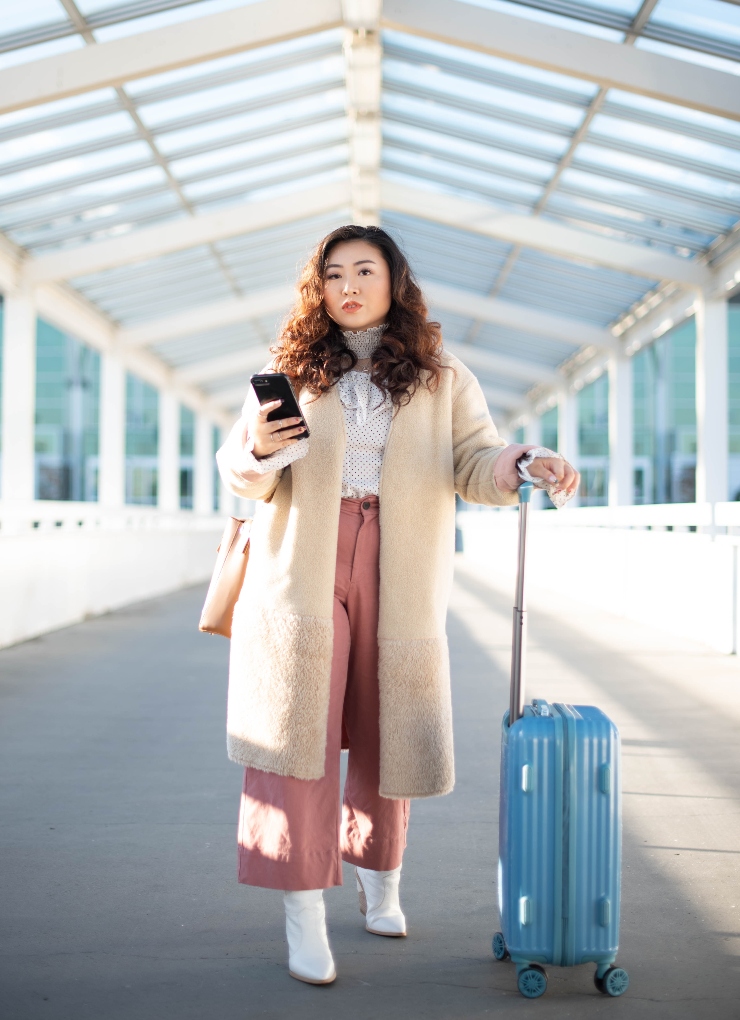
International Flyers:
The standard recommendation for international flyers is to arrive 3 hours before your flight.
11. Research How to Get To and From the Airports
If you aren’t familiar with where your airport is, research how long it will take you to get there and how you plan on getting there. If you need to park your car at the airport, you should know where to park it and how much it will cost.
Same thing on the arrival side, make sure you know how you will be getting from the airport to your accommodation at your destination.
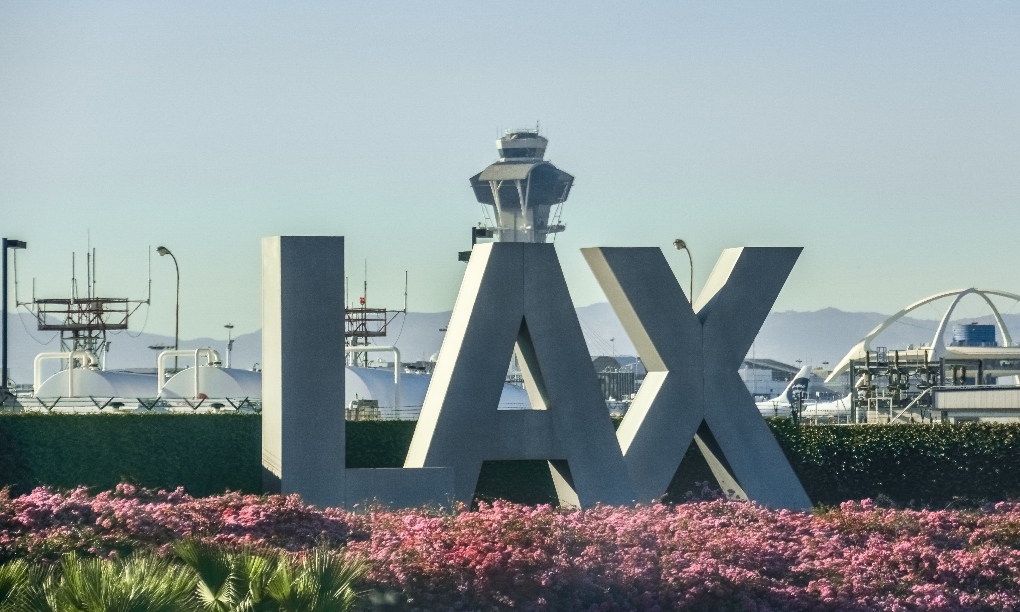
❗ Do you need to rent a car for your first time flying? I recommend DiscoverCars for finding the best deals on rental cars during your trip.

12. How to Dress for Your Flight
People dress in a wide range for flights from comfortable to business-appropriate , so there is no right or wrong way to dress for your first time flight.
I recommend layering for your flight (or at least having a light sweater handy in case you get cold on the plane) and wearing clothes and shoes that are easy to remove for security.
Take into consideration the climate of where you land as well.
13. Prepare Your Entertainment
Some flights will have an entertainment system built into the seats. For shorter flights, your airline either won’t have in-flight entertainment or you might have to pay for it. For long flights (especially international ones) the airline might have free movies, TV shows, music, etc.
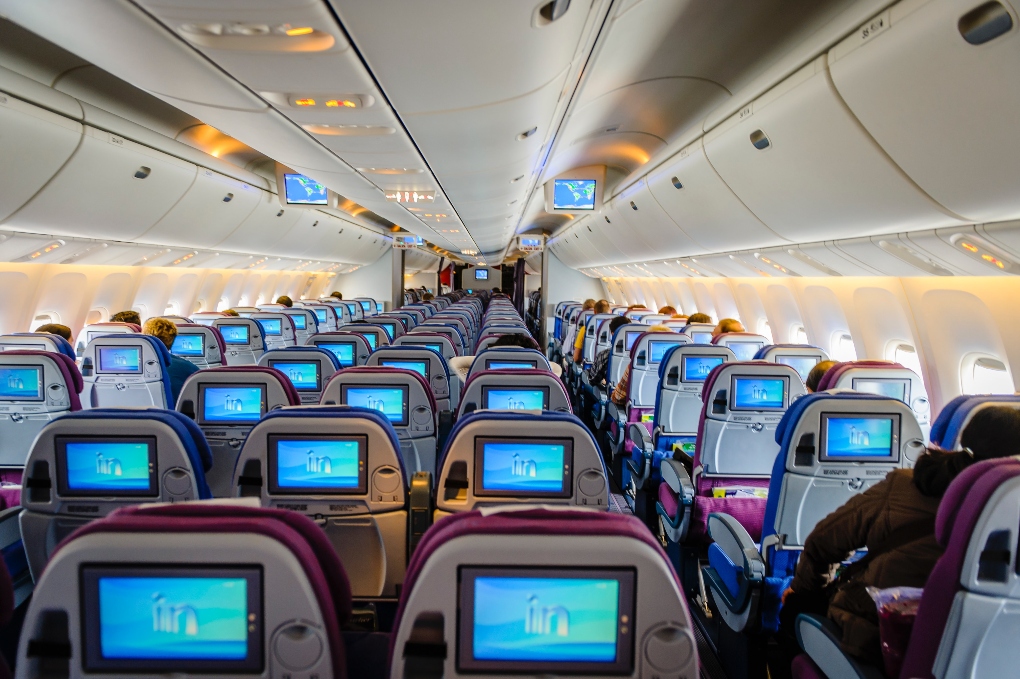
Beyond in-flight entertainment and bringing your own reading material (i.e. books, magazines), I recommend doing the following before your first time flying:
Download Apps:
If you want games (especially if you’re traveling with kids) or other apps that you can access without WiFi, make sure to download them ahead of time.
Download Books, Movies, Podcasts etc.:
I always make sure to download entertainment for myself onto my phone so I can use it in airplane mode. You can download shows on your Netflix app, or Podcasts and Books off of various apps.
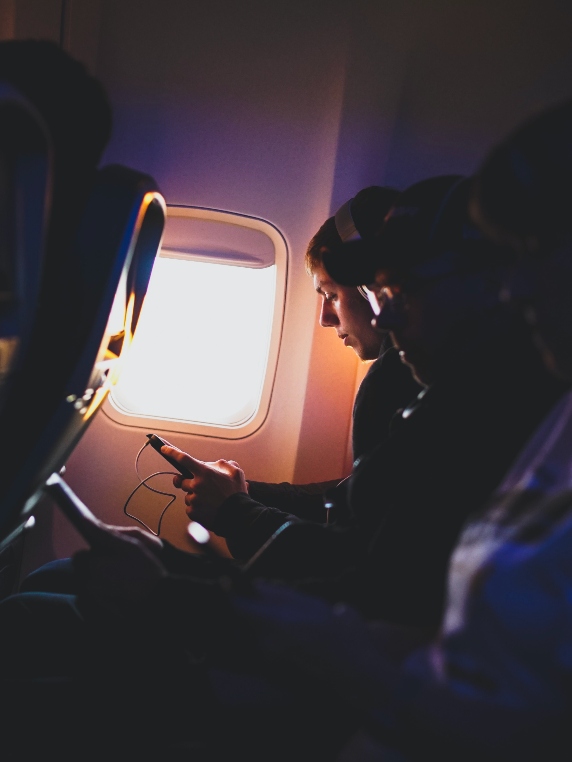
Airport WiFi:
Almost all airports should have free WiFi available . If you have a smartphone, I recommend downloading the app (where applicable) for your airline. Often you will be able to use the app to be alerted to any flight or gate changes.
14. Pack Snacks
If you want to save some money on airport food, pack snacks! Most food should be fine to go through security, they may just ask you to take it out.
15. Prepare Your Foreign Currency
If you are traveling internationally, you might want to exchange some money ahead of time . Your local bank should be able to exchange foreign currencies. There is no need to travel with too much cash as that can be risky and exchange fees likely won’t be in your favor.
Get enough ahead of time that you have money for transportation and maybe some food and ‘just in case’ cash. Using ATMs or money exchanges at the airport upon arrival can be overpriced .
⭐️ But PRO TIP , get the Charles Schwab debit card (it’s free to open a checking account ) to receive unlimited ATM fee rebates for cash withdrawals worldwide. This card has saved me so much money while traveling!
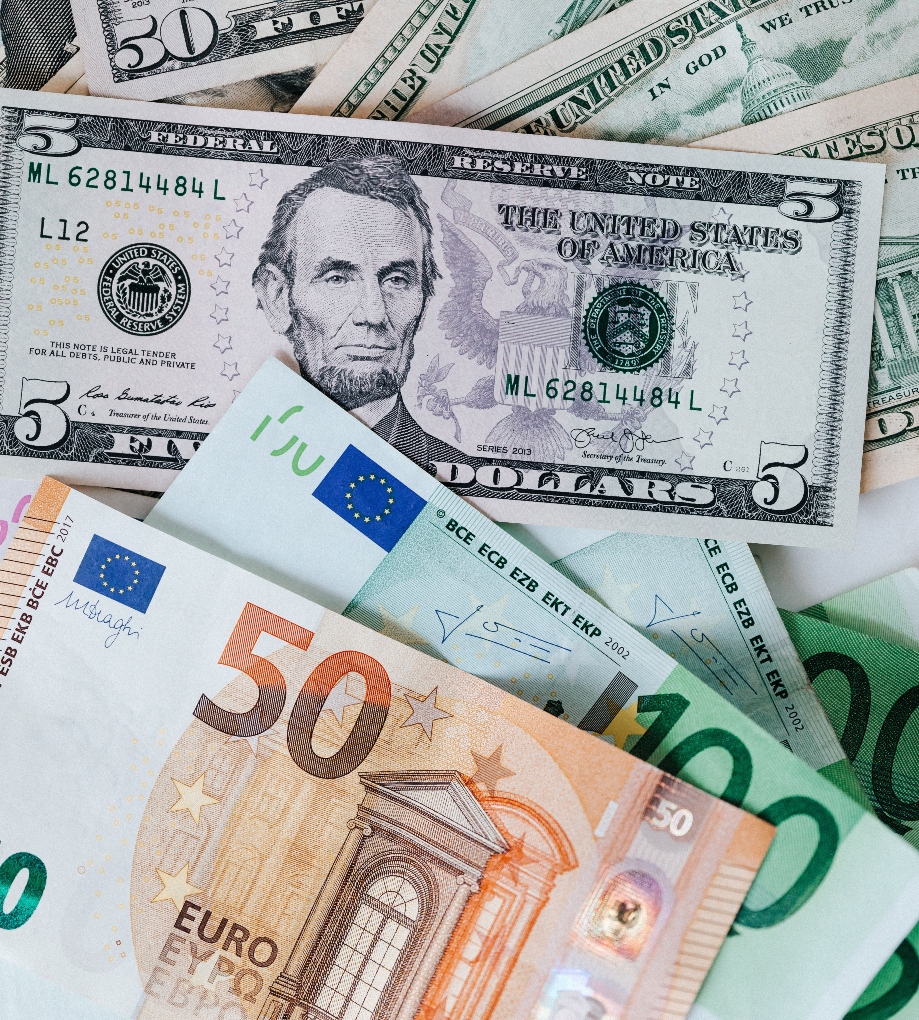
FIRST TIME FLYER’S GUIDE TO CHECKING IN FOR YOUR FLIGHT
16. checking in online.
You can either check in ahead of time or do it in person when you arrive at the airport. Most airlines will send you a link to check in to your flight 24 hours in advance .
You can typically confirm your seating and verify flight details or any add-ons at this time. If you check in online or through the app, you will receive a mobile boarding pass. Simply show this pass on your phone at security and the gate or print it out in advance.
Personally, I always check in online ahead of time if I have the option. Not only does it save time and the hassle of waiting in more lines at the airport, but I also like knowing that I am set for my flight in advance.
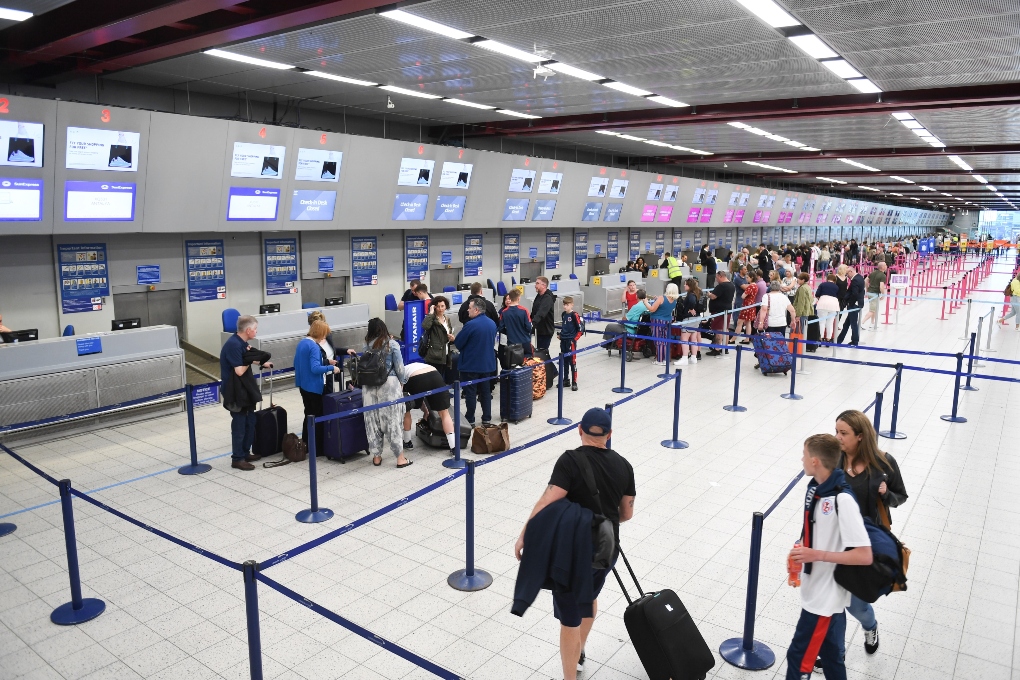
17. In-Person Flight Check-in
If you choose to check in when you arrive at the airport you will be looking for your airline’s check-in counter that lists your flight destination. You will be walked through the check-in process and able to check your bags at this point.
18. Checking a Bag vs. Only Carry-Ons
If you need to check a bag you will look for your airline’s bag drop-off or check-in counter . Most airlines have a designated bag drop area now for online check-ins. Though you still might have to wait in the check-in line, so give yourself plenty of time on arrival.
If you only have carry-ons and have already checked in online, you can continue straight past your airline’s counter and on to security.
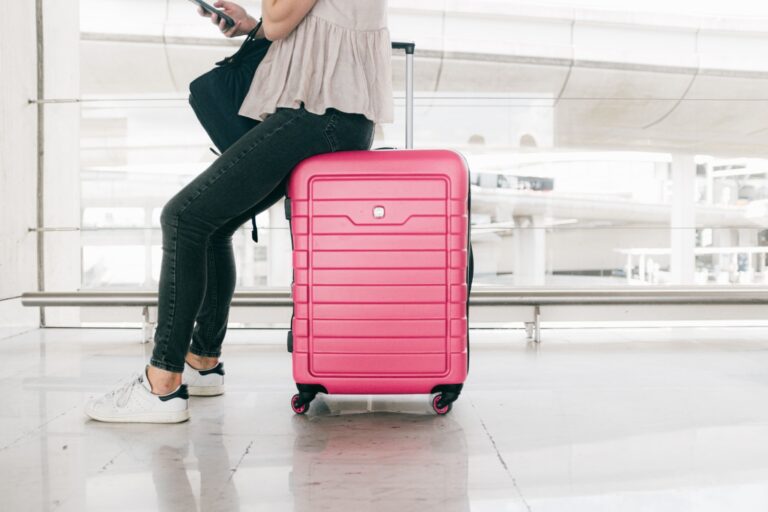
19. What to Do After Checking in
After you check-in, your next step is to head through security. Usually, at this point, you are just following the signs to get in the right line for security.
20. Asking for Guidance at the Airport
Don’t be afraid to ask for help at the airport! There are plenty of workers between those at the check-in counter, security, professionals with badges walking around the airport, etc. They know the airport very well and will gladly guide first-time flyers in the right direction if they get confused.
FIRST TIME FLYER’S GUIDE TO AIRPORT SECURITY
Airport security may seem like a daunting and complicated process, but you will get the hang of it quickly after the first time or two. Here is a first-time flyer’s guide to making airport security a breeze:
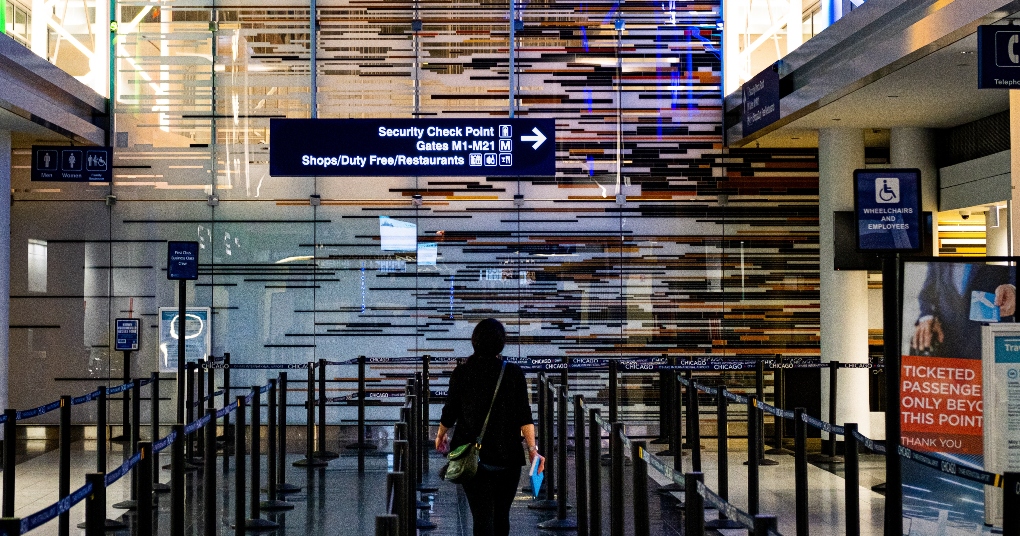
21. Make Sure All the Liquids in Your Carry-on Are Under 3.4 Ounces
You would be surprised how many liquids you might accidentally try to pack without thinking about it being a liquid. A few items to remember to watch the size on are: shampoo, conditioner, soap, sunscreen, any alcohol you are gifting or bringing with you, anything you are currently drinking, nail polish remover, vaseline/gel chapstick, some makeup, perfume, gel or spray deodorant, etc.
Some airports also require all of your liquids to fit in one quart-size clear bag which they may provide.
22. Don’t Pack Aerosol Cans (Bug Spray!)
Aerosol cans are not allowed through TSA. Though I have (accidentally) gotten away with it a few times, this includes even simple things like bug spray.
>>> TIP: use Picaridin lotion instead, or bug-repellant wipes .
23. Double Check the TSA’s List of Prohibited Items While Packing
Take a look at the TSA list of prohibited items while you are packing your carry-on. Familiarizing yourself with the list may save you some time and money from having to throw items away at security.
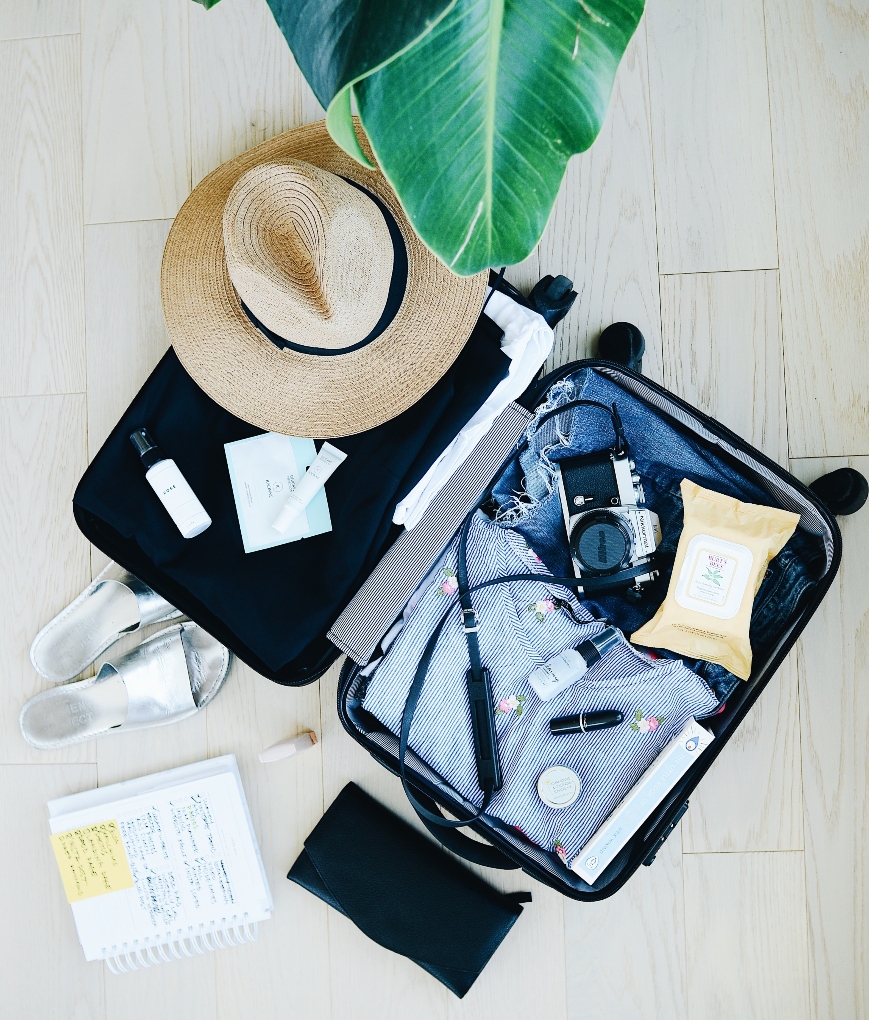
24. Have Your I.D. And Boarding Pass Out
You will have your I.D. and boarding pass checked before entering security. Have it out and ready to hand off as the line for security sometimes moves quickly.
25. Be Prepared to Take Your Shoes Off
In the U.S., most passengers need to remove their shoes for security. Those with TSA PreCheck , older than 75, or kids 12 and younger will not need to remove shoes.
26. Jewelry and Security
Small jewelry such as earrings, necklaces, and rings can stay on through the scanner, but remove anything big and metal that might set off the sensor.
27. Take Any Personal Electronics Out of Your Bag (i.e. Laptop, iPad)
Remove any electronics and place them in the bins. If you have your laptop in a computer bag or case it will need to be fully taken out.
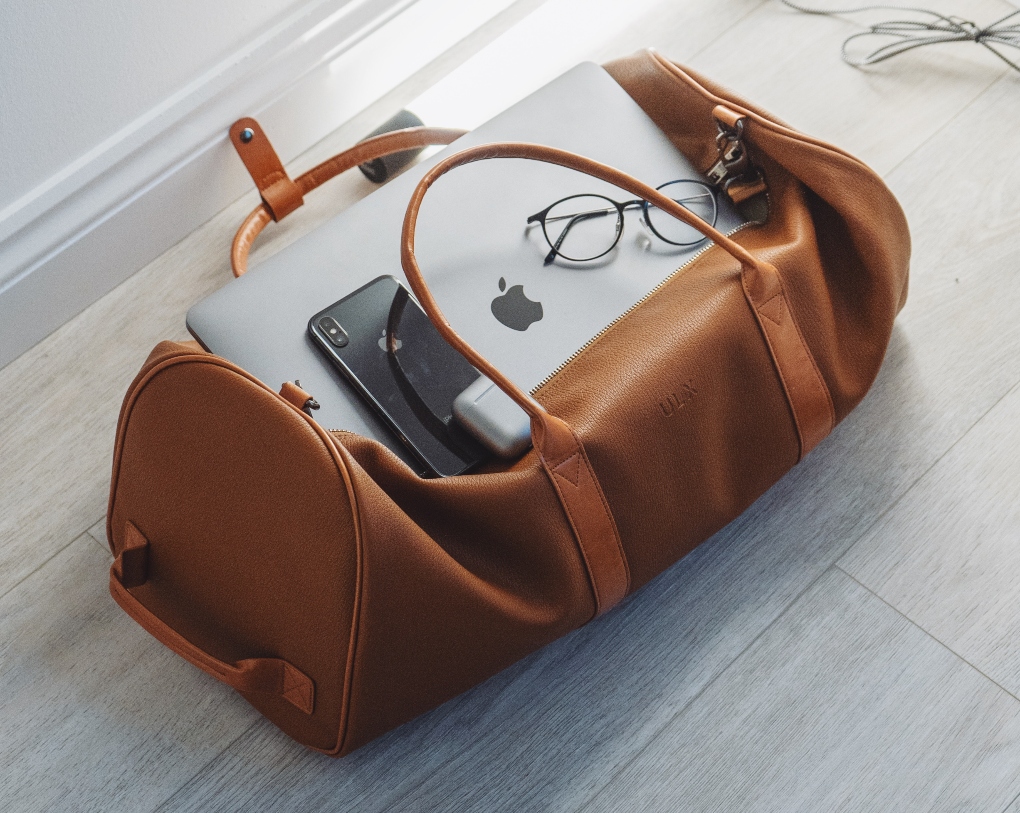
28. Take Off Your Belt
29. take off your jacket, 30. put your phone in the bin, 31. double-check your pockets, 32. make sure to drink or dump the water from your bottle, 33. listen to security personnel, they will help with what to do.
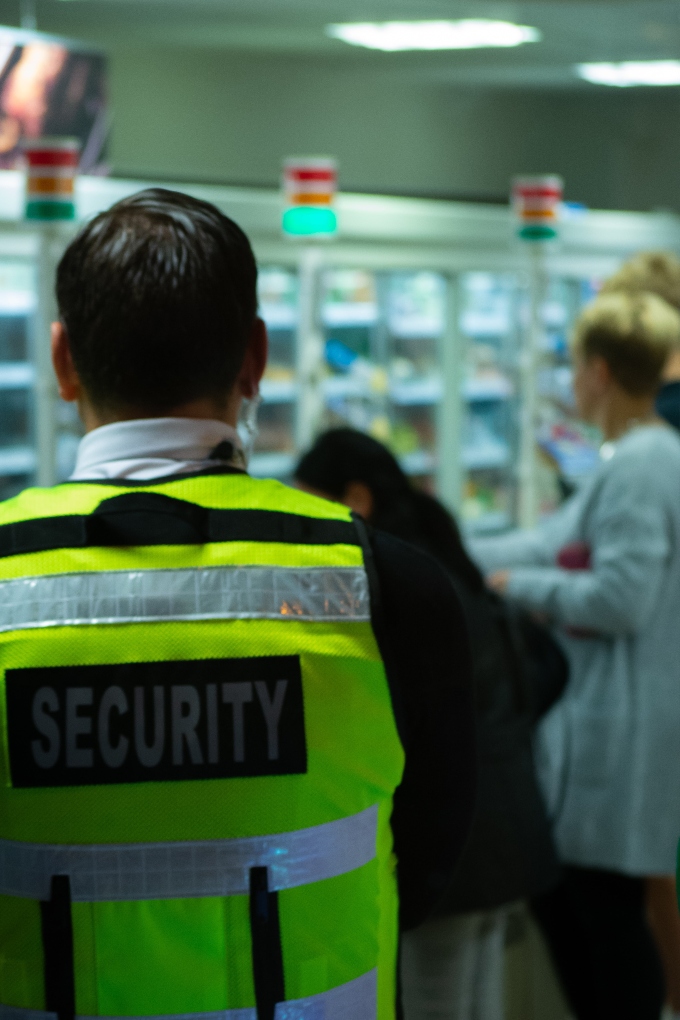
34. Moving Through the Scanner
Once all your belongings are moving through the security conveyor belt, you will be asked to step through a full-body scanner. Usually, you will spread your feet out and lift your hands above your head.
Next, you will be directed out of the scanner. Pause for a bit upon exiting until the security personnel clears you to pick up your belongings.
35. Pat Downs
On occasion, the scanner may pick something up, even if there is nothing there, or perhaps you forgot to remove something metal. The security personnel may use a handheld scanner or will lightly pat you down (following specific guidelines and boundaries to not be inappropriate).
It is a passenger’s right to refuse to be pat down, but you will not be allowed to fly if you don’t comply with TSA security checks.
36. What to Do if Your Bag Is Flagged
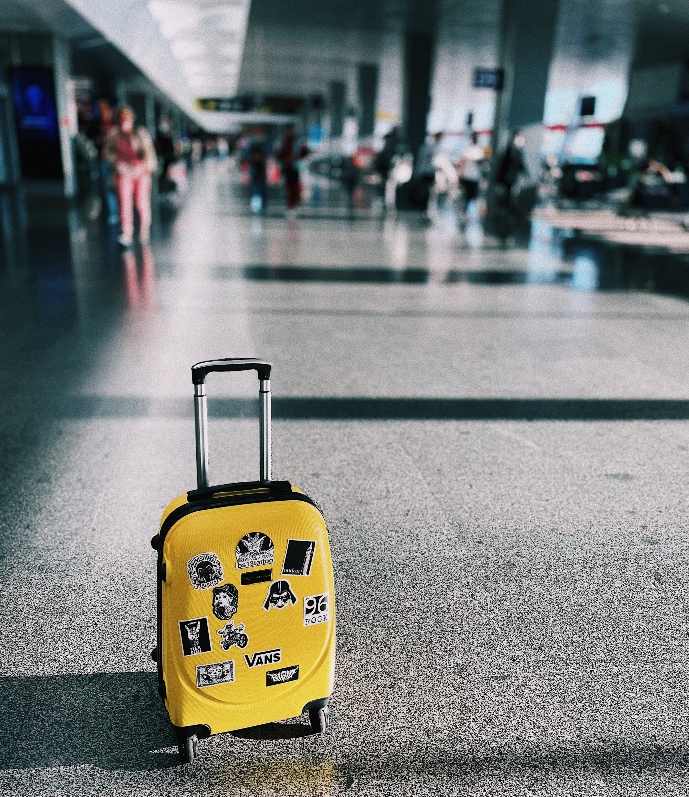
Having your bag flagged is not usually a big deal either. Little things might get picked up in the scanner that security wants to double-check, or perhaps you forgot a liquid that is too big.
Security personnel will ask you to step aside and ask to inspect your bag. You may have to pull some of your things out to let them search for what set off the alarms. Usually, this happens very quickly and you are on your way.
37. Duty-Free at the Airport
If you are questioning whether you can bring something on the plane or not, it is always a safer bet to just leave it at home and buy it at one of the many shops that are past security and what is known as “duty-free.” Duty-free refers to items that you do not have to pay import, sales, value-added, or other taxes on.
Looking For Travel Inspiration and Advice?
Get the latest updates sent straight to your inbox!
FIRST TIME FLYER’S GUIDE TO BOARDING AND THE FLIGHT
38. reading your boarding pass.
Once you exit security, your next step will be to head to your gate . Your boarding pass (the printed version, not so much when it’s on your phone) usually lists your gate, the time that boarding starts, and your seat number.
39. Checking Airport Boards and Signs
There will be big electronic boards throughout the airport that list which flights are at which gate and if they are on time or delayed. I always cross-check my boarding pass with the electronic signs, because your gate might change.
Follow the signs around the airport that direct you to your gate. Again, when I arrive at the gate I check to see that my flight is indeed listed at the gate .
If you get there especially early, your gate might still be showing the flight before yours, in which case you will have to wait and keep an eye on the large boards to make sure nothing changes .
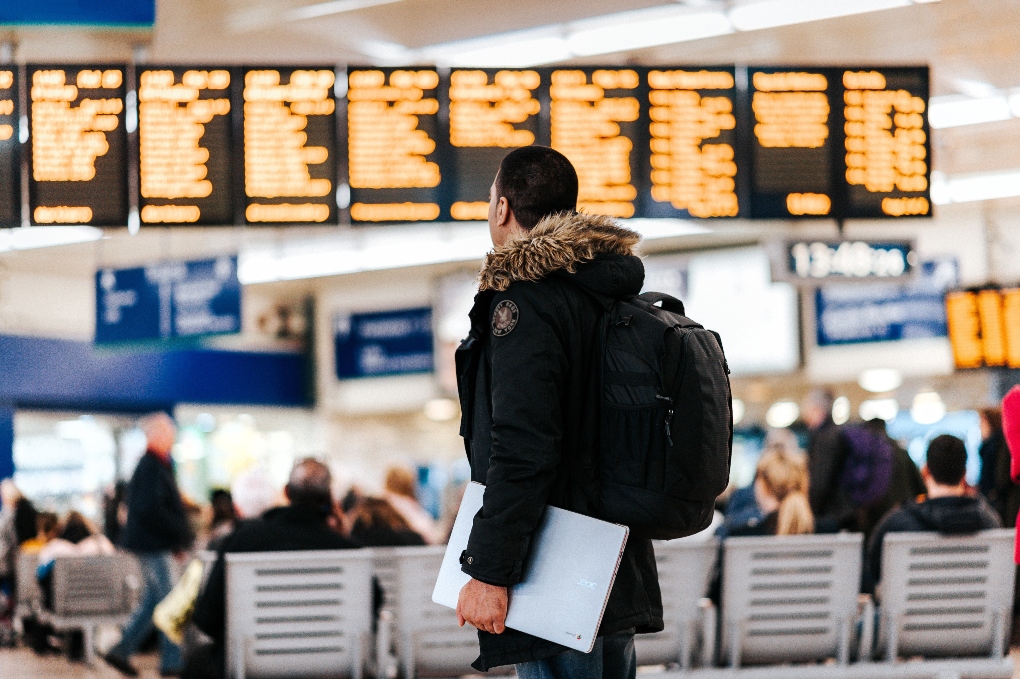
40. At Your Gate and Waiting
Once you reach your gate you are waiting until boarding starts. Find a seat and relax! Or, wander through the shops, find something to eat, or take a light walk to stretch your legs before your first flight.
41. Boarding Your Flight
Boarding zones:.
When your flight is ready to start boarding, the airport personnel will make announcements over the speaker or from the desk. Flights (especially larger ones) typically board by zone . Watch and listen for your zone to be called before getting in line to board. Your boarding pass will note what zone you are in.
Boarding Pass and I.D. Out:
Most flights at this point just check your boarding pass (since your I.D. was already checked at security), but I always keep my I.D. handy just in case.
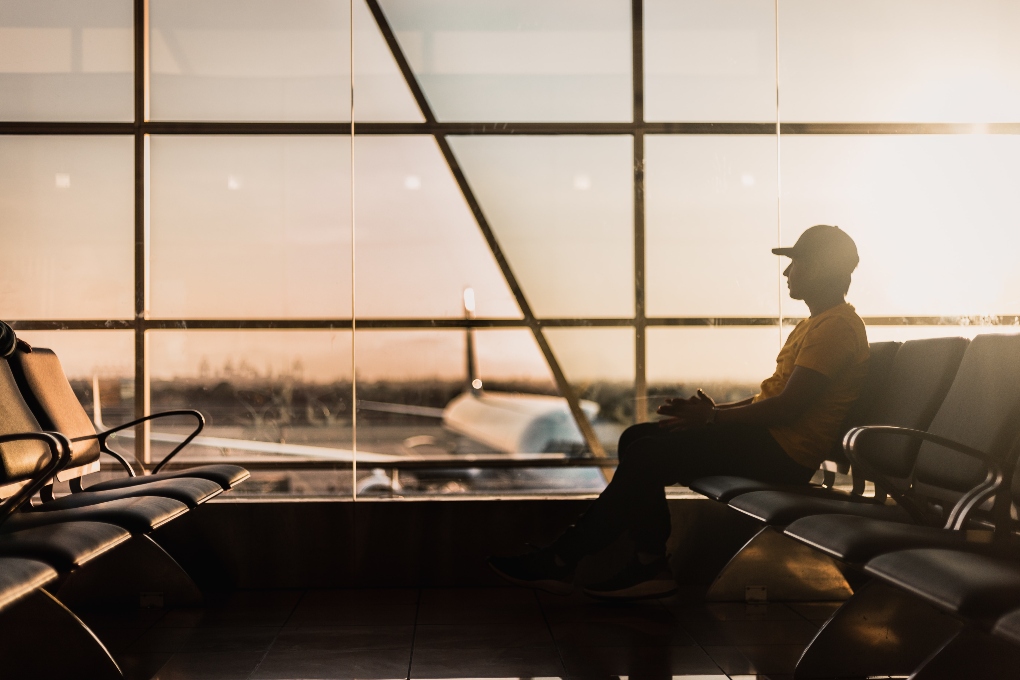
42. Checking Carry-on Bags
If the flight is full, your flight might ask for volunteers to check their carry-on bags or will require some people to check bags if they don’t get enough volunteers. If they ask you to check your carry-on they won’t charge you (unless it is oversized and won’t fit in the cabin) and it’s not a big deal.
You will simply pick up the bag upon arrival as if you checked it like normal. Just don’t forget to take anything out of the bag that you might need during the flight!
43. Getting on the Plane
When you get on the plane, there is usually a flight attendant at the front who will guide first-time flyers to their seat or answer any questions. Otherwise, just walk to your seat and make sure to check above the seat for the letter that corresponds to the window, middle, or aisle seat.
There is a figure of a person on the diagram to show you where the aisle is.

Storing Baggage:
If you have a carry-on, put it in the bin above your seat. Make sure that it is rotated the proper way so it fits and the door will close over it. Put your personal item under the seat in front of you.
44. Put Your Phone on Airplane Mode
All electronics should be put on airplane mode before take-off, this is to ensure there is no interference with the airplane’s signals. Unless told by your flight attendant, you don’t have to turn your electronics all the way off.
Airplane WiFi:
Airplanes nowadays typically have WiFi available for passengers to purchase. You can ask your flight attendant what options they have available.
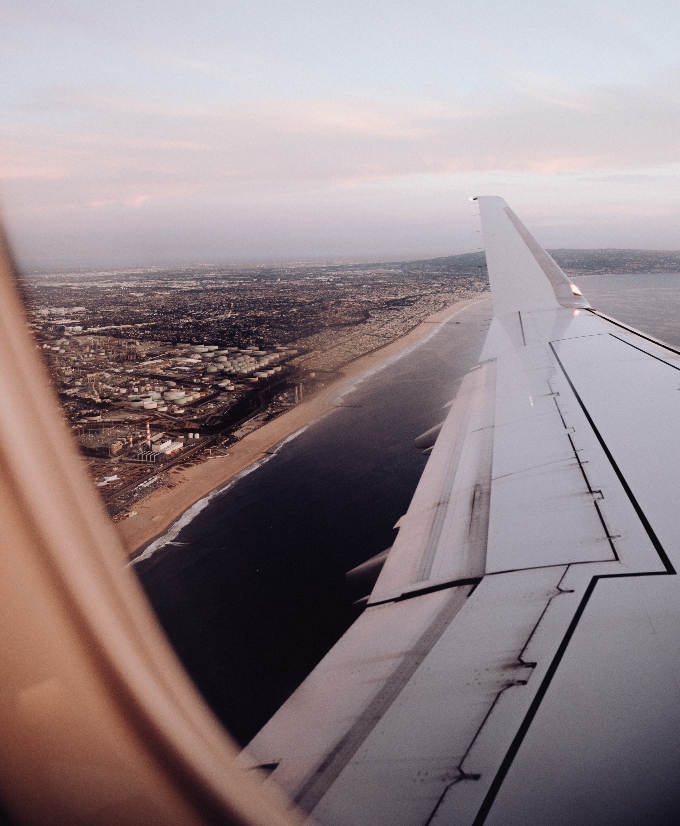
45. Listening to Airplane Emergency Measures
Flight attendants will either display or play a video about the emergency and safety measures of the aircraft. As a first-time flyer, you should pay attention to this guide in the very slim chance there is an emergency.
Don’t be alarmed by the message , they are required to go over safety but airplanes hardly ever encounter any issues.
46. In-Flight Service, Snacks, and Meals
Depending on your airline and the length of the flight, you might be served a snack and beverage or even a meal or two. All airlines have paid food options available that you can browse.
Budget airlines, especially on shorter flights, have started not giving anything out for free – this is why I recommend packing your own snacks! If you aren’t sure, ask your flight attendant what their options are.
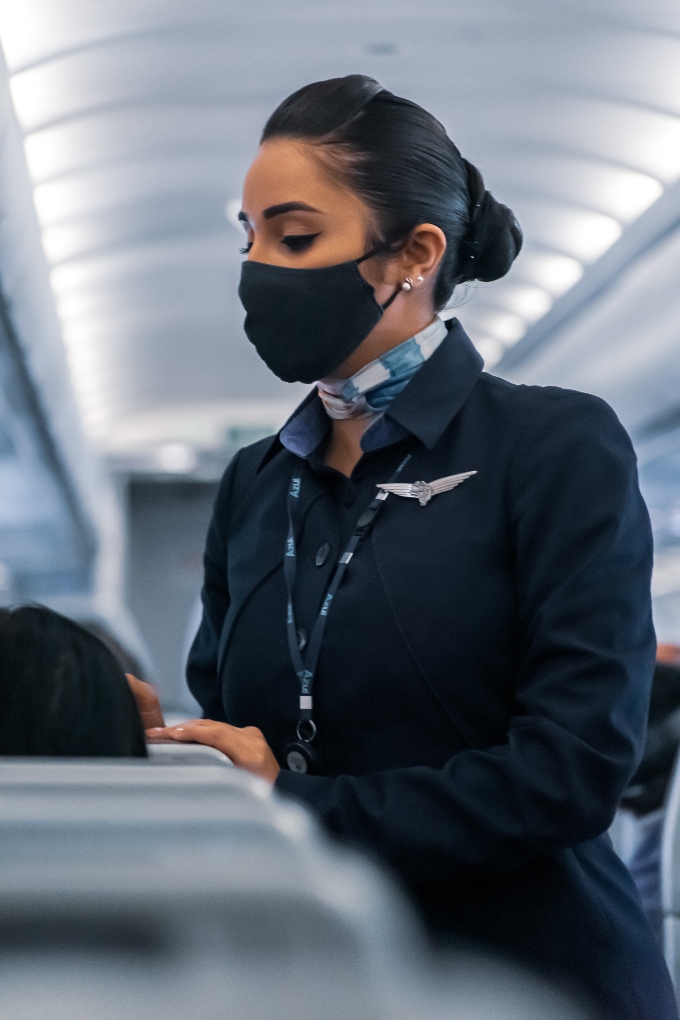
47. Stay Hydrated
Flying always dehydrates you, so make sure to drink plenty of water. Staying hydrated is one of the best ways to help prevent jet lag.
48. Relax and Enjoy!
Landing and what to do after your flight.
After landing, you may have to wait in your seat for a bit as the plane makes its way to the proper gate. The plane will deboard row by row from the front, just sit tight and wait your turn to exit.
49. Following Signs to Exit
When you exit the plane, you will want to follow the signs to the baggage claim and exit. If you didn’t check a bag, just head straight to the exit.
50. Understanding Baggage Claim
Once you reach baggage claim, there will be a few conveyor belts. Look for the one marked with your flight’s information, or look for an electronic board that has information. Depending on how fast you reach baggage claim, you may have to wait a bit.

51. Pick-up, Taxis, and Rideshares
Most airports now (especially bigger ones) have separate areas for passenger pick-up and Taxis and rideshares (Uber, Lyft, etc.). Follow the signs for what you need.
Some airports (such as Los Angeles) may even have you take a shuttle to get to the rideshares, in which case you shouldn’t call your ride until you make it to the designated area and know where to wait.
52. Layovers and Connecting Flights
If you have a layover or connecting flight, there will be separate signs pointing you in the right direction back towards the gates. Some airports will have you pass through security again, but many will not.
When you are checking your bag, make sure to ask if your bag will be checked through to your final destination . If you are on the same airline for both flights, this is pretty standard practice.
It can get a bit trickier when you switch airlines. If you need to pick up your bag, you will have to head to baggage claim and then back to the ticketing counter to check it for your next flight.
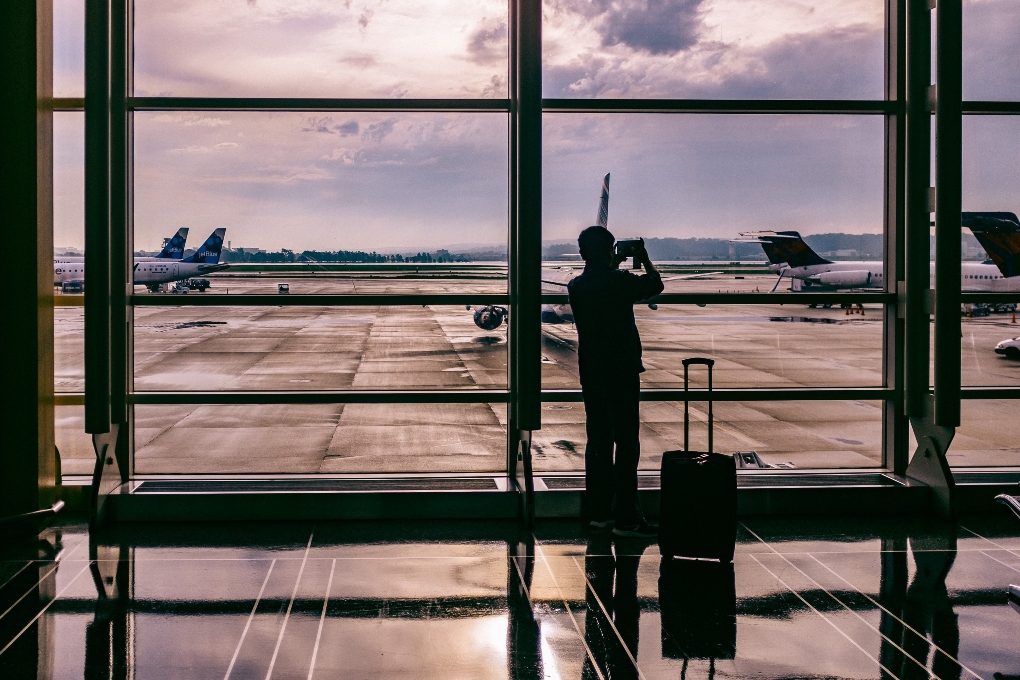
FIRST TIME FLYERS’ CHECKLIST
Summary: tips for flying on a plane for your first time.
Preparing for your first time flying is extremely helpful, but no two flights are ever the same , so don’t stress the little details too much! Each airport has its quirks and layouts, so follow signs, ask for help if you need it, and reference this first-time flyers guide.
For travel junkies like me, airports are fun to find interesting restaurants, fun souvenirs, or to people-watch and dream about your next vacation. Plus, it opens up a world for you to explore if you can get comfortable flying (especially now that remote jobs are changing the way we travel ). Enjoy your first flight!
Looking for resources to use for your next trip or move abroad? CLICK HERE for my favorite travel and expat tools!
Janelle Axton is a travel consultant and owner of Make the Trip Matter, a service dedicated to helping people create a lifestyle around frequent travel and extended time abroad. She grew up in California and spent time living abroad in Ireland in addition to traveling to over 25 countries.
Similar Posts
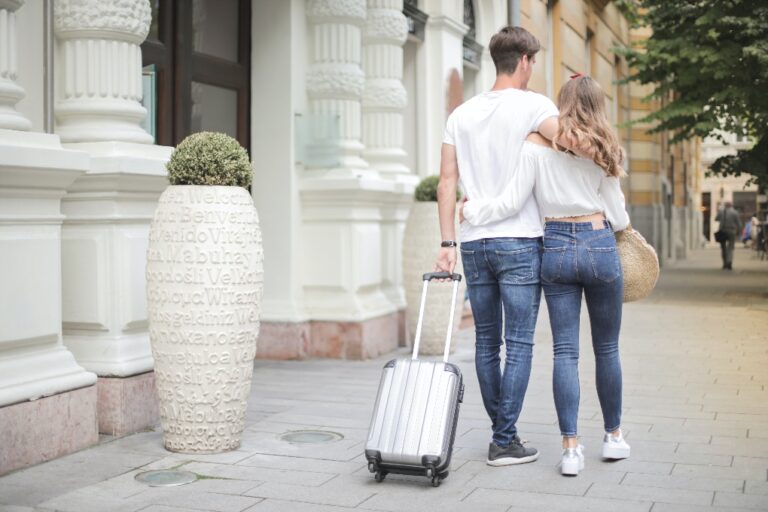
45 Romantic and Fun Things to Do in Dublin for Couples (2024)
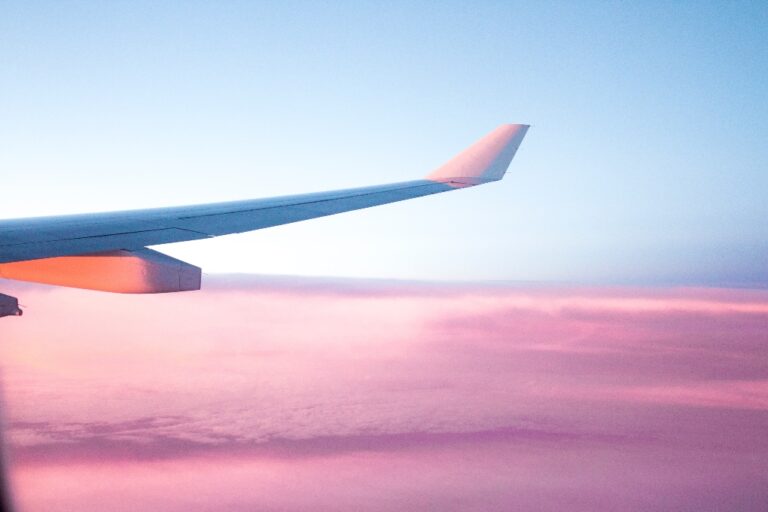
Is Skyscanner Legit? Review and Tips 2024

Guide to Working Remotely Abroad For a U.S. Company in 2024
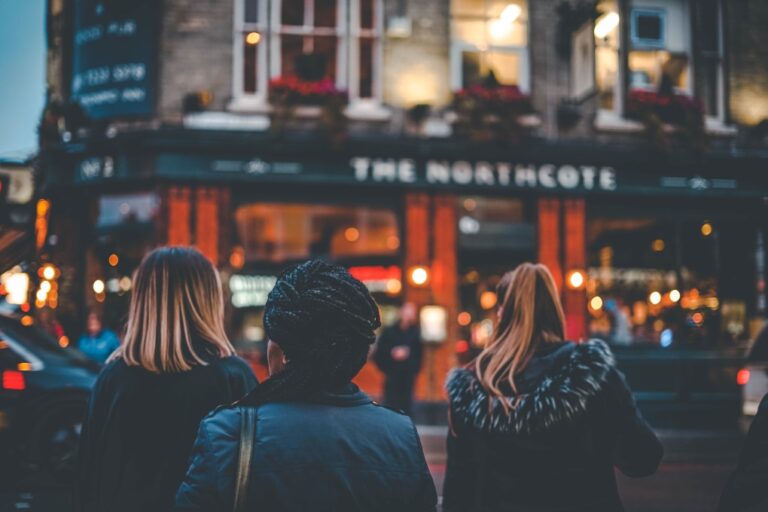
Is Dublin Safe? BEST Safety Tips for Travelers in 2024

Scotland vs. Ireland (2024): Tourist and Expat Guide

- Airline’s Baggage Fees
- Golf Packages
- Golf Destinations
- Travel with Golf Clubs
- Travel Tips
47 First Time Flying Tips: Complete Steps for A Smooth Trip
- 47 First Time Flying Tips:…

Flying for the first time might seem intimidating, but it is not as complicated as it might seem. We’ve compiled a comprehensive list of tips for first-time travelers to make your experience stress-free and comfortable.
Let’s begin the first time flying tips!
We’ve broken them down into four traveling sections; before your flight, at the airport, in the plane, and after landing, to help you understand each stage of your flight. And now we are ‘ready for take-off!’.
Table of Contents
Before your flight:
1. add your flight to your calendar..
Set the alarm for your flight and include the flight details on your smartphone. Make sure you have the correct date, time, and departure gate. Let others know you will be flying and give all the flight information in case of an emergency. If you book your own flight, make sure to know when to find cheap flights .
2. Create a checklist.
Give yourself some peace of mind and make a checklist of things indispensable for your trip, like chargers, medication, and passports, and a checklist of things you must do at home before leaving, like; closing the garage door, turning off the stove, and taking out the trash.
3. Know your cancelation and travel rights.
Assuming you already purchased your ticket from the best flight booking sites , learn about their cancelation rights, compensation for lost luggage and delays, and moving flight dates. This will come in handy if there are any issues during your flight, be it with your baggage or connecting flight.
4. Check-In from home.
Before the pandemic, check-in at home was optional. Now, most airlines charge a check-in fee if you don’t check-in 24 hours before your flight. In addition, print or take a screenshot to have with you and present at the check-in counter.
5. Baggage requirements.
Know the difference between a personal bag, a carry-on bag, and a check-in bag. A personal bag is like a purse, a carry-on bag is small and fits in the plane’s overhead compartment, and luggage is the heaviest bag that has to be checked in. If you’re traveling with a car seat or a stroller , make sure to check the airline’s policy about it.
6. Weigh your bag.
Each airline has slightly different weight limits on their check-in bags. Know what the limit is with your airline. If you have a connecting flight with another airline, check their bag weight limits too. You might have to pay a price difference at some point during your connection flight if there are any differences in weight limits. You must know what is included in your tickets.
7. Plan for the worst.
Load your carry-on with a change of clothes, medication, supplements, makeup, chargers, items essential for your trip, and priceless possessions in case the airline misplaces or losses your checked-in bag.
8. Pack smart.
Know what is and isn’t allowed on to avoid any issues during the security screening at the airport. For example can you bring a razor on a plane ? Check the TSA list of permitted items on a carry-on and a check-in bag. This list will help you determine what to bring and leave behind and will make the security screening process faster and without incident.
9. Arrive with time to spare.
Allocate enough time for travel and traffic from home to the airport. If traveling internationally, arrive two or three hours before your flight check-in. If you are traveling nationally, an hour or two is enough before check-in. Remember that summer is the busiest traveling time; consider this if you are traveling to a popular destination, and add an hour or two to your check-in time to avoid losing your time while waiting in line.
10. Wear comfy clothes.
Don’t hold up the line at security screenings; keep it minimal and practical by wearing comfortable clothing. Things like necklaces, lace-up boots, fashion statements, excessive jewelry, and complicated outfits will delay you and others at the security screening points.
11. Secure your travel documents.
Pack the pertinent travel documentation and ensure all your traveling documents are in order before leaving your house. Use a passport and travel organizer to secure essential documents in one place. Keep it attached to your carry-on bag.
12. Snacks for the trip.
Pack sealed snacks such as chips, baked goods, bread, solid homemade meals, and fruits. Here is s list of foods acceptable on a plane. Be mindful of others and bring food that is not smelly or messy, like tuna or soups. Keep your snacks simple.
13. Items to declare.
If you travel from abroad into the U.S.A. or the other way around, you will be provided a customs declaration form. You must fill out a declaration form and provide it at customs. Because all airports and aircraft are different, ask an airport staff or a police guard to point you in the right direction. These include baby carriers, baby formula, car seats, golf tour bags, snowboards, technical instruments, cash, and expensive gifts, among other things.
14. Carry an empty water bottle.
Water bottles with water are not acceptable through the security screening checkpoint; however, you can always refill them once inside the airport gates.
15. Choose a ride to the airport.
Plan your ride to the airport ahead of time. If you take a car, keep the parking ticket somewhere you will remember. Also, allocate time for the shuttle bus to take you to your gate since it can take time from your flight check-in. If hiring a car service, ensure rides are available close to your location.
16. Mark your bags.
Add tags, stickers, or anything else you can use to identify your travel bag at the conveyor belt and avoid mistakenly taking the wrong bag. If you want to tighten the privacy of your things, add a key or combination lock to your check-in bag.
17. Bring your entertainment.
Examples of things to pack are an e-reader, card game, notepad and pen, downloaded movies, laptop, tablet, or anything else you use to stay distracted. Charge your electronics before your flight to use them throughout your flight.
18. Get comfy.
Planes are uncomfortable. If you are going on a long flight, bring a neck pillow, blanket, blindfold, warm socks, or anything that helps you sleep and relax. The traveling process is already stressful, so it’s good to catch a few hours of sleep while you can.
19. Don’t overpack.
You are responsible for bringing back everything you pack. So do yourself a favor and pack the absolutely necessary and leave space for souvenirs and anything else you buy along your trip.
20. Anxiety, medication, and cabin pressure.
If you take anxiety medication, keep your prescription with you and any other medication you need. In addition, drink water, chew gum, or swallow saliva constantly to avoid the effects of cabin pressure on your ears. If you feel sick, let the airplane staff know, they will help you nurse your flying symptoms.
21. Check pandemic requirements.
While most countries have returned to somewhat normal activities, it’s essential to be informed of the COVID-19 restrictions of the country you are departing from and arriving. In addition, the airline you are traveling with should have information on their website about the requirements of the country you are traveling to.
At the airport:
22. find your check-in counter..
Check-in your bags and find your gate. The airline staff will point you to your gate and give you any information you need for your trip. If you have questions about your trip, COVID-19 restrictions, or connecting flight, this is the right place to ask them. If you’re flying with a lap infant , you might be able to ask the staff for a seat with empty seat next to it.
23. Keep your things with you at all times.
Don’t leave your things, bags, or documents unattended or trust them to others. On that same note, don’t lend your things or hold items for people you don’t know. Finally, if you find unattended bags or suspicious-looking items left behind, don’t pick them up. Instead, report them to the airport staff.
24. Not the place for jokes.
Don’t make inappropriate jokes about the safety of the plane, airport, or your fellow passengers while at the airport or during security screening. No matter how well-meaning you think you are, airport security takes any mention of compromised security seriously.
25. Be ready for the security screening.
When you approach the security screening line, pay attention to the instructions from the staff. Be cooperative. This is why dressing comfortably is practical and packing only the essentials is important, so you don’t take a long time and hogg the line.
Once done, ensure all your belongings and travel documents are in your possession from the trays. Then, make an inventory of the things you took off and the things you got back. If something is missing is probably being inspected by the security staff. You might be pulled to the side and asked questions about it. This is part of the security screening procedures.
26. Find your gate.
If you arrive early, your gate might still need to be announced. Keep an eye on the monitors inside the airport to find the right gate using your flight code. As soon as your gate is announced, head that way. Stay within your gate area and check the flight monitor regularly to see if the gate designated for your flight has changed last minute.
27. Fill up your water bottle.
Once you pass the security screening and are closer to your gate, find a water fountain to fill up your drink.
28. Take a bathroom break.
Airplane bathrooms are small and uncomfortable. Instead, use the restroom at the airport before your flight.
29. Charge your electronics.
Most airplanes have weak power charging stations. So save your battery for the flight or charge your electronics while you wait for your flight at airport charging stations.
30. Last chance to shop.
Ideally, you would get all your snacks outside the airport since it’s more expensive once inside. But things happen, so this will be your last chance to buy snacks, coffee, gum, books, or magazines or check out the duty-free area.
In the plane:
31. board with your zone..
Wait until your boarding zone is announced to get in line to board. The boarding zone will be printed on your ticket. There is an order of things that flows easily if everyone follows the instructions. Avoid waiting in the wrong line by paying attention to the instructions from the flight attendants at the check-in counter.
32. Find your seat.
Make sure you find the right seat. If you didn’t buy a seat with your ticket, you will be given a randomly assigned seat. Ask the flight attendants to help determine if you have a window, middle, or hallway seat.
Some facts about seats for your next trip: economy class usually has 31 in seat pitch, premium economy offers 38 in, and business class boasts 55 in. More about this in our articles:
- Economy vs Premium Economy
- Business Class vs Premium Economy
33. Emergency seats.
If you are assigned a door seat, you need to be mentally and physically capable of following through with the emergency procedures. If you are not ready to assume these responsibilities, let the stewardess know immediately before the flight.
34. Stow away your carry-on bag.
No matter how compact your carry-on is, it has to be in your overhead compartment. Be mindful when loading your things to avoid hitting anyone with your bag when pulling it up or bringing it down. If you see a person struggling to get their bags in the compartment, offer help, this will help the line move along faster.
35. Personal bags go under the seat.
Keep your personal bag under the seat in front of you and keep the walkway tidy for your fellow passengers.
36. Listen to the safety talk.
The stewardess will give a safety talk showing you what to do in an emergency. You must understand the information that she is providing. Read the safety sheet on the backrest before you and obey the seat belt signs.
37. Practice plane etiquette.
Your seat is your personal space. Keep your space tidy. Make conversation if the person next to you is willing to talk. Wear headphones or earbuds to listen to music or watch a movie. Turn off your light at night. If you are traveling with kids, watch them and ensure they don’t physically invade the space of passengers around them.
38. Stretch often.
Keep your blood pumping by doing proper stretches on your seat or walking around the plane every hour if it’s a long flight. You can do many exercises that don’t require you to move from your seat.
39. Recline with caution.
Be mindful of you the person behind you. Even though seats are meant to recline, some people may physically struggle, and having a person recline might confine them to their chair. If you decide to recline up or down, take a moment to look back at the person behind you and do so slowly to give them time to prepare.
40. Alcohol consumption.
The airplane staff will closely monitor those who drink to ensure they don’t disrupt other passengers, start conflict, or create an unsafe environment. Then, the airplane staff can decide if they will stop serving you alcohol and if any other safety measure needs to be taken. Know your limits if you are going to indulge in a drink. Don’t be the drunk passenger on the plane.
41. Respect the flight attendants.
Flight attendants are professionally trained to keep passengers comfortable and safe, among other tasks. They are not maids; treat them with respect.
After landing:
42. don’t leave anything behind..
Do an inventory of your things to ensure you take all your belongings. If you leave any items behind, contact your flight’s airline to report the missing items. The airline will work with you to help you recover them.
43. Don’t push and shove.
The plane disembarks by zones; wait until it’s your turn to get out. Let the ones ahead of you come out before pushing your way through the line. Remember to hold your bags in front of you as you exit the plane to avoid those who are sitting hitting others with them.
44. Connecting flights.
If you have a connecting flight, look at the flight monitors and find your next gate. If you are having issues finding your way ask the airport staff or find your airline’s customer service desk so they can help you be on your way. If an issue with your flight causes you to be late for your connecting flight, go to the airline’s counter, and they will help you fix your problem. This is where your travel insurance and knowing your travel come in handy.
45. Go to baggage claim.
If it’s a national flight, pick up your bags at baggage claim and exit the airport to your destination. However, if it’s an international flight, you must claim your baggage, stop at customs, return the customs declaration forms, and then cross the last baggage check-up.
46. Double check you have the right bag.
Don’t make the mistake of picking up someone else’s bag. Instead, look for the tags you used to identify your bags. If you happen to take someone else’s bag, report it to the airline and return it. If the airline losses or delays your bag, report it at the baggage claim office.
47. Remove airplane tags.
This is the last tip that will prepare you for your next flight but remove any airplane tags from your bags to avoid confusion on your next trip.
In conclusion
Remember, everyone had to fly for the first time at some point, and you might be one of many doing so that day. It will be nerve-wracking and stressful, no matter how prepared you are.
Embrace the challenge, stick to these tips, ask for help if you need to and consider that you are one of many traveling somewhere unknown for the first time; you are not alone.
Related Articles
- Airport Check In: Your 38 Most Asked Questions Answered
- Getting Your Luggage During a Layover: Here’s How
- Business Class vs Premium Economy: Worth The Cost?
- When to Find Cheap Flights – 18 Tips to Get Cheap Tickets
- 12 Best Booking Sites for Flights: Kiwi, Skyscanner, & More
Author: Arietza Contreras
Arietza C. Camargo was born in Mexico, lived in Houston, TX, and currently resides in Split, Croatia. Arie has a degree in Occupational Safety and Hygiene but discovered her love for writing soon after working in that field. She founded her current blog (Arietza.com) and began a career as a content writer. Today, she is a lifestyle and travel blogger and content writer.
Leave a Reply Cancel reply
You must be logged in to post a comment.

27 Best Tips for Flying for the First Time (2023)
Flying for the first time can be both exhilarating and frightening. There are many things you can do to make it easier and less stressful, though! I’ve rounded up 27 of the best first time flying tips to make it that much easier for you.
If this is your first time flying, much of your anxiety likely comes from just not knowing for sure what to experience. One of the best things you can do for yourself is to prepare ahead of time!
Knowing things like what to expect while going through security, what’s the best thing to wear on an airplane, and advice on avoiding extra luggage fees can be a game changer when it comes to being comfortable on your first flight.
Here are 27 travel tips for first time flyers that will have you flying like a pro on your very first flight.
1 Dress comfortably
One of the best first time flyer tips is to dress comfortably and to make sure you have layers.
Sitting on a cramped plane for hours can be a nightmare if you’re wearing clothes that are restrictive or make you uncomfortable.
Not only are you in a cramped space with little ability to move around, but pressure changes during the flight can cause your body to feel bloated or your legs to swell.
Make sure you wear unrestrictive clothing, comfortable shoes, and have a sweater or jacket in case you get cold once you’re in the air.
You’ll also thank yourself for wearing comfy clothing the first time you have to climb over another passenger to use the restroom!
By Tawnya at Money Saved is Money Earned
Click to view our recommendations :

RELATED: Road Trip Essentials: Make Sure to Pack These in Your Car
2 Stay hydrated
If you want to experience an enjoyable flight, staying hydrated is key. Airplanes create a humid environment, which can quickly lead to nausea, tiredness, and headaches. And a headache is the last thing you want at 40,000 feet!
Staying hydrated on a plane isn’t difficult. You should ensure that you drink plenty of water before and throughout the flight.
Equally, you will want to avoid coffee and alcohol (no matter how tempting the complimentary booze might be!) as these will dehydrate you even more.
Drinking water isn’t the only way to stay hydrated on a plane though. One way to see just how dehydrating airplanes are is by looking at your skin after a flight. With the harsh air conditioning blasting in your face for several hours, your face will quickly dry out.
You can overcome dry skin by packing a small moisturiser or facial spritz to apply throughout the flight.
A good lip balm is a must too to combat dry and painful lips! And finally, you may benefit from packing a nasal spray too, to avoid dry and painful sinuses.
By Hannah at Get Lost

3 Use points to pay for your flight
If you’re a first time flyer, you may not be aware that you can use credit card points to pay for your ticket.
Every airline has a reward program and you can sign up to start earning miles with them from your very first time flight experience.
However, unless you fly on that particular airline often, it’s going to take quite a while to rack up enough miles for a free flight.
Another option is to select a credit card that has a great sign up bonus and use those points to pay for your ticket.
The way this works is like this: once you’re approved for the card you applied for, you’ll typically have three months to put a certain amount of spend on it.
Once you’ve done that, the bonus points will be yours to spend as you choose!
At the time of this writing, the Chase Sapphire Preferred card has a sign up bonus of 60,000 points. You’ll need to spend $4,000 within three months to meet the requirement.
You can use that 60,000 points to splurge on something like a first class round trip ticket to Europe or go the more economical route and you’ll be able to book a few domestic economy flights.
Using points to pay for flights is one of the best flying for the first time tips there is. Use your points wisely and you’ll be flying for the second, third and fourth time in no time!
By Karee at Our Woven Journey
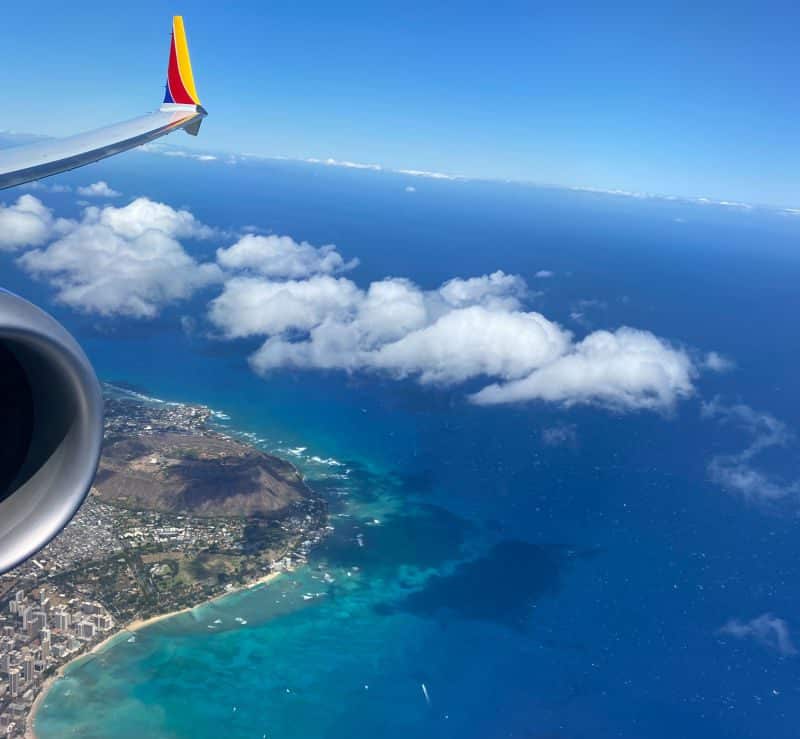
4 Know how to get over jet lag quickly
Jet lag occurs when you travel quickly to a new time zone which alters your natural circadian rhythm. It can cause fatigue and insomnia whilst you adjust, and the more time zones you travel through, the more affected you can be. Generally, the effects of traveling from west to east can be worse.
Our internal clock becomes mixed up partly due to a difference in exposure to light so one way to alleviate symptoms and help you recover from jet lag faster is to get outside soon after flying.
Exposure to natural daylight will reduce the release of melatonin hormones that make you sleepy and help wake you up so that you can stick to the schedule in your new time zone.
Melatonin products can help the other way around too, and help you to drift off if you are struggling.
And drink plenty of water before, during and after your flight, as dehydration will make it worse!
By Rosanna at Rosanna Etc.

5 Use packing cubes
One of the most surprising first-time flying tips is to use packing cubes. This seems an almost oxymoron because you are putting your stuff into more stuff.
However, since packing cubes use compression technology it makes your stuff take up so much less space. They usually have multiple zippers, the first to secure the contents, the second to compress the size down.
There are two strategies for utilizing packing cubes: the first strategy is to pack your daily outfit in each cube (or your family’s outfits), the second strategy is to pack by item in each cube.
I recommend packing by outfits, as this will enable you to turn them and put the dirty items in that same cube.
Usually, the packing cubes come in packs of three of multiple sizes. The smallest is perfect for your first day comfortable outfit and pajamas the night you arrive.
Make sure to tuck this into your carry-on just in case your checked luggage arrives late. Packing super light in a carry-on will make your flight less stressful.
By Rebecca at Whatever Packs Your Bag

6 Download movies before your flight
An excellent way to keep yourself entertained during a flight is to download a selection of Netflix or Amazon Prime movies to your device.
Some flights don’t come with onboard entertainment and others charge extra for a movie package. Instead of relying on the airline, it is a great idea to prepare your own entertainment.
If you already have a Netflix or Amazon subscription, all you need to do is download your favorite show to be able to watch it in offline mode.
You won’t be able to do this once you’re on the plane and don’t have wi-fi, so add this to your travel checklist to do before you travel. You can watch them on your phone, but for the best experience, watch can movies on one of these lightweight laptops for traveling .
Netflix and Amazon Prime both have a wide selection of shows. You can spend the flight time learning Spanish or watching a fascinating documentary.
Time passes more quickly when you’re watching your favorite shows which helps a lot, especially if you have trouble sleeping on a plane.
And before you know it, it will be time to land!
By Mal from Raw Mal Roams
➡️ Get a free 30 day trial for Amazon Prime Video
7 Know how to book cheap flights
Preparation for a flight actually starts when searching for a flight because no one wants to pay more than they have to.
Luckily, there are several tricks to help you find the cheapest flight possible.
First, be flexible with your travel dates when searching for flights. Some days of the week, month and year are cheaper than others. The larger your date range, the easier it is to pick the cheapest moment to fly.
Second, compare different airlines through a price comparison site such as Skyscanner. This way you’re sure to find the most affordable carrier. Websites of the airlines themselves are often the most expensive!
Third, don’t be lured into paying for extras. Be especially aware of low-cost airlines trying to upsell additional services: from extra luggage and priority boarding to selling lottery tickets on the plane itself. Most of these things you don’t need at all so be strict with yourself and keep your budget in mind.
By Emma at Emma’s Roadmap
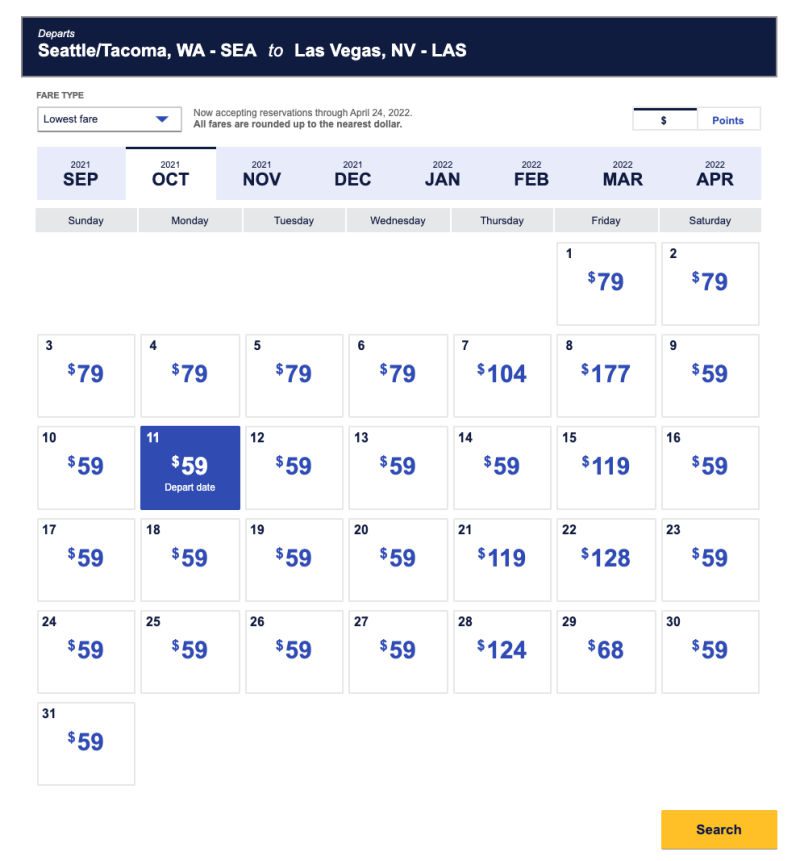
8 Pack valuables in carry-on luggage
If you are planning to travel and pack both a carry-on bag and checked luggage, this one is for you.
When it comes to flying on any airline, even if it’s rated number one in the world, there is always the possibility that your checked luggage will go missing. Especially if you have connecting flights!
Make sure to pack your valuables in your carry on luggage and store them in the overhead bins or below the seat in front of you.
Valuables can include many things. Firstly, make sure to carry your passport, wallet with money, and any high-value jewelry in a sling bag or concealed purse that you keep on your person at all times.
Secondly, keep essential medications and vitamins in your carry-on luggage (never in checked luggage!) as these cannot be replaced easily while you travel.
Thirdly, place your electronics, including your best camera for travel , phone, laptop and even drone in your carry-on luggage.
If you plan to carry a drone with you, ensure you pack the drone batteries in your carry on luggage, and the body of your drone in checked luggage. Always store battery packs in your carry-on.
As a good rule of thumb while travelling, never store your valuables far from reach!
By Haley of HaleyBlackall.com

9 Choose your seat wisely
Going on your first flight is an exciting experience that you will always remember. That is why it is important to choose your seats wisely! If you choose the wrong seat, your flight won’t be as enjoyable. Between catching beautiful views and stretching your legs, your seat choice can have a huge impact on your trip.
If your first flight is a short one, you should choose a window seat. The view from the window is always amazing. Between watching cities fade into the distance, beautiful sunsets, and cars that look like ants, you will be amazed by everything you can see from an airplane.
While window seats are ideal for short flights, you may be uncomfortable during a long flight . During a long flight, the best seats to choose are aisle seats. This is especially true if flying on a large airplane. Sitting in the aisle seat allows you to stretch your legs and use the bathroom as needed. There is nothing worse than crawling over strangers on a long flight to go to the bathroom!
If you really want to make sure you get the best seat on the plane, use SeatGuru for reviews of the aircraft you’ll be flying.
By Gabby at Journey to the Destination
10 Bring a neck pillow and blanket
When you head out on a flight, you want to be comfortable, and often the air conditioning is too cold, or the seats are uncomfortable. A good idea is to bring eco friendly travel products like a comfortable neck pillow so you can sleep well without hurting your neck and a blanket to stay warm . There is nothing worse than feeling cold on a flight.
A sarong is also a great versatile piece of travel accessory to bring. Taking this on the plane means you can re-use it on the beach or cover up if you are entering temples during your trip. It is super lightweight and takes up pretty much no space.
An extra pair of socks can also be ideal for the flight. Why not make them big and fluffy for extra comfort?
By Linn at Brainy Backpackers

11 Savvy use of your carry-on allowance
Depending on where you’re traveling to, sometimes you might only have carry-on luggage and some airlines are extremely strict with what you can take. In fact, some economy airlines will only allow one cabin bag so if you have more than one item, such as a purse and a backpack, one needs to fit inside the other.
The ultimate hack for first time flyers is knowing how to extend your carry-on luggage allowance. If you buy something in the airport (no matter how small), provided it comes in an airport carrier shopping bag, this becomes an extension of your carry-on luggage.
So, if you’ve already packed your cabin bag tight, use the shopping bag to hold all the essentials that you want to use on the flight. Not only does this mean you don’t have to keep getting up to take things out of your bag, but it also means more space.
If your airline isn’t quite as strict, it’s still handy to have one big carry on and one item that’s small enough to fit under your seat without being uncomfortable, but big enough to have all your essentials in it.
Don’t stress, just fly savvy.
By Kerry Hanson from VeggTravel

12 Be Ready to go Through Security Checkpoints
One of the most nerve-wracking parts of flying can be dealing with airport security. Even experienced travelers can have irrational anxiety dealing with getting their liquids ready and having laptops prepared to go through the detectors.
Because it’s an anxious time for everyone, people in line can also be quite rude. If you are slowing down the line, you risk alienating a massive line of people. No one wants to start their first flight that way.
While you’re in line for security, be sure to start preparing for the scanners right away.
You will need to remove any jackets or sweaters (you’ll need to go down to your lowest layer). Take all the items out of your pockets – or wear pants with no pockets to skip this step. Try to wear pants that don’t need a belt or take it off while you’re in line.
Keep your shoes on in line! Airport floors are gross – and some airports don’t require you to take them off.
When you pack your carry-on, be sure to put all the items that need to come out at security on one side. Laptops, tablets, and liquids will need to be removed. If you put your liquids in a small bag or Ziploc, it’ll make this even easier.
Also, keep in mind that any liquid containers have to be 3.4 oz or smaller and need to be packed together in one quart-sized ziplock bag.
By Nina of Nina Out and About

13 Use a foot-sling to relieve back and leg pain
If you suffer from low back or leg pain, the idea of sitting in a cramped airplane seat isn’t all that appealing. Shorter flights may not be a problem, but flights over a couple of hours long can be a pain, literally! One of the best travel accessories you can pack to help alleviate the pain is a foot-sling to use on your flight.
To use it, you simply lower the tray on the seat back in front of you, place the strap over the arms of the tray and then close the tray again. You can adjust the height of the sling as needed to make it as comfortable as possible for your back and legs.
One thing to note is you’ll want to be aware of the person sitting in the seat in front of you. Always take your feet out of the sling before you lower the tray or it will jolt their chair. Treat them like you would want to be treated and you’ll be fine.
You also want to be sure you’re not putting unnecessary pressure on the tray arms as you get comfortable.
Most foot-slings roll up small and take up very little space as a personal item in your carry-on bag. It can make a huge difference in how comfortable you are while sitting for hours, so if back or leg pain is an issue for you, you’ll definitely want to bring one of these along! This is one of the best tips for first time flying because once you get it, you can use it for every flight from now on.
14 Use a travel credit card with the best perks
Chase Sapphire Reserve is one of the best travel secrets every new traveler should know about. You can get access to airport lounges included in your credit card membership through Priority Pass. The lounges are available in many airports and some even have multiple lounges you can visit on the same day!
Not only that, there are many other benefits of using the card including a large signup bonus where you can receive credit towards purchasing a flight or other travel perks.
In addition, you are covered for car insurance when you rent a car so there are many wonderful perks that outweigh the cost of the membership.
You also get $300 credit off travel purchases so although there is an annual fee for the card, it’s reduced by this and the many other benefits that pay for themselves. If you’re a first-time traveler and hope to travel a lot more often, then this card is amazing and will have you prepared to travel the world.
Jackie of Jou Jou Travels

15 Avoid extra luggage fees
The quickest way to blow your travel budget before even stepping on a plane is being charged an unexpected fee for an oversize or overweight suitcase.
Most airlines charge for any type of checked baggage and some even charge for a carry-on. This can vary based on the type of ticket you bought as well. Before the trip, head straight to the source and check the airline’s website for specifics.
But don’t stop there! Be sure to check the airlines bag size and weight limitations too. A carry-on that is too big may have to be checked, with an additional bag fee. The easiest mistake, one that I have made and seen many others make, is trying to check an overweight bag.
Many airlines have a 50 pound limit. Sometimes 1-2 extra pounds can be ok, but not always. You can either take out a few pounds and add them to your your carry-on, or get stuck with an oversize bag fee upwards of $100.
All it takes is a few extra minutes of research, some measuring and weighing to avoid those extra fees. I recommend packing a luggage scale to use on the way home. Those souvenirs can get heavy!
By Hailey at America My Beautiful
Click to view our recommendation :

16 Avoid ear pain
For a lot of people, flying can lead to pain in the ears due to changes in air pressure. This can be quite uncomfortable, and sometimes even pretty painful. There are a few different tricks that can help with equalizing the pressure in your ears while flying in order to lessen the discomfort and pain.
One of the simplest things you can do to limit ear pain from flying is to drink plenty of water before and during your flight. The airplane air is dry, which makes the nasal mucous thicker and more likely to clog your Eustachian tubes (the tubes that connect your throat to your ears). Drinking also encourages swallowing, which can help equalize ear pressure. Other things you can do to help open your Eustachian tubes are chewing gum and yawning.
If none of the above tips work, you can try something called the Valsalva Maneuver to help clear your ears. To do this, keep your mouth closed, pinch your nose closed, and gently exhale – this should push air through your tubes and help them open up.
By Sydney at A World in Reach

17 Always use carry-on luggage
If you’re new to all of the airport protocols, packing can be a serious challenge! To make it simple, learn how to pack in a carry-on bag – no matter your trip length. Not only will it make your travels easier by knowing exactly what you brought with you, but you’ll see a number of other advantages.
With just a carry-on, you can save time at check-in and upon arrival at your destination since you won’t have to wait for your bag at the baggage claim. You’ll also be able to avoid the high baggage fees airlines have implemented, not to mention you won’t have to worry about your luggage, or anything in it, going missing!
And, best of all, if there are any changes to your travel plans, you’ll always have your bag with you!
To pack in a carry-on, first you’ll need to know what size bag your airline considers a carry-on and find the right luggage. From there, you’ll want to make sure your liquids pass TSA’s rules with each individual container being no larger than 3.4 ounces or 100 milliliters and all containers fitting into one quart-sized plastic bag.
Beyond that, you’ll need to pick your clothing wisely and avoid overpacking. From creating a capsule travel wardrobe to rolling your clothes and using packing cubes, your luggage will be compact and ready to go whenever you are!
By Julia at A Cure For Curiosity

18 Bring your own snacks
Whether your flight is just a short hour, or a long trans-continental journey, you should always bring snacks aboard! Especially in the current environment where delays are common, and you never know how long you may be stuck at the gate, or even worse, in the plane on the tarmac.
As far as what to bring, keep it simple. Things that do not require refrigeration and that can get jostled around are best, like protein bars and trail mix.
Try to avoid empty calories like candy, or salty things like chips. Hydration is very important on flights so in addition to avoiding salty snacks, also remember to fill up your water bottle after going through security.
For longer flights, you may need something a little more substantial. Wraps are pretty durable and much easier to eat than salads or sandwiches.
Don’t bring something that will waft through the air gagging other passengers like tuna. A turkey or cheese wrap can last a good few hours, and so can cheese and crackers, or yogurt. Best of all, these will provide needed protein and keep you energized.
One last tip, when bringing snacks on flights, remember your napkins!
By Denise from Chef Denise

19 Sign up for frequent flyer programs
Step one when you’re flying for the first time on a new airline is to sign up for their frequent flyer program. This way all of your profile information will be attached to your frequent flyer account number, making it easier for you to book future flights without re-entering the same data again.
Also, you will start accumulating miles right away and build them up over time, hopefully to the point of earning a free flight!
Feel free to make your flight reservation on the computer but afterwards, download the airline’s cell phone app so your data will be in accessible format throughout your trip, whether you have a nonstop flight or a long airport layover .
With your airline’s app you can view or change your seat, receive notifications about departure gate, time or delays, track your bags and access in-flight entertainment and wifi. You can even use it as a digital boarding pass so there’s no need to carry around the paper version. Each airline’s app may have different features but it’s definitely worth it to download and use the app during your first flight.
By Jenny at Global Game Plan
Related: What is the Southwest Companion Pass and why you should get it
20 Download audiobooks ahead of time
Having a variety of entertainment within reach can vastly improve a flight experience. Energy and mood levels fluctuate so it’s important to have a selection of activities or media at your disposal.
Feeling reflective? Jot down your thoughts in a journal. Looking for mindless entertainment? A few downloaded movies or TV shows might fit the bill. Do your eyes need a break from reading a book or watching a screen? Listen to an audiobook.
One advantage of audiobooks is that they’re available from different sources at reasonable prices. Or they can be sourced from your library free of charge from anywhere in the world with an internet connection. A more robust inventory is available with a subscription-based service such as Audible.
Downloaded, audiobooks take up no space (only the digital variety) so they’re a perfect choice for packing light travellers. Many audiobooks synchronize nicely with travel plans by heightening anticipation or enriching a person’s appreciation of a destination.
Fictional works set in a particular time or place, a biography of a national figure, or a homegrown author with cultural insights can contribute to a more meaningful travel experience.
If audiobooks aren’t yet part of your in-flight checklist or pre-trip packing list , take a test run at home while driving, gardening, or completing mundane tasks. They’ll help make your next flight much more enjoyable.
By Anne at Packing Light Travel
➡️ Get a complimentary 30 day trial to Audible, including one free book
21 More first time flyer tips: Use MyTSA app
One of the biggest stresses of flying for the first time can be not knowing how crowded the airport will be when you get there. Knowledge is power, though and you can at least get a reasonable estimate by downloading the MyTSA app before you go.
You’ll be able to see how busy the airport is likely to be on your specific day and time of travel. You’ll also be able to check estimated wait times to get through the security checkpoints.
This can be super helpful when flying for the first time! The standard advice most airports give is to arrive two hours early for a domestic flight and three hours for an international flight. While that holds true for most airports, it’s not always accurate.
For instance, smaller airports are rarely as busy as a larger airport. Being able to check the app to see how busy it will be for your first flight will help you decide how much time you actually need.
Remember, it’s always better to be early than late, but checking the app can help you decide just how early you need to be. The MyTSA app is available in the iTunes and Google Play app stores .
22 Get TSA PreCheck
If you have plenty of time before you’ll be flying for the first time, consider getting approved for TSA PreCheck. Not only will it save you time going through security, it will make the process much easier for you. That’s a big relief for anyone with first time flying anxiety.
As you get to the security line at the airport, you’ll notice there is a separate line for those with TSA PreCheck. It is almost always short than the main line. That’s partly because most people don’t have access to it.
It’s also because those who have applied for TSA PreCheck have already had a security check done by the government. Therefore, the screening process at the airport is minimal.
You won’t need to remove anything from your carry-on bags. That means you can leave your liquids (although they still have to be 3.4 oz or less and all fit in a quart-sized bag) in your carry-on. Same goes for leaving your electronics in your bag.
You also won’t have to take your off your shoes, belt or light jacket as you would if you went through the main security line. This makes it so much easier and less stressful to pass through security!
To get approved for TSA PreCheck, apply for it online . The cost is $85 and it lasts for five years. Even if you don’t plan to fly often, it’s definitely worth considering!
Another option is to apply for a travel credit card that covers the cost as one of its benefits. Chase Sapphire Reserve is a great option since it covers the cost of the TSA PreCheck along with the Priority Pass to airport lounges as was mentioned above.
23 Pack a small bag for all your inflight things
Getting situated on a plane can be stressful for even an experienced traveler, but when you’re flying on a plane for the first time it can be even worse. Here’s a smart travel tip that can make your 1st time flying experience go so much more smoothly. Pack all the little things you think you’ll need during the flight into a small bag.
Then, when you get to your seat you can easily remove it from your carry-on bag or backpack , store everything else and sit down in your seat. You won’t need to take any time get situated just to find your headphones in one bag, your laptop in the other and where did you stash your snacks anyway?
Get yourself a small bag and while you’re packing for your first flight, think about what you’ll want out while you’re on the plane. Pack the things like gum, small snacks, earbuds, phone charger, eye mask, your foot sling (see above) and any other little thing that tends to be hard to locate when you’re in a hurry.
Instead of standing in the aisle blocking others while you find what you need, you’ll be able to quickly grab your bag, put your carry-on or backpack away and sit down without worrying where all your things are.
Of course you may still want to grab things like your laptop or bento box (you’re packing your own snacks, right?), but those are easy to find and shouldn’t take you long to get situated. The main thing is to have all the little things you’ll want packed into one single bag you can grab and be done.
Then you can sit down, relax and enjoy your first time flying on an airplane!
Click to view our recommendation

24 Keep your passport, ID and boarding pass handy
There are many first time flyers tips and this one is important. You want to decide on one place to keep your passport, ID and boarding pass and keep them there at all times. This needs to be someplace that you can easily retrieve and then put away quickly.
If you’re checking any bags or printing a boarding pass at the airport, you’ll need to show your ID. Once you’ve got your boarding passes, either hold on to them until you get to security, or put them in an easy to grab location. Never set them down anywhere!
The best tip for going through security is to put them in a secured place, but keep your eye on that bag in particular as you go through. Ideally, you want to try to time it so that you’re going through the medal detector while your bags are going through the xray machine. That way, your important things are not left unattended for someone to (accidentally?) grab while you’re not looking.
At this point, you’ll only need your boarding pass to get on the plane. You can put your other ID safely away, but you never want it to be far out of reach. Don’t put it in your carry-on bag because there’s always the chance there won’t be enough room for everyone’s bags and yours might end up getting checked.
The easiest way to always know where your passport, ID and boarding passes are is to keep them in a designated holder. When you’re flying in a plane for the first time, you want things to go as smoothly as possible and this is one way that will definitely help you.
Click to view our recommendations

25 Consider wearing compression socks
You don’t need to have problems with circulation to benefit from wearing compression socks when flying, especially if it’s a long flight. Many people with a history of blood clots or poor circulation are understandably concerned about flying. Sitting for so long can cause problems, but wearing compression socks can help considerably.
While the benefit of wearing compression socks while flying is that they can help increase blood circulation, if you suspect any problems with your circulatory system, be sure to talk to you doctor before your flight.
There are several types of compression socks, but most people will benefit from wearing the kind that can be purchased at the pharmacy or online. If you’re flight is more than five hours, consider getting yourself some to wear. They are also good for long car rides, so you can save them to use for another time.
Be sure to put them on before you get to the airport though! Since they are meant to be tight, you wouldn’t want to wait until you got on the plane to try and put them on.

26 Use the restroom before boarding
You may have seen movies or pictures of restrooms on airplanes, but if this is your first time flying, I don’t think you can picture just how small they really are. The less time you need to spend in it, the happier you’ll be!
Some good advice for first time flyers is to plan to use the airport restroom just before time for boarding. Since you’re going to want to stay hydrated while on your flight, using the restroom before you board will lesson the number of times you’ll need to go before you land again.
If your flight is a short one, you may be in luck and not even need to use the restroom on the plane. Either way, once you board you won’t be allowed to use that one until your flight has taken off, the plane has leveled off and the captain turns off the seatbelt sign.
This could easily be an hour, so even if you think you don’t have to go before you board your plane, go anyway. Especially if you’re traveling for the first time with kids!
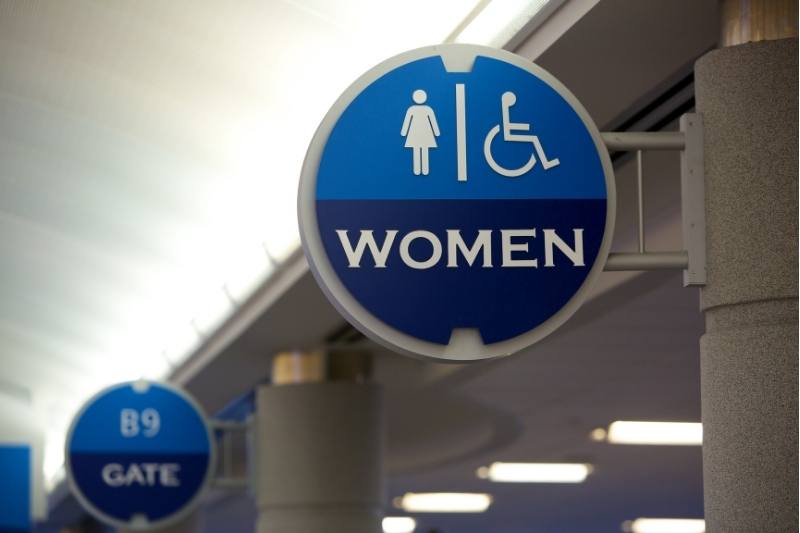
27 Bring your own headphones
Gone are the days when airlines handed out free headphones to everyone on the flight. Nowadays, unless you’re flying in first class or international travel, you need to plan to bring your own.
Some airlines have headphones for purchase, but you can’t count on that either. Of course, not all planes even have entertainment systems for you to plug into. If you’ve read the other tips for first time flyers we’ve already mentioned, you’ll know you should already plan to bring something to watch movies on anyway.
One thing to mention is that if the plane does have an entertainment system, it may have a two-pin socket. If that’s the case, you’ll need an adaptor to be able to plug your headphones in. This really only makes sense if you don’t plan on downloading your own movies to watch.
Another reason to bring your own headphones is to help with noise cancellation, especially if you’re flying at night. Something first time flyers might not realize is that the engines on airplanes can be loud. You may be seated near young children who can be loud. It’s also the universal symbol for “please don’t talk to me” if you’re sitting next to someone chatty.
Seriously, headphones are useful for more than just watching movies! Whether you pack an inexpensive pair just to get you through your first flight or want to block out all the extra noise going on around you, headphones can make flying first time much more enjoyable.

28 Pack essentials in your carry-on
Many travelers try to travel as light as possible, but there are times when we just can’t avoid checking a bag into the hold of the plane. In these circumstances, it may be tempting to put everything in the hold and to skip onto the plane light as a feather, carrying nothing at all (other than your phone and wallet, of course).
However, what if something goes wrong with your checked bag… ? Perhaps it gets delayed or lost in transit. Or perhaps you miss a connection and you can’t retrieve your bag from the baggage system while you wait for the next flight. You probably have travel insurance to cover any losses and delays, but having the losses covered financially is of limited comfort when you are separated from your personal possessions.
As evening turns to night, you realize how important basic things like toothpaste and pajamas are. And what about clean underwear and clothes the next day? Sure, you could buy new stuff, but that’s not ideal.
For this reason, it is a good idea to pack some essentials in your carry on, including a toothbrush and toothpaste, core toiletries, spare underwear, and a change of clothes – basically, the essentials you’ll want if you’re separated from your bag for a day or two.
by Martha from May Cause Wanderlust
Helpful tips for first time flying
If you’re going to be flying in a plane for the first time and are trying to prepare for what to expect, this list should cover it! Being prepared and knowing what to expect on your first flight is half the battle. Just follow the advice given here, especially if you’ll be flying alone for the first time and you’ll be just fine!
Enjoy your journey!
Karee Blunt
Karee Blunt is a nationally syndicated travel journalist, focused on discovering destinations and experiences that captivate and inspire others through her writing. She is also the founder of Our Woven Journey, a travel site focused on inspiring others to create memory-making adventures with their loved ones. Karee is passionate about encouraging others to step out of their comfort zone and live the life they dream of. She is the mother of six kids, including four through adoption, and lives with her family in the Pacific Northwest. You can learn more about Karee on her about me page.
- Karee Blunt https://ourwovenjourney.com/author/bluntpeeps/ A Close-up Look at Tulips (Like, Really Close Up) Plus Fun Facts You Probably Didn't Know
- Karee Blunt https://ourwovenjourney.com/author/bluntpeeps/ 15 Movies to Watch if You Loved "Eat, Pray, Love"
- Karee Blunt https://ourwovenjourney.com/author/bluntpeeps/ 15 Places You Need To Visit ASAP if You’re Into Wine Tasting
- Karee Blunt https://ourwovenjourney.com/author/bluntpeeps/ 15 Volcanoes Tourists Can Actually Visit
3 thoughts on “27 Best Tips for Flying for the First Time (2023)”
I will be traveling soon, September to be precise and this will be my first time boarding a plane, I’m kinda anxious cause I don’t know what to expect, I will be traveling from Nigeria to the Netherlands. I hope I get a smooth trip to my destination, after reading all the tips, I think I can do this
Hi Joy, how exciting that you’ll soon be taking your first flight! I truly hope you’re able to enjoy every minute of it. Try not to stress. You’re going on an adventure of a lifetime, but hopefully just the first of many more to come. 💗
Always eat food at the airport before you actually get onto the plane. There are so many cheap groundside restaurants at which you can order a meal from these days. Or merely take onboard your own free healthy snacks and things to do or stuff to read etc as well.
Consider audiobooks. You can find many different and cheap activity books located in the bookshops quite easily. Once on board the aircraft aim to spend the time flying in the air either drinking some white wine or reading/talking to the other travellers. I like to eat a dish of hot food beforehand.
Bring patience. You will need it for sure on route. Or take a shorter flight instead. Always a good idea. Research the hotels and activities at your destination carefully. Pick one that really appeals to you and also meets your needs. Good luck.
Leave a Comment Cancel reply
You must be logged in to post a comment.

First Time Flying? 35 Best Tips for First-Time Flyers
By: Author Kim Tate
Posted on Published: October 26, 2022
Taking to the skies for the first time can be a daunting experience, but with careful preparation, it doesn’t have to be. While you await your first time flying, there are some tips that you can use to help you have the best experience ever.
These tips work well for an international flight and domestic flights. This guide will help you understand all of the important things from the security checkpoint to understanding your boarding group – and everything in between.

In this article:
Best Tips for First-Time Flyers
1. check-in online.
Most airlines allow you to check in online up to 24 hours before your flight. This will help you avoid long lines at the airport and give you a better chance of avoiding a middle seat assignment. Online check-ins are the best because then you also have access to your flight number and gate number, right on your digital boarding pass.
Checking in online for your flight is a great way to save time at the airport. Simply log into the website or app for the airline you’re flying. There should be a button for you to press “check-in.” Once you press that button, you’ll be able to check in for your flight using your confirmation number and last name.
Don’t forget to arrive at the airport early so you can go through airport security and get to your gate on time. If you are checking bags, you will still need to go to the gate counters at the airport. Checking in online is a great way to make flying a breeze, so be sure to give it a try next time you travel.
2. Arrive early
Make sure to arrive at the airport at least two hours before your flight is scheduled. Whether you’re traveling for business or pleasure, it’s always a good idea to arrive early at the airport. Check-in and security lines can be unpredictable, and you don’t want to miss your flight because you were running late.
If you’re flying internationally, airlines typically ask you to arrive three hours before your flight.
Arriving early also gives you time to relax and grab a bite to eat before boarding. If you have any time to spare, you can also use it to do some last-minute shopping in airport stores.
Keep in mind that most flights start boarding about 45 minutes before the departure time. Also, know that many flights close the boarding door 10-15 minutes before the departure time.
So, next time you’re booking a flight, make sure to leave plenty of time for airport arrivals. It’ll make your journey that much smoother.
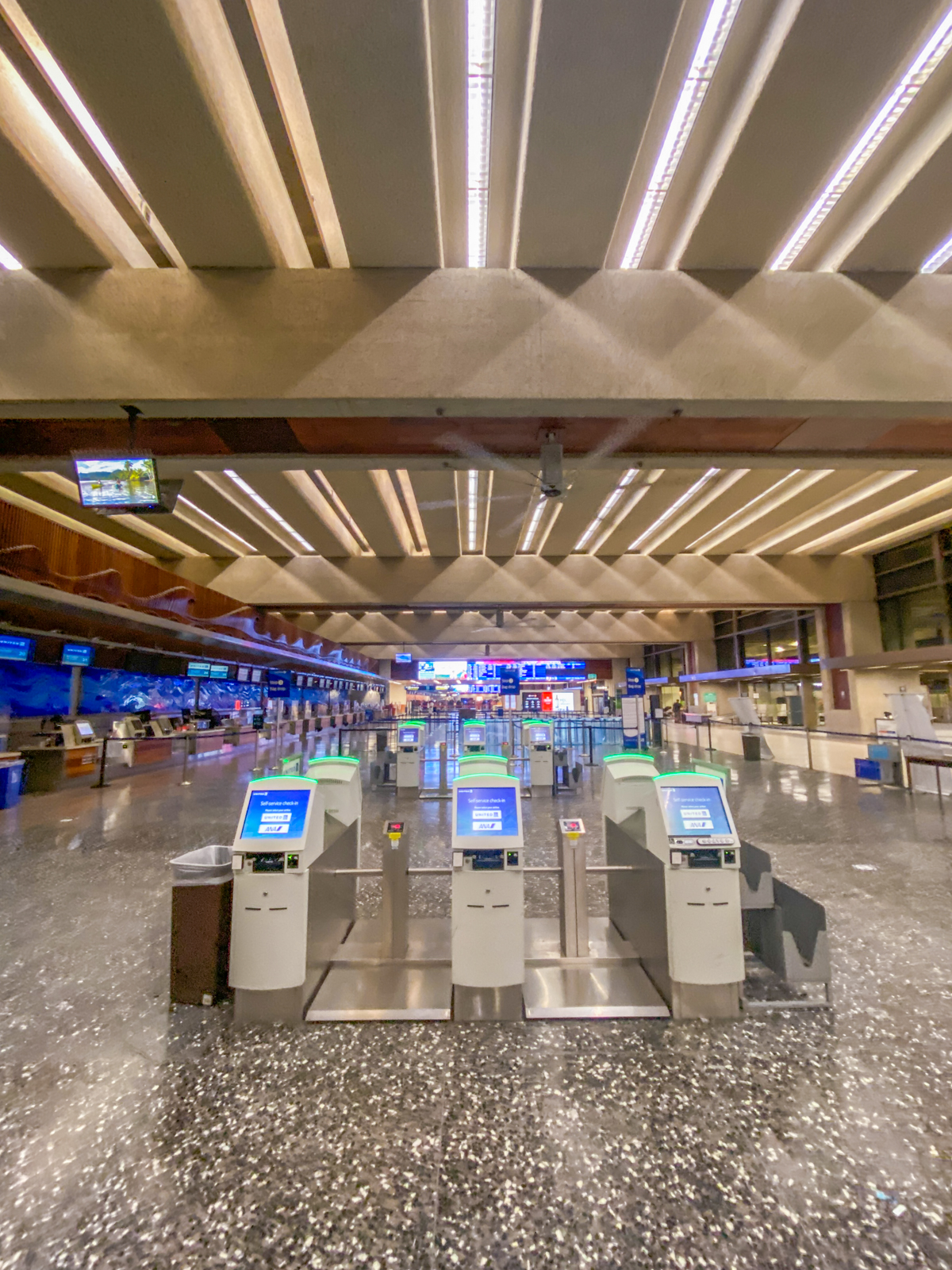
3. Get travel insurance
Even if you’re only flying for a short trip, it’s always a good idea to get travel insurance. This will protect you in case of any delays, cancellations, or losses. Some credit cards include travel insurance, but often have limitations.
Travel insurance can also cover you in case of injury or medical emergency or if you need to cancel your trip for any reason. Be sure to read the fine print of your policy so you know what’s covered.
Getting travel insurance is a great way to protect your finances while you’re on vacation. It’ll give you peace of mind in case anything goes wrong.
4. Join an airline loyalty program
If you fly frequently, it’s a good idea to join an airline loyalty program. These programs give you points for every flight you take, which you can then use to get free flights or other perks.
Some programs also allow you to upgrade your seat for free or get priority boarding. If you fly often, signing up for a loyalty program can help you save money and make flying more enjoyable.
5. Bring your own food and snacks
Airplane food can be expensive and not always the tastiest. To avoid spending money on airplane food, or going hungry on your flight, bring your own snacks and meals.
You can pack a sandwich, some fruit, or even some chips to munch on during your flight. Just be sure to check the airport’s rules about bringing food through security. Also, be mindful of life-threatening allergies and try to avoid bringing peanuts or tree nuts on flights.
Bringing your own food is a great way to save money and make sure you have something to eat during your flight.

6. Stay hydrated
It’s important to stay hydrated when you’re flying, as the air in airplanes is very dry. Be sure to drink plenty of water before, during, and after your flight.
You can also bring your own empty water bottle to fill up after you go through security. This will save you money and help you stay hydrated during your flight.
7. Dress comfortably
When choosing what to wear on your flight , comfort should be your number one priority. You’ll be sitting in a confined space for hours, so you want to make sure you’re wearing clothes that won’t make you uncomfortable.
Avoid wearing anything constricting, like jeans or a tight top. Instead, opt for loose-fitting clothing made from breathable fabrics. I typically wear aerie leggings with a side pocket or prAna hiking pants. I also bring a hoodie or cardigan in case the airport or plane is cold.
Dressing comfortably is key to having a pleasant flight. Be sure to wear clothes that won’t make you feel uncomfortable during your journey.
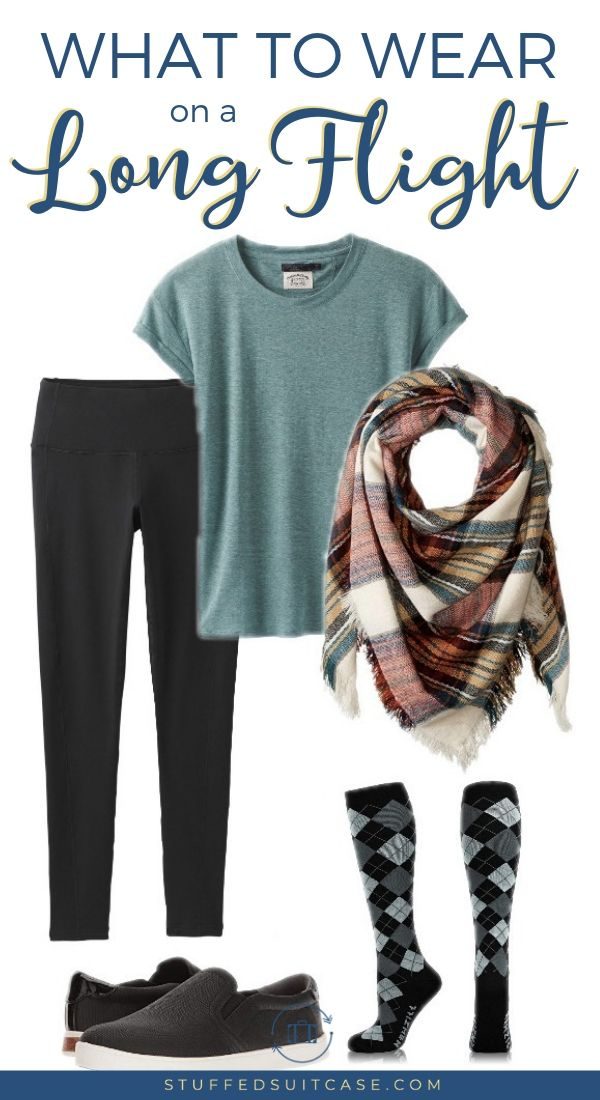
8. Bring a neck pillow
If you want to get some sleep on your flight, be sure to bring a travel pillow . This will help you stay comfortable and avoid pain in your neck and back.
There are a variety of different neck pillows to choose from, so be sure to find one that’s comfortable for you. You can also use it on long car rides or train journeys.
9. Use noise-canceling headphones
If you want to block out the noise on your flight, be sure to bring noise-canceling headphones. These headphones will help you sleep or concentrate, and they’ll make your flight more enjoyable.
Noise-canceling headphones are also great for blocking out crying babies or chatty seatmates. Be sure to pack a pair in your carry-on bag so you can use them on your flight.
10. Bring a good book or movie
To make your flight more enjoyable, be sure to bring a good book or movie. This will help you pass the time and make your flight go by faster.
If you get motion sickness, it’s also a good idea to bring a movie to watch. Watching a film can help distract you from the motion of the plane and make you less likely to feel sick. Of course, pack some motion sickness meds like Dramamine and ginger candies.

What NOT to Do Your First Time Flying
First-time flyers have a lot to learn – and there are plenty of potential mistakes that can be made along the way. To help you avoid some of the most common pitfalls, we’ve compiled a list of things NOT to do as a first-time flyer. For the most part, these are general rules of thumb for any airline. However, it’s always a good rule to look at the airline’s website to see what they have as acceptable and not acceptable, rule-wise.
1. Don’t forget to pack your carry-on essentials
This seems like a no-brainer, but you’d be surprised how many people forget to pack important items like their passport or medications. Make a list of must-have items before you start packing, and double-check that everything is in your bag before you leave for the airport.
2. Don’t overpack your carry-on bag
While it’s important to make sure you have everything you need, there’s no need to pack your entire wardrobe into your carry-on bag. Not only will this make it difficult to lug around the airport, but it could also get you stopped at security if your bag is too heavy or overstuffed.
3. Don’t wear bulky clothes or shoes
Again, security is a consideration here – you’ll want to avoid anything that will slow you down when going through the metal detectors. In addition, bulky clothing can be uncomfortable on a long flight, so it’s best to stick with more comfortable, form-fitting options.
4. Don’t forget to pack your headphones
If you want to watch in-flight entertainment or just drown out the sound of other passengers, you’ll need a good pair of headphones. Make sure to pack them so they’re easily accessible in your carry-on bag or at your seat.
5. Don’t wait until the last minute to book your flight
This one can be a real budget-buster – airlines typically release their cheapest seats well in advance, so waiting until the last minute to book is almost always going to cost you more. If you have flexibility in your travel dates, try to book your flight at least a few weeks in advance.
You also risk limited seat options when you book too late, and no one wants to pay hundreds of dollars to find themselves stuck with only having middle seats available.
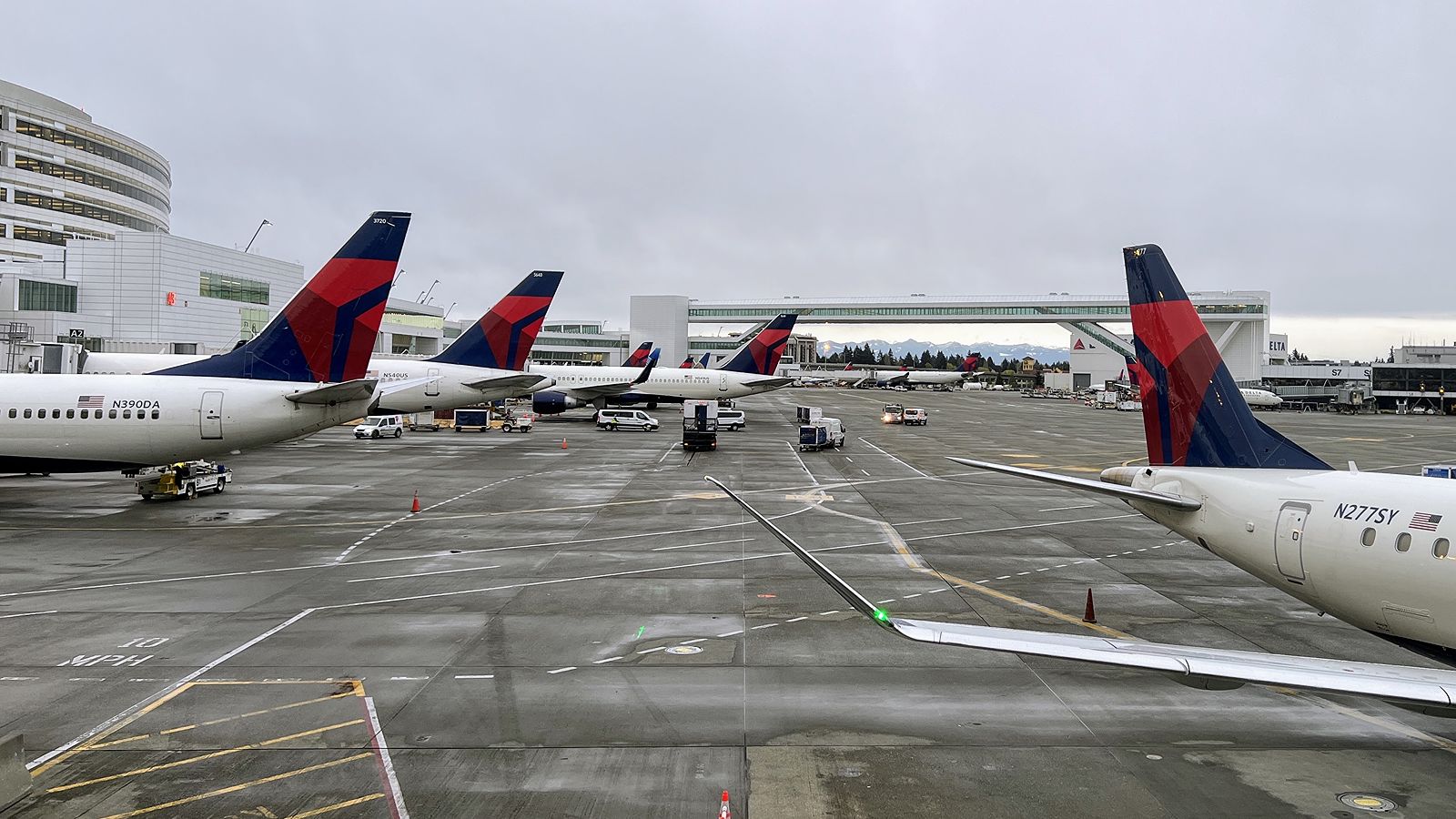
6. Don’t neglect to research your destination
Before you book your flight, take some time to research your destination and find out what there is to see and do. This will help you plan your trip and make the most of your time once you arrive.
7. Don’t skip the pre-flight safety briefing
Yes, it can be tedious to sit through another safety demonstration, but it’s important to pay attention in case of an emergency, especially for first-time flyers!
Plus, the safety briefing is your chance to find out where the exits are located – something that could come in handy if you ever need to evacuate the plane. It also helps you know the airline rules.
8. Bring something to keep your busy
Bring some books, magazines, crosswords, or whatever else you need to keep your mind occupied during the flight. Also, check to see how you can watch movies if that’s of interest. Some airlines have seatback screens, while others tell you to bring your own screen (i.e. phone or tablet) and download an app in advance to watch movies or tv shows.
Make sure you have easy access to these items, too. Your seat belt sign may be turned on and you won’t be able to access your upper bin carry-on bag, so keeping your entertainment items in a personal item bag at your feet can come in handy.
9. Don’t forget your travel documents
This one is essential – without your passport or other required travel documents, you won’t be able to get on the plane. Make sure you have everything you need before you leave for the airport and keep your documents handy to present them at security or during boarding.
Take note that if you’re flying domestically (in the USA) you don’t need a passport, but you will need an authorized government ID, like a driver’s license. Starting in May 2023, your state’s ID will need to be REAL ID compliant in order to be used to fly.
10. Don’t dress inappropriately
There’s no need to break out your best clothes for a flight, but it’s important to dress comfortably and avoid anything that could be considered offensive or inappropriate. In general, it’s best to err on the side of caution when choosing your travel outfit. Airlines have the right to refuse you boarding if your clothing is harmful or inappropriate.
Following these simple tips will help you avoid some of the most common mistakes that first-time flyers make. With a little preparation and planning, you can make your first flight an enjoyable and stress-free experience.
Tips for First-Time Flyers At the Airport

As you walk into the airport, you may be trying to understand how everything works. This section will give tips for first-time flyers at the airport. These tips will cover how to not get stressed, when you should board the plane, and everything in between.
Try not to get stressed out by security
It’s normal to feel a little anxious when going through security, but remember that everyone is just trying to do their job. Just relax and follow the instructions of the TSA agents. Keep in mind that you should move quickly and try not to get irritated at a TSA agent asking you to do something, it’s just a part of their job.
If it’s your first time flying, you likely don’t have any special security clearance like TSA PreCheck, so be prepared to remove your toiletries bag, your laptop, as well as coats, belts, and shoes. Also know that security checks can be random, so if an alert goes off and you’re moved for a secondary screening, just stay calm and follow the directions.
The security line could be considered the most stressful part of the trip, but the only way to get through it is to stay calm and allow plenty of time before your flight.
Don’t leave your bags unattended
This seems like common sense, but you’d be surprised at how many people do this. Unattended bags are a major security risk and will likely be confiscated by security. So, make sure to keep an eye on your belongings at all times. This is without a doubt a universal rule in airports. Don’t leave your bags unattended.
Double-check the weight and size of your luggage
This will save you a lot of hassle at the airport. Before you start packing, check for the size restrictions for carry-on and checked baggage for your airline. This will help you avoid any problems at the ticket counter, security, or the gate.
Make sure to weigh your bags before you go to the airport and know in advance what the fees are for checking luggage, so you’re not surprised at the check-in counter.
Don’t drink too much at the airport
You’re probably excited for your vacation and want to start relaxing as soon as possible, but it’s important not to drink too much at the airport. Alcohol can dehydrate you and make it more difficult to adjust to the time change. So, try to limit yourself to one or two drinks.
Airlines can also stop you from boarding if you’re too intoxicated. A first-time flyer should also try not to drink too much since they’ll want to be alert for the new experience and any decisions they need to make.
Grab some food before you get on the plane
If you’re flying during mealtime, make sure to grab something to eat before you get on the plane. Airplane food can be expensive and not very good. So, it’s always a good idea to have a little something in your stomach before you board.
Keep in mind that if you’re bringing any food or snacks on the plane, it’s considerate to try and avoid any strong-smelling foods that will make the plane smell.
Listen for your zone to be called
When it’s time to board the plane, they will usually call out the different zones in order. Listen for your zone to be called and then make your way to the line. Your boarding group should be marked on your boarding pass, but if you’re not sure what zone you’re in, just ask one of the gate agents.
If you want to enjoy dining and shopping at the airport before your flight, that’s fine. Just know that a general rule of thumb is to get to the gate at least 10 minutes before the plane’s boarding time. That’s BOARDING time, not flight time. Boarding time is typically around 30-45 minutes before your flight time and many airlines close the boarding gate door 10-15 minutes before the flight time.

Have your boarding pass and ID ready
This will help the process go much smoother. When you get to the front of the line, have your boarding pass and ID out so that the agent can easily scan it. If you’re fumbling around for your things, it will just hold up the line.
First-Time Flying Tips for Getting Off the Plane
Now that you’ve made it through your first flight, it’s time to get off the plane. Here are some tips for making a smooth exit:
Listen to the flight attendants
They will give you specific instructions on when and how to disembark from the aircraft. It’s important to listen to them because that’s what will get you off the plane the fastest! Always be respectful to your cabin crew, I like to always thank them when deplaning.
There will be a lot of people trying to get off the plane at the same time as you. Be patient and wait your turn. There’s no need to rush! Also, if you’re in the back, you are going to be waiting a while to get off the plane. While you may be anxious to stand up, you shouldn’t be in a big hurry because everyone else is in the same big hurry – which means everyone will be moving slowly.
Call your ride
When you land, it’s a good idea to check in with anyone who might be meeting you. This way, they will know that you’ve landed and approximately when to expect you.
Have your carry-on ready
If you have a carry-on bag, make sure it’s easily accessible so you can grab it and go as soon as it’s your turn to leave the plane. There’s nothing worse than having to dig around to find your bag when you’re trying to make a quick exit!

Follow the crowd BUT read signs
When you’re getting off the plane, it’s easy to follow the crowd. Many of them might know where they’re going and they’ll lead you to the right place. But, the best thing to do is to look for signs.
If you checked a bag, you’ll want to look for baggage claim signs. If you don’t need to go to baggage claim, you’ll likely head towards that area anyway and look for signs for ground transportation.
Hopefully, these tips will help you while you’re getting off the plane! It can be hard as a first-time flyer to know exactly what to do, but these tips will help you tremendously!
Etiquette Tips for Flying on a Plane
When you fly on a plane, there are certain etiquette rules that you should follow in order to make the experience more enjoyable for everyone. Here are some tips to keep in mind:
- Be respectful of other passengers and try not to disturb them. This includes keeping your voice down, not playing music or watching videos without headphones, and being mindful of personal space.
- Follow the rules and regulations of the airline and airport. This includes things like not bringing prohibited items on the plane and following security procedures.
- Be considerate of the crew members and listen to their instructions. This includes staying seated during turbulence and putting away carry-on luggage during takeoff and landing.
- Try to be patient and understanding if there are any delays or other problems.
- The person next to you may or may not want to have a conversation with you. It’s okay to say hi and strike up a conversation if the other person seems receptive, but don’t force it if they’re not interested.
- Pay attention to the seatbelt sign. It’s there for a reason, and it’s important to follow the crew’s instructions for when to buckle up.
- Be mindful of your personal hygiene. This includes things like using deodorant, brushing your teeth, and wearing fresh clothes. It’s also considerate to not wear perfumes or colognes when flying as some people are sensitive to scents.
- If you have food or drinks, be careful not to spill them on yourself or other passengers. Also, try not to pack allergens like nuts, and avoid strong-smelling foods.
- Try to keep your belongings organized and tidy, so that you’re not taking up more space than necessary or causing a mess.
- Make sure you have your credit card handy, so you don’t have to dig for it when the snack cart rolls through.
Following these etiquette tips will help to make your flying experience more pleasant for everyone involved.
Tips for Sitting in the Small Seats on the Airplane
Sitting in a small seat on an airplane can be quite uncomfortable, especially if you are tall or have long legs. Here are some tips to make the experience more bearable:
- Wear comfortable clothing that won’t restrict your movement. Read my post on what to wear on a long flight .
- Try to book an aisle seat so you can stretch your legs out into the aisle. But, don’t leave them there. People need to walk through the aisle and your feet don’t belong there.
- Another option is to book a window seat if you enjoy leaning and want to sleep as the wall of the plane makes that more comfortable than aisle seats.
- Pack some carry-on essentials to keep you comfortable and entertained.
- Pack light so you don’t have to struggle with heavy luggage in a small space.
- Bring a neck pillow and blanket to make yourself more comfortable.
- Avoid eating or drinking too much before your flight to avoid having to use the restroom frequently.
- Get up and walk around the cabin every few hours to keep your blood flowing.
- Wear compression socks to help prevent blood clots.
- Stay hydrated by drinking plenty of water during the flight.
- Protect yourself from germs by using hand sanitizer and avoiding touching surfaces in the cabin.
- Long-haul flights can be uncomfortable, so make sure you get up to use the bathroom, so you can stretch!
By following these tips, you can make sitting in a small seat on an airplane more bearable and even somewhat enjoyable. After all, it’s only for a few hours and then you’ll be at your destination!
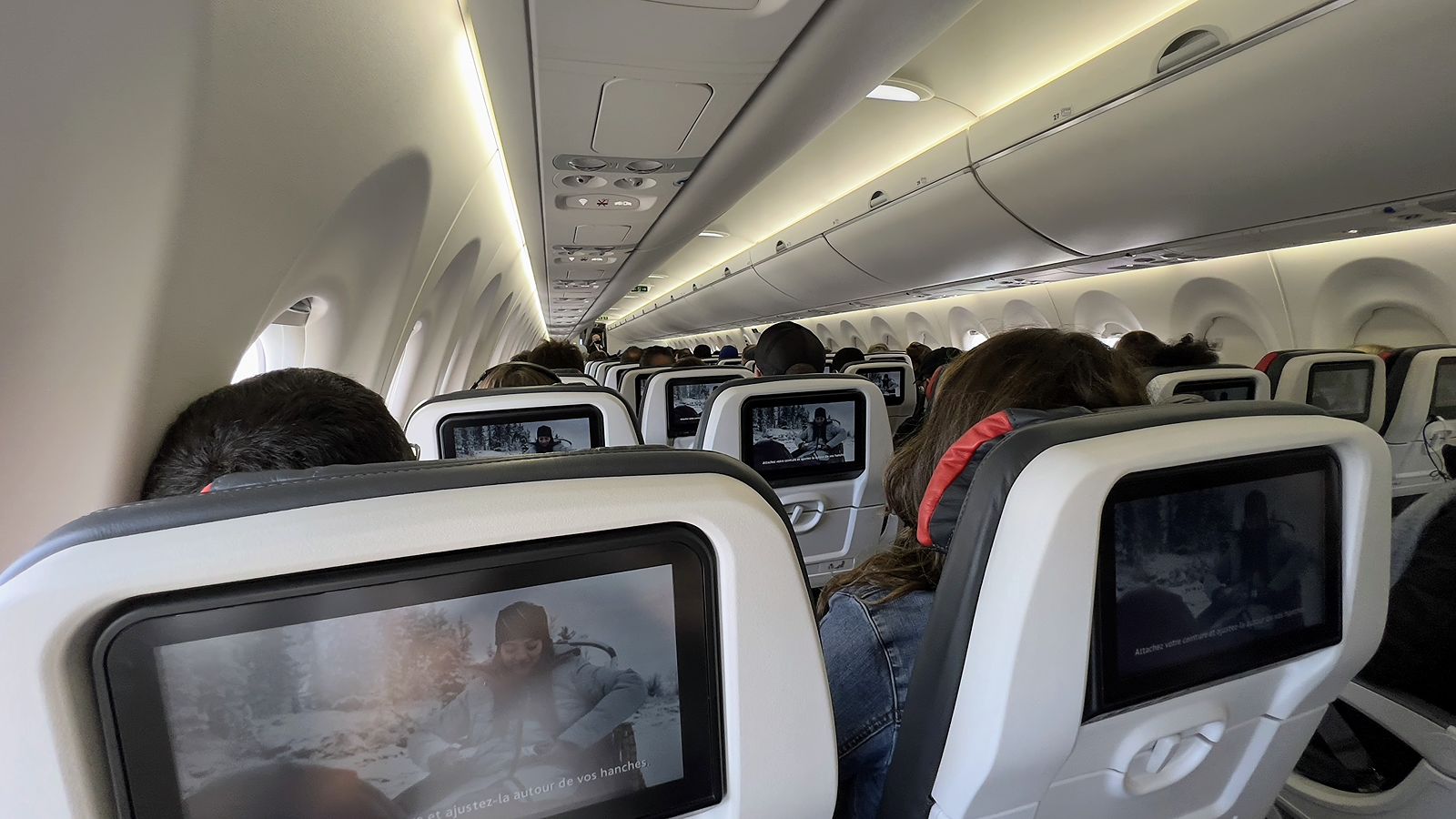
Tips for First-Time Flying Anxiety
- Air travel is the safest mode of transportation and becoming safer. It’s more dangerous to drive or run along a street. A NY Times article quoted an MIT professor who studied air travel and he determined that “ flying has become so reliable that a traveler could fly every day for an average of 123,000 years before being in a fatal crash. ”
- Develop and learn some stress-coping techniques. Meditation, body relaxation, and calming music can help you relax and combat the anxiety you might feel about flying. If your anxiety is really bad, you can talk with a physician about prescribing you medicine to help you calm down.
- Keep busy. Load up your phone or tablet with some shows or movies you want to watch or love. Or download some great books that will hold your interest. If you have something else to focus on, it can help keep you from focusing on your fear.
- Look to the flight attendants; they fly all of the time. Seeing them at ease and going about their work as if they’re on the ground instead of the air can help put you at ease. They’re also the ones to listen to in order to stay safe. If I do have turbulence or worry, seeing them at ease always helps make me realize that everything is operating as normal.
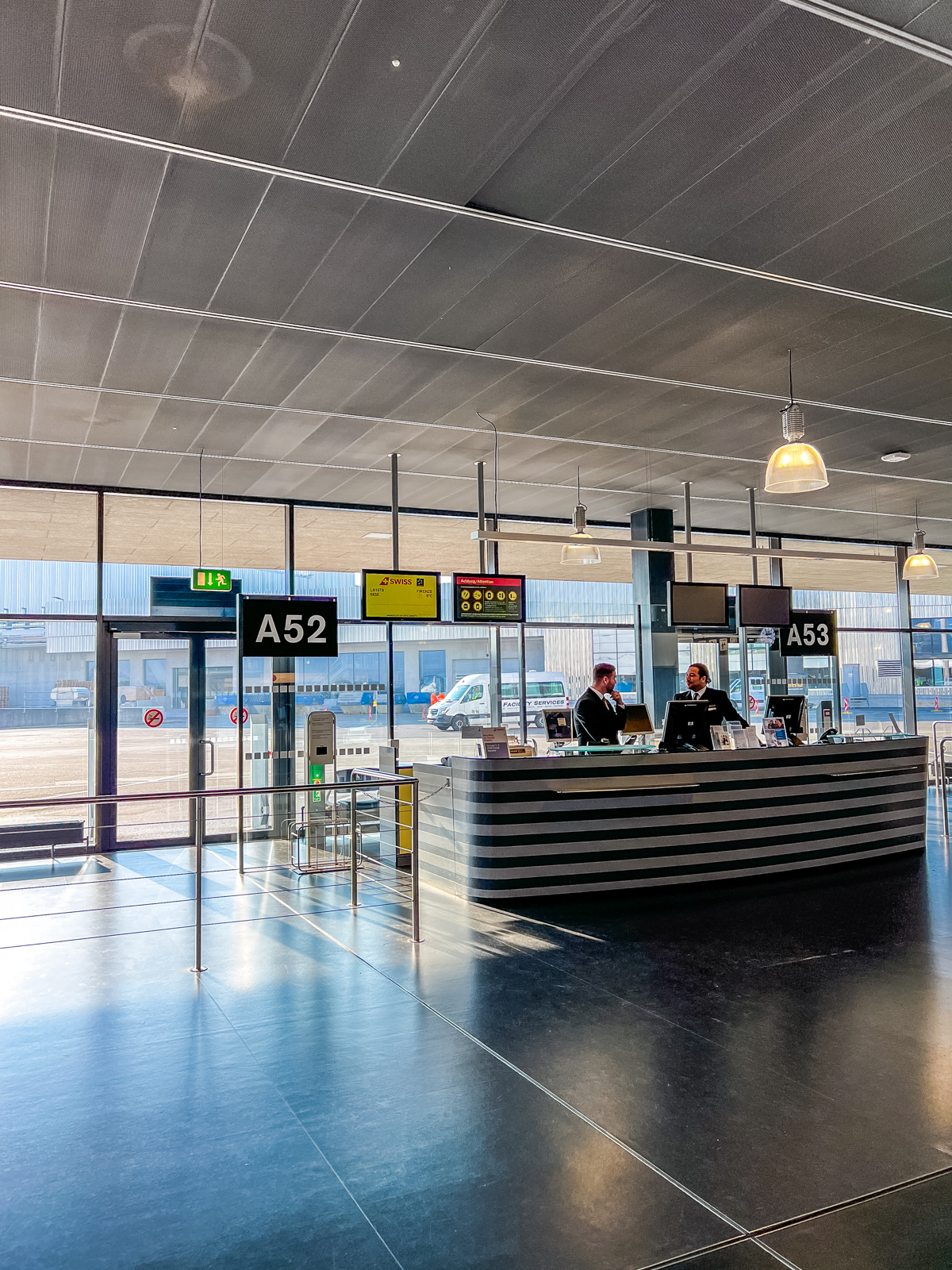
FAQs for Your First Time Flying on a Plane
Flying on a plane can be a nerve-wracking experience, especially if it’s your first time flying. But there’s no need to worry – we’ve got you covered with everything you need to know about flying, from the basics of booking a ticket to what to expect during your flight.
What are the different types of aircraft?
The most common type of aircraft is the single-aisle plane, which has one aisle running down the middle of the cabin. These planes are used for short and medium-haul flights.
The next most common type is the wide-body plane, which has two aisles running down the middle of the cabin. These are used for long-haul flights. Most planes are made by Boeing or Airbus.
What are the different classes on a plane?
There are three main classes on a plane: first class, business class, and economy class. First class is the most expensive and has the most amenities, while economy class is the least expensive and has the least amenities. Business class is in between these two extremes, but closer to a first-class experience.
Many airlines have started adding a premium or comfort class to their economy cabin. These seats often have a bit more legroom, but may just include pre-boarding.
What is the difference between a non-stop flight and a connecting flight?
A non-stop flight is a direct flight from one airport to another, while a connecting flight stops at one or multiple airports along the way. Connecting flights could be cheaper than non-stop flights, but they take longer and delays may affect your plans.
There are some cases where a flight is called a direct flight but it’s not non-stop. Direct flights don’t involve changing planes or a different flight number, however, they may involve a stop at another airport to
How do I book a flight?
You can book a flight online, through a travel agent, or by calling the airline directly. When booking online, you’ll need to provide your personal information and payment details. When booking through a travel agent, they will take care of everything for you. When calling the airline, you’ll need to provide your personal information and flight details, and many airlines charge a fee for phone bookings.
Booking online directly with the airline is typically the best option for pricing and cancellation. Although, you can shop for flight options online with various travel sites and google.com/flights.
What do I need to bring with me to the airport?
When flying, you’ll need to bring your passport, boarding pass, and any other required documents. You’ll also want to pack light, as you’ll have to carry your luggage with you through the airport. Most airlines have a limit of 50lbs per bag, so be sure to check the weight and size restrictions before packing.
What can I expect during the security screening process?
All passengers are required to go through a security screening before boarding their flight. This usually involves going through a metal detector and having your bags scanned by an x-ray machine. You may also be selected for a random pat-down search.
What should I do if I’m selected for a secondary screening?
If you’re selected for a secondary screening, you’ll be taken to a private area for a more thorough search. This may involve having your bags searched by hand and being asked to remove your shoes and jacket.
What can I expect during the boarding process?
When it’s time to board your flight, you’ll need to have your boarding pass and passport ready. You’ll be asked to show these documents to the gate agent, who will then scan your boarding pass and allow you to board the plane. Once on the plane, you’ll find your seat and stow your carry-on luggage in the overhead bin.
What can I expect during the flight?
Once the plane takes off, you’ll be able to sit back and relax. The flight attendants will come around with drinks and snacks, and you can watch a movie or TV show on the in-flight entertainment system. If you need anything during the flight, just ask one of the flight attendants. They’re there to help!
What should I do if I have a problem during the flight?
If you have any problems during the flight, such as lost luggage or an issue with your seat, just ask one of the flight attendants for help. They will be able to assist you and solve the problem.
What should I do when the plane lands?
When the plane lands, you’ll need to gather your belongings and disembark the plane. If you have any checked luggage, it will be waiting for you at the baggage claim area. From there, you’ll be on your way to your final destination!
These tips for first time flyers are important. If you don’t know what to do when you fly for the first time, this guide will help you out. Once you fly on a plane for the first time, you will be good to go after that! With a little experience, you will become less and less stressed about any flight that you take!
The only thing left to pay attention to when you’re a first-time flyer is yourself. Flying can be the best thing because you get extra time to relax and enough time to finally finish that book you’ve been wanting to read.
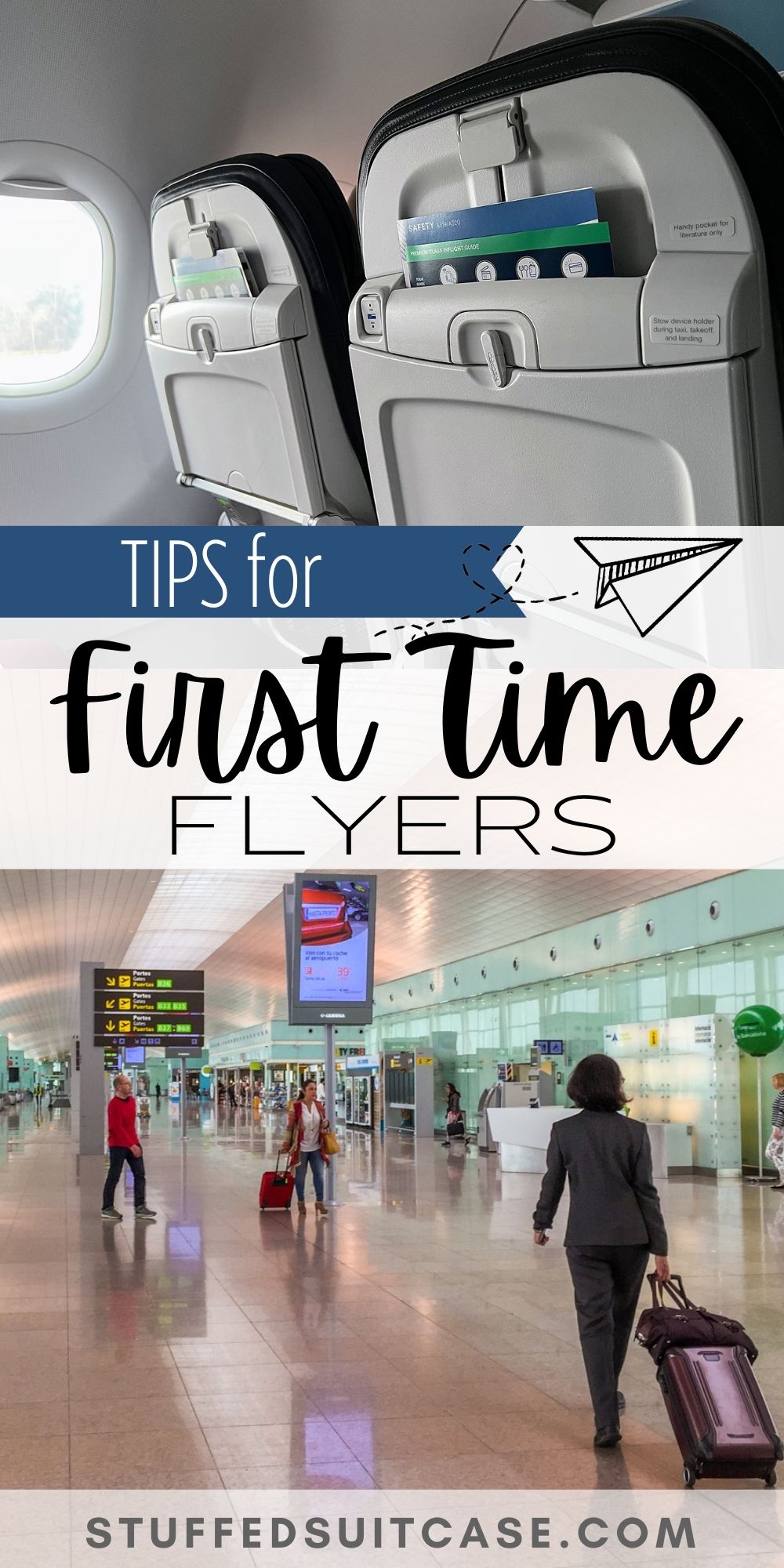
Share and Save This Post:
Friday 26th of May 2023
These are my tips for success. Plan your entire trip carefully. Try to make some brief summary notes. Best of luck. If you can do so, please do check in online. Be kind and friendly too. I love your blog as well.
Smile at folks. It is a good idea to eat dinner at the airport. Give way to people who may be in a rush. Know the general layout of the airport. Also pay very careful attention to security rules. In other simple words it is wise to be totally smart. You can do this.
Never rush. Have fun. An airport does not have to be a scary place. Far from it in fact. Remember that always. Request assistance if that makes you feel better. Stay calm and positive. Arrive early. Recommended at all times.
Beat the long queues. Last week I was at the airport nearest my home. I got there much earlier. Straight after passing security I decided to eat. So I had a meal before going to board. It was really worth it. I ordered fish and chips. Then I did shopping in the airport. Finally I boarded.
Bring puzzles. Pack a entire suitcase in advance. Call the airport ahead of time to help yourself. Inform them you require extra time to get onto the plane in question. I took a bag full of books this time in case. I read them in the departure area of the airport.
Read beyond the lines. I was equipped with hand gel and my water bottle.
Conquer the Skies: Ultimate Airplane First-Time Flyer Tips

We use affiliate links, and receive a small commission if you make purchases through them. Find out more here .

Unlock the Ultimate Guide to Airline Luggage Allowances
Don’t get caught off guard by unexpected baggage fees! With this comprehensive eBook, you’ll have all the information you need at your fingertips.
You have successfully joined our subscriber list.
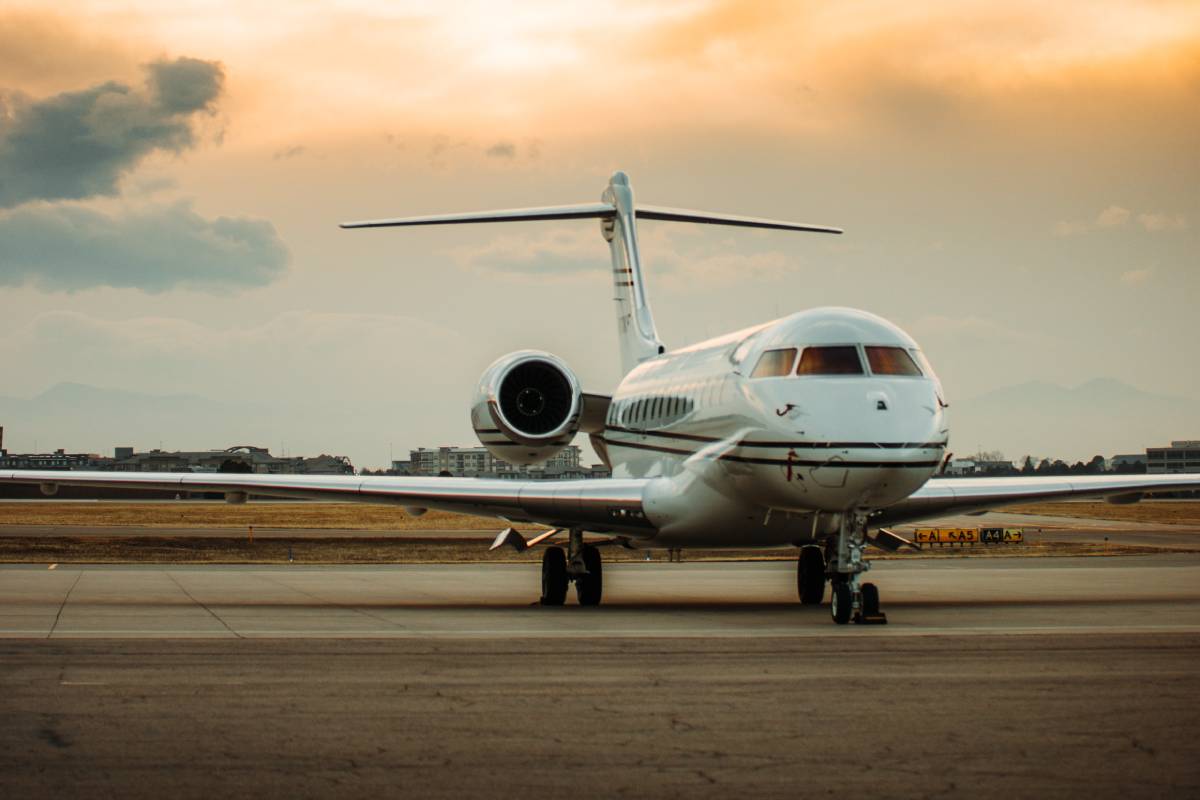
In the wise words of Captain Chesley “Sully” Sullenberger , retired airline pilot and aviation safety expert, “The best tip for first-time flyers is to be prepared. Know what to expect, plan ahead, and don’t be afraid to ask for help if you need it.”
Ready for a smooth flight ? Strap in, folks – this journey begins now.
- Preparation is key for first-time flyers
- Strategies to reduce flight anxiety
- Navigating airports and in-flight etiquette
- Packing tips for an easy journey
- Advice for making the most of your flying experience
Also check out: Airplane layover tips
Fly Right: Conquer Pre-Flight Preparation
Before you sprint towards the gate, preparation begins at home.
Tip 1: Document Check
Keep your ID, passport, and boarding pass handy. Many airlines offer digital boarding passes, eco-friendly and difficult to misplace.
Tip 2: Pack Smart
Avoid checked luggage fees and save time by packing carry-on only. Pack essentials in a clear, plastic bag for quick security checks.
Smooth Sailing: Navigating the Airport Maze
Airports can be overwhelming, but with these tips, you’ll glide through with ease.
Tip 1: Early Bird Gets the Flight
Arrive at least 2 hours early for domestic, and 3 hours for international flights. This accounts for any unexpected delays.
Tip 2: TSA PreCheck is Your Friend
To expedite security checks, consider applying for TSA PreCheck. It’s a game-changer!
Sky High: Mastering In-Flight Etiquette
Airplane etiquette is crucial to ensure a pleasant flight for everyone on board.
Tip 1: Be Mindful of Shared Space
From armrests to lavatories, remember that you’re sharing a space. Keep your area clean and respect others’ personal space.
Tip 2: Hydrate, Hydrate, Hydrate
The cabin’s dry air can dehydrate you quickly. Drink plenty of water and avoid excessive caffeine or alcohol.
The Sky’s the Limit: Making the Most of Your First Flight
Your first flight doesn’t have to be a nerve-racking experience. Enjoy the journey!
Tip 1: Entertainment at 30,000 Feet
Airlines often provide in-flight entertainment. But don’t rely on it solely, bring a book or download movies on your device.

Tip 2: Jet Lag is Real
For long haul flights , adjust your sleeping and eating schedule to the destination time zone before you travel.
Now you’re ready to face your first flight with confidence. Don’t forget to savor the experience. After all, you only have one first flight. Soar high, travelers!
What can I bring on my first flight?
The Transportation Security Administration (TSA) has specific rules for what can be brought onto a plane. This includes restrictions on liquids and certain items. Check the TSA website for a detailed list.
How early should I arrive for my flight?
For domestic flights, aim to arrive at least 2 hours before departure. For international flights, make it 3 hours.
How can I overcome my fear of flying?
Understanding the basics of how planes work and the safety measures in place can help. Also, employing relaxation techniques like deep breathing or listening to calming music can alleviate anxiety.
What should I do during a long flight?
Stay hydrated, get up and move around periodically, and bring entertainment like books or downloaded movies.
What’s the best way to deal with jet lag?
Adjusting your schedule to the destination’s time zone a few days before your flight can help. Also, make sure to stay hydrated and get plenty of rest.
Can I bring my own food on a flight?
Yes, you can! Airlines usually allow passengers to bring their own food, but it’s advisable to avoid anything too messy or with strong odors out of respect for your fellow passengers.
How should I dress for a flight?
Opt for comfort over style. Wear layers to adjust to varying cabin temperatures, and choose shoes that are easy to remove during security checks and comfortable for walking long airport distances.
What if I feel sick during the flight?
Air sickness is a common issue, especially for first-time flyers. If you’re prone to motion sickness, consider over-the-counter medications. In flight, closing your eyes, looking at the horizon, or lying back can help. Don’t hesitate to inform a flight attendant if you’re feeling unwell; they’re trained to assist you.
What is the procedure for connecting flights?
If you have a connecting flight, upon landing at your layover airport, you’ll need to check the departure screens for the gate number of your next flight. Ensure you have enough time to reach the gate, which might involve another security check.
Any secret tips for enjoying a flight?
Absolutely! First, choose your seat wisely. Aisle seats are great for easy restroom access, while window seats offer great views and a wall to lean on for sleep. Also, bring noise-cancelling headphones for a peaceful journey, and consider bringing your own food and snacks for healthier and often tastier options.
Check out more of our useful tips: Best airplane snacks
- “Can I Bring It on an Airplane?” Transportation Security Administration.
- “Top 10 Tips to Beat Motion Sickness.” WebMD.
This post is also available in: English Deutsch
You Might Also Enjoy

One response to “Conquer the Skies: Ultimate Airplane First-Time Flyer Tips”
Kevin, your post stirred up fond memories of my own adventures in the Adirondacks. The thrill of reaching the summit of Mount Marcy is indeed a unique experience! Have you ever tried hiking in winter? It’s a completely different challenge. I’d also recommend the lesser-known Ampersand Mountain for a quieter, yet equally rewarding hike. 💪😃 Would love to hear about your lesser-known hiking gems. Keep the stories coming, Kevin!
Leave a Reply Cancel reply
Your email address will not be published. Required fields are marked *
Save my name, email, and website in this browser for the next time I comment.
Featured in

GET CONNECTED
Follow Clever Journey on social media for travel tips, packing hacks, and latest updates!
SUB TO NEWSLETTER
Subscribe to our newsletter to get the latest travel tips, packing hacks, gear reviews, and bargain deals straight to your inbox. We hate spam, so we’ll send only the most important stuff.
- Deutsch ( German )
Simple Flying
Airline travel 101: a beginner's guide to flying.
Flying for the first time? Here’s what you need to know
Airline travel has become an essential part of modern life, connecting people across the globe and making the world more accessible than ever before. If you're new to flying or simply want to brush up on your knowledge, this beginner's guide to airline travel will provide you with everything you need to navigate the skies with confidence.
First things first
The first step in airline travel is booking your flight . Start by choosing your destination and preferred travel dates. Visit airline websites or online travel agencies to compare prices and flight options. Consider factors such as layovers, airline reputation, and baggage allowances when making your decision. Once you've selected your flight, follow the booking process, provide passenger information, and complete the payment to secure your ticket.
Next, consider what and how you’ll be packing for the trip. Check the airline's baggage policy to determine the allowed size, weight, and number of bags. Make a checklist of essential items, including travel documents (passport, ID, and visa), tickets, electronic devices, chargers, medications, and necessary clothing.
Remember to pack liquids in accordance with aviation security rules. Oftentimes, you’ll need to follow the 100ml rule and place liquids, aerosols, and gels in a clear, resealable bag.
Want answers to more key questions in aviation? Check out the rest of our guides here .
All packed? You’re ready to go!
Before your flight, it's essential to check-in. Most airlines offer online check-in, allowing you to select seats, print boarding passes, and avoid long queues at the airport. Online check-in typically opens 24 hours before departure.
If you prefer doing this in person, head to the check-in counter at the airport. Note that some low-cost airlines might charge you for an in-person check-in, so definitely log in before your flight to confirm. Whether you check in online or at the airport, if you have luggage to check , arrive at the airport (wear comfortable clothes for the flight!) with sufficient time to complete the check-in process and drop off your bags.
Get the latest aviation news straight to your inbox: Sign up for our newsletters today.
Airport security procedures are designed to ensure the safety of all passengers. Familiarize yourself with the regulations to make the security screening process smoother. Prepare by removing any metal objects, electronics, and liquids from your carry-on bag for separate screening. Nearly all airports need you to pass through a metal detector and/or a full body scan to check for any dangerous substances. Ensure you don't have anything in your pockets and remove any heavy layers to avoid further scrutiny.
Some airports may require you to remove your shoes too. Simply follow the instructions of security personnel, place your belongings in the provided bins, proceed through the metal detectors or body scanners, and you’re good to go.
Once through security, keep an eye on the information screens for your flight's gate number and boarding time. Airlines usually begin boarding with specific zones or groups, so pay attention to the announcements and follow the instructions. Have your boarding pass and identification ready for inspection, and proceed to the aircraft when your zone is called.
Taking to the skies
Once onboard, find your assigned seat and stow your carry-on luggage in the overhead compartment or under the seat in front of you. Fasten your seatbelt and listen to the safety instructions provided by the flight attendants.
During the flight, don’t forget to make use of the provided amenities, such as the in-flight entertainment system (or bring along a flight-friendly game ), reading materials, or refreshments. Follow any specific guidelines given by the cabin crew – and remember to look out the window to enjoy a bird’s eye view of the world!
When the aircraft has touched down, remain seated until the aircraft has come to a complete stop and the seatbelt sign is turned off. Then, gather your personal belongings and proceed through the arrival procedures at the airport.
Lastly, locate your assigned carousel, and wait for your luggage to arrive (handy tip: use luggage tags so you can easily identify your bags). If any items are missing or damaged, be sure to inform staff at the baggage service counter before leaving the airport.
Discover more aviation news about the passenger experience here.
Now you're all equipped with the knowledge needed for a successful and memorable journey. Embrace the adventure, enjoy the experience, and most importantly, have fun!

31 First Time Flying Tips: Your Guide to a Stress-Free Flight [2024]
- Updated January 28, 2024
- Posted in Travel Planning
- Tagged as Airplane Travel , Travel Organization
Welcome! If you’re about to embark on your first-ever flight, congratulations! Air travel can be an exciting and rewarding experience, opening up a world of new possibilities.
It’s natural, however, to feel a little anxious or uncertain, especially if you’re unfamiliar with the ins and outs of flying.
In this comprehensive guide, we’ve gathered 31 invaluable first time flying tips to help make your journey as smooth, stress-free, and enjoyable as possible!
Some of the links in this post are affiliate links , which just means I earn a small commission at no extra cost to you!
Table of Contents
Planning Tips
Airport tips, money saving tips, entertainment tips, relaxation tips, our first time flying tips, 1. pack light.
We recommend weighing your checked luggage before leaving the house. Most airlines charge for any type of checked bag , and some airlines even charge for carry-on luggage.
It’s best to head over to the airline’s specific website to check the weight and size restrictions. When checking luggage, it’s very important to make sure you don’t exceed the weight restriction.
- Weigh your bag at home (or even while on vacation) using a luggage scale ( we prefer digital )!!
- Tip: If your bag exceeds the weight limit, redistribute some of the items between your checked and carry-on luggage.
2. Check the TSA Guidelines
- Check the Transportation Security Administration (TSA) guidelines for what is allowed in your carry-on luggage.
- Know what you can check vs carry on the airplane
- Pack your carry-on with extra clothing, toiletries, and medications (in case luggage is lost)
- Know the liquid restrictions: all liquids must be packaged in a 3.4oz container inside a quart-sized bag.
Knowing the TSA guidelines will save you time and prevent any unnecessary hold-ups at security.
3. Avoid Black Luggage
We’ve found that more colorful bags are, not only unique, but easier to recognize and keep track of in the airport.
For bags that you plan on checking, traveling is much simpler when your bags aren’t easily confused with other similar looking luggage. And most checked bags, from our experience, seem to be a darker color.
Don’t own colorful luggage? There are some ways to make your black bag stand out!
- Try using a brightly colored luggage strap
- Tie a colored ribbon to the handle
4. Choose Your Seat Wisely
If you choose the wrong seat, your flight may not be as enjoyable. Deciding on a seat where you can catch beautiful scenic views or one where you can stretch your legs can have a huge impact on your trip.
- For a short flight: choose the window seat for the views!
- For a longer flight: choose an aisle seat for that extra leg room!
5. Research Your Airline’s Policies
Every airline has their own set of rules and policies regarding baggage fees, flight changes, and cancellations. Become familiar with these so you aren’t surprised at the airport by any unexpected expenses.
Here are some things (not an exhaustive list) that you can research beforehand:
- Baggage Allowance (Number of bags, size restrictions, baggage fees)
- Check-in options
- Boarding zones/processes
- Security guidelines by TSA
- Complimentary services provided by airline (meals, entertainment, Wi-Fi)
6. Consider Wearing Compression Socks
Compression socks are designed to improve circulation and reduce the risk of blood clots. This is done by applying gradual pressure to your legs and helping to move blood back up to your heart.
During a flight, the reduced air pressure and limited mobility can cause blood to pool in your legs, leading to swelling and discomfort. I’ve found that wearing compression socks (particularly on longer flights > 5 hours) makes a big difference in how my legs feel.
You most likely can find the compression socks you need online or at your local pharmacy. If you have any circulatory disorder, however, we recommend consulting with your doctor first!
7. Pack Valuables/Essentials in Carry-On Luggage
We always keep our passport, ID, travel documents, medicine, electronics, an extra pair of clothes, and any valuable items in our carry-on.
In case our checked baggage gets lost or delayed (which rarely happens, but you never know), having these essentials with us means we can still carry on without much hassle.
It’ll make your trip much more enjoyable!
8. Keep Your Passport, ID, and Boarding Pass Readily Accessible
It’s really important to keep your passport, ID, and boarding pass readily accessible to ensure a smooth check-in process .
Having these documents close by also allows for a quick response to unexpected situations and easy proof of identity and travel authorization .
I found these super cute passport holders that I carry with us whenever we travel! I love how they have a place to hold our COVID-19 vaccinations card as well.
9. Keep Track of Lost Luggage
Consider investing in an AirTag if loosing luggage is a fear of yours.
What is an AirTag?
- Small tracking device developed by Apple that you can attach to your luggage to keep track of its location
- The Find My app on your iPhone or iPad can be used to locate the AirTag on your luggage
- Lost Mode can be enabled in the Find My app, allowing you to see the last known location of your AirTag on a map and receive alerts when its location is updated
- If your lost luggage with AirTag is found, the AirTag can be scanned with an iPhone or NFC-enabled device to view your contact information
10. Arrive Early
If it’s your first time flying, arriving early at the airport can help reduce any stress and anxiety. Unexpected delays, like long lines for check-in or security, can occur, so it’s wise to give yourself extra time to handle them without worrying about missing your flight.
- Arrive at least 1-2 hours before your scheduled departure time for domestic flights.
- Arrive 3 hours before your scheduled departure time for international flights.
- Airlines start boarding about 30 minutes before departure.
By arriving early, you’ll give yourself enough time to navigate the airport, find your gate, and get settled before boarding begins.
11. Check in Online
Checking in online before your first flight can help make the check-in process at the airport smoother and less stressful. When you check in online, you can usually select your seat and print your boarding pass ahead of time , which can save you time and hassle at the airport.
Typically, you can check in starting 24 hours before boarding time. Go to the specific airline’s website and follow the prompts. It will guide you through the process! To save time, check in online!
If you choose to check in online, you should still be early for your flight. You don’t want to risk missing your departure time!
12. Use the Restroom before Boarding
We strongly recommend that you use the restroom prior to boarding.
This is something that we do before all flights, even if we don’t have to go to the bathroom at that time. Since you’re going to want to stay hydrated on your flight, using the bathroom prior to boarding may help lessen the number of times you have to go in flight.
If your flight is short, you may be in luck and not even have to use the plane’s restroom.
If you do need to go on board, you won’t be able to use the restroom immediately. You’ll have to wait until the plane has taken off, leveled off, and the pilot has turned of the seat belt sign.
13. Sign Up For Frequent Flyer Programs
Signing up for frequent flyer programs is a great idea, especially since it’s usually a free perk!
Frequent Flyer Program Perks:
- Earn points or miles for flights and redeem them for free travel or upgrades
- Priority services
- Access to airport lounges
- Special promotions
If you’re a loyal customer, you can quickly earn points or miles towards your next flight. If you tend to price shop, it’ll take a bit longer to redeem points for any travel upgrades.
14. Book Flights in Advance
The earlier you book your flights, the cheaper they tend to be. We also like to book our trips earlier so we can secure our preferred travel dates and destinations.
While we book our trips over a year in advance, we recommend booking any domestic flight 2-3 months in advance and any international trips 6 months in advance to get the best deals.
15. Use Price Comparison Websites
When we’re looking for the best deals on flights, hotels, and other travel services, we find using price comparison websites extremely helpful.
These websites gather information from different airlines, hotels, and travel agencies, making it easy for us to compare prices and find the most affordable options . It saves us a lot of time and effort , as we can quickly see the prices from multiple sources all in one place!
They also offer additional features like flexible date searches and fare alerts , which are really useful when we’re trying to find the best deals.
Price Comparison Websites To Try:
16. Fly Budget Airlines
Opting to fly with budget airlines, such as JetBlue, Southwest, or Spirit Airlines can be a smart choice if you’re looking to save money.
- More affordable ticket prices
- Customizable ticket options
- Fewer in-flight amenities
- Reduced legroom
- Stricter baggage allowance
- Additional fees may apply for services like seat selection or checked baggage
For short flights, flying budget airlines may be a good choice . For longer trips, you may want to opt for an airline that offers some more amenities and better leg room.
17. Pack Snacks
Bringing your own snacks on board a plane can help you save money, ensure that you have access to food that you like, and make your flight more comfortable and enjoyable.
Depending on the airline and the length of your flight, options for in-flight meals and snacks can be limited . Airline food is also not the healthiest . The food can be high in salt, sugar, and preservatives.
Lastly, food in the airport and in-flight can be pricey . If you’re looking for a budget-friendly travel tip, we recommend packing your own snacks and not purchasing the over priced airport food.
In-flight Snack Options:
- Granola bars
- Dried fruit
- Food without nuts (Passengers on-board may have a nut allergy)
18. Use a Travel Rewards Credit Card
When you use a travel rewards credit card for your flight purchases, you can e arn points, miles, or cash back that can be redeemed for various travel-related expenses . By using the card for everyday expenses and paying off the balance in full each month, you can accumulate rewards quickly.
Before choosing a travel rewards credit card, compare the available options and consider factors such as annual fees, interest rates, rewards programs, and any additional perks offered.
Look for cards that align with your travel preferences and offer rewards that are valuable to you.
19. Use Points to Pay for Your Flight
Many airlines and credit card companies offer reward programs that allow you to accumulate points or miles based on your spending or travel activities. These points can then be redeemed to cover the cost of your flight.
Before booking your flight, check if you have any accumulated points or miles that can be used towards the ticket price . Most airlines have loyalty programs that offer various benefits, including the ability to use points for flights. You can also explore credit cards that offer travel rewards and sign-up bonuses, which can help you earn points more quickly.
Using points to pay for your flight can save you a significant amount of money , especially if you’ve been accumulating points over time.
20. Bring a Book or E-Reader
Bringing a book or e-reader on your flight is a good way to keep yourself entertained and makes time go by faster. It’s also a great way to take your mind off of any nervousness you might feel about flying.
If you forget your favorite novel, you can probably buy a magazine or book from one of the shops in the airport (unless you’re flying at odd hours) .
If you’re looking to save money, bringing your own book is the way to go!
21. Download Movies and/or TV Shows Before Your Flight
Many airlines offer in-flight entertainment, but it’s always a good idea to have backup entertainment options.
Before your trip, use streaming platforms like Netflix , Amazon Prime Video , or Disney+ to download your favorite movies or TV shows onto your device. This way, you won’t have to rely on an internet connection or the in-flight entertainment system to enjoy your preferred content.
Remember to charge your device fully before the flight and bring any necessary chargers or power banks to keep your device powered throughout the journey!
22. Listen to Music or Podcasts
Before your flight, create a playlist of your favorite songs or podcasts that you’ve been wanting to listen to. Music can be uplifting and help relax your mind, while podcasts can be informative or entertaining.
Using your own headphones , you can escape into the world of music or immerse yourself in interesting podcast episodes.
It’s a great way to engage yourself during the flight and distract from any nervousness or anxiety you may have about flying.
23. Bring Your Own Headphones
Most airlines provide headphones for in-flight entertainment, but they may not be the most comfortable or have the best sound quality. By bringing your own headphones, you can enjoy your favorite music, movies, or shows with better sound clarity and a more personalized experience.
If possible, I recommend using over-ear or noise-canceling headphones . They can help block out the noise of the aircraft and create a more immersive and enjoyable audio experience. If you prefer earbuds, make sure they fit well and provide good sound quality.
- Be prepared for the two-pin socket utilized by most aircrafts . For this reason, you’ll probably need to invest in a converter if you plan to using your own headphones with the aircraft’s inflight entertainment system.
24. Avoid Ear Pain
The change in air pressure can cause pressure to build up in the ears, resulting in discomfort or even pain.
Ways to relieve ear discomfort:
- Chewing gum or sucking on hard candy can really help.
- Yawn or swallow frequently during takeoff and landing to keep the Eustachian tubes open and release the pressure
- Valsalva maneuver : Pinch your nostrils and gently blow air through your nose
- Earplugs designed for flying that can help regulate the air pressure in your ears
- Stay hydrated to prevent dryness and ear discomfort
25. Combat Anxiety
If you’re feeling anxious about flying, you’re not alone! Do some relaxation exercises before flying to help yourself feel calmer.
- Deep breathing
- Visualization exercises as a form of meditation
- Distraction techniques – reading a book, listening to music, watching a moving during the flight
If your anxiety is more severe, you may want to consider talking to your doctor or a mental health professional about therapy and/or medication options.
26. Know The Trick to Jet Lag
Jet lag occurs when you quickly travel to a new time zone, causing fatigue and insomnia. Nothing is worse than getting to your destination and being completely exhausted.
When traveling to new time zones, our internal clocks get mixed up, partially due to a difference in the exposure of light. One way to alleviate this is by getting outside soon after flying.
Exposure to daylight reduces melatonin that is produced, a natural hormone that makes you sleepy when released. By effecting the release of melatonin, sunlight exposure can help you stick to the schedule in your new time zone.
There are also melatonin products that you can help to help you sleep if you’re struggling to do so.
Also, it’s important to stay hydrated. Dehydration can make jet lag worse!
27. Dress Comfortably
It’s very rare that I “dress to impress” when flying. Wearing comfortable clothing and shoes can greatly enhance your travel experience.
- Wear loose-fitting clothing so you can easily move around and get comfortable on the plane
- Wear comfortable shoes ! You’ll need a pair of shoes that can easily be taken on and off to go through security, but you should also be prepared to walk long distances through the airport
- And layer! The temperature on airplanes always vary. Be sure to carry a lightweight jacket in case you’re cold.
28. Stay Hydrated
Airplanes can be dehydrating, so be sure to drink plenty of water before, during, and after your flight. Whenever we fly, I like to bring an empty water bottle with me. Once we get through the security line, I can fill up my bottle at the next water fountain.
Not only will this save you money in the airport, but it will also come in handy when cruising and just traveling in general. I’ve trialed several types of water bottles and have found ones that are lighter weight , can be clipped or attached , and portable the most convenient for vacations. I even found one that is collapsible and will easily fit inside of book bags and purses!
Travel tip: Bring an empty water bottle to fill up once you pass security.
29. Listen to the Safety Briefing
Listening to the safety briefing on the airplane can help calm your nerves during a flight, especially if this is your first time flying!
When the flight attendants begin the briefing, make a conscious effort to pay attention and follow along. They will provide important information about the safety features of the aircraft and the procedures to follow in case of an emergency.
By familiarizing yourself with these details, you’ll gain a better understanding of the safety measures in place, which can help alleviate any anxiety or fear you may have.
30. Use a Calming App
If you’re flying for the first time and are experiencing some anxiety, you can try downloading a calming app to your phone to promote relaxation. The apps offer guided meditations, soothing sounds, and/or breathing exercises that are designed specifically for stress reduction.
Some apps you can download are:
- Flying with Claustrophobia
31. Bring a Neck Pillow and Blanket
There’s nothing worse than being cold or uncomfortable on a flight. A good idea is to bring some versatile pieces, like a sarong , that can be used as a blanket and re-worn outdoors.
An extra pair of socks is also nice to have. In addition to the compression socks, why not bring some big and fluffy socks to keep your toes warm?! This is especially helpful on those really long flights!
We hope these first time flying tips will relieve any anxiety and nervous energy you may be experiencing. Have fun and safe travels!
Pin this Post!
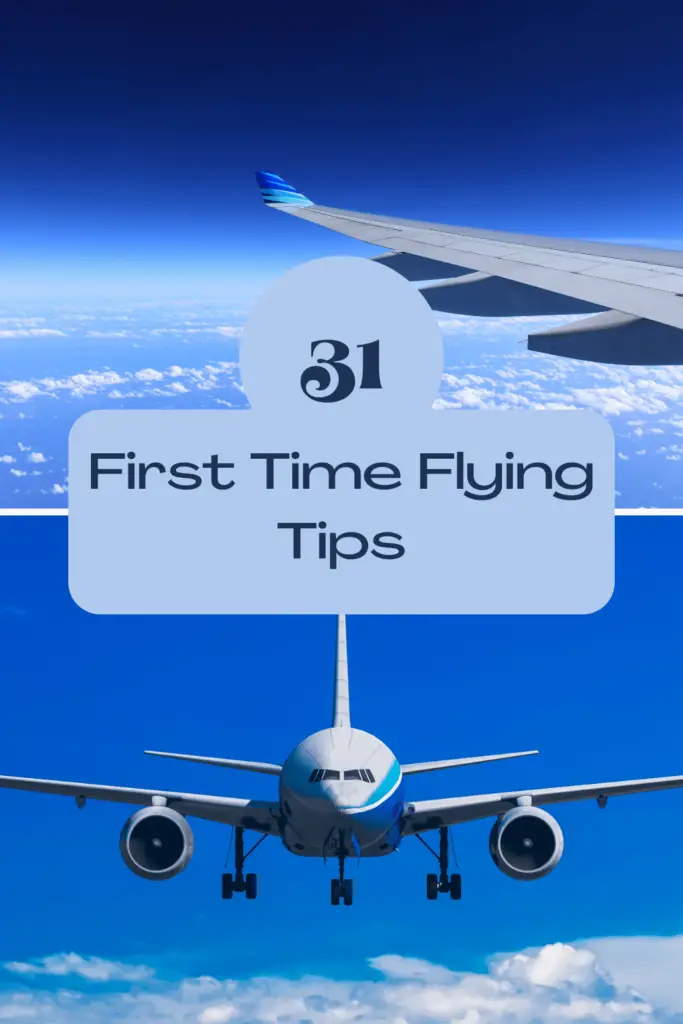
And please do me a little favor and share this article with others, for there’s a good chance that it will help them with their travels !
First Time Flying Tips FAQ’s
What must you do 30 minutes before a flight.
Before a flight, there are important tasks to complete around 30 minutes prior to departure. Check-in, go through security, keep your boarding pass and ID accessible, arrive at the boarding gate, inquire about seat availability, prepare your carry-on items, and stay updated on any announcements.
Arriving early and allowing extra time is crucial for a smooth travel experience.
Do I really need to arrive 2 hours before a flight?
The recommended arrival time before a flight is generally at least 1-2 hours before the scheduled departure time. While it may not always be necessary to arrive a full 2 hours before, it’s still important to allow enough time for check-in, security screening, and potential unforeseen circumstances.
Do I need to print my boarding pass?
Printing your boarding pass is not always necessary. Many airlines now offer electronic boarding passes, which can be accessed and displayed on your smartphone or mobile device. These electronic boarding passes usually include a barcode or QR code that can be scanned at various checkpoints throughout your journey, including security and boarding gates.
Share my adventures Share this content
- Opens in a new window X
- Opens in a new window Facebook
- Opens in a new window Pinterest
Sara & Josh
You might also like.

Southwest Flight Check-In: Online vs. Airport Kiosk
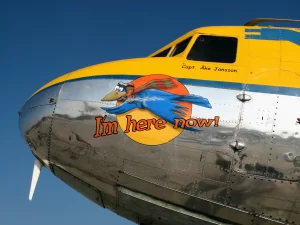
TSA PreCheck vs Global Entry vs CLEAR: All You Need To Know

How To Hold Your Mail When You’re On Vacation
Leave a reply cancel reply.
Save my name, email, and website in this browser for the next time I comment.
- Cognitive Behavioral Therapy for Fear of Flying
Hypnosis for Fear of Flying
Medications for fear of flying.
- Virtual Reality for Fear of Flying
- SOAR Review
What is Turbulence?
- Small Airplane Statistics
How Safe are Airplanes and Air Travel?
- What is Acrophobia?
- What is Agoraphobia?
- What is Claustrophobia?
- What is Mysophobia?
What is Aviophobia?
- Childrens’ Fear of Flying
- TSA Tips for First Time Flyers
- Celebrities Afraid of Flying
- Fear of Flying Apps
- Clear Airport Security Review
- First Time Flying: Tips on Booking, the Airport, and the Flight
Affiliate Disclosure: We may use affiliate links on this page that lead to Amazon or other partners. If you make a purchase after clicking on a link on this page, we may earn a small commission at no extra cost to you.
Part of the fear of flying is actually a fear of the unknown. If you are flying for the first time—whether for business or pleasure—this includes not knowing what to expect at the airport or while you are in the air.
This step-by-guide spells out everything the nervous first-time flyer needs to know, from booking the flight to navigating the airport to getting situated onto the plane.
We've packed in our best travel tips for first-time flyers based on the collective experience of our staff, so climb aboard and let's get you ready for the flight!
These flight tips cover most major airlines like American, United, Delta, Southwest, etc. For budget airlines like Frontier or Allegiant, you'll see some variance in items like luggage fees, in-flight accommodations, etc.
Boarding procedures, safety instructions, and other instructions as they relate to the safety of staff and the passengers remain relatively standard.
Booking the Flight
The first step in the flying process is purchasing tickets. To book the flight, most people purchase their tickets online through airline or travel sites or their mobile apps. The only thing you have to fear in this step is expensive ticket prices. Otherwise, it is a relatively easy process that you can handle yourself.
Directly through the Airline
In terms of convenience, booking directly through an airline's website is the easiest route. If there are any ticket price changes between the time you book and the time your flight departs, you can usually have that difference refunded with a quick call to customer service.
It's also easier to get better seats and address flight delays, changes, or cancellations when booking direct. Otherwise, you might be referred back to your travel agency, which is another cumbersome step to have to take when you're having problems with your flight.
It's a little extra work on the front end, but for first-time flyers, this gives you added flexibility just in case something were to go wrong.
PRO-TIP: Add your airline's phone number to your contacts and jot down important info like flight numbers, confirmation numbers, etc. in the notes app on your phone.
Just in case something does go wrong, having all of this info readily available will help solve problems faster.
Through a Travel Agency
There are some instances where booking through a travel agency is the better option. Specifically, if you are planning an international trip or one that is more complex than a week-long vacation in the United States, a travel agency can be a big help.
OTA's, that's Online Travel Agencies, are sites like Orbitz, Trivago, Kayak, Booking.com, Expedia, and others.
What's the difference between them?
Spoiler alert - not much. In fact, the majority of these sites are all owned by four or so big players.
Why use an online travel agency?
- One-Stop-Shop, flights, hotels, car rentals, and more
- Good first-time user offers
- Helps to save time and money
- Quick and easy comparison of different airfares and schedules
- See reviews and recommendations from people who have taken the same trip before.
For the most part, they wrap up all of your trip into a single package and help manage the booking and getting you to your destination. All you have to do is pay and print out the trip details.
If problems do arise on your trip, a customer service representative is only a phone call away to get you the help you need.
Direct Flights
Whenever possible, get a direct flight. Layovers only add the potential for more problems. You want the journey to be as simple as possible, and when you only have to board and exit a single plane, you lessen the chance for delays, cancellations, and missed connecting flights.
Layovers and Connecting Flights
If you can't find a direct flight, it's not the end of the world. A connecting flight is where you will travel to one airport to join a different flight that will take you to your end destination. Sometimes you may have multiple stops, but for most domestic flights, it's common only to have one.
A layover is a time in between these connecting flights. For example, if you fly from New York to Los Angeles, you may only fly halfway to Chicago. There you will exit the plane and wait in another concourse until your next flight is ready to depart for Los Angeles.
This can be a quick turnaround or several hours long; it all depends on the flight schedule.
If you must choose a layover, pick one that is at least 2 hours between the time the plane is scheduled to land and when the next one is scheduled to depart. Any less time may result in a missed connecting flight.
What often happens is the plane's wheels will touch down at, say, 10:41 AM. However, the plane won't make it to the concourse for 'x' reason (jetway unavailable, lots of traffic, etc.) until 11:30 PM. By the time you're off the plane, it's almost 12:00 PM, and you're rushing to get to your next flight.
When booking your flight, remember:
- Book a direct flight whenever possible, even if it costs a little more.
- Give yourself at least a 2-hour layover between connecting flights.
- Add more time to your layover if you want to eat, freshen up in the bathroom, etc.
- Red-eye flights are often cheaper but at the expense of traveling at night.
RED-EYE FLIGHTS: You might see a "+1" on some flights, or see flights that fly overnight. These are referred to as "red-eye flights." Any flight that travels through the night is a red-eye.
The downside is obvious; however, these flights are typically cheaper if you can deal with not sleeping well.
Types of Tickets
You may see different ticket types available for purchase. The main differences you're likely to see include the ability to make flight adjustments after purchase, refundability, carry on allowance, seat selection, or boarding group.
Be sure to carefully read the fine print of the ticket you are purchasing. Most airlines will be somewhat flexible on some of these policies. For example, if you need to change your flight weeks or months for departure, most customer service agents are happy to make that adjustment.
Always, always, pack the night before! Get your laundry done a day or two before and make sure all of your electronics are fully charged. You will also want to pack some specific documents and ensure you have the right luggage.
Important Documents
Be sure to have a valid form of ID, such as your driver's license and your passport if you are traveling internationally. The TSA has an article outlining other forms of acceptable IDs, if you are not using something typical, like your driver's license, military ID, or passport.
Starting on October 1, 2020, all travelers in the US, over 18 yrs old, will be required to have a REAL ID-Compliant Driver's License or another form of acceptable identification.
More on the REAL ID can be found on the TSA website .
Even if you plan on using a digital boarding pass on your phone, it may be helpful to print it from your home computer or at the airline's kiosk.
An example of a boarding pass for an American Airlines flight printed at the airport.
Carry On Luggage
Carry on luggage refers to the larger suitcase or bag that you can bring on the plane with you and store in the overhead compartment.
There are restrictions to the size of the carry on you can bring; however, most bags from known brands like Chester, TravelPro, Delsey, and others are compliant for most domestic flights.
International flights have slightly stricter standards, and are the requirements are only slightly smaller than domestic flights. Be sure to check the website of your airline for specific requirements.
If your bag is larger than specified measurements, you will be required to 'check' your luggage, which incurs around a $25-$30 fee.
BE AWARE: Don't go by your luggage manufacturer's advertised dimensions. Some manufacturers will not include the wheels or handles in their product listings. Airlines do take these into account.
If your luggage is questionable, you may be required to place it in this module to check its measurements.
Checked Luggage
If you are traveling for longer than 4-5 days, you'll likely pack a larger suitcase, which you will be required to check-in prior to going through security. These bags have weight limit restrictions, but as long as you're only packing usual items like clothes, shoes, etc. you won't even come near that limit.
There is a $25 to $30 fee for each way when checking your luggage. After checking your luggage, you will not have any access to your bag until you pick it up from the baggage claim at your destination.
TSA has specific restrictions on what you can and can't pack in both your checked and carry-on luggage. Each airline may have additional restrictions on what you can and can't pack.
Personal Items
In addition to your carry-on, you are also allowed to bring on a 'personal item' onto the plane. This has to fit under the seat in front of you and is commonly a purse, small/medium backpack, or diaper bag of sorts.
These bags are subject to the same restrictions as your carry on and also have varying size requirements. It is best to pack items that will be accessed during the flight like snacks, headphones, laptops, power banks, etc.
To summarize, remember:
- Make sure your ID is compliant and up to date
- Your carry on and personal item meet your airline's requirements
- If you are checking luggage, it also meets your airline's checked luggage regulations
Checking In
Before the flight, you are also required to "check-in," which just acknowledges you are still planning to make the trip. If you booked online, you could follow the instructions you get from the airline — you'll get an email or text prompting you to sign in.
This is usually about 24 hours before your flight. If you didn't do so during the booking process, you can usually choose a seat during the check-in process, or pay for your checked bags (if applicable).
Almost all major airlines allow you to perform all of these actions from the app.
As part of this process, you receive a boarding pass—a document that proves that you have purchased a ticket and contains information about you and your trip.
After checking in, your boarding pass is available through the app and can be added to your digital wallet.
You can also print your boarding pass from a desktop computer or at the kiosk at the airport. It's highly recommended to do this just in case your phone dies or has technical issues at the gate.
Arriving at the Airport
How early should i arrive for my flight.
Most airlines and travel experts recommend arriving two ahead of the scheduled departure time for any domestic flight. For International flights, plan for around 3-4 hours ahead of time.
If you are traveling during the peak holiday season, aka Thanksgiving and Christmas, it's advised to add an extra hour or two onto those times because of the influx of families, children, etc.
Remember, you need to account for factors you can't control like traffic, security checkpoint wait times, etc.
PRO-TIP: Signing up for TSA Pre-check, Global Entry (for international travelers), or CLEAR, can save you TONS of time and hassle going through security.
It's basically like getting to go through the VIP line, which is always shorter.
If you are not being dropped off, you will need to pay for parking. You should check the rates and available lots at the airport you'll be departing from. Larger airports usually have 2, sometimes 3, different lots for travelers.
One lot is designated as "daily," for travelers who will not be leaving their car overnight. This gives them a better rate than the "long-term lot," which is specifically for flyers who will be gone for more than a day.
If you are gone for multiple days, park in the long-term lot, or else you'll be paying a lot more money to stay in the daily lot.
When you pull into the lot, you'll likely pass through a gate where you'll receive a ticket about the size of a business card. Put this in your glove box as you'll need it to leave the lot. After coming back from your trip, you'll put the card into the machine on the way out and pay the parking fees.
Lastly, for some major international airports, you may have to ride a shuttle from the parking lot or garage to the gates. It's recommended to tip these shuttle drivers a few dollars as they will typically help you with your luggage.
PRO-TIP: If using an iPhone, drop a pin on the location for where you've parked your car and save it. Otherwise, make a note on your phone on the section, lot number, etc. of where your car is parked. This will make it much easier to find once you get back.
It's recommended to always print out a paper copy of your boarding pass and tickets, just in case the digital copies on your phone become inaccessible.
You can print these out on your computer at home, or you can retrieve them from the kiosk at the airport. If the kiosks are not available or you are having trouble with them, you can talk with one of the airline's representatives to help you.
You will receive all of the tickets and boarding passes for the first part of your flight, so be sure to place them somewhere where they can't be lost. The front pocket of a backpack, wallet, or purse is a good idea. You will want to be able to access them quickly, but keep them secure.
Walk up to a kiosk or customer service rep to check into your flight.
Checking Luggage
If you plan on checking your luggage in, you can do that from the kiosk or by speaking with a representative.
If done from the kiosk, it will print out a long sticker that you will wrap around the smaller, non-extending handle on your suitcase. You will remove the backing to expose the adhesive, wrap it around, and then connect the two adhesive sides together to form a loop.
You'll then need to wait in line until you reach the check-in desk to hand off your bag. Sometimes the representative will be printing out the sticker and putting it on your bag.
After you have landed at your destination, remove the sticker and throw it away before heading home. Having multiple labels on your luggage only increases its chances of getting lost.
Getting Through Security
Depending on the airport, there may be a central security checkpoint for all gates—like in the Atlanta airport—or there may be separate checkpoints for each set of gates, like in the Tampa airport.
Airport personnel can help you find the checkpoint, and there is generally ample signage to point you in the right direction. Regardless, all passengers must go through security, including children.
When you reach the security area, you'll generally wait in line anywhere from no time to an hour or more. Once you get to an agent, they will check your boarding pass and ID to ensure they match.
You will need a government-issued ID such as a driver's license, and as already mentioned above, starting October 1, 2020, it will need to be REAL-ID compliant. If your ID is compliant, you will not be allowed to pass security or board the plane.
If you become a frequent flyer, we recommend that you check out our CLEAR airport security review as a way to gain access and move through life more quickly and easily.
Be Aware: While waiting in line, you may be subject to a random screening. For example, while the author of this article was in Washington DC, his hands were dusted for any remnants of bomb-making materials. Unless you have recently been to a shooting range, near any gun powder, or fireworks, you will not have anything to worry about.
The Screening Process
Next, you will place your personal belongings and any carry-on bag (the one(s) you will keep with you on the plane) in bins that roll along a conveyor belt and under the x-ray machine.
This is the what security screening looks like after you have walked through and gathered your items.
BE AWARE: While waiting in line, you may be subject to a random screening. For example, while the author of this article was in Washington DC, his hands were dusted for any remnants of bomb-making materials. Unless you have recently been to a shooting range, near any gun powder, or fireworks, you will not have anything to worry about.
BE AWARE: The body scanner is a very sensitive machine. Something so much as your boarding pass or a stick of gum can show up on the screen.
Keep in mind this machine will not show any images of what is underneath your clothing - only if a foreign object appears on the outline of your body.
Any electronic larger than a cell phone needs to be removed from your bag(s) and placed in one of the containers. This includes laptops, tablets, and cameras. Be sure to have these items easily accessible and not buried deep within your bags.
After that, you collect your belongings from the bin, put your shoes back on, and head to your gate area.
A Better Solution: CLEAR
If you would like to avoid most of the security screening, consider signing up for CLEAR and check out the review here. With CLEAR, you will only need to walk through a metal detector; all your belongings can stay in their respective bags — no removal of shoes, shorter lines, and less hassle.
Prohibited Items & the 3-1-1 Rule
Airports have strict requirements regarding what you are allowed to have on your person and in your carry-on bag. To find out what personal items you can bring with you on the flight, consult the resources below.
For a guide on permitted and prohibited items, visit this Transportation Security Administration (TSA) website page .
For information about the "3-1-1″ rule pertaining to liquids, visit this TSA webpage .
Finding the Concourse Gate
The "gate" is the area where you wait until time to board a plane. Each concourse in an airport houses several gates. A concourse resembles the wing of the mall in that it usually contains restaurants and gift shops. Any food or merchandise you buy in the concourse area is fine to take on the plane with you.
A terminal is the large main building of a section of the airport. The terminal houses several concourses. Imagine it like a large tree. A terminal is the trunk of the tree with large branches coming off the trunk, these are your terminals. Finally, there are small branches off of those larger ones called gates, where the planes are docked for the next flight.
It goes Terminal > Concourse > Gate, so in the picture the gate is L8. This is gate 8, in concourse L. According to this map of Chicago O'Hare Airport, concourse L is in Terminal 3. Large international airports have multiple terminals, but generally will not reuse concourse letters.
When at the gate, you are free to sit wherever you please. When it is time to board, passengers line up and present their boarding documents to a gate agent.
If you are using a digital boarding pass, it is scanned straight from your phone. Just ensure your brightness is high enough and have your paper one ready in case your phone has trouble scanning.
You will then walk through a "jetway," or "jet bridge" which connects the gate to the outside of the plane.
A jet bridge waiting for an airplane to dock on a sunny day.
An airplane that has been docked to the jetway on a rainy day.
Valet Checking your Carry On
For smaller aircraft, typically ones flying in or out of small regional airports, you may be required to 'valet check' your luggage. Don't worry, this doesn't cost you any money, and is a common practice.
Usually, an attendant will walk around the gate area, passing out small red or yellow tags that will attach to the top of your luggage. This will vary from airline to airline, but generally, if it has wheels, you will valet it.
After scanning your boarding pass, you'll leave your carry-on at the top of the jetway where it will be stored in the belly of the aircraft for that flight only. You will still take your personal item with you to your seat.
After the flight lands, your bag will be waiting for you at the top of the jetway. It may take a few minutes for the crew to unload all the bags and make them accessible.
Boarding the Plane
Passengers board the plane according to the group number on their ticket. Different airlines have different ways of doing this, but for most first time flyers, you will be the last to the second-to-last group.
Once you make your way onto the plane, read the seating labels found around eye level just below where the handle is for the overhead storage compartments. You'll see row numbers, often with letters indicating the seat number.
If you are having trouble getting your bag into the storage area or can't find your seat, flight attendants will be standing by to assist.
There will also be an icon indicating the window or aisle for you to determine which seat is yours.
Planes have markers at about eye level so passengers know which letter on their boarding pass refers to which seat.
After locating your seat, place your luggage in the overhead compartment, ideally wheels first. You can take your backpack, purse, or whatever your personal item is with you to your seat. It will need to be placed under the seat in front of you for takeoff and landing.
For those sitting in the front-most seat of economy you will not have a seat in front of you. Instead, look for the overhead compartments that are reserved for your personal items.
Pre-Flight Procedures
Now for the fun part, the flying itself. For some people, this is where the fear and anxiety begins setting in. But if you know what to expect when you fly, you will hopefully be able to better manage the fear before you are in the air.
Passengers board the plane, find their seats, and store any carry on baggage in the storage bins above the seats.
The crew relays safety instructions (or they are presented in a video on screens behind each seat), and the Captain gives a brief message to passengers along the lines of the weather in your destination city, any expected weather or turbulence issues expected and how long the flight is expected to take.
A safety card is in the seat in front of you to let you know what you need to do in the rare event of an emergency.
People that are already experiencing fear and anxiety when they fly tend to fear the worst during safety instructions. This is something you can learn to overcome by educating yourself on flight safety statistics and recognizing that the fear is irrational.
Accidents are very rare, so safety measures are seldom needed; the crew addresses them in the unlikely event they are necessary. If an emergency does occur, the crew is well-trained and equipped to assist passengers.
The Takeoff
The Captain then "drives" the aircraft on the ground to get in position for takeoff. Before takeoff, passengers must fasten their seat belts and remain seated until instructed otherwise.
When the pilot gets the clearance to take off, the plane will begin accelerating along the runway before becoming airborne. This is the part some passengers dislike because the plane is leaving the ground, and the body is angled upward.
Others have a feeling of exhilaration as the plane accelerates into the air. The acceleration and takeoff are likely to be a little bumpy as you move across the runway.
During the Flight
When the plane reaches a certain altitude, passengers are free to move about in the cabin and use the restrooms. Many planes have a video screen on the back of each seat with on-demand music, TV programs, and movies for entertainment. Wi-Fi is usually available as well, so you can take care of personal or business-related tasks.
The crew will also serve snacks and drinks. Depending on your ticket, food and drinks may be complimentary.
If you're in the coach section (typically the cheapest) section, you'll generally get a snack like pretzels or cookies and sodas or water. You can still buy additional food items or alcoholic beverages if you prefer.
If there is turbulence and moving around is not safe while in the air, the crew will instruct passengers to remain seated until notified otherwise. Turbulence is nothing to fear—it is caused by fluctuating air pressures and is a normal experience of flying.
The Landing
Likewise, when you are close to landing, the crew will require that passengers be seated and buckled in.
Some people fear this part of the journey because the plane will often slightly roll (turn) and change altitudes in preparation to descend and land on the airport runway assigned to the flight.
When the plane lands, the Captain drives to the gate, where passengers use the jetway to exit the aircraft and enter the destination airport.
Post Flight Procedures
Exiting the plane.
Similar to how you boarded. Exiting the plane is essentially the same but in reverse.
After the plane has exited the runway, there may be a wait until a gate is available for the plane to dock. This is dependent on whether or not flights are running behind and the availability of a jetway.
You should remain buckled until the crew gives you the okay to unbuckle. If sitting near the rear of the plane, you will be better off staying in your seat as it will take a while for everyone ahead of you to get off the plane.
Be courteous to other passengers and help when needed.
Baggage Claim
If you checked any luggage, you would then head to the baggage claim area. Airport signage will direct you to baggage claim, or you can get assistance from airport staff. Shortly after landing, luggage is placed on a carousel for passengers to pick up.
Final Thoughts
Once you have experienced the air travel process for the first time, you will at least have addressed the fear of the unknown, and hopefully will enjoy any future flights. Good luck, and if you are interested in reading some additional tips for first-time flyers, click here .
First Time Flying | Resources
- Airport Terminals
- Fear of Flying Statistics
Written by Fly Fright Staff , Staff Writer
Fact Checked
Our team of writers and editors rigorously evaluate each article to ensure the information is accurate and exclusively cites reputable sources.
You may be also interested in...
Alaska Airlines Flight 1282 – What Happened?
9 common commercial flight myths – debunked, 7 common carry-on mistakes, 6 reasons your flight keeps getting delayed, us federal air marshals – are they on every flight, 5 common reasons people believe car travel is safer than air travel, how many flight attendants are on a plane, what are the safest airlines, 4 cognitive behavioral therapy methods to overcome fear of flying, anxiety attacks on a plane – 4 strategies to prevent and resolve, using virtual reality to conquer fear of flying.
What to Expect Your First Time Flying
It’s normal to feel anxious the first time you fly, but to help ease the nerves it’s good to know what you can expect at the airport, on the plane, and after getting off the plane.
In this article, we cover everything you can expect your first time flying, airport procedures to be aware of, and statistics that show just how safe air travel is to put your mind at ease.
The following step-by-step guide will be particularly useful.
Table of Contents
- 1.1 Before the Flight
- 1.2 At Check-in
- 1.3 At Airport Security
- 1.4 After Airport Security
- 1.5 On the Plane
- 1.6 After the Flight
- 2 Make Sure to Bring the Correct ID
- 3 Pay Attention to Carry on and Checked Luggage Restrictions
- 4 Make Sure You Bring These Essential Items
- 5 Don’t Worry: Flying is Exceptionally Safe
- 6 It’s Normal to Feel Some Nerves When Flying For the First Time
- 7 Turbulence Can Be Scary, But Isn’t Actually Dangerous
- 8 You May Experience Airplane Ear
Before the Flight
- Assuming you have already booked your ticket, double-check the flight time and luggage restrictions, including the maximum weight and size of bags allowed.
- If it makes you more comfortable, consider paying extra to sit by the window or aisle.
- Make sure you don’t pack any liquids, gels, or aerosols larger than 3.4oz/100ml in your carry on because they will be confiscated at airport security if you do.
- Place your liquids, gels, and aerosols that are within the regulations inside a clear, resealable 1-quart sized bag.
- Place a TSA-approved lock on your checked bag because if they want to take a look inside your bag, they’re getting inside through any means necessary.
- Make sure you travel with one of the acceptable forms of ID the TSA requires for flying. Note that a passport is required for all international flights , though not necessary for domestic flights.
- Dress comfortably, with many passengers preferring loose-fitting clothing.
- Plan to get to the airport 2 hours before your domestic flight and 3 hours if flying internationally .
- You may want to get to the airport even earlier, as it will be your first time flying.
- It’s a good idea to check how long it will take to get to the airport through Google Maps or a similar service.
At Check-in
- When you get to the airport, what you need to do next will either depend on if you have checked in online and/or you need to check in a bag.
- If you have checked in online and only have a carry-on, you can immediately go to airport security.
- If you haven’t checked in online and/or need to check in a bag, you need to go to the airline’s check-in counter at the airport.
- You will know which counter to go to by the screen that will show the airline’s logo behind the counters.
- If in doubt, you can always ask one of the passengers in the queue if this is the check-in for your airline.
- At the check-in counter, you will be asked for your ID, which you will hand over to the agent, who will then enter your details and print your boarding pass.
- You will also be asked if you need to check in bag.
- Once you have your boarding pass, it’s time to go through airport security.
At Airport Security
- Going through airport security can be nerve wracking, as there are usually queues, so you might be nervous about holding people up, but there isn’t much to worry about.
- Place your carry on bag along with the clear, resealable bag that contains your toiletries in a security bin.
- Empty your pockets, take off your jacket, hat as well as any other items that might set off the airport body scanner and place them in the security bin. You will probably need to take off your shoes, too.
- If you’re traveling with a laptop or tablet, these will need to be placed in a separate screening bin.
- If in doubt, look at what the people ahead of you are doing.
- Hopefully, your bag passed through the scanner without any problems, but in some instances, a TSA agent may want to take a closer look at your bag.
- Once your bag has been cleared, it’s time to place the items you took out of your bag and pockets and place them back inside your bag and pockets.
After Airport Security
- After you have passed airport security, take a look at one of the many screens that will inform you of the gate you need to be for your flight, as well as the time the plane will board. Your boarding pass will also display gate information.
- Note that the boarding time might not immediately be available.
- You’ll probably have time to kill, so do some shopping, or grab a drink or bite to eat while you wait to board.
- It can also be a good idea to go to the bathroom before your flight, so you won’t have to use those tiny airplane bathrooms.
- Go to the gate, where you will find other passengers waiting to board the aircraft.
- Depending on the airline, you may be asked to board depending on whether you are sitting at the front, middle or back of the plane.
- Once your seating section is called, it’s time to board the plane, at which point a flight attendant at the desk will want to scan your boarding pass and may ask for your ID.
On the Plane
- Once you have stepped onto the plane, a friendly flight attendant will inform you where your seat is, according to what is printed on your boarding pass. If you have a middle seat, follow our guide to How to Survive the Middle Seat on a Plane.
- Find your seat and place your carry on in one of the overhead compartments or under the seat in front of you if it fits.
- Take your seat, put on your seatbelt, put your phone in airplane mode, and get ready for takeoff. If you’re overweight, you may have to ask for a seatbelt extender or bring your own, the best of which is the Mirone Adjustable Airplane Seat Belt Extender .
- Remember to stay hydrated due to the lower air pressure and humidity level on a plane. The Aerospace Medical Association (AsMA) recommends drinking about 0.25 liters (or 8 ounces) of water per hour while on an airplane.
- Your ears might feel a little weird due to the change in air pressure when on a plane, but this is nothing to worry about and will pass.
- Your feet may swell if you have a long flight and you stayed seated for the duration of your flight.
After the Flight
- Once you have landed, there will be a short delay before you are allowed to get off the plane.
- Once you get off the plane, you may need to go to the baggage carousel if you checked in a bag and/or customs if you are flying internationally.
Make Sure to Bring the Correct ID
If you’re flying for the first time, it can be confusing to know what ID is necessary.
If you’re flying domestically, you need a form of ID that is recognized by the TSA , with most people using their driver’s license.
If you’re flying internationally, a passport is the only acceptable form of ID.
Related: What Do You Need to Fly Domestic ?
Pay Attention to Carry on and Checked Luggage Restrictions
It’s important to be aware of the carry on and checked luggage size and weight restrictions, so you won’t be in for any costly surprises at the airport.
While it can differ by airline:
- Carry on items must generally be no larger than 22 inches long, 14 inches wide and 8 inches high. A specific weight limit is typically not stated.
- If a bag is larger than 22 inches long, 14 inches wide and 8 inches high, it will be considered a checked bag. Checked bags have a maximum weight restriction of 50 lbs (23 kg).
- Personal items have a size restriction of 17 inches long, 10 inches wide and 9 inches high, and must be able to fit underneath the seat in front of you.
As mentioned earlier, any liquids, gels, and aerosols in containers larger than 3.4oz/100ml should only be packed in your checked bag.
Make Sure You Bring These Essential Items
Essential items may include prescription medicine, contacts, contact lens solution , glasses, cash and credit cards, your phone etc.
You will want to make sure that these items are either kept on you or in your carry on in the unlikely event that your bag gets lost while in transit.
Don’t Worry: Flying is Exceptionally Safe
Knowing just how remarkably safe commercial air travel is can help put your mind at ease.
According to Arnold Barnett , who has calculated the chances of a plane crashing, and is an expert in the field of aviation safety and risk and Professor of Statistics at MIT:
“If you take one flight a day, you would on average need to fly every day for 55,000 years before being involved in a fatal crash.”
Additionally, it has currently never been safer to fly on commercial airlines when we consider that airline passenger fatalities have fallen significantly compared to the previous decade.
In other words, the chances of a plane crashing is the lowest it has ever been in the history of commercial aviation.
Traveling by car is in order of magnitudes more dangerous than flying, but you probably don’t worry every time you get into a car.
So there certainly isn’t anything to worry about when flying, even if it is your first time flying.
It’s Normal to Feel Some Nerves When Flying For the First Time
It’s natural to feel nervous when flying for the first time, so there are a few things we recommend to ease the nerves.
- Arrive at the airport early
- Before your flight, eat a light meal, stay hydrated and avoid caffeine and alcohol
- If possible, travel with a friend or family member
- Familiarize yourself with the noises of an airplane, so you know what to expect
- Inform a flight attendant that it is your first time flying
- Pay attention to the safety instructions before takeoff
- Bring a book, listen to music, watch a movie, or connect to the plane’s Wi-Fi service if available to keep your mind occupied
- Picture your destination and how worth it will all be
- Be proud of yourself that you are taking on your fears instead of letting them dictate your life
- Sit near by an exit row if it helps calm your nerves, though exit row seats may not recline , and not everyone can sit in the exit row.
- Remember just how incredibly safe air travel is
- It may help to look at how calm the other passengers are to remind you that there is a good reason why they are so calm when flying. Flying is completely safe and there really isn’t anything to worry about!
- Remember to take some deep breaths
Turbulence Can Be Scary, But Isn’t Actually Dangerous
Anyone who has flown enough times has likely experienced turbulence at some point.
While turbulence can feel scary in the moment, you should know that turbulence isn’t dangerous and is perfectly safe and completely normal.
Airplanes are designed to withstand even the most severe of turbulence (1.5x force on their airframes, in fact), as well as changes in atmospheric conditions.
You May Experience Airplane Ear
When flying, it’s quite likely that you will experience airplane air, which is caused by the changes in air pressure inside the cabin, resulting in discomfort inside your ear.
There are several ways to deal with this, including yawning, chewing hard candy or gum, and wearing ear plugs.
We go into more detail in our 8 Proven Ways to Pop Your Ears After a Flight article.
Ella Dunham
Ella Dunham, a Freelance Travel Journalist and Marketing Manager, boasts an impressive career spanning eight years in the travel and tourism sectors.
Honored as one of "30 Under 30" by TTG Media (the world’s very first weekly travel trade newspaper), a "Tour Operator Travel Guru" and "Legend Award" winner, Ella is also a Fellow of the Institute of Travel, a Member of the Association of Women Travel Executives, has completed over 250 travel modules, and hosts travel-focused segments on national radio shows where she provides insights on travel regulations and destinations.
Ella has visited over 40 countries (with 10 more planned this year).
Related Posts:

First-time Flying: 30 Must-Know Tips for First-time Flyers
Traveling for the first time? These tips for first-time flyers will guide you, from airport tips, how to deal with flying anxiety to all the necessary info .
We have all been first-time flyers at least once in our lives. The first time on a plane can be exciting but at times overwhelming as you don’t know what to expect or how to feel about the entire experience.
Normally as a first-time traveler, you have so many questions about traveling ranging from what to do at the airport , how to check-in at the airport, when to arrive at the airport, what the cabin luggage size should be, the carry on essentials you should pack or even how to book your hotel or air ticket in the first place plus all the necessary airport tips .
All these questions can be daunting if you don’t have where to get the answers from.
With this post, you’ll get all the necessary tips for first-time flyers from carry on luggage rules to how best you can handle flying anxiety.
So without any further ado, let’s look at the best things you should know if it’s your first time flying on a plane.
Related post: Important travel tips for first time travelers
First Time Flying Tips

Disclaimer* This post contains affiliate links and I might earn from qualifying sales.
Tips for first-time flyers before your travel date
You’re about to fly to a new country– yay congratulations!! But before you experience your first time flying on a plane, there are some important things you should do before traveling .
These will determine whether you’ll get to the plane or your dreams will be crushed.
Obtain a visa
The type of visa to be obtained will depend on the reason for traveling and where you’re traveling to.
The types of visas can range from a tourist visa, business, student, work, to many others. To see the general visa requirements, check with you’re nearest consular of the country you’re traveling to.
But some of the common visa requirements for most embassies include;
- Proof of a booked air ticket; round trip . If you haven’t booked your flight ticket yet, compare the prices of different flights with Skyscanner to choose the best deal.
- Proof of hotel booking . The country you’re traveling to wants to be sure that you already have where to stay when you reach their country. Not sure where to stay while in an absolutely new country, book your ideal hotel with booking.com or Hotelscombined to enjoy endless deals on discounted hotel rooms.
- A copy of your bank statement . Are you able to take care of yourself while in a foreign country? The embassy will always require a bank statement to gauge whether you can actually survive in their country. The embassy usually states the minimum amount that should be on your bank account for a certain period of time to be eligible to enter their country. (Pease note that this depends on the passport you’re holding and where you’re traveling to).
- Yellow fever Card . Even though a yellow fever card is mandatory in some countries, some of them do not require it. So, again, check with the embassy requirements to see if it’s needed.
Make a research about the country you’re traveling to

The best way to know about the country you’re traveling to is by making extensive research. You don’t want to be shocked on the first day you land in a new country.
It is wise to at least know some of the basics of the country from their culture, dressing code, food to the cost of living.
If you’re a budget traveler, you may want to read this post that shows how to travel on a budget .
Come up with an itinerary
I know some travelers are all about being spontaneous but having an itinerary can save you a lot of time and money by making you more organized.
Design an itinerary depending on your interests. This can be from visiting Unesco World Heritage Sites , national parks to big European cities.
Not sure which activities to go for in a certain country, click on this link to select activities you want to do based on the area or country you’re traveling to.
Related posts: Step by step guide to planning a trip Must have free travel apps that work offline
First time flying tips on your flight date

As a first time traveler, you might be asking yourself; how do I prepare for my first flight?
Some of the things to know when flying for the first time on your flight date are endless but we are going to look at the most important ones like when to arrive at the airport, airport check-in process, what to do when you get to the airport and all the general airport tips and hacks.
Packing tips
Don’t carry luggage that weighs more than what the airline allows unless you’re willing to pay for the extra kgs.
The accepted kgs of your luggage are always indicated on your ticket, so be sure to check it to avoid extra fees. You can buy this travel luggage scale to help you weigh your luggage before you go to the airport.
Also, find out what you can bring on a plane and all the hand luggage restrictions.
Every airline has different rules, so check with your airline to see what you can take in your hand luggage and the carry on luggage weight acceptable.
In that same manner, find out what you can take into a certain country and what you can’t. There are a number of packing lists online to help you know what to pack and below are some that you can check out.
- Packing list for Africa
- Packing list for Egypt + what to wear in Egypt
- Things to pack in your carry on
- Packing list for Paris in winter
- Ski trip packing list
- Europe in winter packing list
- Hostel packing list
- Beach packing list
- Packing list for a weekend getaway
What to wear on a plane
Wear comfortable clothes while flying. By comfortable, I don’t mean high heels or jungle boots but rather sweat pants, a comfortable pair of jeans, a t-shirt, or a really comfortable top are ideal.
Some of the comfortable clothes you can wear on a plane include;
- These kinds of sweatpants
- Leggings – every girl traveler needs a pair of these cute and comfortable leggings
- Warm and compression socks – ones you can keep on during the flight if you choose to take off your shoes.
- A warm fleece and a large scarf – it gets cold in the plane.
- A pair of comfortable shoes – this pair of sneakers always does it for me.
Wear easy-to-remove shoes. As you go through the security check at the airport, you’re going to have to take off your shoes a couple of times.
So instead of wearing gladiator shoes will endless shoelaces to untie, opting for flip flops or sneakers is a better choice.
Pro tip: Make sure you don’t have smelly feet or shoes as you don’t want to be embarrassed at the airport when you take off your shoes. But if you do, worry not, this fungus treatment will heal the smelly feet before your big trip.
Forego the belt if you can or wear clothes that don’t require one. While going through security, you’re required to remove your belt every now and then. So, if you don’t want to be inconvenienced, just do away with it.
While still at the point of packing, there are some travel essentials you should not leave behind as you travel. Below are some of them.
Travel Essentials you should never leave home. – A universal travel adapter : Since different countries use different adapters, I’d advise you to buy one universal travel adapter to cater for all regions. You can buy one from here if you don’t have it yet. – A power Bank : One of the things you should never leave behind while traveling is the Powerbank! Phones have now become a great deal of our lives that we need to use them for so many important things. So take a power bank with you so that you don’t run out of battery. This power bank is small, light, and has the capability to charge your phone and other devices multiple times. – Microfibre travel towel – I always opt for this microfibre travel towel because it is super lightweight, easy to wash, and dries easily. – First Aid kit : Regardless of where you’re traveling to, you’ll need to pack a First Aid kit for emergencies that might arise while traveling. Remember it’s always better to be safe than sorry. Just make sure that the one you pack has all the essentials and that it is small and light enough to fit in any kind of suitcase/ backpack. This first aid kit actually fits all the qualities mentioned above plus it is really cheap for what it offers. – Collapsible water bottle : I always prefer carrying a water bottle while traveling so that I can just refill it when I run out of water. It also helps be a responsible traveler since you won’t have to use tones of disposable plastic bottles which are not great for our environment. Any water bottle can work but I prefer this collapsible one as it doesn’t take a lot of space in my bag.
First time flyer Airport tips

- Reach at the airport 2 hours before your flight time if it’s an international flight and 1 hour before if it’s a domestic one. You’ve probably heard this countless times but it’s not just the excitement of a first flyer that should make you be at the airport early but also the fear of missing your flight.
- Check your ticket to confirm the terminal where your flight is to be. For big airports, make sure that your taxi driver drops you off at the exact terminal, or else you’re bound to waste a lot of time looking for your terminal or even “get lost” and eventually lose your flight.
- Be sure to have your passport, ticket, and all the necessary documents at all times. You can buy this this travel neck pouch to help you keep your travel documents organised.
- Use the screens in the airport to locate your check-in point so that you don’t end up at the wrong counter when the check-in time reaches.
- Ask for help from the airport officials. If anything goes wrong or you’re not sure of where to go, don’t panic; politely ask the airport staff for help and they will be at your service.
- Reach the check-in point on time.
- Request for a window seat at check-in. (that is if you want to enjoy the outside views from the plane). While at check-in, you’re given an option to choose the seat you want (if the attendant is generous enough to ask).
- When you’re given your boarding pass, memorize the gate number you’ll use to access the plane.
- Head to your departure gate and keep an ear out for any announcements related to your flight.
- Be sure that the boarding pass is with you at all times as it’s what you’ll use to board the plane. You can check out more airport tips from here .
Related post: How to pack light when traveling
First time flight: Tips for when you board the airplane

- Only sit on the seat number allocated to you on your boarding pass. Seat numbers look like 35A, 1B, & 27C and they are always located on the overhead bin above the plane seats.
- Place your hand luggage in the overhead bin, if it’s a small handbag or purse, place it under the seat in front of you. Now you can sit and get comfortable.
- Fasten your seat belt and wait for further instructions from the flight attendants.
- You will be given instructions on what to do in case of an emergency but don’t panic, that is the routine for all flights, not that something bad is anticipated to happen.
- If you are a nervous flyer, I recommend you don’t look outside the window until you get comfortable otherwise you might get more nervous. Regardless of how fun flying on a plane is, I’ve found it a bit scary a couple of times to look outside the window.
- Flying can get boring, more so if the flight is for long hours, so don’t just sit there: you can read a book, watch a movie if the plane you’re in has that provision, write if you’re a writer or a blogger or just sleep to kill the boredom.
- Wake up to watch the sunrise. If you traveled in the wee hours of the night, wake up to see the sunrise. The sunrise on a plane is one of the best sunrises you’ll ever see, so if you’re up for it- don’t miss out on it.
- Don’t be scared of Airplane Turbulence -“bumping of the airplane during the flight.” Chances are high that you’ll experience airplane turbulence but don’t freak out as this is absolutely normal especially when the weather is not so good. I have to be honest, I freaked out on my first flight because of this. However scary it might seem, you’re actually not in danger- you’re plane is not going down. Just tighten your seat belt if you had removed it before.
Even after following all those guidelines above, there are other unwritten airplane etiquettes that you should be aware of as a first-time flyer.

How do you calm your nerves when flying?
- Try to fall asleep so that you don’t hear the bumping of the plane.
- Watch an interesting movie that takes away your concentration from the turbulence.
- Don’t be uncomfortable in silence; the flight attendants are there to serve you, so if you have anything you want to know, just ask and help will be on its way.
- Chew gum or sweets. First-time flights can be exciting but complicated too. My first-time flight experience was rather painful as I had constant ear pain almost half the entire flight. What was the cause? The difference between the air pressure inside the inner ear and the pressure outside. Normally, the pressure in the inside inner ear is equal to the outside pressure, but due to the rapid change of altitude while flying, there is an imbalance that causes ear pain. How do you make sure it doesn’t happen to you? Chew gum. Chewing gum helps equalize the air pressure in the inside inner ear and that of the outside pressure.
Lastly, have fun. Forget the anxiety and pain and enjoy the flight. You’re never gonna have another first-time flight experience, so forego all the distractions and enjoy all that comes with flying.
Related posts: Things not to do when you travel How to stay safe while traveling
First-time flyer: Tips for when you leave the plane.

- The first thing to do when you board off the plane is to locate where your baggage is being dropped. Chances are high that you don’t know where, so use the direction arrows and screens in the airport to locate the cargo drop-off area for your plane. Again if you can’t locate it, ask for help from the airport staff.
- After getting your luggage, locate the customs area to get the necessary stamps to let you enter and stay in their country.
- Get an airport cab if you didn’t arrange for airport pick up and begin your adventures.
- Have fun, loosen up, be smart, stay safe, enjoy your trip to a new country, and don’t forget to take lots of pictures.
Check out this post to discover more travel tips and hacks that will help you as a first-time traveler.
Are you planning to take your first trip overseas or it’s your first time flying, I hope these tips were helpful.
Did you have a fun or weird experience during your first time on a plane? I would love to read your experiences and don’t forget to share with others that may need these tips.
More travel tips to help you plan your trip
- Camping tips for beginners
- Hiking tips for beginners
- Backpacking tips for beginners
- Backpacking hacks you need to know

Similar Posts

12 Best Cameras for Travelers and Travel Bloggers
Looking to up your travel photography game? Here are the best cameras for travelers plus what to consider before buying one. For photography lovers, an opportunity to travel means an opportunity to capture the most amazing shots. Whether it is capturing African Elephants in Africa or the Bujhi Khalifa building in Dubai, a good camera…

Amazon Prime Day deals of 2021 (Get amazing Discounts on Select Travel Items on Amazon)
Want to buy travel products for cheaps? Check out these Amazon prime day deals that will see you enjoy get products at discounted prices. Amazon Prime Day is an annual shopping event from Amazon but only applicable to Prime members. But if you’re not a prime member, it doesn’t mean that you can’t take advantage…

12 Easiest ways to make friends while traveling solo
Traveling solo can be an extraordinary, exciting and liberating experience. Setting your own pace and discovering new cities without having to compromise on your enjoyment makes for some fantastic travel adventures. However, when traveling solo, it’s not unusual to get lonely from time to time and wish that you could share the experience with someone…

15 Cute Summer Travel Dresses That Will Make You Look Like a Fashionista
Planning to on a summer trip but not sure what to wear? Here are the best summer travel dresses that will make you look like a fashion guru Summer is upon us and I couldn’t be happier! After a long gloomy winter and an unpredictable spring where we had more rain than sunshine, I couldn’t…

40 Useful tips for first-time travelers
If you’re traveling for the first time, there is no doubt you have a lot of questions. Wondering how it’s going to be like, what you need to know, how to behave and generally what to expect on your trip. I’ve been there, in fact, everyone has been there! And having made my share of…

Beach packing list: 27 Things to bring to the beach
Heading out to the beach? Here is the beach packing list that will guide you on what to take to the beach plus what to wear. When the sun comes out, you know it’s time to hit the beach! Whether you plan to go for a beach vacation abroad or just the famous beach in…
Leave a Reply Cancel reply
Your email address will not be published. Required fields are marked *
Here's what you should know about booking a flight for the first time

Ever since I graduated college in May, learning to be an adult has come with many firsts, to say the least.
I spent the beginning of my summer frantically running around the streets of Manhattan filling out applications with New York City landlords and brokers as I looked for my first apartment in the city. Then, I started my new job here at TPG in July. Slowly but surely, I'm starting to settle into this new chapter of my life.
However, since I began working at TPG, I haven't booked a trip fully on my own. The idea of booking a flight seemed so nerve-wracking and time-consuming. From figuring out the best dates to needing to wait until a certain day of the week to snag the cheapest fares, I didn't want to deal with such a seemingly extensive process. After all, post-graduation life is already full of so many growing pains, including the need to pay rent on time each month and learn the ropes of living on your own.
Now that I'm covering travel for a living, though, I've been itching to head somewhere for a quick getaway. So, I decided to face one of those many adult tasks head-on and book a flight — completely by myself — for the first time this October.
New to points and miles? Learn the ropes with the free TPG App !
Choosing a city
Most of my trips in the past have been family vacations. My first time truly flying alone was to Denver this past summer, but it was for a conference where I was essentially confined to a hotel for three days with hundreds of other journalists. For my first solo trip, I wanted to take a domestic trip that was far — but not too far — and to see somewhere I'd never been before.
So, I got to work figuring out where to go.
After extensive deliberation, I narrowed down my list of contenders to Austin and New Orleans. I had always wanted to visit the two cities, as each offers a vibrant food scene and a distinct culture.
Deciding between the two was difficult, but ultimately, I set my sights on New Orleans.
Now seemed like a good time to experience the city without the chaos of Mardi Gras or the hordes of tourists that come in spring and early summer. Another plus for New Orleans: There were more flight options from New York — and they were shorter, too.
Deciding on dates and times
For my first flight, I aimed for a short, overnight trip. I booked three weeks out — enough time to find lower fares and figure out where to stay after I finalized my flights.
I turned to Google Flights to see what fares looked like for the week of Oct. 24, the travel window I finally settled on.
I was happy to see that fares seemed low during the second half of October. So, I settled on an itinerary departing on Wednesday, Oct. 26, and returning on Thursday, Oct. 27. It gave me 36 hours to spend in the city — just enough time to get an overview of the Big Easy.
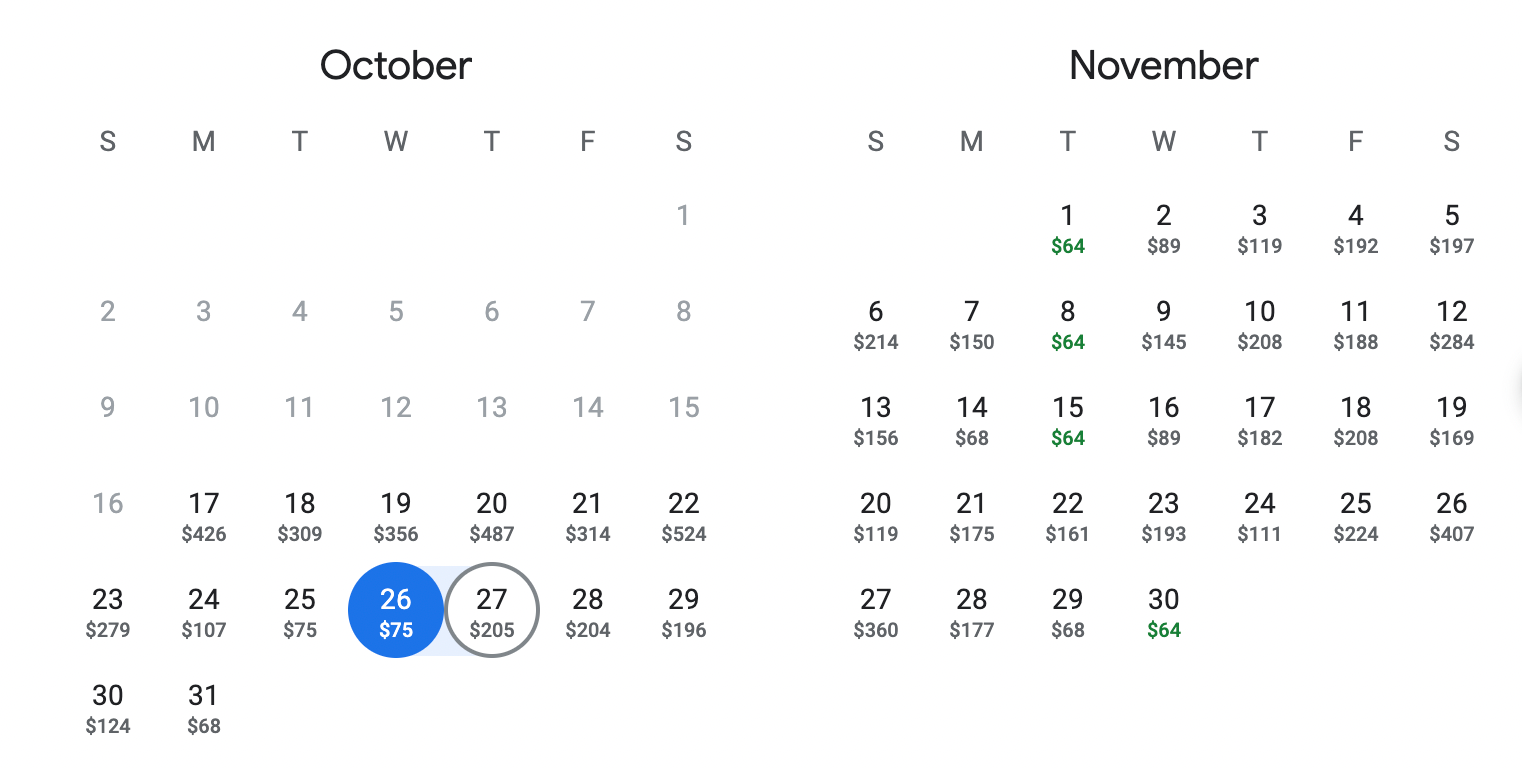
With the dates settled, I zeroed in on picking my exact flights.
Narrowing down airports
Now that I live in New York City, I have three airports to choose from every time I fly: LaGuardia Airport (LGA), John F. Kennedy International Airport (JFK) and Newark Liberty International Airport (EWR).
LaGuardia is closest to my apartment, but the airport offered the fewest nonstop flights to New Orleans. As a result, I decided to focus on finding a flight from one of the latter two airports despite knowing there'd be a lengthier commute.
Picking an airline
I thought choosing a city was hard, but deciding on an airline was even harder. Since this was my first time booking by myself, I didn't necessarily have a particular airline I was loyal to.
I grew up near Newark's airport and had almost always exclusively flown from there on United Airlines for family vacations. I opened a United MileagePlus account last summer after flying to Denver, so the possibility of stacking up miles in that account was a consideration for me.
However, I didn't want to limit myself either, so I cast my net across all the major airlines to see what was available.
Besides the potential for earning miles, I considered factors like whether the fares were for basic economy or regular economy, if there were additional fees for luggage or carry-on bags, how convenient the flight times were and if nonstop options were available.
I looked at six different airlines: Spirit Airlines, United Airlines, JetBlue Airways, Delta Air Lines, American Airlines and Southwest Airlines. I used Google Flights to get a general overview of pricing for my search (conducted the week of Sept. 26), but I then visited each airline's website to look at my booking options.
Spirit, which claims to offer the cheapest possible fares, was on the more expensive end once I factored in all of the add-on fees.
While fares to Louis Armstrong New Orleans International Airport (MSY) totaled $94, fees for "perks" like a carry-on bag and seat selection caused the total price for a round-trip flight to jump to $322.
On Spirit's website, some of the fares from Newark were astonishingly low, starting at $27 one-way. However, the single $27 fare available left Newark at 5:45 a.m., and I didn't want to deal with the hassle of getting to the airport two hours earlier, at 3:45 a.m.
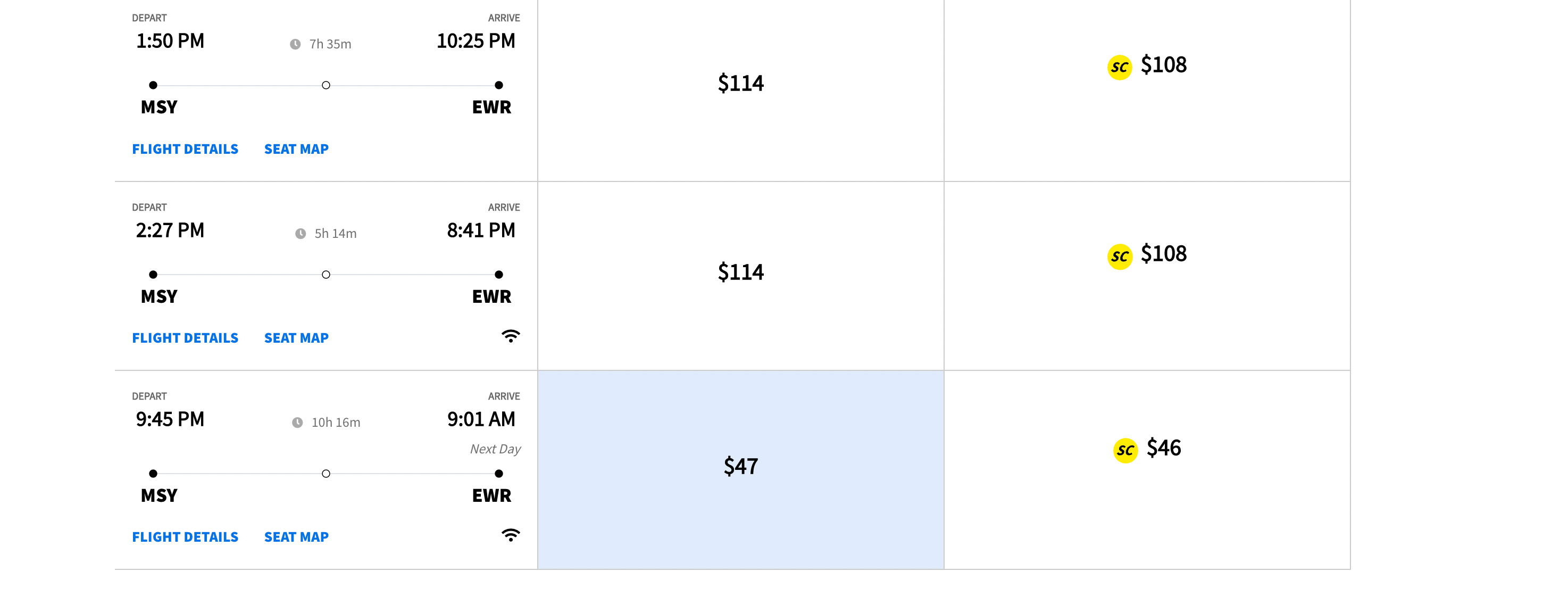
The trips returning to Newark were more expensive, and some had such cumbersome connections — including one with an overnight layover — so they weren't realistic considerations.
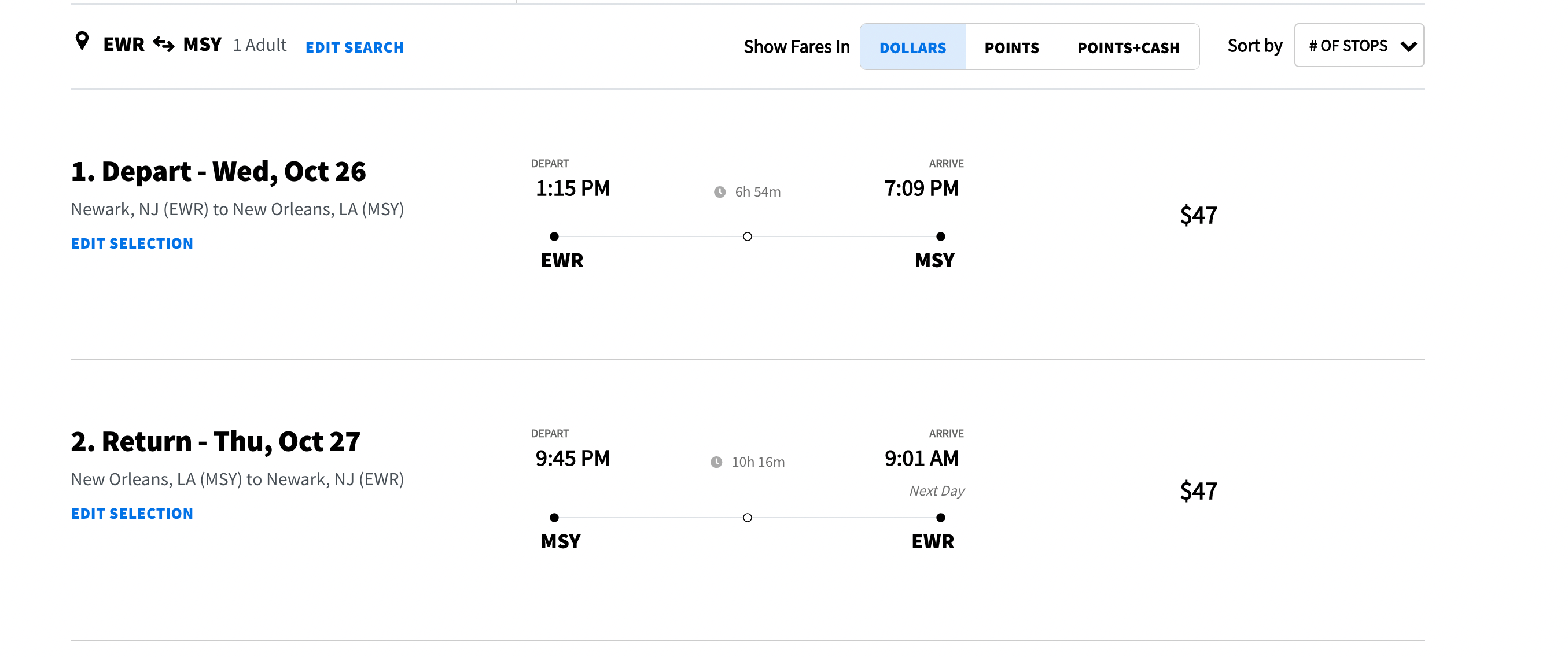
Since I had never flown with Spirit before, I was hesitant to go for the airline's "Saver" option. It required buying a membership, and I didn't want to sign myself up for something if I wasn't sure I'd use it again.
In the end, the low fares felt a little misleading. Spirit tacked on additional fees to every other aspect of the flight, from the carry-ons to the seat selection. I didn't need to check a bag for such a short trip, but I wanted the option of bringing a carry-on for my flight. Without any of these perks, I'd be limited to just a personal item that would have to fit under the seat in front of me.
What shocked me the most about this process was how expensive the fees were for carry-ons. A carry-on cost $64 each way, which felt a bit unreasonable to me.
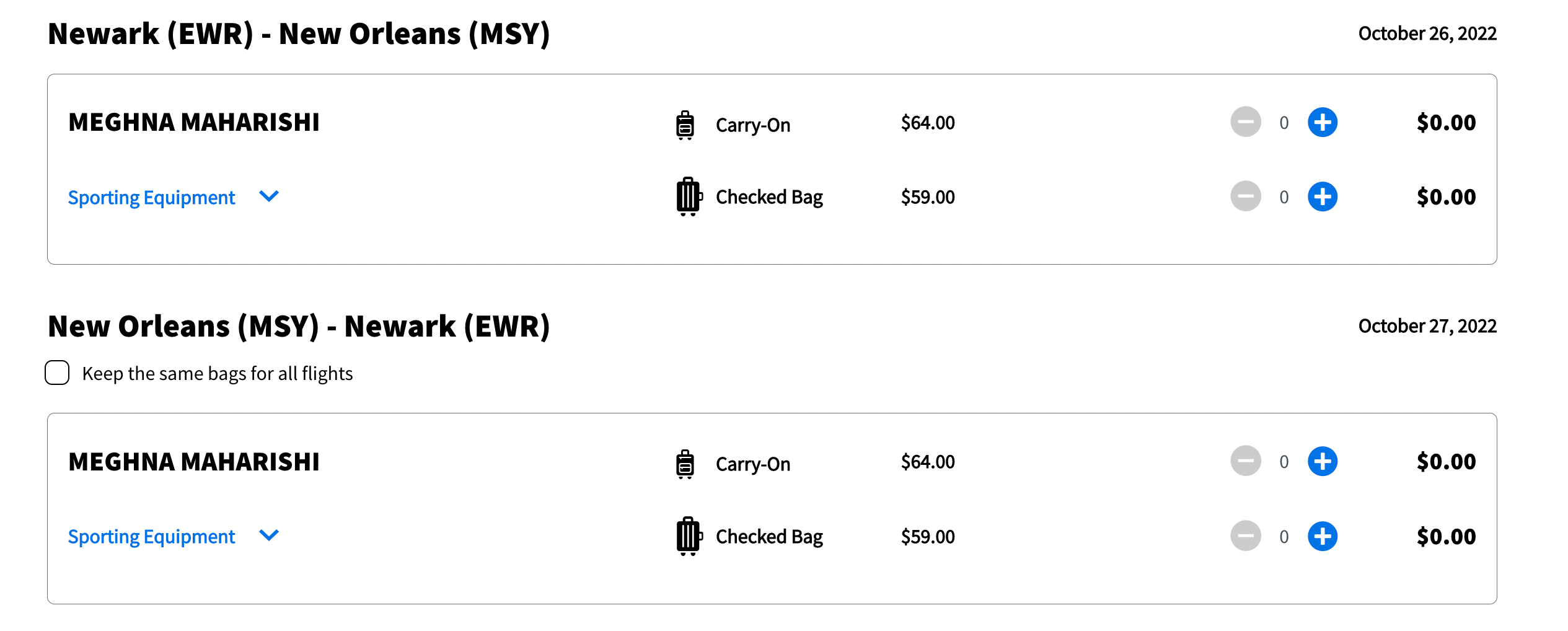
On top of it all, the seats were expensive. For the returning flights, the cheapest seats available for advance purchase were $6, but the cost of the cheapest possible seats differed for all four flights — I would have ended up spending an additional $101 on seat selection.

The total cost of a round-trip itinerary from Newark to New Orleans came out to $322 — a whopping markup from the $94 base fare that initially drew me in. That felt too expensive for an airline that has always been known for its cheap prices. The fares were low, but the additional fees weren't worth it to me. I'd rather pay a more expensive fare that included seat selection and a carry-on than spend an additional $228 for what I considered to be basic comfort.
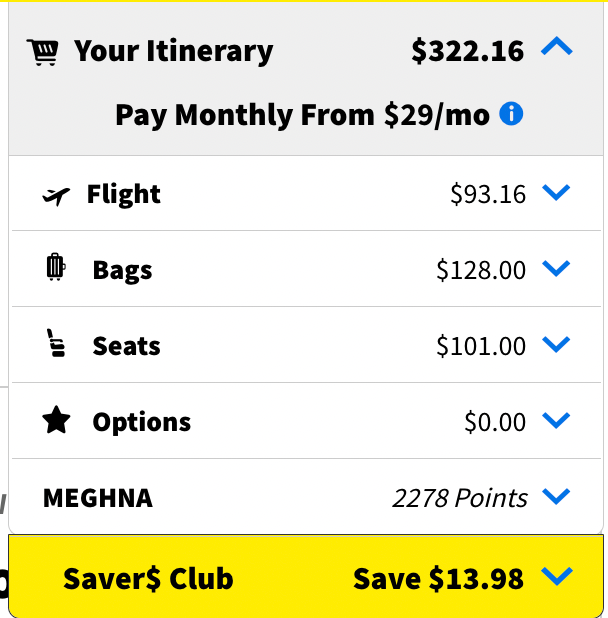
Of all the airlines, JetBlue surprised me the most. The airline's "Blue" option offered fares at reasonable prices from JFK, with the added bonus of a carry-on. JetBlue has a "Blue Basic" option that had even cheaper fares, but because it didn't allow me to bring a carry-on, I ruled out the basic economy option.
With the "Blue" option, the total price of the flight came in around $197. I didn't have to pay extra for the seat or carry-on since both were already included in the fare.
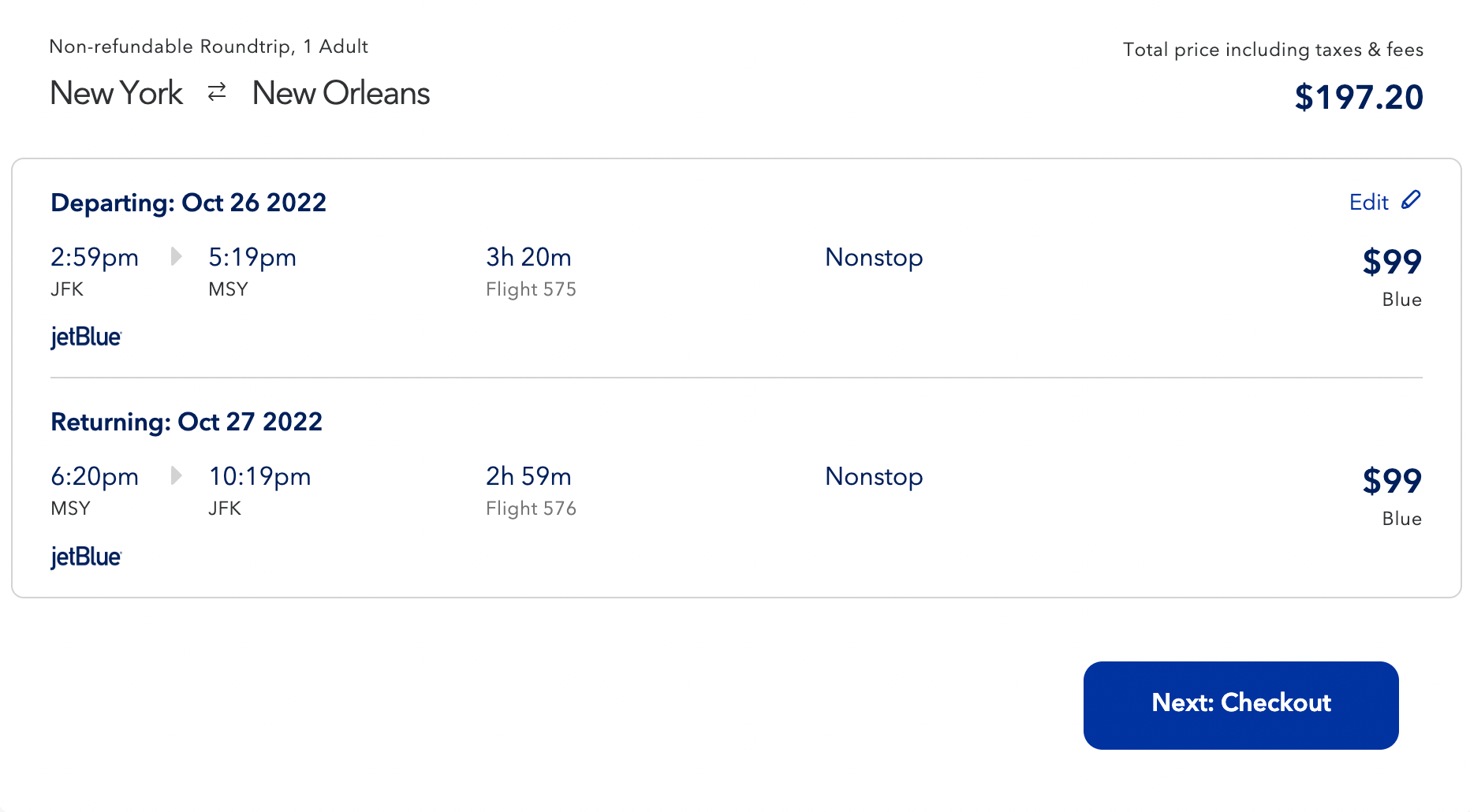
JetBlue also had additional fees for perks like priority check-in and checked baggage, but since I only needed a carry-on, I didn't feel a need to purchase any of the extra perks.
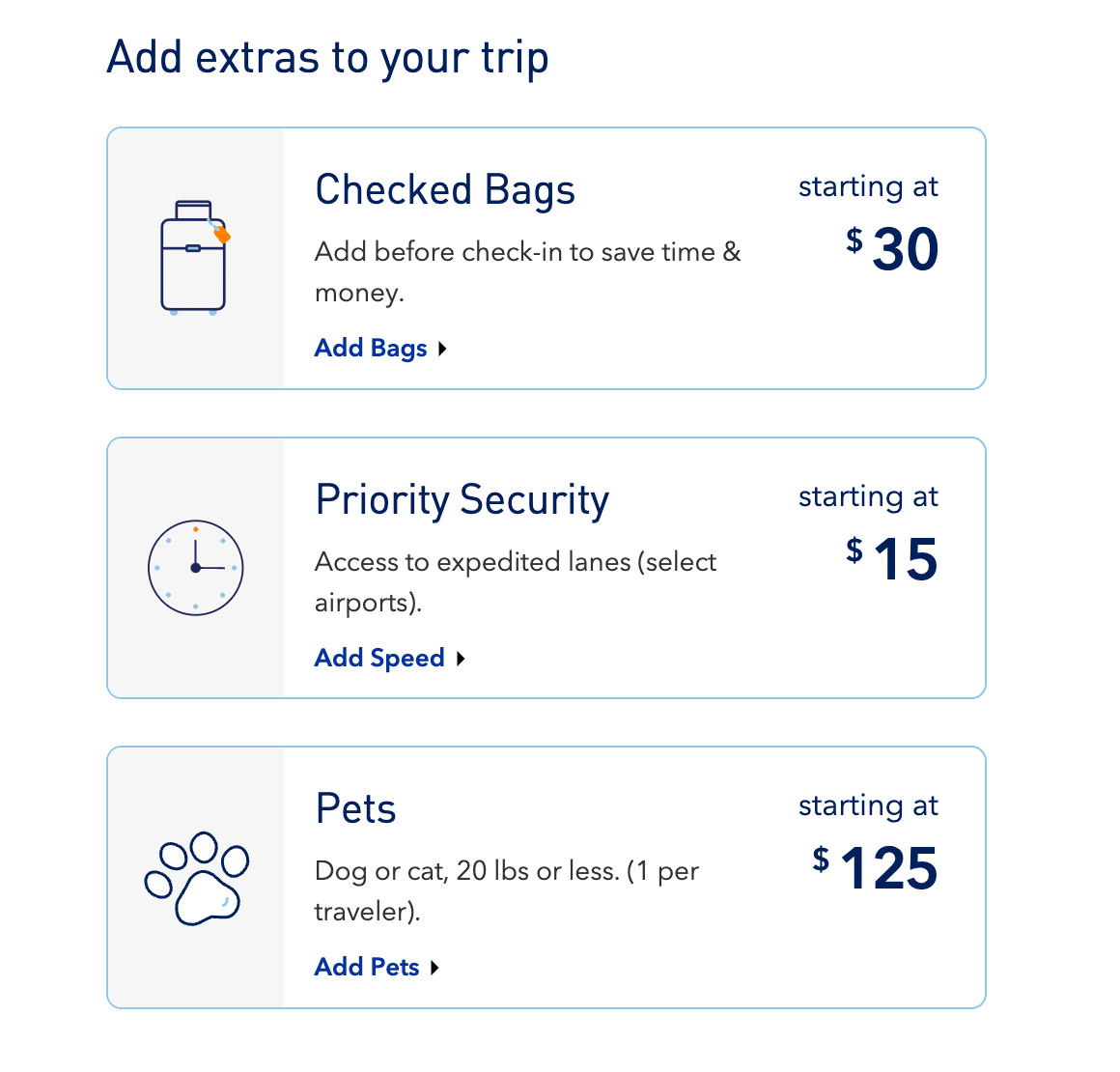
Considering that I didn't have to pay extra for add-ons because I chose an economy fare, JetBlue became a strong contender. The airline's numerous nonstop flights to New Orleans were another plus, as they'd save me from transiting through another city as I would on have on other carriers' connecting itineraries.
With JetBlue, the option that made the most sense was a flight that would take off from JFK at 2:59 p.m. and land at 5:19 p.m. on Oct. 18. My return flight would leave New Orleans at 6:20 p.m., giving me a whole day in the city. While the timing was not perfect, both flights were nonstop and would still give me sufficient time to explore New Orleans during a quick trip.
Delta offered some cheap fares, with some as low as $190.
Even though Delta has a basic economy option that allows for a carry-on, I opted for the "Main" option, which cost $250. That's only $60 more than basic economy, and it allowed for seat selection without any additional charges, which seemed like a good value to me.
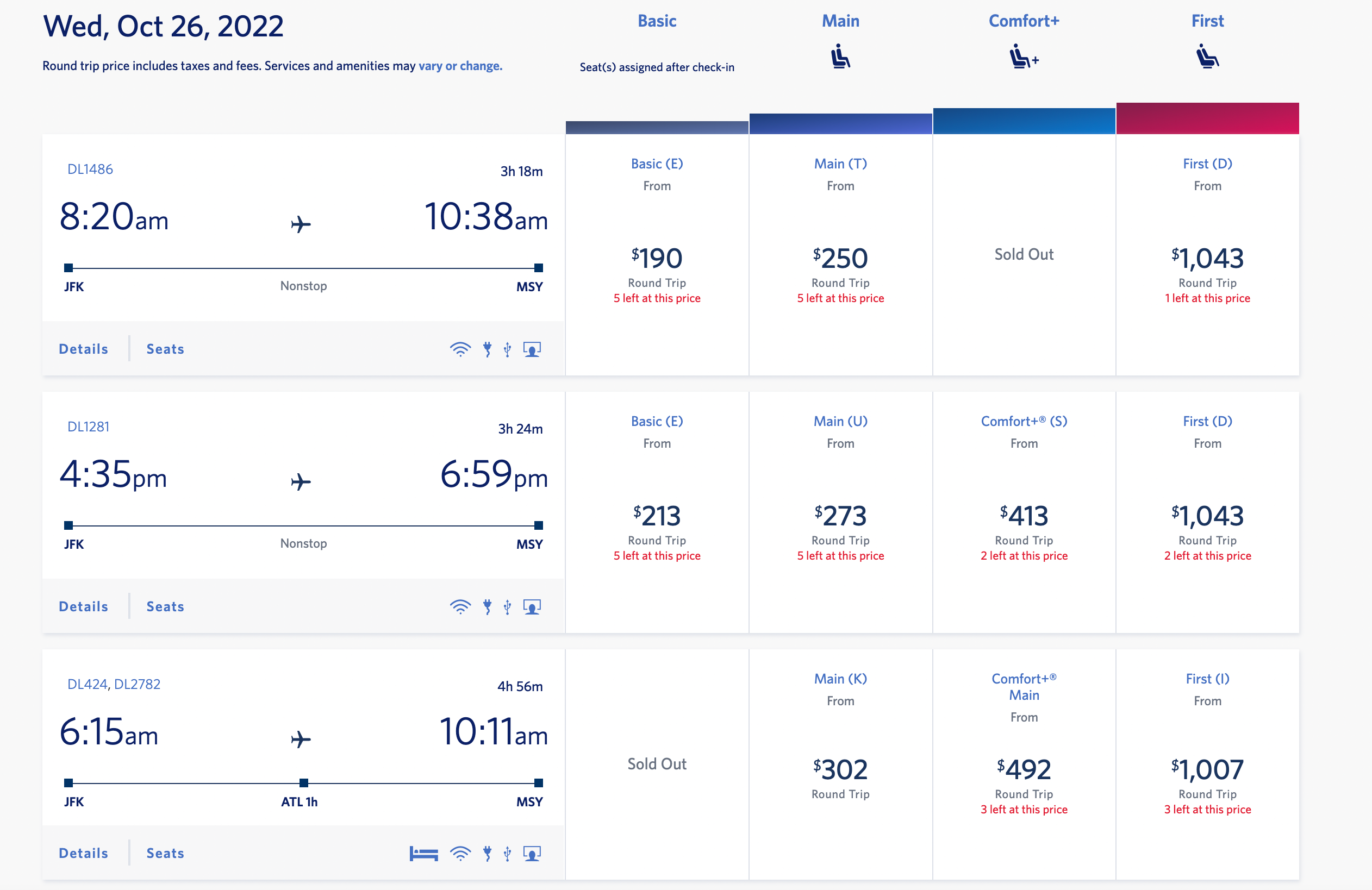
The $250 price tag was a little more expensive compared to JetBlue, but it didn't strike me as shocking since there weren't any extra fees tacked onto the fare.
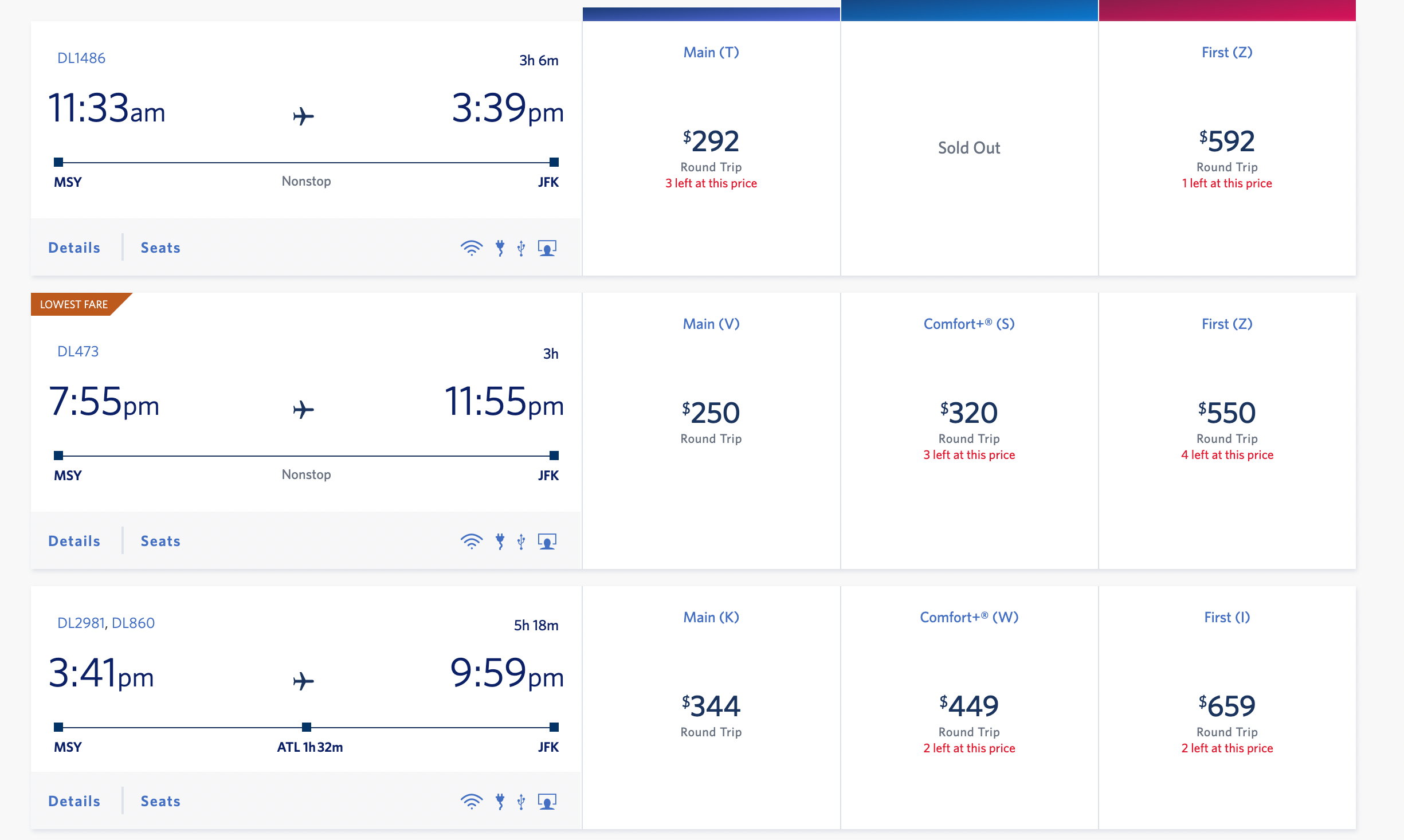
Of the options available, the most appealing was an early morning flight at 8:20 a.m. and a nonstop return flight at night the next day. By flying Delta, I would have the better part of two days for exploring New Orleans.
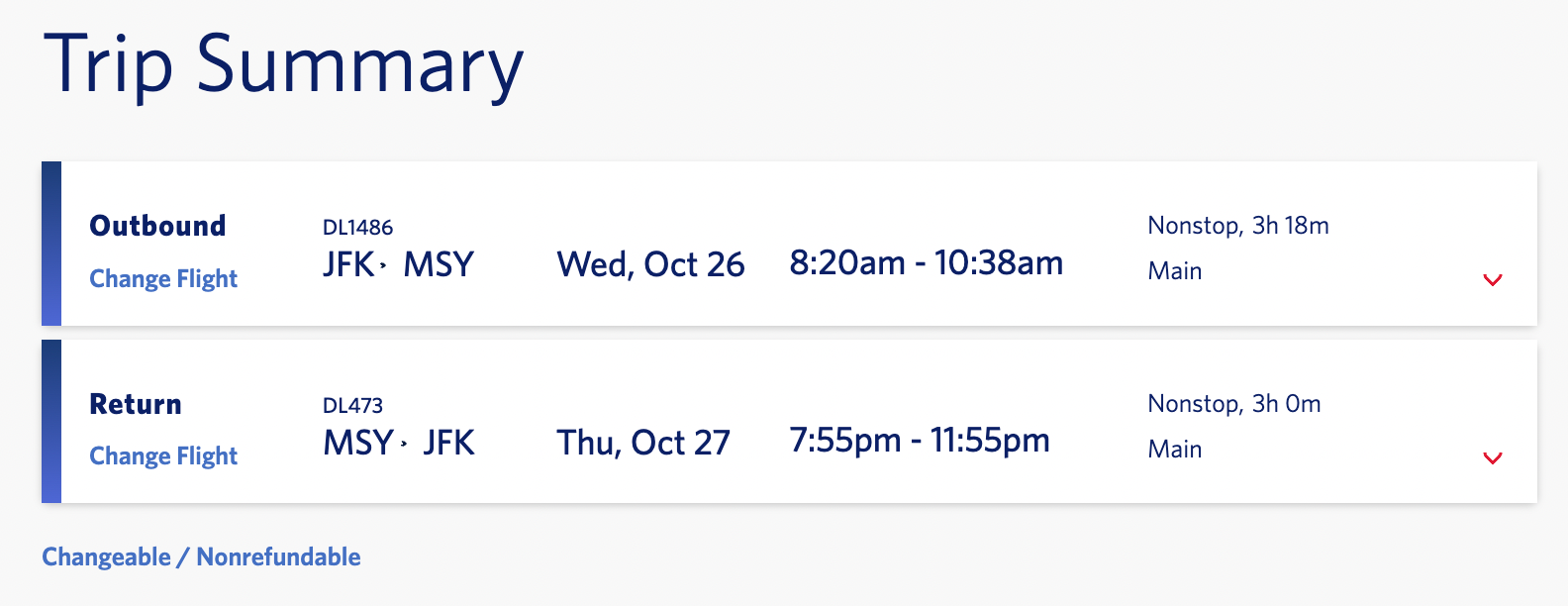
While other airlines had later options, they either caused the fare to spike or created unreasonable travel times because of connections. That was hard to justify for such a short trip.
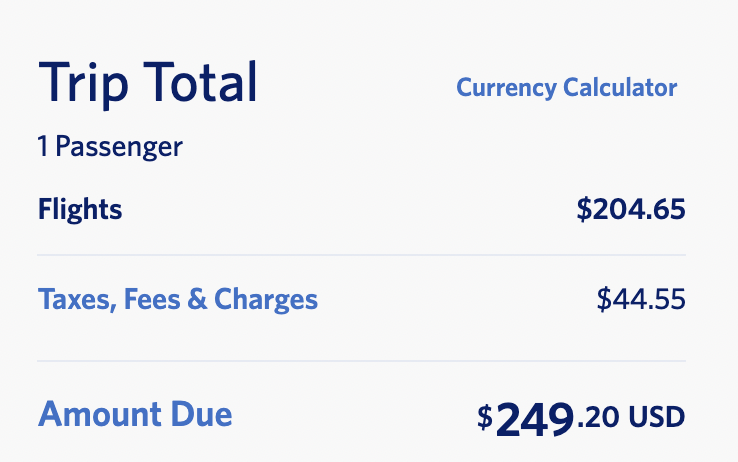
Compared to other carriers I considered, American did not have as many nonstop flights to New Orleans. Additionally, many of the direct flights from JFK no longer had a basic economy option, so I had no choice but to consider the "Main" option.
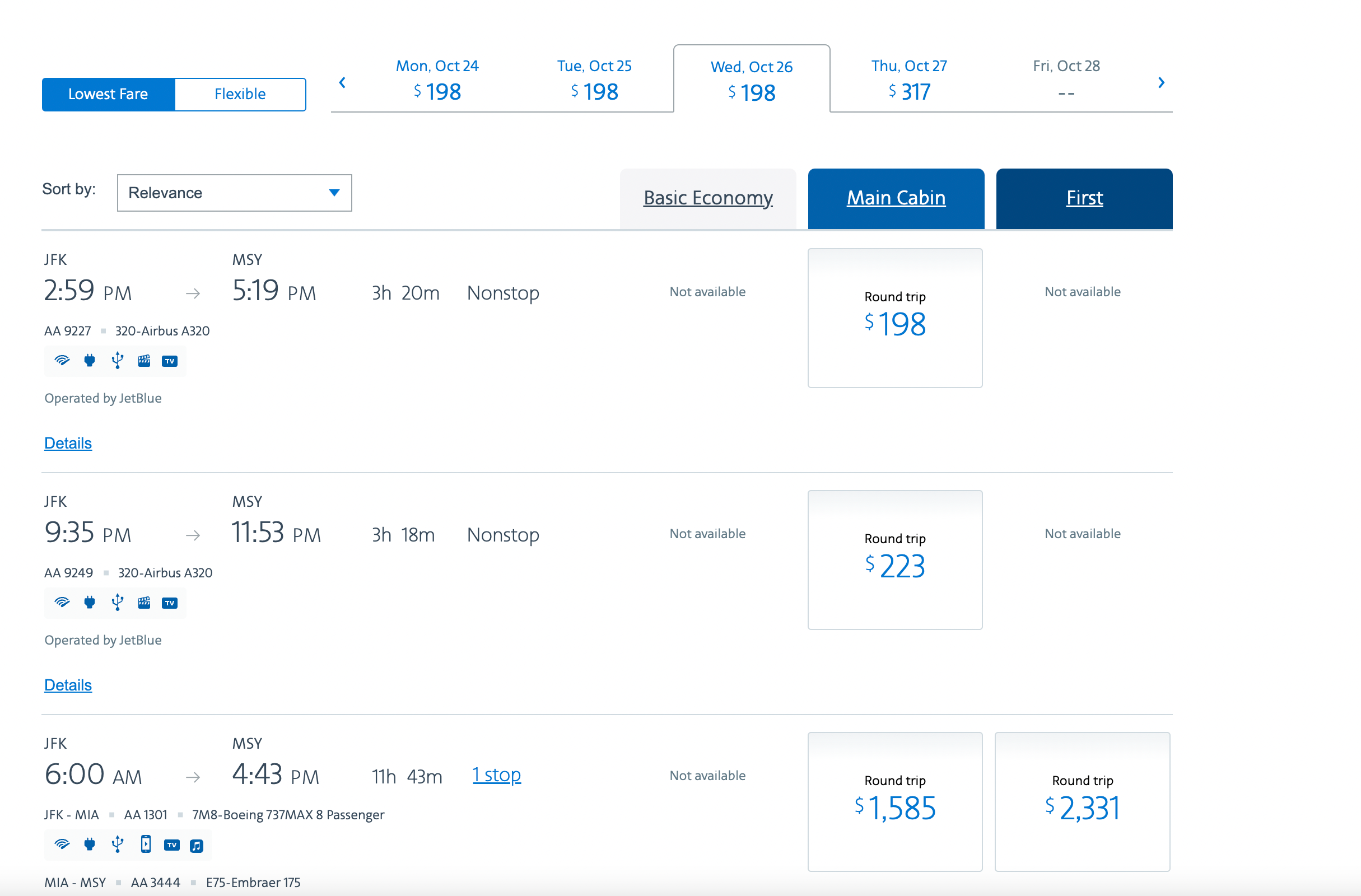
Luckily, I was able to find a nonstop round-trip flight with American. The main cabin fares totaled $198, which I found reasonable, and the itinerary would give me sufficient time to spend in the city.
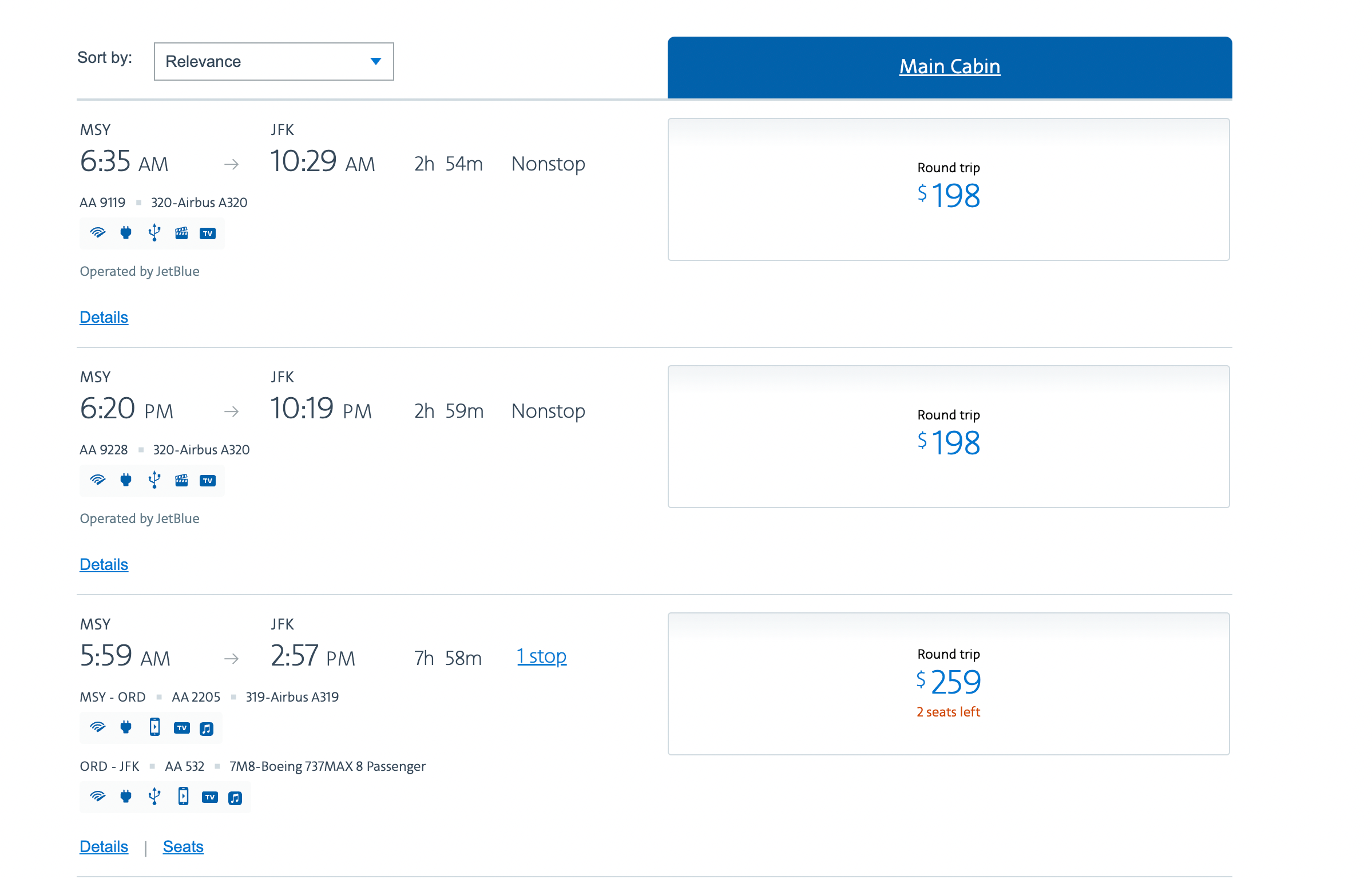
Since JetBlue was the carrier operating these flights due to its Northeast Alliance with American, the round-trip itinerary's prices and times were the same as the JetBlue option I had been considering.
Given that JetBlue was operating the two flights, American did not have seat selection available on its website.
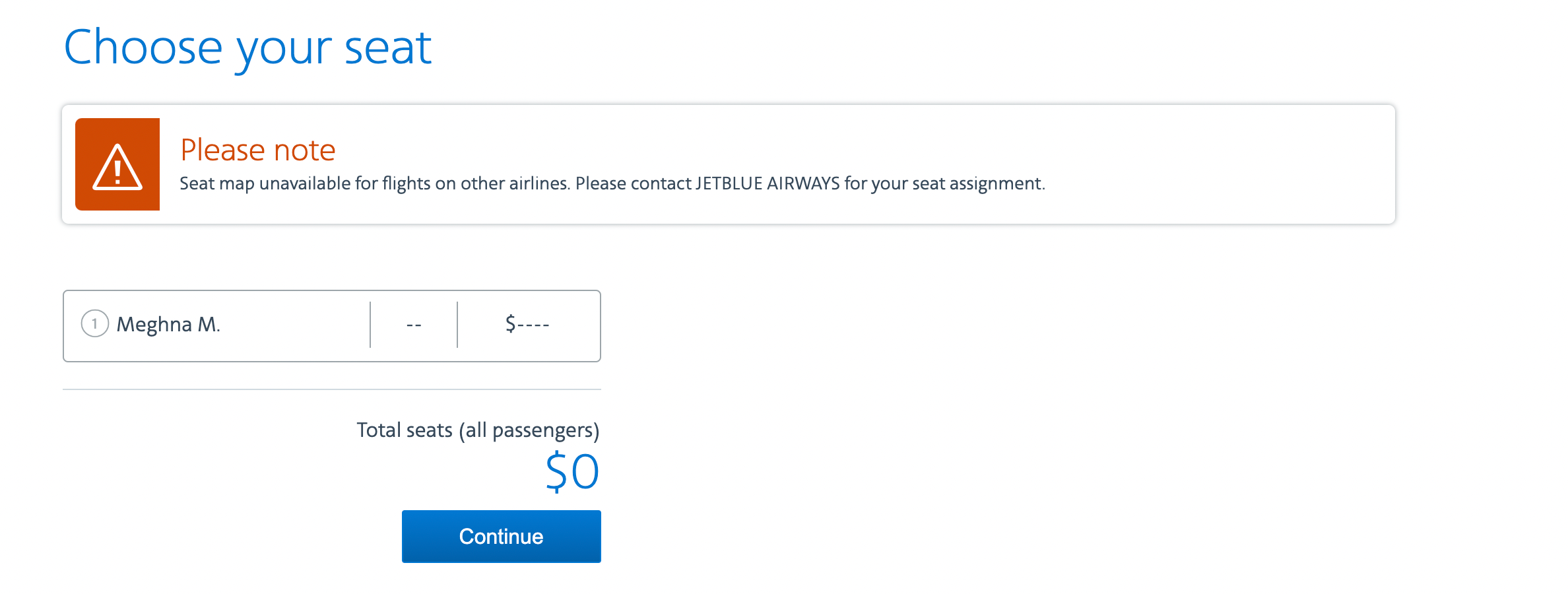
Southwest was one of the more inconvenient options I looked at, in part because of the carrier's relatively limited presence in New York. The airline had numerous itineraries, but many were sold out or had limited availability.
I favored the 2:55 p.m. flight from LaGuardia to New Orleans' airport, which was only $74 one-way. Luckily, it was one of the few time slots that didn't seem like it was going to sell out immediately.
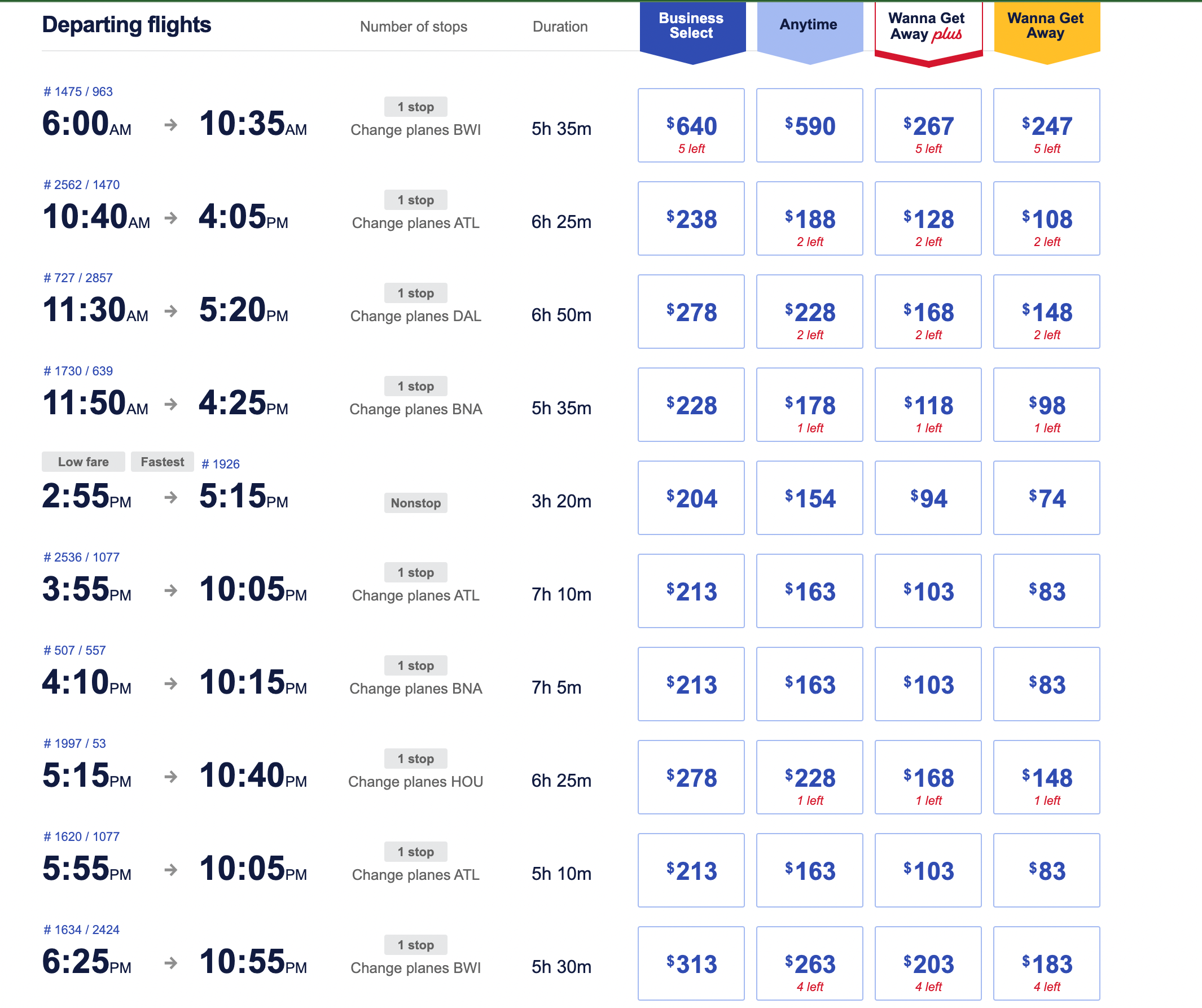
For the return trip, there were even fewer options. I focused on the last flight leaving New Orleans at 4:50 p.m., but it would include a stop at Baltimore/Washington International Thurgood Marshall Airport (BWI).
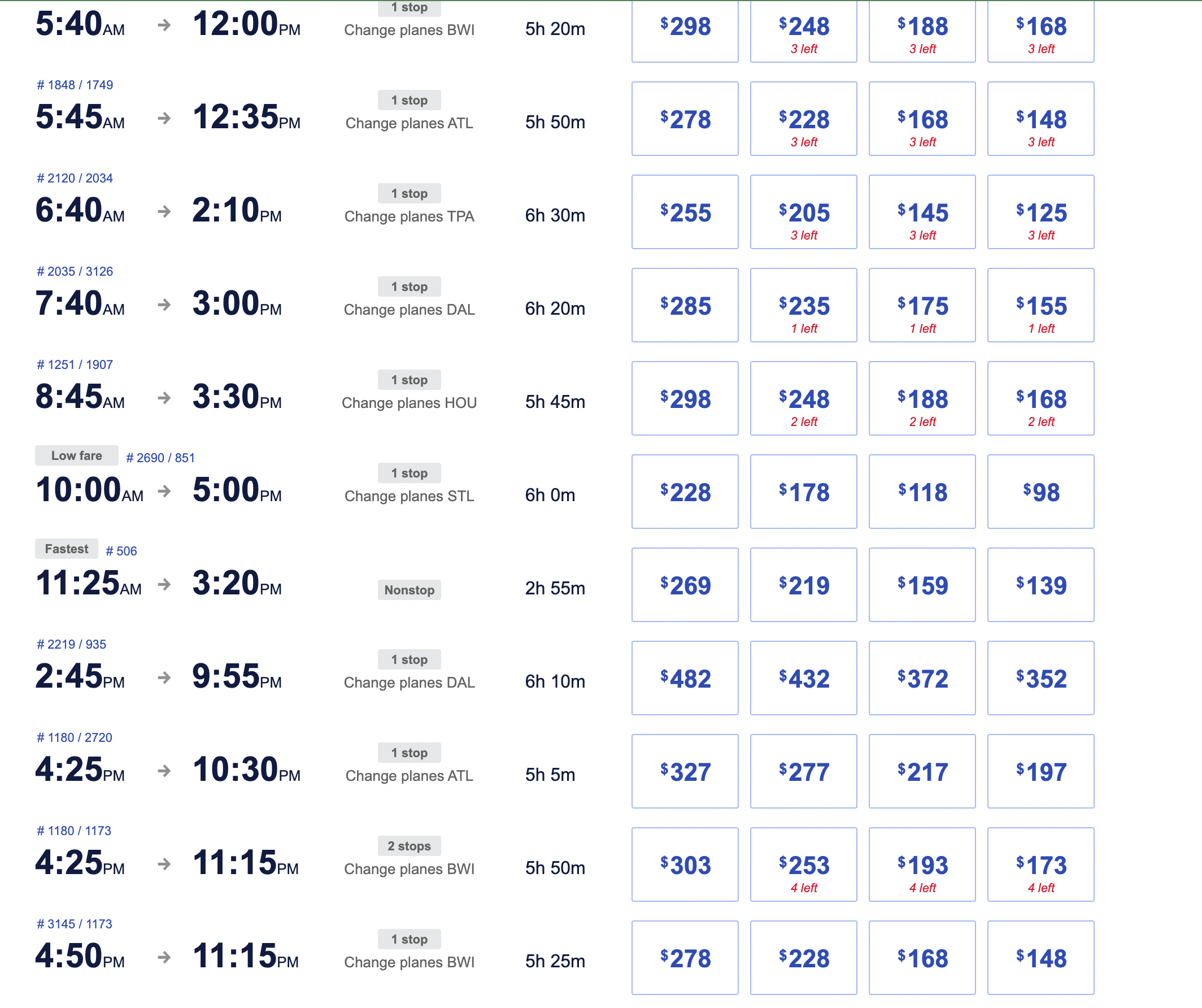
With Southwest, I opted for the "Wanna Get Away" fare for the extra flexibility. The total came out to $221, which was reasonable. However, other than Spirit, Southwest was the only other carrier with an itinerary that included a stop.
Because only one flight was nonstop — not to mention the higher fare — I felt less inclined to book with Southwest. Additionally, I wasn't the biggest fan of the times — I only had a day to spend in New Orleans, and these flights did not maximize my time on the ground.
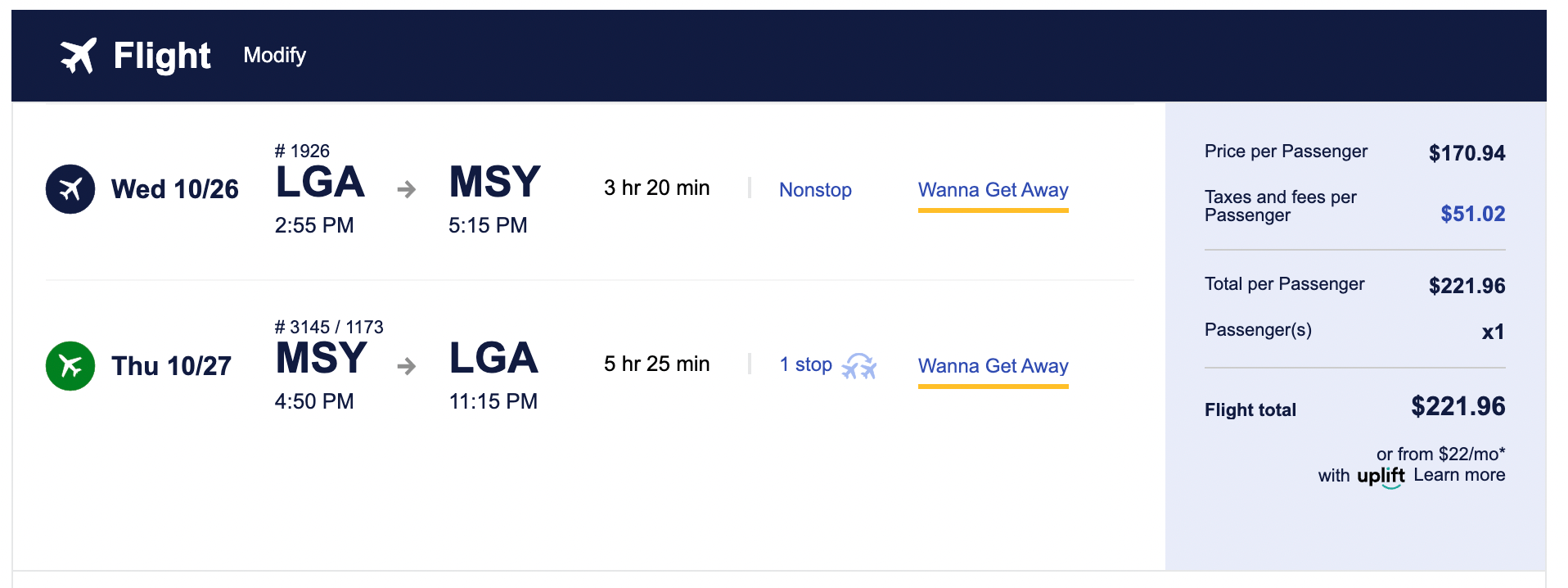
There was also nothing on seat selection in the booking process, so the process of choosing a seat was unclear to me as a newer traveler. I later learned that the reason for this was because of Southwest's open seating policy, which allows all passengers to pick their seats as they board instead of choosing a seat assignment in advance.
United was the airline I grew up flying with, so I felt like I already knew what to expect from a United flight.
My search priced a United round trip in economy on my preferred dates at $208. I favored economy over basic economy (which cost $148) because United's basic economy option does not allow for carry-on bags. Compared to my experience with Spirit, a $208 round-trip flight seemed like a deal.
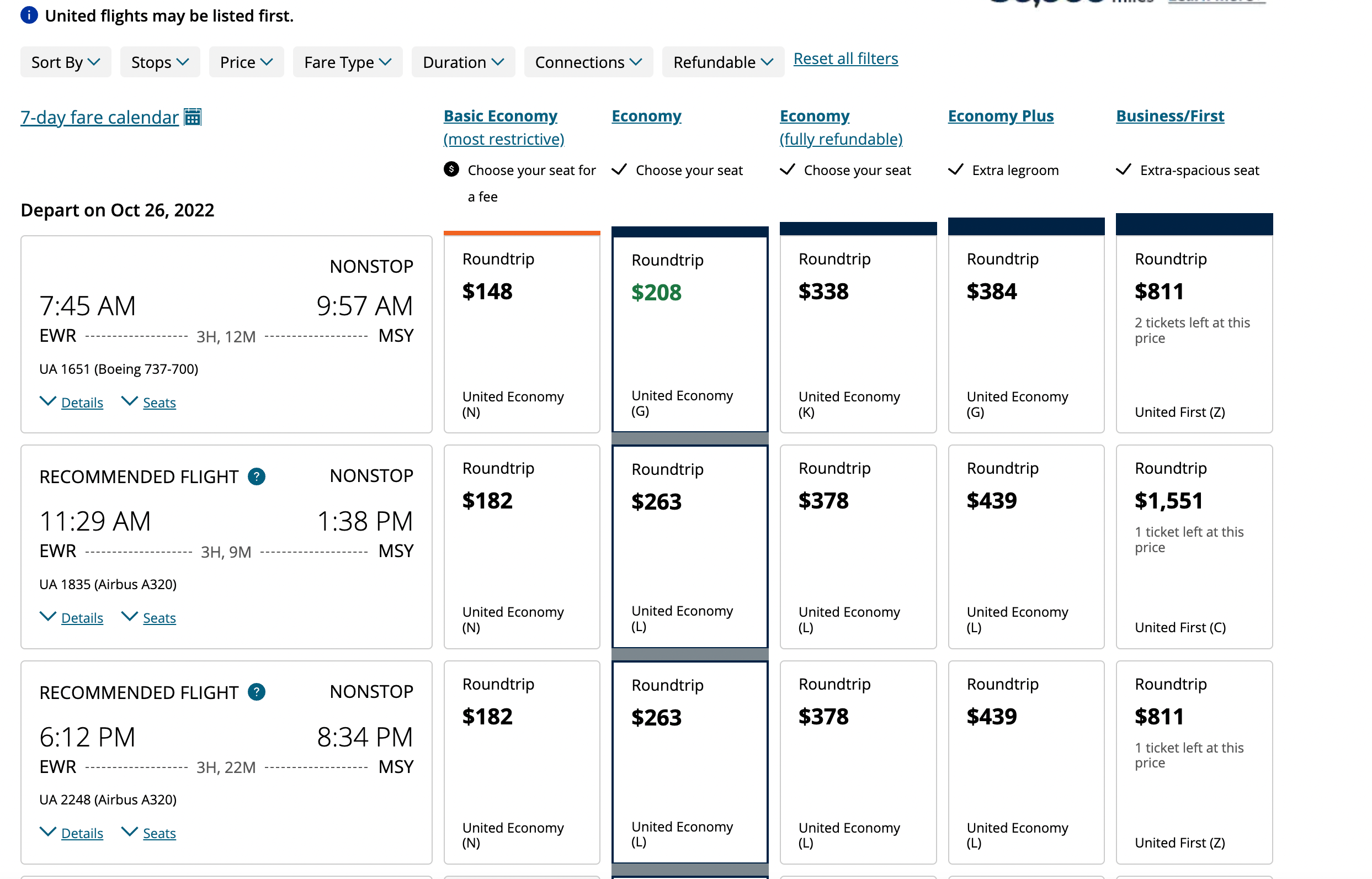
By opting for the 7:45 a.m. flight, I could have most of the day in New Orleans after arriving at 9:57 a.m. United also offered the most direct flights compared to the other airlines, which was perhaps no surprise given its large hub in Newark. Additionally, the return flight the next day was at 7:53 p.m., allowing me to maximize my limited time in New Orleans.
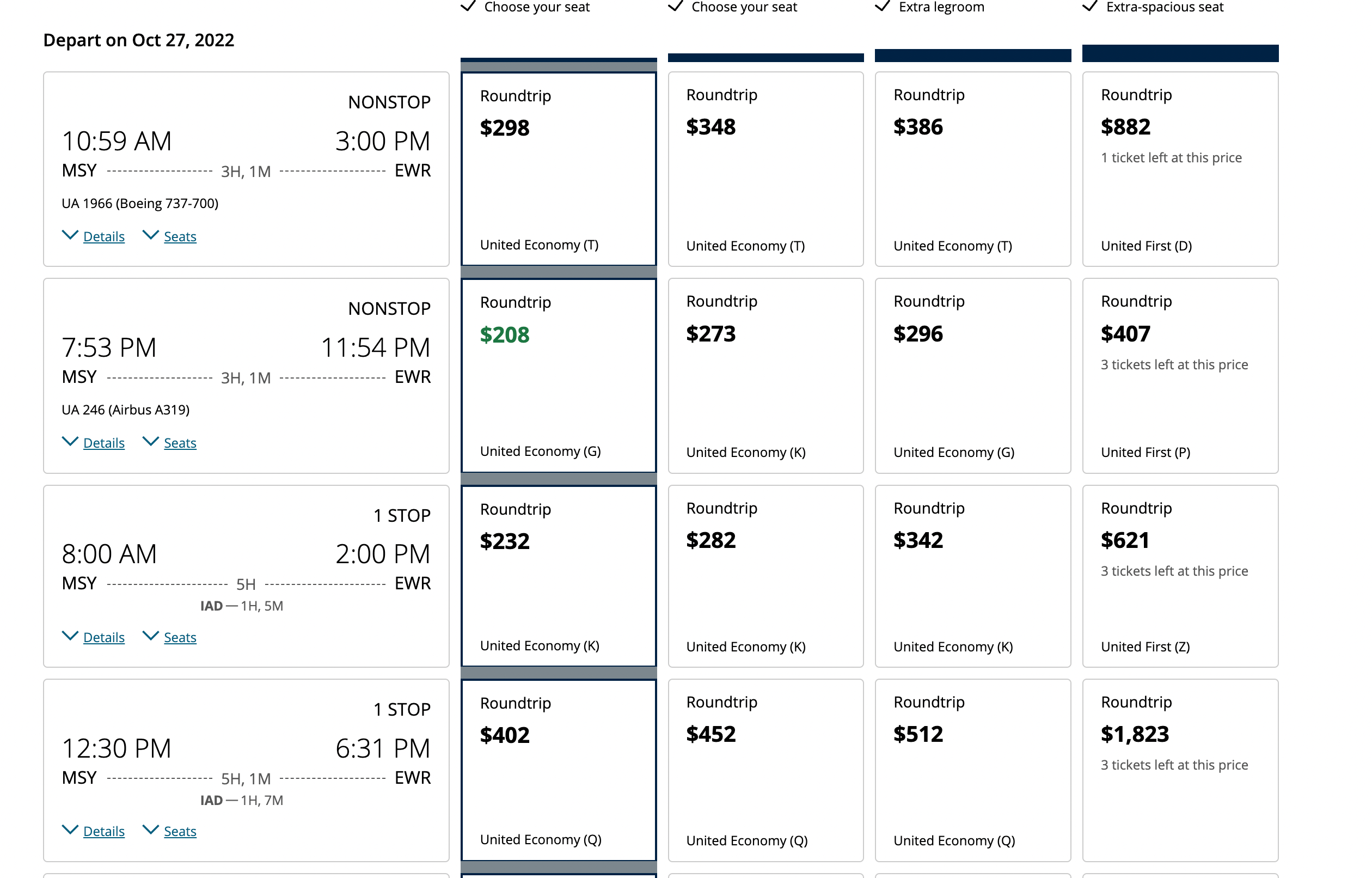
Since the regular economy fare included seat selection and was available for both departing and returning flights, I ended up not spending extra money on what the airline considers to be preferred seats — like those in the exit row or closer to the front of the plane.
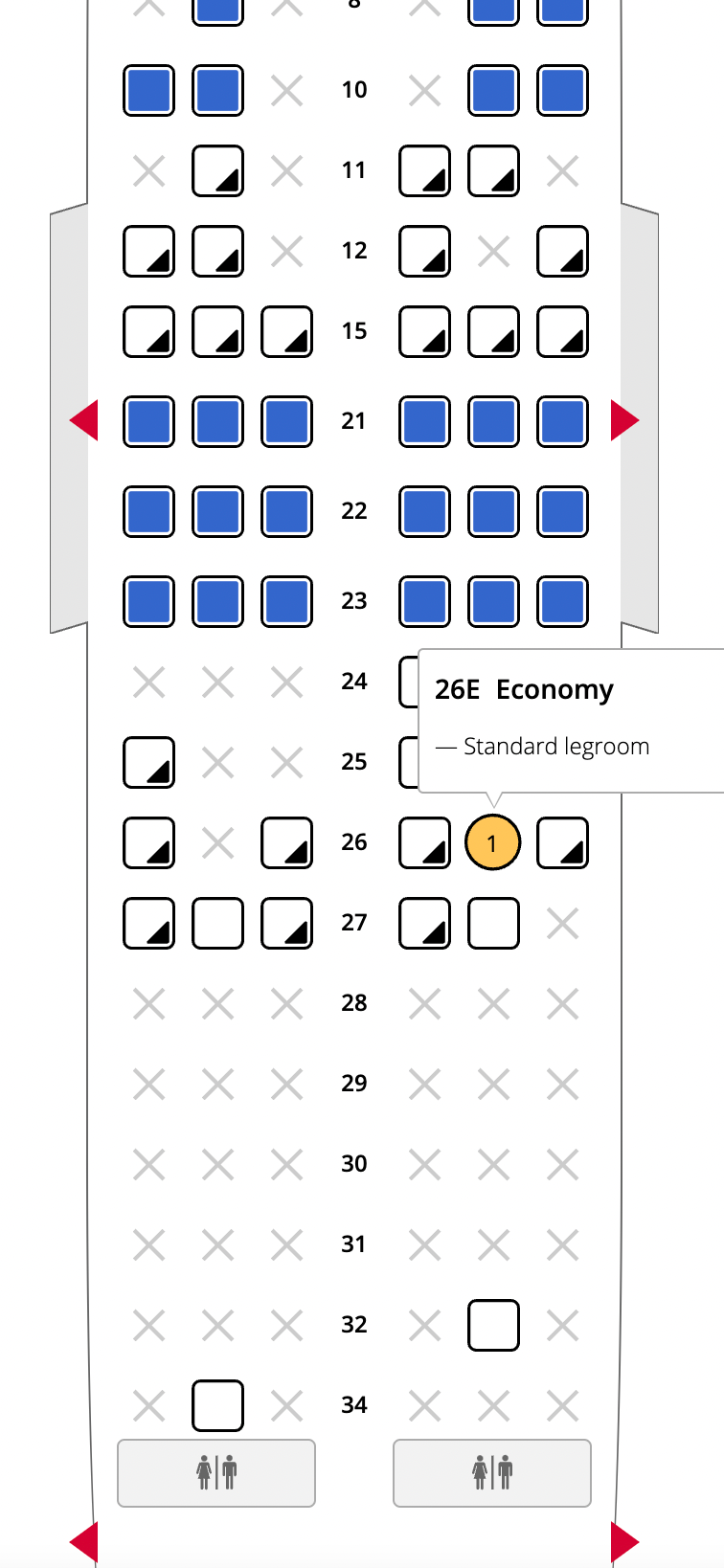
Even with an upgrade from basic economy, my United flight was cheaper than other options like those with Spirit. Plus, I felt like I would get more flexibility from an economy fare while avoiding incurring additional charges for bare minimum necessities that help make a flight comfortable.
Earning miles in the United MileagePlus program was appealing, too, even though my ticket would earn fewer than 1,000 miles for the total trip. Because of this, the earning potential didn't end up swaying me much.
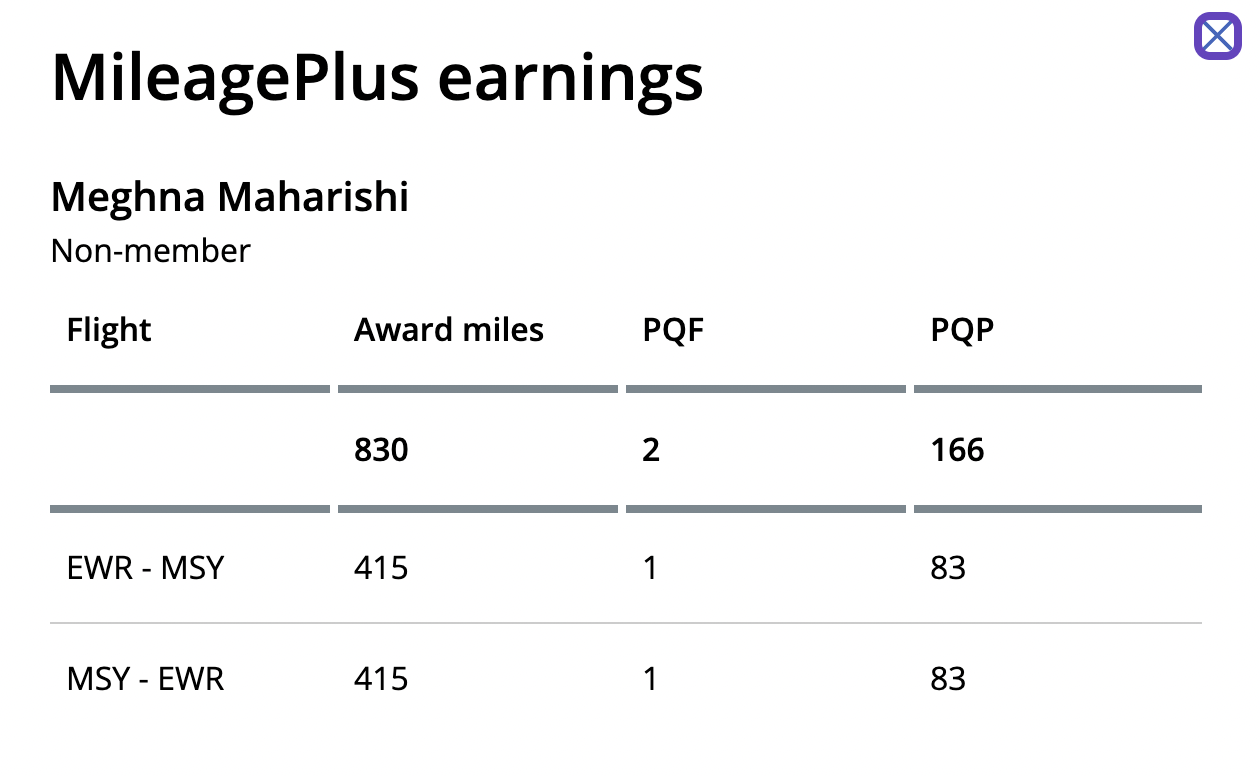
The final verdict
I expected Spirit and Southwest to be cheaper given their reputations as discount carriers, but both ended up being either equally as expensive or more expensive than the others, so I crossed them off the list.
Of the six airlines I researched, Spirit disappointed me the most with its many fees, and I was surprised at the fact that it ended up being my most expensive option. Southwest's fares were on par with United, JetBlue, American and Delta, but my main issue was that my returning flight had a stop. I also wasn't the biggest fan of the available times for Southwest — I chose a 2:55 p.m. flight to New Orleans because it was the cheapest option, but my preference was for something earlier in the day.
Delta was one of the more expensive options as well. A $250 round-trip flight to New Orleans wasn't unreasonable for the week of Oct. 24, but was more than I wanted to pay — especially given the other choices.
I ended up sticking to what I know and chose United. JetBlue and American were the cheapest of the six, but in the end, United was close in price and I knew what to expect since most of my flying experience has been with the carrier.
But, above all, it was the schedule that really sold me. The ability to leave New York for New Orleans early and return late at night the next day would give me about 36 hours to explore New Orleans. JetBlue and American were cheaper, but since I'd depart from JFK in the afternoon and then take an evening flight from MSY the next day, I'd only have around 24 hours in the Big Easy.
Cheap fares were important, but so was the ability to pack as much as possible into an overnight trip — and I feel like I got that with my United itinerary. A reasonable fare, a good flight schedule and now the chance to see someplace new all came with United.
It took a little effort, but I feel as if my research paid off. Now, I'm looking forward to seeing the sights of New Orleans — and to making my first solo getaway as a young adult.
There were some big lessons I picked up along the way. The fares changed frequently during my search. Plus, I never realized just how important good flight times were to maximizing my trip. Matching those ideal times to low fares was a bit of extra work, but worth the effort. And, beware of fees! Some of my original top choices nearly doubled in price once I accounted for those — a lesson you don't want to learn the hard way after you've already booked.
The process was a little intimidating and at times tedious, but in the end, I found what I was looking for. So, if you're like me, stick with it and see what's out there. Before long, you might be on a fun trip of your own.

An official website of the United States government
Here’s how you know
Official websites use .gov A .gov website belongs to an official government organization in the United States.
Secure .gov websites use HTTPS A lock ( Lock A locked padlock ) or https:// means you’ve safely connected to the .gov website. Share sensitive information only on official, secure websites.
Advice for First Time Travelers Part 1.
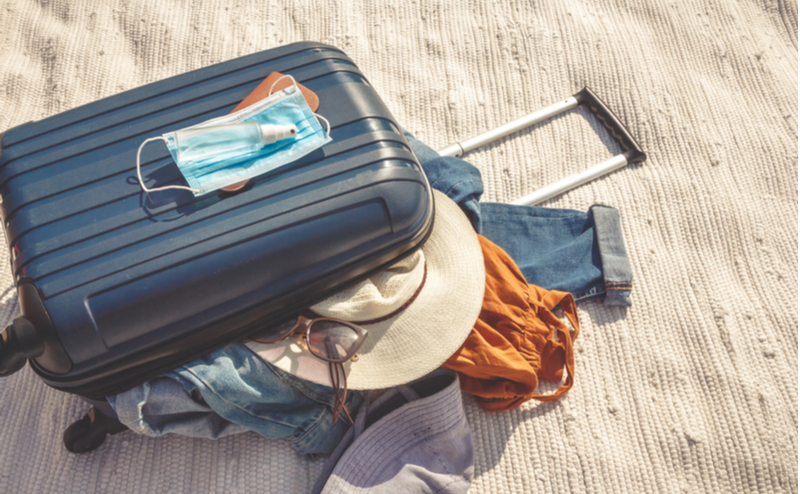
Even if you’re a frequent flyer, the screening process can be overwhelming at times. For the uninitiated first-time traveler, it can be even worse. Follow along in our short blog series where we will share tips for first time flyers, frequent travelers and people who just want to get through security more efficiently!
Suitcases and Carry-Ons.
Let’s start with the basics: personal/carry-on bags and checked bags. Carry-on bags (or personal baggage, depending on the airlines) are any bags you are planning to carry with you on the plane, while checked bags are those destined for the cargo hold of the plane. When it comes to the size and weight of your bags, policies vary from airline to airline. The airlines also make the rules on which bags count towards your carry-on allowance and which will incur checked baggage fees. So before your scheduled flight, make sure to check your airline’s policy and guidelines page.
Oh, and if you think TSA officers only screen your carry-on bags then you are mistaken. TSA officers screen all bags – including checked bags – before your flight takes off. So be sure to pack smart and check your bags thoroughly for prohibited items before you arrive to the airport. For the best resource to understand what you can and cannot bring in your carry-on or checked bag, check out the What Can I Bring ? tool on the TSA website.
Pack like a Pro.
When packing your carry-on bag, organization is key! Keep your large electronics – like computers, tablets and video game consoles – as well as your travel liquids bag at the top of your bag for easy accessibility. This will make your screening experience smoother when you’re asked to pull these items out of your bags and place them in bin for screening. Have additional questions on how to best prepare your carry-on bags for security screening? Check out this video to learn more.
TSA’s Liquids Rule.
How familiar are you with TSA’s liquids rule? And why do we have specific guidelines for liquids? Liquid explosives still pose a threat to aviation, so allowing passengers to carry their liquids, gels and aerosols in smaller containers lessens that risk. So what qualifies a liquid? Here’s an easy way to think about that: if you can spread it, smear it, pump it or spray it, it is considered a liquid. Watch this video to learn more on how to best travel with your liquids.
Heading to the Airport
Don’t forget your mask and give yourself plenty of time to arrive at the airport early. Running to your gate in a face mask doesn’t sound like much fun to us! We also recommend wearing easily removable shoes (and socks) to make the screening process a little bit smoother for you! Again, don’t forget your mask!
A Final Travel Tip (for now)
Download the MyTSA app ! The MyTSA app provides passengers with 24/7 access to the most frequently requested airport security information on any mobile device. Check delay information and current weather conditions at your favorite airports nationwide. You can also use the “What Can I Bring?” tool right in the app to know if an item can be packed in your carry-on or checked bag before arriving at the airport.
About This Blog
The purpose of this blog is to share the latest news and helpful information with the public. If you have questions about TSA or the information presented here, please contact our AskTSA customer care team on Twitter or Facebook .
TSA is committed to protecting privacy and securing personal information. For details, see our website Privacy Policy .
Stay informed on our latest news!

- Amusement Parks
- Ancient + Historical
- Guide to the Hawaiian Islands
- National Parks
- Natural Wonders
- Restaurants
- All Inclusive
- Spa Resorts
- Beach Vacations
- Family Vacations
- Things To Do
- Best Winter Vacations: 10 Places to Consider for Your Getaway
- Camping Tips
- General Travel Tips
- Gifts for Travelers: The Ultimate Gift Guide
- Packing Tips
- Tech + Gear
- Travel Accessories
- Travel Deals
- Health + Safety
- 6 Best Cruises for Couples in Need of a Romantic Getaway
- 10 Best Cruise Ships for Every Kind of Traveler | Review
- Best Hotels in Las Vegas for Luxury, Partying, and Relaxation
- Best Hotels in New Orleans: Your Luxury Guide
- Couples Resorts: Take Your Pick From the World’s Best Romantic Getaways
- The 10 Best Hotels in Miami
- The 10 Best Bermuda Hotels for 2018: Tropical Luxury Resorts
- Best All-Inclusive Resorts in the USA
- 10 Best Hotels in Laguna Beach Reviewed | 2018
- Hotels in Santorini: 8 Luxury Island Accommodations
- Amalfi Coast Hotels Guide: Top 5 Places to Stay
- 13 Best Laptop Backpacks and Messenger Bags for the Efficient Traveler
- Smart Backpacks for Every Smart Traveler | Review
- 10 Best Travel Backpacks of 2018 for Your Next Adventure
- Best Weekender Bags for Travel in 2018
- The 6 Best Travel Tote Bags for Women We Just Can’t Get Enough of
- Best Luggage Sets for the Fashion-Minded Traveler
- Best Checked Luggage Pieces for Your Travels
- Top Smart Luggage Products (Plus How to Choose Yours)
- Best Lightweight Luggage Reviewed (Plus How to Choose Yours)
- Best Portable Phone Charger: A Travel Accessory for Your on the Go Lifestyle
- 7 Best Climbing Harnesses for Your Next Adventure
- 10 Best Bluetooth Speakers Money Can Buy | Review
- 5 Best Tree Tents and Hammocks for Your Next Outdoor Adventure
- The Best Pop Up Camping Tent: 5 Top Options
- The Best Car Camping Tent You Need for Your Next Adventure
- 5 Best Camping Tents for Outdoors Adventurers
- 7 Best Portable Water Filters for Your Outdoor Adventures
- Best Travel Cameras For The Adventurous Photographer
- The 6 Best Tent Heaters for Your Next Fall Camping Trip
- The 7 Best iPhone Tripods to Buy in 2018
- The 5 Best Chalk Bags of 2018: Your Shopping Guide
- Choose the Best Travel Mug for Your Next Adventure | Review
- 8 Cool Water Bottles for Your Next Adventure
- The Best Portable Travel Coffee Makers for Your Caffeine Cravings
- The 5 Best Hydration Packs to Bring on Your Travels
- Choose the Best Hydration Bladder for Your Next Adventure
- Best Sleeping Bags For This Year’s Adventures
- The Best Travel Gadgets You Never Knew You Needed
- The Best GPS Watch for Hiking: The Top Performers
- The Best Hiking Watch: 6 Top Contenders and How to Pick the Right One
- Best Dive Watches: 6 Stellar Options for Underwater Excursions
- The Best Watches for Fashion-Minded Travelers
- The 5 Best Men’s Watches of 2018: Stylish, Affordable Options
- Top 5: The Best Packing Cubes to Help You Stay Organized
- Your Guide to Finding the Best Travel Wallet | Review
- 6 Best Climbing Shoes for Men and Women
- 9 Best Winter Boots for Men: Stylish, Functional Finds
- Best Winter Boots for Women: 6 Cold-Weather Styles to Keep You Warm
- Best Hiking Sandals for Your Adventures
- Best Hiking Pants for Men: Summer to Cold Weather Styles
- Most Comfortable Sneakers for Fashion-Conscious Travelers
- 11 Best Down Jackets for Women You Need for Your Next Trip
- Best Winter Jackets for Men Who Travel
- Best Winter Coats for Women (Plus How to Choose Yours)
- Best Hiking Shoes for Women for All Seasons
- The Best Hiking Shoes for Men: Durable, Lightweight Picks
Select Page
Ten Tips for Your First Time Flying: An Air Travel Guide
Posted by Meghan Ochs | Dec 12, 2018 | Air Travel , Intel | 0 |

Learn the best ways to prepare for your first time flying.
If you’re someone who hasn’t flown anywhere before, you might feel some hesitations about your first plane ride. Many people experience anxieties when they’re preparing to take a flight to new destinations around the world. Those with fears of flying might remain nervous about sitting inside a plane for an extended period of time. Others may not be afraid to fly, but still require some advice to help them prepare for the trip. Even if you’re excited to journey through the sky, you’ll probably want to receive a bit of flying guidance. Accordingly, we’ve created a list of ten tips for your first time flying. These items will assist you in your pre-flight preparations, so you can alleviate any possible travel worries. Check out our article below to discover our ultimate guide for first time flyers.
Things to Consider Before You Fly
Length of flight.
When you’re preparing to go on a flight, you should definitely consider how long you’ll be flying. The length of the flight can affect your flying experience, so you should prepare accordingly. For instance, longer flights will mean you may need to bring more items along with you. Things like items for sleeping, snacks, and other belongings might become necessary on a lengthy trip. At the same time, a quick flight will mean you don’t need to carry as many items. This ensures you won’t have to slug along an inordinate number of belongings on your plane ride. Similarly, if you know how long the flight will be, you can prepare by wearing the right gear. You’ll want to dress comfortably when sitting in one place for a significant amount of time. Thus, knowing the extent of the flight will assist you in preparing your belongings and travel gear. Travelers will find their first time flying experience much more enjoyable if they consider these factors.
Flight Regulations
Different airlines have differing regulations. As such, travelers should be aware of these varying rules before they embark on their flight. Your first time flying might bring a lot of uncertainties, including those concerning flight rules. This means travelers may want to learn all about their specific flight and the regulations for it. You’ll be able to rest easy when you know what you can and can’t do while on the plane. If you’re unsure how to pack lightly for a flight, staying aware of the flight’s rules will assist in that regard. Travelers can figure out the carry-on regulations for their plane and thus know exactly how to pack their belongings. Any rules about what you can’t bring along on the flight will also help travelers if they’re struggling to pack. Those who think they might get hungry may need to know what food they can bring along. Additionally, figuring out other luggage regulations will make it easier to board the flights when you get to the airport.
Before you board a flight, you should think about the kind of climates you will be traveling to and from. The types of weather you might encounter can affect how you react to your flight. Those preparing to have a first time flying experience may want to consider weather conditions before boarding. Travelers might be starting in a cold location, and end up in an extremely warm place. This means they’ll have to think about the clothes they wear while traveling. You’ll probably need to think about wearing layers that you can shed during your flight. Any travelers who often feel cold should bring warmer outer layers to wear if they get chilly on the plane. In a similar manner, those who might grow hot should wear clothes that feel breathable and airy. You’ll have a comfortable trip while flying if you consider the climates and your own personal travel needs.
Once you board your flight, you won’t have to worry about knowing the exact directions taken by the plane. You can sit back and relax while enjoying your first time flying. However, before you can get on the plane, you’ll have to arrive at the airport and find your flight. Finding your way to the airport might be a first hurtle travelers must overcome. This means looking up the directions to the airport far in advance, as this will ensure you don’t get lost. Similarly, airports themselves can be extremely confusing. When you arrive, you might have no idea where to go in order to find your flight. In this manner, travelers may want to research how to navigate their designated airport. You can discover your particular boarding location and thus alleviate any concerns about making your flight in time. Information about the airport will also assist you in finding things like restaurants, cafes, bookstores, and souvenir shops. Overall, travelers can experience greater relaxation when they fly for the first time by researching navigation to and within airports.
Here are our top ten tips for your first time flying.
1. double-check required travel documents.
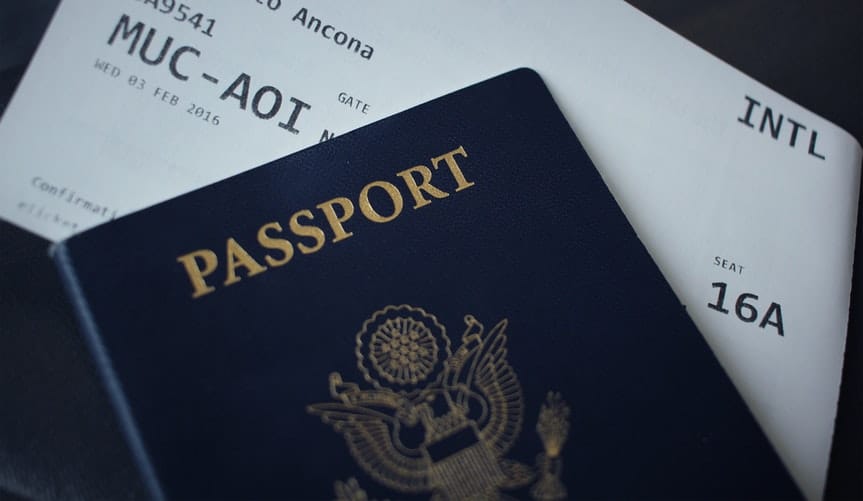
If you’re planning to fly for the first time, you’ll need to produce the necessary documents to travel by plane. Those leaving the country must retain a passport in order to leave the U.S . This means you’ll have to plan much in advance in order to have your passport prepared in time. Some travelers might have passports ready, but realize that the identification has expired. As such, you should make certain that your identification remains usable before flying. Additionally, things like driver’s licenses, plane tickets, and other forms of identification should all be accounted for. You don’t want to leave your house, only to arrive at the airport with a missing ticket. Accordingly, your first time flying will go smoothly if you double-check every necessary travel document.
2. Organize your luggage
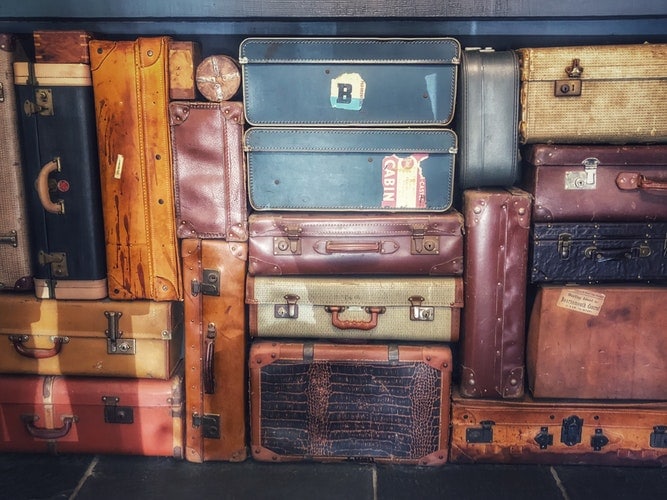
Sometimes, packing bags before going on a journey can be a challenge. You might not know exactly what to bring, especially if you’re visiting a new location. Travelers might pack too much or too little when they have uncertainties about what to bring. Those embarking on their first flights will definitely want to organize luggage properly before arriving at airports. Since every flight has specific regulations about luggage, you’ll need to know how many items you can bring. Don’t overstuff your bags, or else you might have to pay extra in checked luggage fees. At the same time, certain airlines may allow you to bring one checked bag free of charge. Knowing the airline’s rules about luggage will help you organize your belongings according to flight standards.
3. Keep important items close

Since moving through airports can be a stressful activity, travelers should always keep specific items handy. Things like passports, driver’s licenses, credit cards, and plane tickets remain essential belongings when flying. Thus, travelers will want to carry these items in an accessible spot. This will translate to diminished stress, as you won’t have to rifle through belongings to find necessary items. You’ll also be able to get through security and other lines more efficiently. In this manner, your first time flying can be a calm experience if you keep important belongings within reach.
4. Wear comfortable clothing

Flights can be long and uncomfortable. Travelers journeying halfway across the world may have to deal with flights that last for hours and hours. Those boarding flights with limited space might also experience greater levels of discomfort after sitting for short periods. Congruently, travelers should make their first time flying as comfortable as possible by wearing cozy clothing. Consider wearing stretchy, soft clothes, and bringing layers in case you get too cold or hot. Be sure to wear comfortable shoes that come off your feet easily as well.
5. Arrive a few hours early
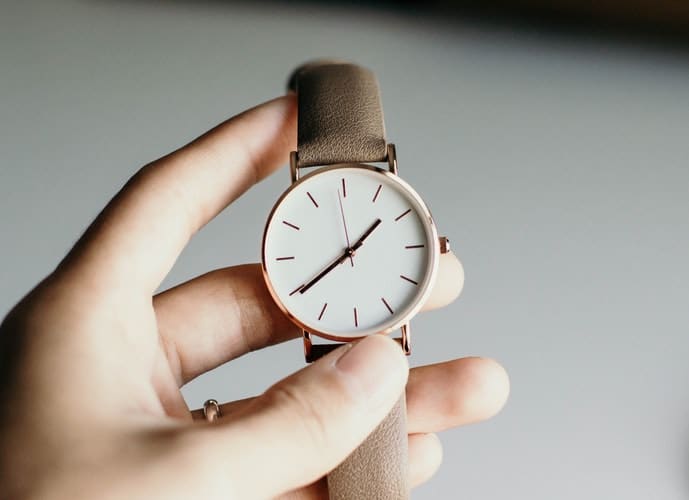
Boarding a flight involves a lot of waiting around and worrying about getting to specific locations on time. Security lines may be lengthy, and delays or changes in departure times can occur randomly. For your first time flying, we recommend arriving at airports at least two hours before your scheduled flight. This ensures you’ll have enough time to get through security and reach your boarding location prior to your departure. In addition, arriving early means you’ll also remain up-to-date on any changes to departure times or locations. You can avoid running through the airport in a flurry by simply arriving earlier.
6. Pack noise-cancelling headphones
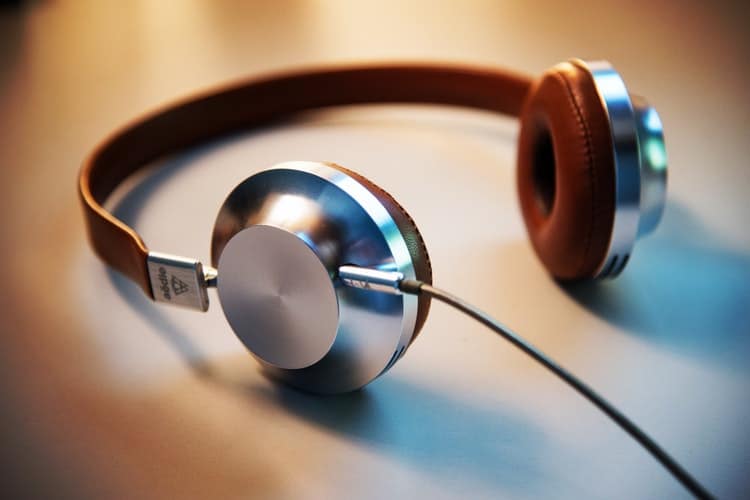
Those who haven’t flown before may not know the kinds of environments they might experience on planes. With many people all in one place, the plane can easily become noisy and overwhelming for some. This can prove frustrating or induce anxiety in those who need to calm down while getting ready to fly. Travelers hoping to accomplish work tasks or sleep may also find the noise disturbing. Planes themselves already produce their own level of noise as well. As such, travelers should definitely bring a pair of top-notch noise-cancelling headphones . If you have these devices, you’ll be able to calm down and accomplish whatever in-flight work goals you might have.
7. Bring some snacks

As mentioned previously, flights may last for many hours depending on your destination. This means that travelers will most likely grow hungry at some point during their journey. If you don’t purchase seats that provide multiple meals to passengers, you’ll have to bring your own sustenance. Even though you might have eaten before flying, you should carry a few snacks just in case. Your first time flying will not be as fun if you’re feeling hungry the entire time. Travelers should also know the kinds of foods airlines allow passengers to bring. Some airlines may not allow specific types of snacks, so be wary of those policies beforehand.
8. Book a specific seat
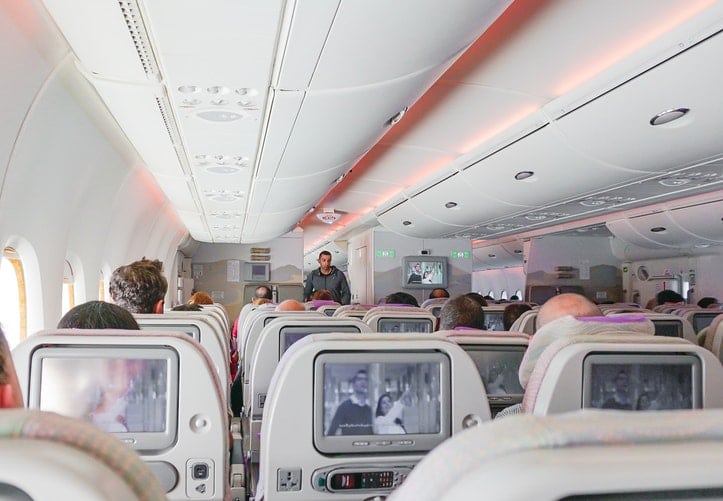
Any travelers with a fear of flying may find it desirable to book a specific seat when buying plane tickets. Some may find aisle seats more comfortable, allowing them to feel secure in the middle of the plane. Others might remain at ease in a window seat, with views of the sky to calm them. A few might just like having control over where they sit, since finding a seat while boarding may be nerve-racking. If any of these scenarios applies to you, consider booking a specific seat before your first time flying. You can eliminate many anxieties about your in-flight experience by simply planning seating arrangements ahead of time.
9. Create a travel itinerary
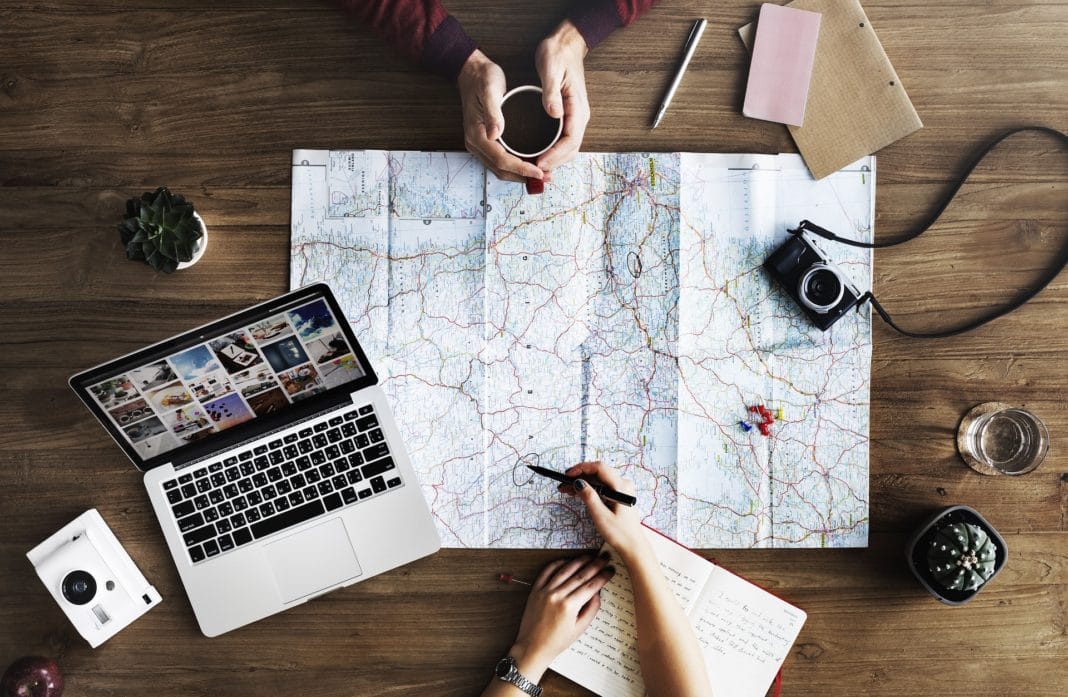
This article previously discussed the difficulties of navigating to and within airports. Since travelers may have never been to a specific airport before, knowing directions to the location remains essential. At the same time, when you arrive at the airport, you might find yourself overwhelmed by layout and various sites. Airports can be extremely confusing to navigate, so creating a travel itinerary prior to arrival will alleviate those confusions. If you know exactly where to go, you won’t have to worry about arriving late anywhere. Your first time flying can be stress-free when you research how to navigate the airport.
10. Remain calm
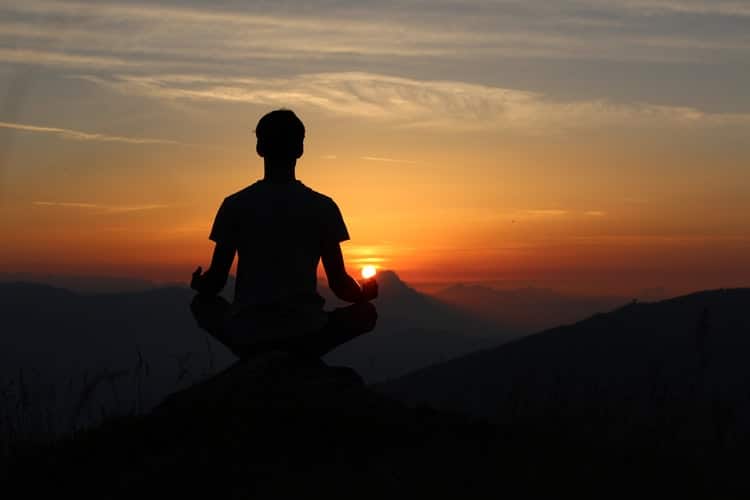
Overall, your first time flying can be an overwhelming experience. Due to long airport security lines, confusing layouts, and noisy environments, you might feel extremely anxious when preparing to fly. Delays and changes in departure locations may cause you stress and worries about making your flight on time. Concerns about the flight itself could even keep you from enjoying your travel experience. However, traveling by plane can be an exciting and rewarding adventure. As such, travelers should remain calm when preparing to take a flight to a new destination. In the end, everything will work itself out, even if things don’t always go according to plan.
Enjoy a worry-free first time flying experience.
When you’re going to journey by plane for the first time, the travel experience can be a little nerve-racking. Most travelers will experience some pre-flight jitters due to the unknowns involved with flying. This can mean that those travelers may not get to enjoy their flights, as they might feel extremely anxious. However, if preparations can be made prior to taking a flight, travelers will feel more at ease when they travel. That’s why we’ve crafted a list of ten tips for first time flying. With our guide, you can learn everything you need to know in order to prepare for a flight. Instead of feeling nervous, travelers will remain calm and collected after learning various flying tips. Book a flight today and start a whole new adventure.
Related Article: 7 Best Earplugs for Sleeping During Your Flight
About The Author
Meghan Ochs
Meghan loves writing in all forms. In her free time, she alternates between reading and daydreaming about publishing her own novels someday. While she’s only visited two countries, she wants to travel around the world, with France and Spain the first sites on her list. Before that happens, though, she plans on adopting at least one dog from a local animal shelter.
Related Posts

Beach Inspector Lets You Customize Your Beach Vacation
August 30, 2023

VIVRE Silk Sleep Mask Review: the Sleep-Deprived Traveler’s New Best Friend
September 9, 2023

How to Hang a Hammock
September 6, 2018

Heads Up: Orbitz’ Legacy Travel Website Likely Hacked
September 10, 2023
Leave a reply Cancel reply
Your email address will not be published. Required fields are marked *
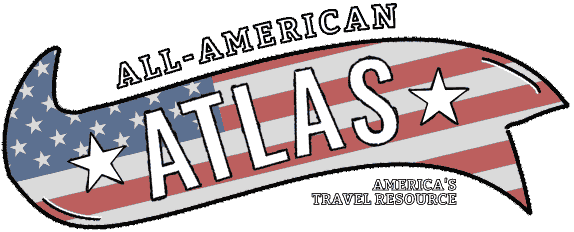
19+ Super Helpful First Time Flying Tips
If you’ve never flown on a plane before and have only done road trips , thinking about it can be both exciting and nervewracking.
You’re not sure what to expect of the process or the actual experience.
But flying is often the key you need to get to faraway places or go traveling further than outside your own bubble.
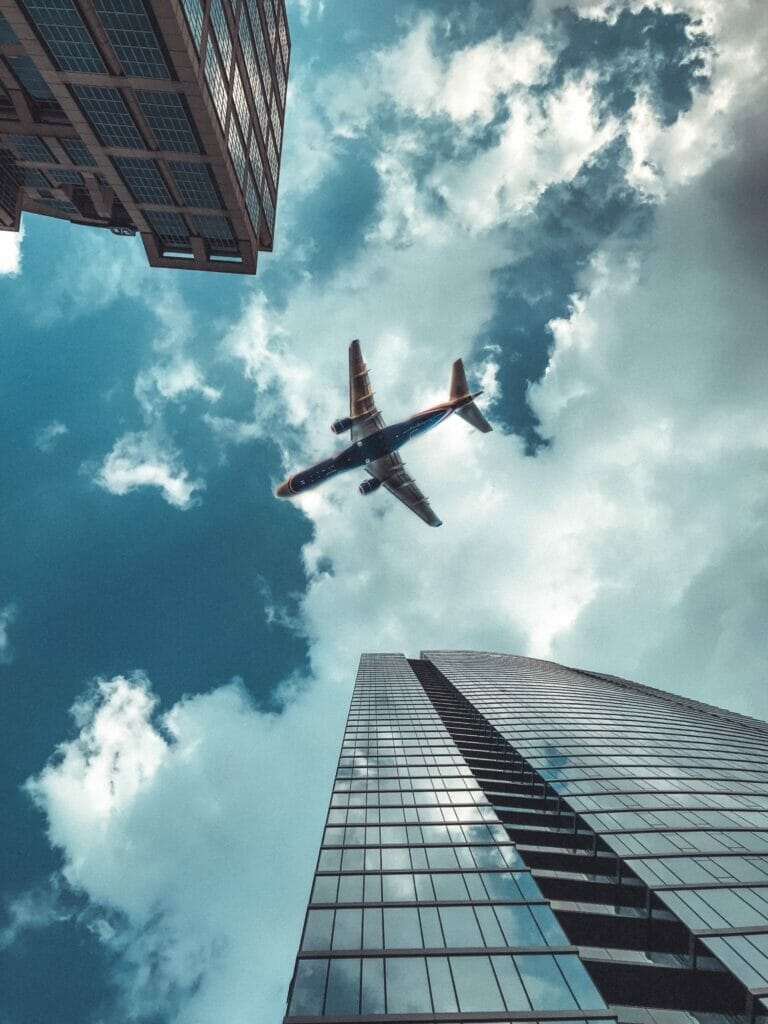
In this list of first time flying tips, we’ll go over what you should do to prepare yourself and what to expect on your first flight.
These differ slightly based on whether it’s a long haul flight or a short hop, but the basics of your first time flying apply to any destination.
First Time Flying Tips Before You Get to the Airport

1. Book a Flight on a Less Crowded Travel Day or Time
If you’re taking your first flight, try to book on a random weekday or at a time that most people wouldn’t be interested in, like an early morning or a late night flight.
This might inconvenience you a bit more when it comes to traveling, but it will probably mean less people on your flight which gives you a bit more space and time to get used to flying without dealing with the chaos of a completely full flight.
2. Pay to Choose Seats if You Think You’ll be Nervous
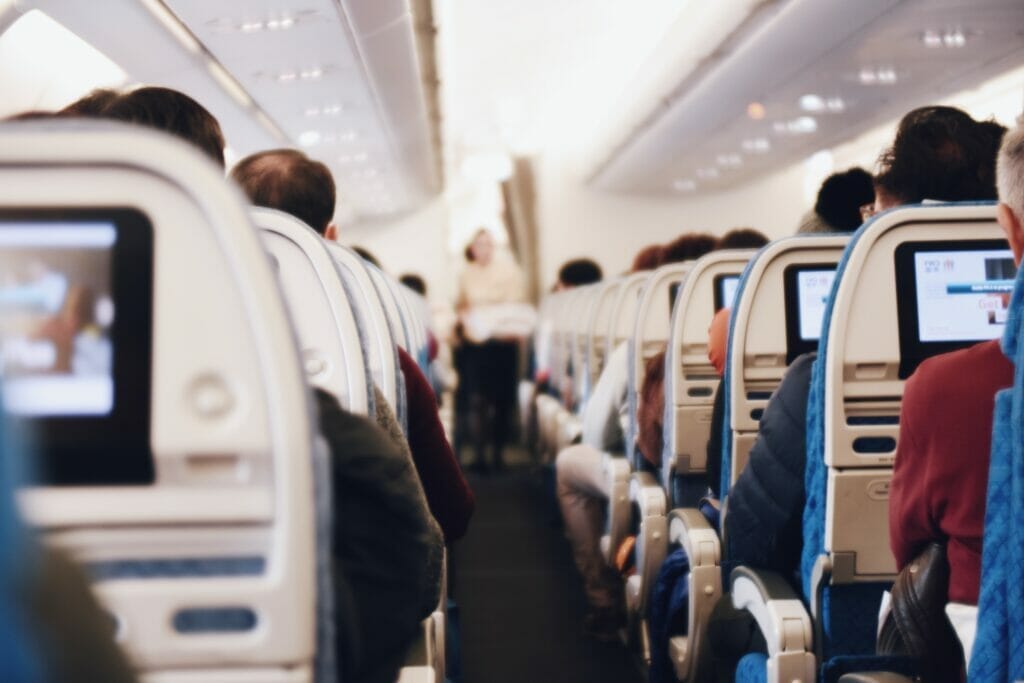
If you feel as though you’ll have anxiety about flying , you don’t want to add to it by not knowing what seats you’ll get.
Paying for your seat choice is often an extra cost in flying nowadays on carriers like Spirit and Frontier , but you should go ahead and pay this if you want things to go as smoothly as possible.
The other thing that can happen if you don’t book seats is that you and the others in your party get split up – it doesn’t happen often, but if it does, you’ll regret it as you’ll want to be with your people!
This is especially important for families traveling with small children; you’ll definitely want to make sure you and your kids get seated together!
Note: As we mention in this Southwest airlines review , you cannot choose your seat ahead of time on Southwest. All you can do is try to get a high boarding number so you have first choice when boarding. This might impact your choice of airline if this makes you anxious.
3. Make Sure to Read All Rules About Baggage

Luggage requirements are always changing among airlines, and they’re not always consistent between connecting flights – especially if you’re taking a domestic flight and connecting to an international flight.
Be sure you have read and printed out all of the information about your baggage allowance before packing or getting to the airport.
You should always plan on the safe side, so consider buying a scale to weigh your luggage at home so you don’t have to ditch anything in the trash in the airport.
And make sure you’re aware of the actual size of the bags you’re allowed to bring!
Often, there is a weight restriction for carry-on bags as well, so be sure to check this.
This tends to be a carry-on that can go on most airlines without an extra charge.
4. Note Check-In Rules to Find Out When and How to Check-In
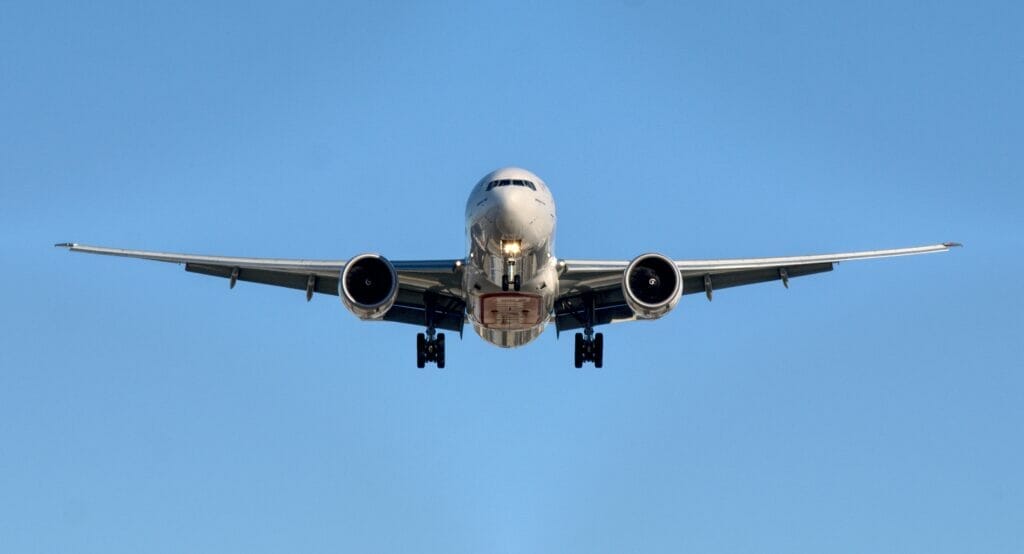
Some airlines require you to check-in online beforehand or you pay an extra fee – this is particularly true for budget airlines like Spirit airlines .
Others offer apps for mobile check-in, or checking in at a kiosk or counter once you get to the airport.
Find out the rules for our airline, and also make sure to see when you can check-in.
Most airlines allow you to check in 24 hours in advance, and we recommend doing it as close to that point as possible.
This way, you’ll have one less thing to worry about when you get to the airport!
5. Leave Yourself an Hour Extra than the Recommended Airport Arrival Time

When it comes time to get to the airport, take the amount of time the airline says to arrive at the airport early, and then go ahead and add an hour to that.
So if it’s a domestic flight and they say to be there 2 hours before takeoff, add an extra hour.
If it’s 3 hours for an international flight, make it 4 hours.
If it’s your very first flight, which is probably is if you’re reading these first time flying tips, then you’re going to want to give yourself as much time as possible to get through security and get to your gate in a relaxed way as you start to learn how the process works.
If you get there and locate your gate and realize you’ve got a ton of free time, check out the shopping and dining options at the airport, or plan on bringing a book to read!
What to Expect for your First Time Flying at the Airport
6. watch what the people in security ahead of you are doing.

Going through security is one of the most stressful things for many people at the airport, even if they’re a frequent flyer.
The rules seem to change frequently and vary based on each airport and their scanning equipment.
You don’t always have to take your shoes off now, and sometimes they ask you to take your food/laptop/electronics out of your bags, while other times you can keep them in.
As you weave your way through the security line, keep an eye on what’s happening in front of you with security and what the security workers are asking of passengers – if you see everyone taking their shoes off, plan to take yours off, too.
Whatever you can do to be alert and be aware of what’s expected of you will make it much easier.
You can also prepare in advance by already having your electronics in a separate bag in case you do need to take them out of your luggage.
If you’re traveling with medication, be sure to have any necessary notes from your doctor in case security needs proof of your prescription.
7. Keep Your Passport/License and Boarding Pass Handy at All Times
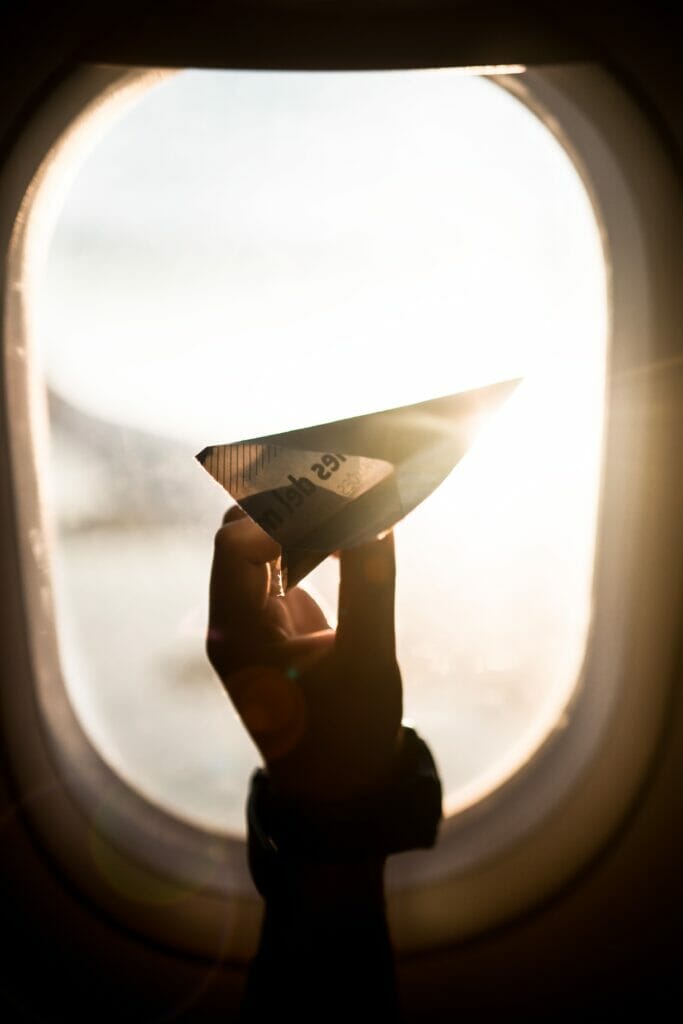
You’ll need your passport or license and boarding pass when you go through security, as well as when you drop off luggage if you have any to be checked in, and again at the gate when boarding.
Make sure that you have a special compartment for these items so you’re not digging through your bags every time you need them.
Getting a passport holder like this is a great idea.
8. Don’t Get Fancy With Your Clothes
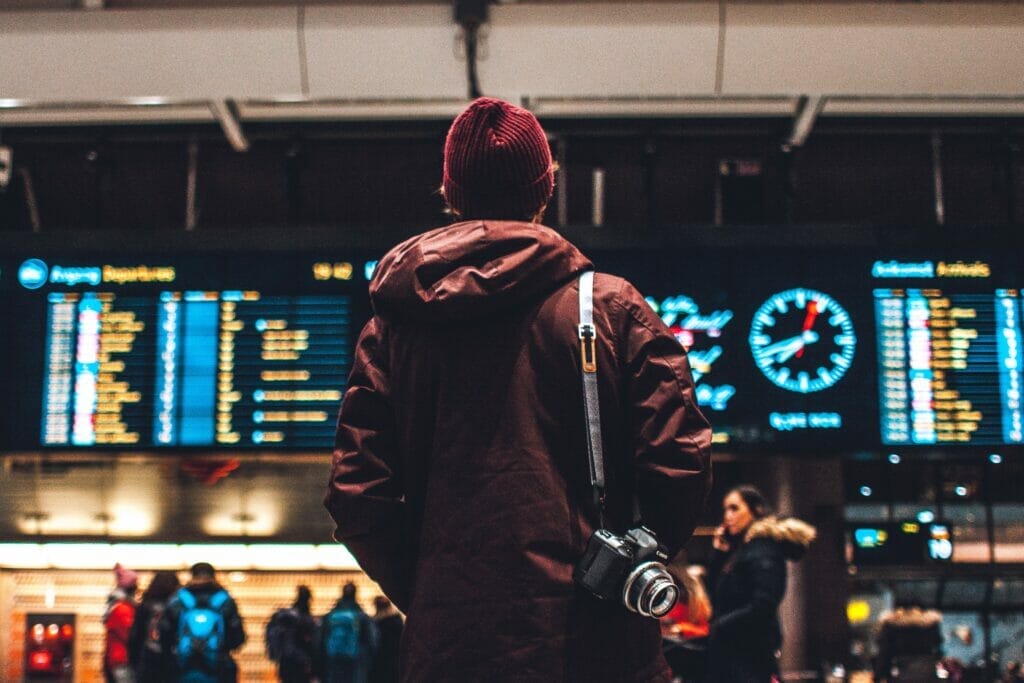
While some people might want to already be dressed for their destination when arriving at an airport, most travelers these days have prioritized comfort over fashion.
You don’t want to have to unbuckle 86 things to get your shoes off for security, or be constrained by really tight jeans while sitting in your tiny seat for hours.
You can feel put together and wear what makes you feel confident about yourself, but try to go for clothes that don’t have too many bells and whistles involved.
Simple is better.
9. Go Directly to Your Gate When You Get to the Airport
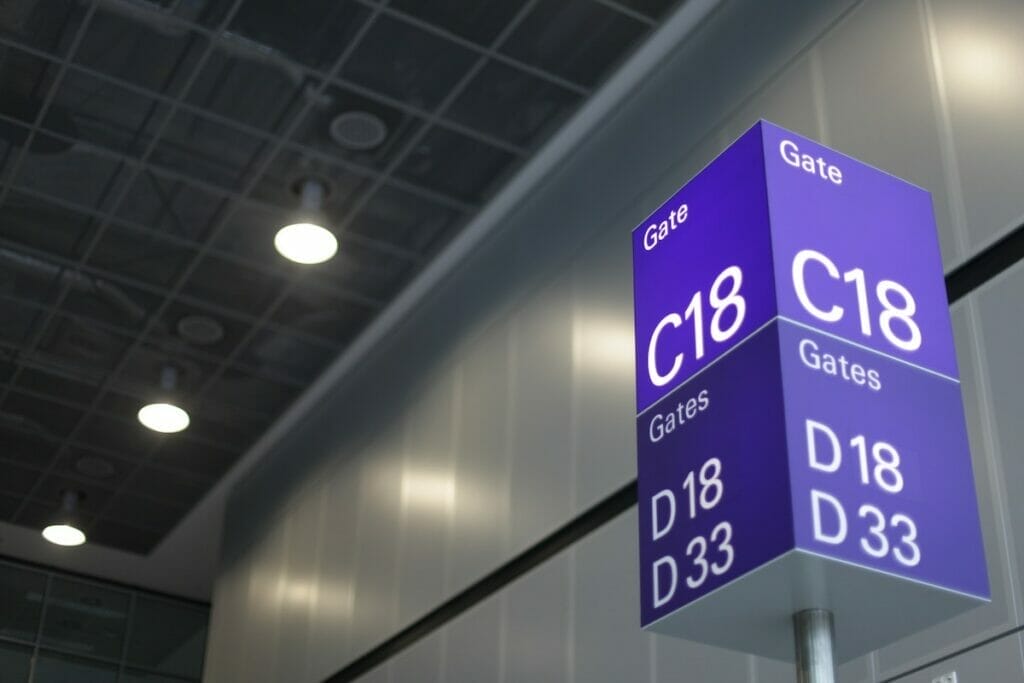
We recommend always going directly to your gate once you get through security, even if you’re really early.
This ensures that you’ll know where you need to be when it comes time to board.
If it’s completely empty and no one is at the desk, you know that you have quite a bit of time to kill before you need to go back and get ready.
Sometimes, they may even still be boarding from another flight that’s using the gate before your flight!
If it’s not too busy, feel free to approach the desk or counter and ask what time you should be prepared to board.
Then, you can set out to explore the rest of the airport for a little while – just be sure not to wander too far or lose track of time!
But if there’s a flurry of activity, you may want to find a spot to sit and see what’s going on before going off to the bathroom or to get food.
For example, sometimes there may be an issue with limited room for carry-on bags, and the flight attendants might be asking people to volunteer to check their luggage in order to ensure space.
10. Prepare for Airport Food Prices and Pack Your Own
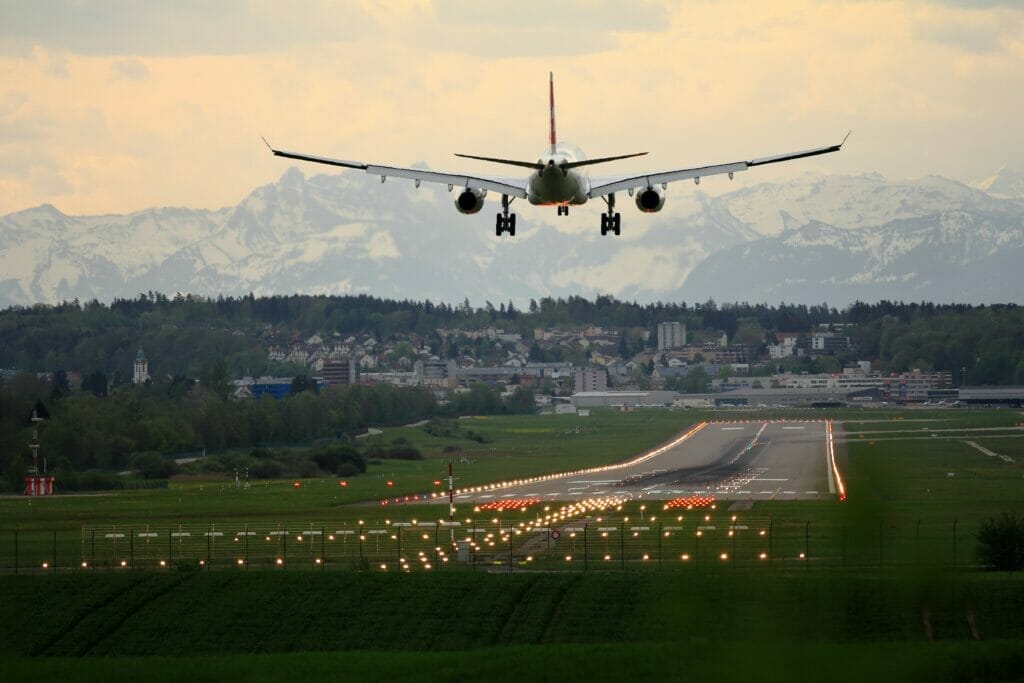
Airport food is incredibly expensive with such a captive audience, and in-flight meals aren’t exactly known for being particularly impressive.
You can pack your own food in a fun bento box like this and take it through security with you.
This is a great idea if you want to have something familiar and affordable to eat while at the airport or on the flight (as opposed to a $10 bottle of water).
11. Go to the Bathroom Right Before Boarding

When they start to call boarding groups, unless you are someone who needs to be pre-boarded (like a family with young kids, or someone with a mental or physical condition that means you need to be on the plane first), you’ve got some time before your boarding group will be called.
This is an opportunity to quickly go to the bathroom before your boarding group is called, as there’s nothing worse than needing to go during take-off when you’re not allowed!
First Time Flying Tips for the Flight and Arrival
12. tell the flight attendant you’re nervous if you are.
If you’re nervous about your first time flying, tell a flight attendant!
This is such second nature for them, and they see new flyers all the time.
If they have a moment, they’re usually happy to chat through any fears with you and reassure you about how long they’ve been flying and how normal it is.
They might also check on you during the flight to see how you’re doing.
13. Wait for Your Boarding Group to Be Called and Go Directly to Your Seat
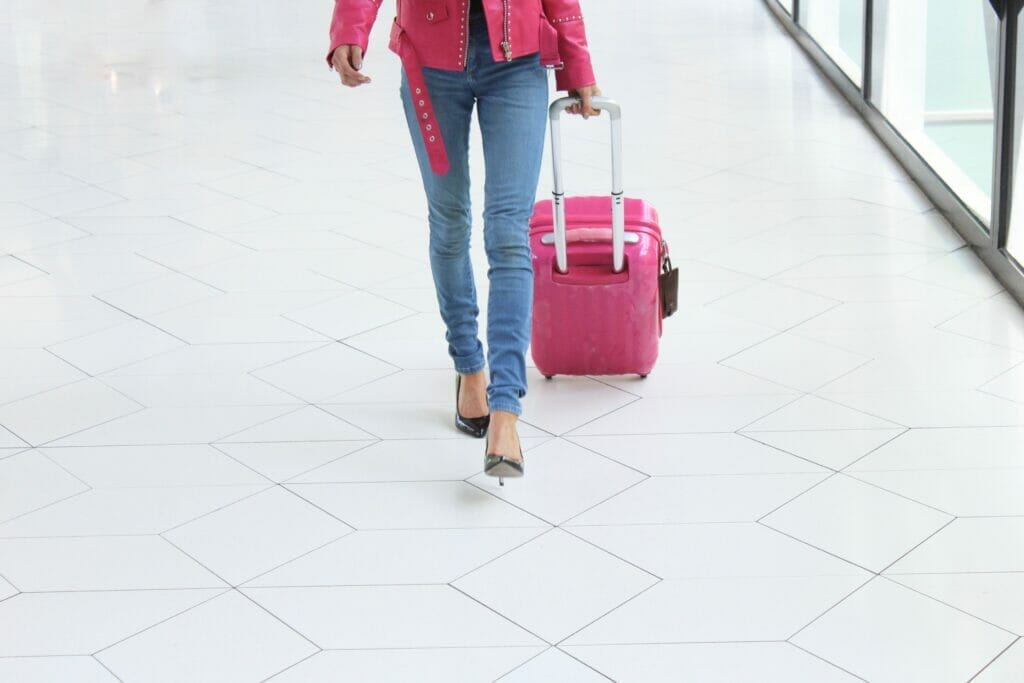
There is a term for people who hang around the gate waiting for their boarding group to be called, and it’s “gate lice”.
You don’t need to be one of them, especially early in the boarding process.
Wait until your boarding group is called, then get in line and proceed onto the plane.
When on the plane, find your seat and stow your luggage in the overhead bin if you have any that can’t go under the seat in front of you, and sit down.
The quicker people sit down, the less there will be a chance of delays with the take-off.
14. Try to Use the Overhead Bin Above Your Own Seat
If you have luggage that needs to go in the overhead bin above your head, do so as close to your seat as possible, if not directly above it.
You don’t want to be putting your luggage to any old bin you can find, as that’s not the proper plane etiquette.
If you have problems finding space for your luggage, don’t panic!
Ask a flight attendant where there might be room, as they are usually monitoring these things to help you out.
Sometimes, they might need you to store your carry-ons further away from your seat – just remember what section of the plane they’re on and don’t forget them when the flight is over!
15. Prepare to Put Your Electronics Away when Requested
At a certain point before take-off, you’ll be instructed to put certain electronics away and switch your phone to airplane mode .
This is for safety, because the signals from your phone can potentially interfere with the plane’s navigation and other important systems.
The plane can not take off if the pilots hear from the flight attendants that people are not following these rules!
We recommend finishing up any texts or emails at the gate, and going into airplane mode while you’re still in line for boarding.
16. Understand the Noises You’ll Hear in Flight
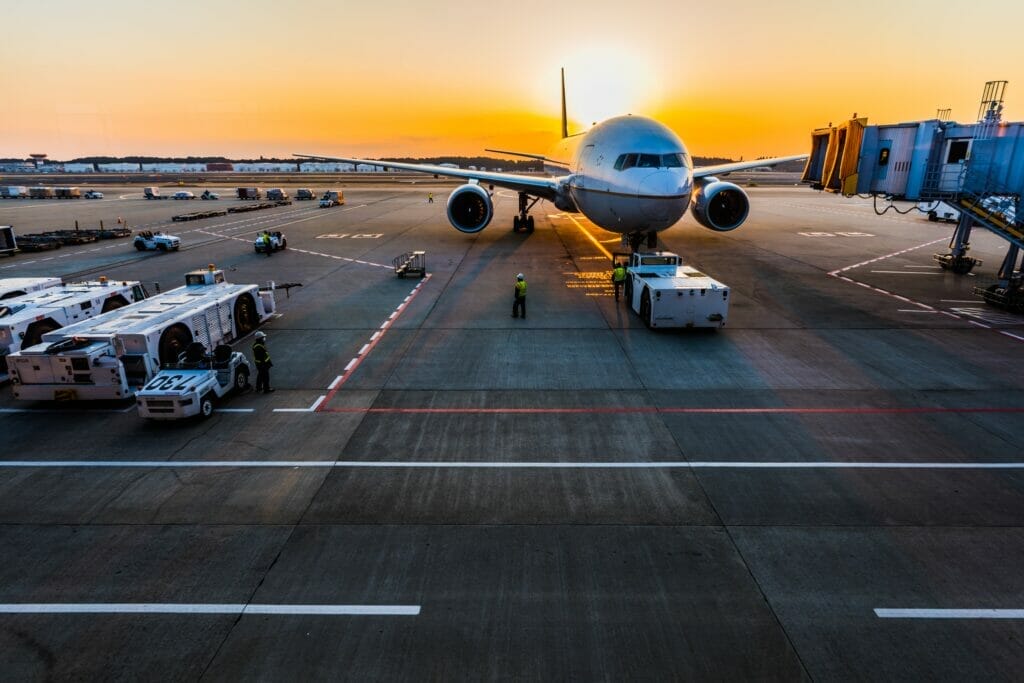
Planes make some funny noises while in flight that are completely normal, but might sound alarming to those of us who are usually on the ground!
This could be anything from the sound of the engines, to the wing flaps and slats, to the wheels going up and down.
If you anticipate being nervous about noises during the flight, make sure to bring ear plugs or some headphones to play your favorite music through.
You can also watch YouTube videos about planes ahead of time that take you through these noises so you know what to expect.
17. Leave Your Phone Charger Out if You’re Using it in Flight
Some flights, especially those used for international travel, have USB outlets in the backs of the seats for charging.
This is essential if you’re going to use your phone during the flight to play music, games, podcasts, or take notes on or take pictures with.
Don’t pack your charger too far into your luggage or in your checked bag, as you’ll want to be able to use it to charge your phone during the flight!
18. Don’t Be Afraid of Turbulence
Turbulence is one of the most natural parts of flying, and can often feel like brief bumps in the road or full out shaking depending on what type of turbulence you’re flying through.
Familiarize yourself with why it happens and what it is so it doesn’t take you by surprise.
Some flights will be incredibly calm, while others may have you shaking the entire 10-hour flight.
Pilots won’t keep you in situations that are unsafe, and they have so many ways of forecasting turbulence and flying around it if possible, so put your trust in the people up front who also really want to get to your destination and don’t be worried by turbulence!
19. Have the Phone Number of Your Ride Written Down for When You Arrive
You’ve done it!
You’ve arrived!
When you’re exiting the plane into the airport, the next steps will be to figure out how you’re getting home or to your hotel or friend’s house.
And if your phone did run out of battery during the flight, you’re going to be thankful you’ve written down either your friends phone number or the instructions on how to take public transportation to get where you needed to go.
Get the All-American Travel Secrets!
Don't miss out on America's hidden gems!
I agree to receive email updates and promotions.
About The Author
Leave a Comment Cancel Reply
You must be logged in to post a comment.
- Affiliate Notices
- Privacy Policy
- Work with Us
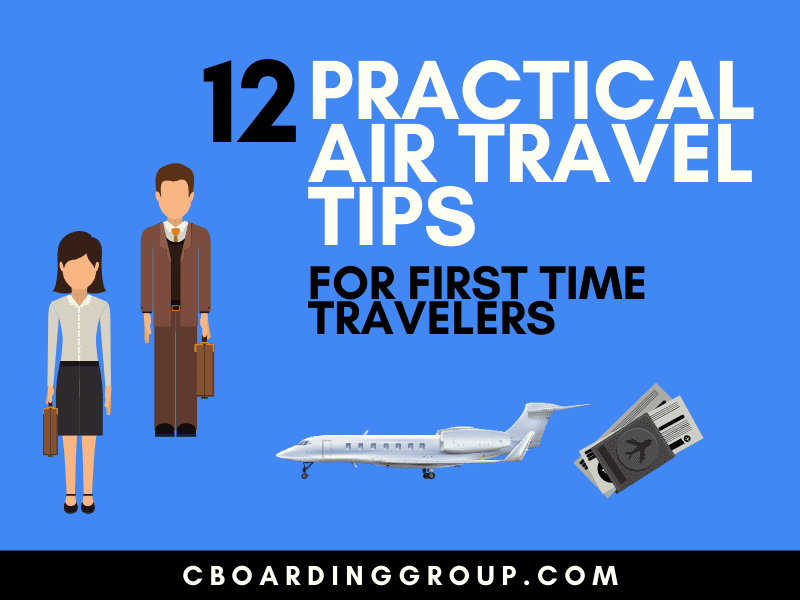
12 Practical Air Travel Tips for First Time Travelers
Here are 12 Practical Air Travel Tips that first time travelers ought to know. After learning these tips, you can set your mind at ease because you will be far more prepared for your first trip.
Air Travel Tips for the First Time Traveler
It’s perfectly normal for first time travelers to feel a little uncomfortable about their first trip. However, with the brilliant and practical air travel tips provided here you can put those concerns aside and focus on enjoying that first trip instead of stressing out about it.
Before we dive into the details of these practical air travel trips here’s a quick summary:
- Give yourself plenty of time
- Don’t over pack
- Learn the check in, seat assignment and boarding process for your flight
- Get your boarding pass before you get to the airport
- Figure out your parking situation
- Learn the TSA Security Rules
- Charge everything before you get on the plane
- Eat before you get on the plane
- Stow your bag near your seat
- Bring something to do on the plane
- Follow good airplane travel etiquette
- Don’t stress out
Ok, let’s get into the details!
Air Travel Tip #1: Give yourself plenty of time
A critical air travel tip to use for your first trip is to make sure you give yourself plenty of time.
As a rookie traveler you are going to be a little slower than a travel pro so you need to give yourself a little more time. A travel pro can show up around and hour before their flight (even shorter at some cases). Conventional wisdom suggests you give yourself about an hour and a half.
But, for your first trip – give yourself two hours. yeah, it’s probably overkill, but better safe than sorry. For more tips on how early to get to the airport check out our entire guide here .
As you get more proficient at traveling you will start to dial in a time frame that fits your rhythm and “travel skills.”
Air Travel Tip #2: Don’t over pack (and don’t check your bag!)
The second air travel tip might be hard one to follow, but it’s critical: fight the urge to over pack .
First time travelers often want to bring more than they ought to. It’s normal, but it’s also a total rookie move.
The cold hard facts are that you really do not need as much you think you do! Traveling light is key. Just bring the minimum and remember things like you get toiletries in your hotel room so limit those too (don’t bring shampoo or conditioner – the hotels give you that).
Moreover, never check your bag. Always pack light enough to be able to use a carry on. This gives you flexibility and helps you travel a little faster.
Pro Air Travel Tip : Get yourself a great piece of luggage (like the TravelPro Crew 11 21″ ). Listen, if this is your first trip and you are not going to have too many more trips in the near future, then get something more affordable. But, if this is going to be a regular occurrence (e.g. you took a job that has regular business travel) then spend the time to get yourself a great piece of luggage. You can read our review of the TravelPro Crew 11 21″ here .
Air Travel Tip #3: Learn the check in, seat assignment & boarding process for your flight
Each airline has a different process for seat assignment, check in and boarding process. Depending on the class of ticket you purchase you may be able to select your seat assignment. But, in some cases you can’t – and you have to select it at check in or when you actually board the plane (like Southwest Airlines).
Learn the process for all of this for your airline and adjust your behavior accordingly. For example, with Southwest Airlines you gotta check in 24 hours before and depending on your status and how close to that 24 hour window you check in determines you boarding group (A, B or C). The boarding group will often be the difference between getting a good seat and getting a middle seat .
Here’s a few examples for you:
- Learn the Southwest process here .
- Learn the Delta process here .
- Learn the United process here .
Make sure you learn this process for your airline!
Air Travel Tip #4: Get your boarding pass before you get to the airport
Unless you like standing in lines and wasting time, print out your boarding pass before you arrive at the airport. Better yet, download it to your mobile phone.

If you do find yourself needing to get it at the airport make sure to use a kiosk. Skip the lines and find a kiosk – it’s much quicker. And, if you aren’t checking a bag (which shouldn’t be!) you can save yourself even more time.
Figure out your parking situation (Air Travel Tips #5)
Surprisingly, parking your car can sometimes be a debacle at certain airports. You may have to park well off airport property or pay a significant amount of money to park it on property. This means you are riding a shuttle to/from the airport – again adding time. Try to get a bead on how and where you are going to park your car on your first trip. Or, if you can, take a taxi or Uber.
Pro air travel tip: If you do take a parking shuttle, bring a few bucks to tip the shuttle driver. 2 bucks for a small bag, 5 bucks for a big bag. Only tip if they actually load and unload your bag
Air Travel Tip #6: Learn the TSA Security Rules
Airport security can be a little disorienting your first time through. Make sure you read up on what you are allowed to take and not take through and how you are supposed to take it through.
For example, no liquids or gels greater than 3 oz, (like water, toothpaste, shampoo and the like).
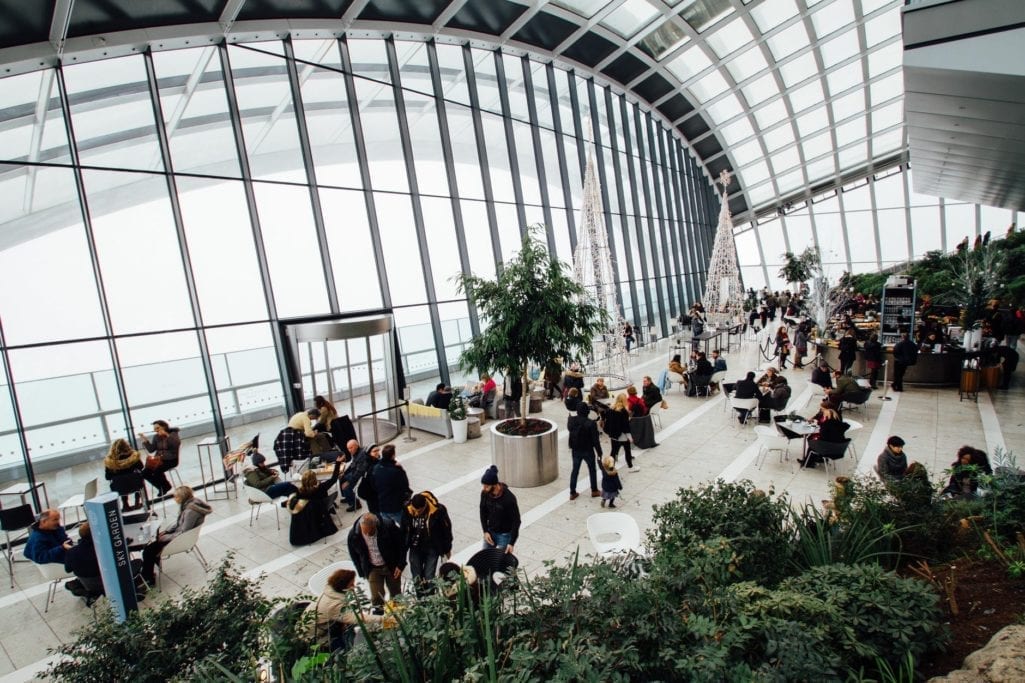
You will have to take your shoes and coat off and remove your larger electronics (like laptops and tablets) from their bags.
The more ready you are for this the easier it will go and less likely you get pulled for secondary screening (which slows you down) and/or fumble around with your stuff like a newb.
You can read all of the TSA requirements here .
If you have time, try to get TSA Precheck . If your trip is international sign up for Global Entry . Both of these services speed up your security processing time making it a little easier to get in and out of the airport or country by going through a background check. Definitely worth the money.
Charge everything before you get on the plane (Air Travel Tips #7)
Always be charging! This is a critical air travel tip unless you enjoy your phone sputtering out somewhere over Kansas in the middle of your fourth episode of Game of Thrones.
Charge whenever you can! Better yet, buy a portable charger to bring with you for backup. I personally recommend the Anker PowerCore 20100 . You can read my review of it here .
Number 8: Eat before you get on the plane
For a shorter flight this is less important, but for longer flights it’s wise to eat before you get on the plane. Most domestic flights no longer serve meals unless you are upgraded to first class and you happen to cross a meal time while in flight.

Some airlines will sell you a boxed meal – but it’s usually pretty expensive. Instead, eat before you get on the plane and perhaps bring a few snacks (no hot food though! We don’t want to smell your stinky pizza!).
You might be interested in 9 Healthy Travel Snacks
Stow your bag near your seat (Air Travel Tips #9)
A rookie mistake I often see newb travels make is stowing their bags nowhere near their actual seat. Or worse, stowing it BEHIND their seat. Never do that!
If you stow your bags behind your seat you are going to be swimming upstream when you deplane – which sucks. More likely you will just be sitting in your seat waiting for enough people to deplane so you can get to your bag.
If the plane happens to be pretty full when you board, stow your bag IN FRONT of your seat in the first available bin you find. Make a mental note of what bin it was stored in so you can find it on the way out.
Number 10: Bring Something to do on the Plane
Flights can be a whole lot of boring! Make sure you bring something to do for you flight. A book, maybe download a few movies. Make sure you get some good headphones too – and a backup pair (wired, preferably) .
Follow good airplane travel etiquette (Air Travel tip #11)
When you are actually on the plane make sure you employ good travel etiquette. Things like not bringing stinky food on the plane, letting the middle seat passenger have the armrests, not listening to your music without headphones and more. Proper airline behavior is always a good thing to learn and will not only make your trip go a little easier, but it will make sure you don’t earn the ire of your fellow passengers of the airline crew.
For more air travel tips on Airplane Etiquette make sure to read our entire article: Airplane Etiquette: The Unwritten Rules for Traveling on a Plane .
Final Tip: Don’t Stress Out!
The final piece of advice we have for you in this collection of air travel tips is both simple and difficult, but incredibly important: don’t lose your crap! Regular travelers know that you win some and lose some when traveling. Sometimes the flight is delayed. Sometimes it’s early. Sometimes you get the upgrade, sometimes you get the middle seat.
You gotta just roll with it . Don’t stress out. It ain’t worth it.
Final Thoughts on the Best Dang Air Travel Tips
We hope you liked this list of practical air travel tips for the first time traveler. If you liked this content, please do us a favor share it on social media and click the “like” button below and don’t forget to follow us on social media including Twitter , Instagram , Pinterest and Facebook .
And, of course, if you are interested in more travel tips and travel advice and product reviews, you might like these great articles:
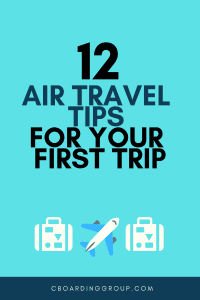
Affiliate Disclosure: As an Amazon Associate I earn from qualifying purchases. I may also earn commissions from other affiliate programs as applicable.
Jeremy Ballou is the editor of the CBoardingGroup.com and a long-time writer in both the travel and tech industry. Most days he's in thinking about travel or writing about it.
Plan a Krakow Day Trip – what to see in Krakow in one day!
3 travel items i never go anywhere without (and you probably don’t either), you may also like, demon dentist freaks out and removes clothes at..., five days in slovenia: a guide to the..., can i fly with an expired license, what is a redress number and do i..., how to make your bed like a hotel..., how to stop your ears from hurting on..., the traveler’s first aid kit: how savvy business..., 11 tips on traveling with your boss –..., 23 jobs with travel: the ultimate list of..., deal alert: rockland wheeled underseat carry-on 72% off, leave a comment cancel reply.
Save my name, email, and website in this browser for the next time I comment.
First Time Flying Tips: How to Calm Your Nerves
Published by allison weed on june 17, 2021 june 17, 2021.
Flying for the first time can be frightening, especially if you’re traveling by yourself. Making sure you feel comfortable and excited for your trip is really important. We’ve compiled a list of various ways to calm your nerves before you get on the plane so when you get to your destination, you’re ready to start exploring !
1. Arrive to the airport early so you don’t feel rushed
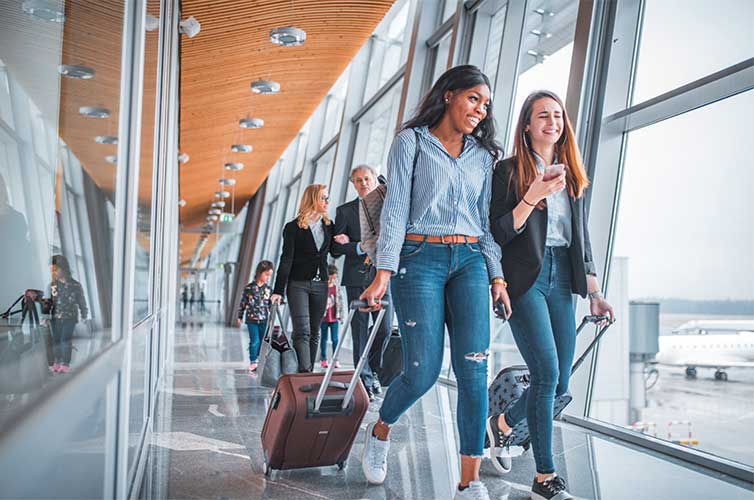
Give yourself some extra time before you’re scheduled to leave—you don’t want to miss your flight! Arriving at the airport early will give you some extra time to check your luggage and go through security without having to rush. We recommend arriving at least two hours in advance for domestic flights and three hours in advance for international flights. If you need to provide documentation for your destination, such as Covid tests or visas, allow extra time for your documents to be checked and verified.
By arriving early, you’ll have time to fix anything that doesn’t go according to plan without missing your flight. Plus you can grab some pretzels and water and chill at your gate for a bit before you have to board. There’s no reason to have to run across the airport like in Home Alone!
2. Prepare for motion sickness (just in case)

If you’re nervous about motion sickness, think about dropping by your local drugstore and picking up some travel motion sickness wristbands before your trip. These cloth bands are safe, reusable and work by applying pressure to an acupressure point on each wrist. They may also give you some peace of mind when you’re in the air just to know that you have them with you. If you need something a bit stronger, Dramamine works for many people—just make sure to take the non-drowsy version if you don’t want to be super sleepy for the rest of the day!
3. Only drink water before your flight

This means no alcoholic beverages or even sugary drinks like soda. Coffee is also a no-no. While you might assume they’ll help you calm down, these kinds of drinks might make you even more hyper and jittery before your flight. The best thing to do is stick to water so you stay hydrated. The air on airplanes can be quite dry, so it’s easy to get dehydrated, especially on long flights. If it is a long flight, you also want to stay hydrated without having to constantly be in the bathroom (airplane bathrooms are so tiny).
If you’re flying for the first time, you want to be completely yourself. That means no drinking in the airport bar beforehand and if you’re taking an international flight—where alcoholic drinks are usually free—don’t be tempted. You will feel much better on the plane and once you get off.
4. Pay attention to the safety instructions before takeoff

Once you get on the flight, find your seat and fasten your seat belt, take some time to review the safety brochures in front of you. This may set your mind at ease so you feel prepared in case something were to happen. If you are deathly afraid of flying, it might help you to know that you are far more likely to get struck by lightening or get attacked by a shark than you are to die in a plane crash. Even so, being prepared will help you feel a lot better. You should also listen to the flight attendants as they go over safety instructions as well.
5. Make yourself feel at home
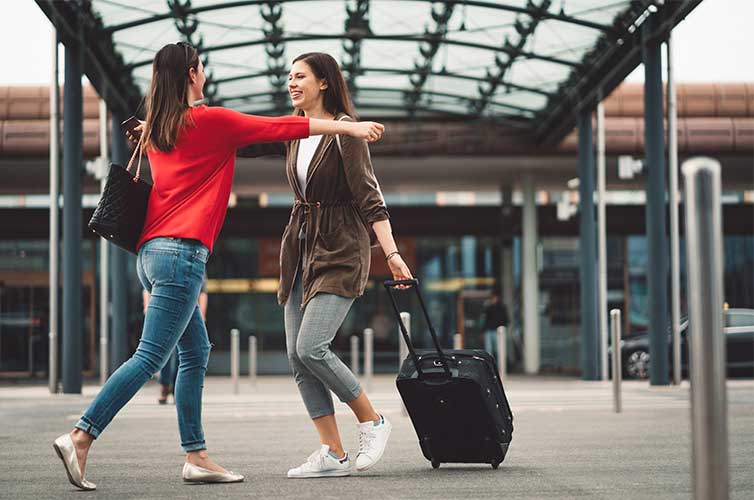
This may sound difficult when you’re traveling thousands of feet in the air with only one carry-on and a seat to yourself. It’s much easier than you think! Make a packing list before you leave your house with all of the things that will make you feel more comfortable while you’re in the air. Some common things to bring are headphones, your favorite snacks, a neck pillow, a sweatshirt (planes are often very cold!) and a good book!
6. If possible, travel with a friend

Although you may not always be flying with someone, it may be a good idea to have someone with you the first time you fly. Whether it’s a friend or family member, you’ll feel comfort in knowing that you’re not alone. That way, you can also try and swap seats if you’re more comfortable with a window seat or an aisle seat. If you’re traveling solo , it’s usually pretty easy to make friends with someone sitting near you on the plane and you can always let the flight attendants know you’re a bit nervous to fly. Being able to rely on someone in the air will set your mind at ease.
7. Bring chewing gum
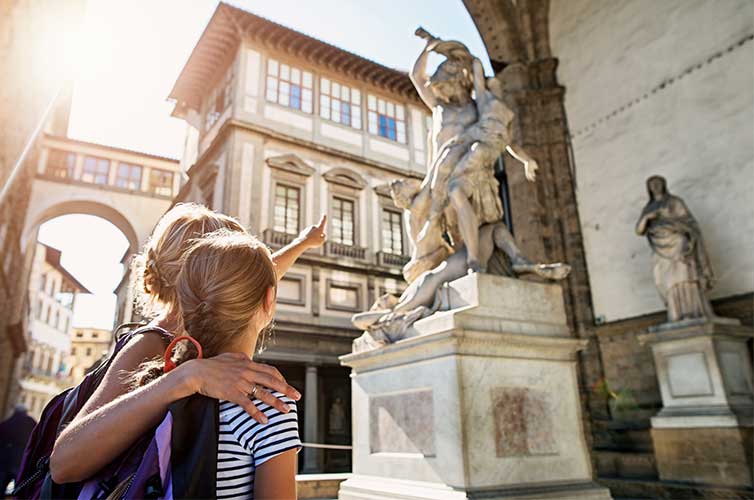
Sometimes when the plane’s landing, your ears can pop because of the change in air pressure. If you’re not used to this, it can be uncomfortable. A helpful tip when flying is to bring chewing gum. Being able to move your jaw releases the pressure from your ears. If you don’t have gum, you can try yawning or swallowing.
8. Pack ginger candy or ask for ginger ale
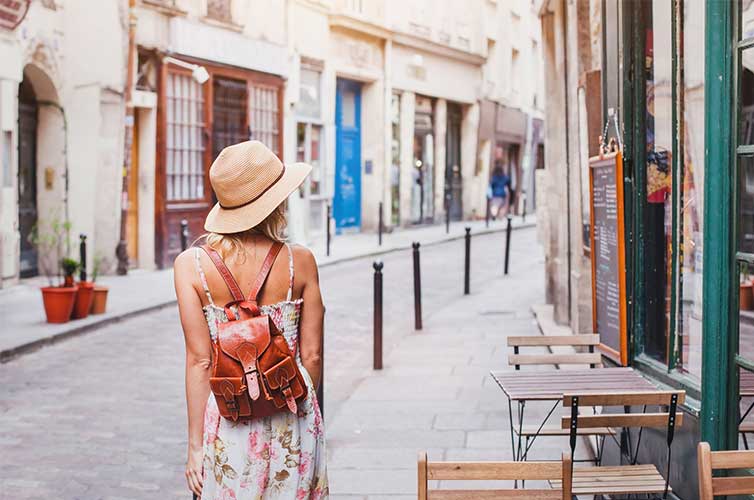
If you start to feel sick during the flight because of turbulence, feel free to call a flight attendant over and ask for some ginger ale. Ginger has a soothing effect on stomachs, so people tend to drink it when they’re feeling sick or if there is a lot of turbulence on the plane. You can also find ginger candies at your local store. They might even have them at a newsstand in the airport.
9. Sit near an exit to calm your nerves
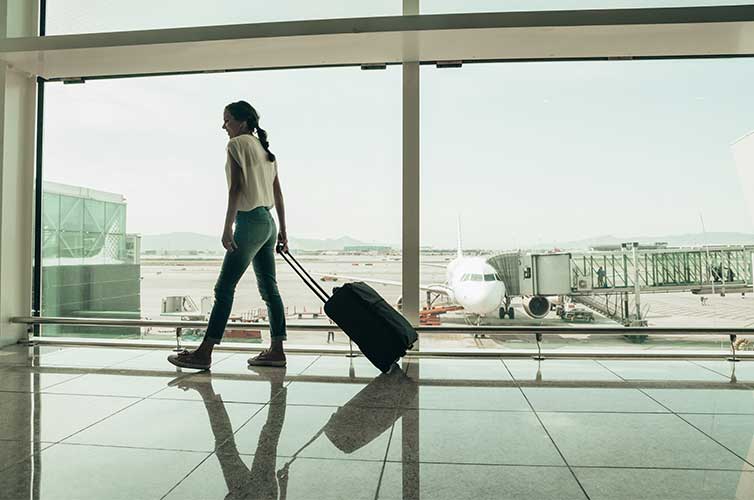
If you’re very nervous about flying for the first time, it may calm your nerves to be close to an exit. It depends on which airline you’re flying on, but certain airlines allow you to pick your seat before boarding. See if you log on to the airline’s website with your reservation number and view a seat map to select your seat. Even being a couple rows back from the exit may help put your mind at ease. If the airline lets you pick your seat as you’re boarding, try sitting within a short distance of the emergency exit.
10. Breathe

Traveling can be nerve-wracking at times, but if you take some deep breaths and picture yourself at your destination, you will feel way calmer. Before you know it, you’ll have landed and will be all set to explore. Flying for the first time can be scary, but with these tips you’ll hopefully feel a lot better as you embark on your journey!
Ready to book your flight? Check out our current flight deals , or sign up for our emails and get notified the next time we’re having a sale or releasing new promo codes!
Related Posts
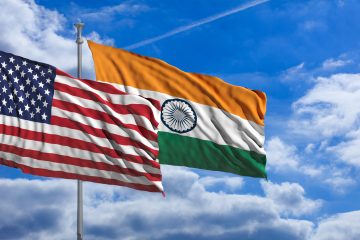
International Travel
Comprehensive visa application guide for indian students.
Our guide for Indian students thinking about studying in the US. From visa types to the whole visa application process, resources, and more: learn it all right here.

Traveling to Europe in summer: When to book those flights
Summer is Europe's busy season meaning it can get pricey. And 2024's summer has some extra reasons it will get pricer if you keep waiting on booking those flights.

Spring Break
Alternative spring break destinations for 2024: where you actually want to go.
Forget about all those stereotypical spring break destinations. Think more creatively and have a memorable experience in one of these places.

Mistakes Everyone Makes When Flying On An Airplane
W e've all made mistakes when flying on an airplane. Despite your best-laid plans, something goes wrong, whether it's your fault or beyond your control. While you can't always change the outcome of an unpleasant travel situation, you can manage the hurdle better by being prepared for it — by being aware that the hurdle might trip you up in the first place, and therefore equipping yourself with the tools and/or mindset to avoid it.
Whether you seldom fly on an airplane or you're a frequent flyer, we're here to hype you up for your flight and help your journey go as smoothly as possible. By avoiding these mistakes, you'll be ready to pack your luggage correctly, navigate the airport stress-free, and enjoy yourself onboard the plane like a pro. From this point forward, that "fasten seatbelt" light is on because we're going skyward. If you can avoid the following common mistakes, you can help ensure a less turbulent flight experience.
Read more: 18 Best Ways To Help You Get Through Airport Security Faster
Waiting Until The Last Minute To Book A Flight
There's nothing like that crummy feeling of knowing you could have saved a significant amount of money if you had been a little more on top of your planning. If you have the foresight to know you'll be taking a trip a few months ahead of time, flight prices are likely to be cheaper the earlier you purchase. Sometimes trips are spontaneous by necessity (such as with a family emergency, etc.), but when you can, book your flight at least a few weeks in advance. Week-of and day-of ticket prices typically skyrocket.
While we're on the topic of mistakes to avoid when booking your flight , don't settle for the first price you see. Always consult multiple vendors before purchasing your tickets. Sometimes even the same seat on the same flight costs different amounts of money, depending on the website selling the ticket. It never hurts to shop around Expedia, Priceline, and the like — as well as airlines' official websites themselves — before finally booking your flight.
Checking In For Your Flight At The Airport
If you're checking a bag, visiting your airline's support desk at the airport is an unavoidable task. If you only have a carry-on bag and/or a personal item, though, there's no need to stand in a long line to check in for your flight and pick up your tickets. You can do that before you leave home to save yourself some time.
To do so, download your airline's app and check in electronically the day before your flight. The app will ask a series of simple questions about your travel plans to make sure you've got everything ready to go, and ... that's it! Your ticket will appear within the app and will be accessible at any time, so you won't need to print anything or handle a paper ticket of any kind. One less step at the airport, score! In general, these apps are also handy for other purposes, such as checking your flight's status or managing your ticket.
Forgetting Where You Parked
As much as you tell yourself "C4," your parking row, is easy to remember, write it down when you arrive at the airport. Trust us, the last thing you want to do when arriving back at your hometown airport at the end of a trip is wander aimlessly in a sea of vehicles desperately hoping to locate your car. Jot your parking lot name and parking row number on a piece of paper, type it in your Notes app, or drop a pin at your car's location before leaving it behind. Do whatever it takes to make sure you can make it back to your car without any trouble, no matter how sharp you think your memory is.
While on the subject, also pay attention to the airport's internal transportation between the terminal and parking lots. We're guilty of getting on the wrong bus, arriving at an incorrect parking lot, and having to ride back to the terminal to find the right shuttle. It's a mistake nearly as frustrating — and easy to make — as forgetting where you parked.
Not Having Valid Identification
Even if you think you have it on your person, double-check that your I.D. is with you before heading out the door for the airport. While bringing your I.D. for security purposes is one of the basic and most obvious requirements for flying, additional nuances about your I.D. might be easy to overlook. For example, ensure that your I.D. isn't expired. If possible, check on this several weeks prior to your flight to give yourself enough time to renew the I.D. (either online or by visiting your local DMV).
Whether you're using a driver's license or a passport as your form of identification at the airport, make sure TSA accepts it as a valid means of I.D. Come 2025, travelers in the U.S. will need a new type of identification called a Real I.D. to fly domestically. You can now register for a Real I.D. with any renewal of your driver's license. (Depending on the state, though, you may need to visit a DMV in person. Some states do not allow online Real I.D. registrations.) Though the pandemic and other various situations have delayed the roll-out of TSA's Real I.D. requirements, all flight passengers will need a Real I.D. by May 7, 2025.
Bringing Liquids, Creams, And Unapproved Items
Any sort of liquid — including drinks, lotion, shaving cream, you name it — must be no more than 3.4 ounces per container when traveling on an airplane. Before your trip, visit the grocery store to pick up travel-sized toiletries like toothpaste, hairspray, deodorant, and the like. Alternatively, you could forgo the travel-sized items and plan on making a pit stop once you arrive at your destination to retrieve full-size versions. (Just keep in mind you'll need to dispose of or give away anything left over before flying back.)
Since TSA prohibits travelers from bringing any liquids over 3.4 ounces, you'll be asked to throw away any full or even partially filled water bottles prior to going through security. A hack to avoid spending $7 on a Dasani in the terminal? Bring a refillable water bottle to fill up on the other side after you've gone through security. Just make sure it's completely empty when you arrive.
Not Packing Your Luggage Strategically
Certain items — like laptops, electronics, and anything containing liquids — might need to be removed from your luggage at the security checkpoint, depending on the type of detectors in use. Be prepared to follow TSA's instructions, as listed on its website. These include packing all liquid (and liquid-adjacent) items in a clear bag no larger than a quart and removing that bag from your luggage at security. TSA also officially requires travelers to remove from their luggage any electronics the size of a laptop or larger when passing through security.
Travel tip time! If you know for certain you'll need to remove specific items from your luggage at TSA, pack those items smartly within your bag for easy access. It's no fun unpacking all of the contents of your bags just to retrieve the camera at the bottom of your carry-on. Instead, pack that item on top. You can always re-pack everything in your preferred way after you go through security.
Measuring The Size Of Your Carry-On And Personal Item Incorrectly
Airlines are strict about the size of your luggage. Which types of bags qualify as personal items, carry-ons, or checked baggage can get confusing. Making matters worse, not all airlines adhere to the same measurements. For example, just because American Airlines deemed your backpack small enough to be considered a personal item doesn't mean Frontier will. The latter might consider the backpack's size as a carry-on item, in which case you may need to pay a fee.
Make sure you're in the clear before traveling. Visit your airline's website to learn about its luggage specifications. If you know you'll need to purchase passage for a carry-on or a checked bag, go ahead and arrange that prior to traveling. The cost will be more expensive at the airport. If you're unsure about your bag once you arrive at the airport, visit your flight gate and ask an employee for help. They'll often have a mock storage compartment in which you can verify if your bag fits the airline's various-sized categories. If you need to check on this, do so as soon as you arrive at the terminal to avoid slowing things down for everyone during the boarding process.
Wasting Money On Expensive Airport Food
That measly, skimpy sandwich is how much money?! The in-flight Coca-Cola isn't free this time?! Sometimes eating at the airport — or on a plane, for that matter — is unavoidable. On long travel days, you'll simply need to factor the cost of airport food into your travel budget. Some travelers might be okay with this, and simply consider the time spent at the airport as part of the trip in and of itself, budgeting appropriately. Others may prefer to be more mindful of excess costs and allocate that money for other line items on the trip.
On shorter journeys, simply thinking through your travel day can help avoid spending a fortune on airport food. Consider adjusting your usual meal times if you'll be traveling during a time of day when you generally eat. Either eat before you leave home or have a dining location in mind for after you land. If you have room in your carry-on, you're also welcome to bring your own snacks with you.
Hovering Near Your Gate
We're all going to the same place, on the same vehicle, and for the most part, we all already know where we'll be sitting on the plane. There's no need to hover near the gate to your plane before your boarding group is called. If you arrive at the airport super early, find a less congested area to relax instead. High-ceiling terminals are a stress-relieving dream if you can find one. The height helps the space feel less cramped, even if the same amount of people are under a low-ceiling terminal.
If there are complications or delays with your flight, that's another story. You might want to be near the gate to hear about any updates or alerts. If everything is going smoothly, though, and you haven't received any change-of-plans notifications on your phone through the airline's app, there's no need to crowd around the gate until shortly before boarding.
Not Thinking Ahead For Bathroom Breaks
Sometimes nature calls, and that's perfectly, well, natural. As much as you can manage it, though, be mindful of your liquid intake before your flight and avoid eating foods that typically don't sit well with your stomach. While you should drink plenty of water while flying , as traveling through the stratosphere is dehydrating, you'll need to manage your bathroom breaks.
Admittedly, this is easier said than done. Of all the pointers on our list, this one is probably one of the most difficult to control. That being said, you can still be smart about what you eat or drink in the hours leading up to your flight (as tempting as that milkshake is from the terminal's Panera). There's nothing wrong with needing a bathroom break on the plane and using the onboard restroom, but obviously, no one wants to spend the whole flight in there if they can help it. It's also a good idea to make one last trip to the bathroom just before you board the plane, even if you don't think you need to go ... just in case.
Not Anticipating Flight Delays Or Cancellations
No one wants to have their flight delayed or canceled, but those changes are often beyond your control. If possible, plan some buffer time in anticipation of travel complications. This is an especially good practice when your reason for traveling is time-sensitive. For example, if you're flying en route to a wedding, the ceremony will go on with or without you (unless, y'know, you're the bride or groom). If your flight is scheduled for just a few hours before the wedding, and the flight is delayed, you might miss the entire reason for your trip. Whereas, if you're just taking a casual vacay to the beach, sure, it's a bummer if your flight gets delayed, but the trip itself isn't inherently reliant on a ticking clock.
In cases when time is of the essence, do yourself a favor and allot more time for traveling than you think you'll need. Travel at least one day before the most important item on your travel itinerary (like a wedding, concert, etc.). Even if you end up not needing the buffer, you'll have peace of mind knowing you have time to spare.
Missing Your Flight
Getting the whole family out the door to even go to school in the mornings can be a challenge, so making it to the airport on time can seem like nothing short of an Olympic sport. If arriving places on time isn't exactly your strong suit, work backward. Think of your flight's take-off time and consider every step of the arrival process and how long it could take, all the way from leaving your home to boarding the plane.
If you're scheduling a connecting flight, allow enough time to disembark your first plane and locate the gate for your next flight. Your seating on the first plane can significantly affect how long that process will take. For example, if you sit in the second-to-last row on a flight, you may wait 40 minutes between the time the plane touches down on the tarmac to the time you walk off the plane. If you have a short layover, you'll need to plan accordingly.
Not Anticipating Flight Nausea
Real talk: As our bodies get older, we can't handle some experiences with the ease we formerly could. The books we always counted on reading while traveling from place to place? Even reading a paragraph or two while in motion now makes us dizzy. That scary roller coaster we loved riding at least three times when we visited our favorite amusement park? We can barely handle one trip around the track these days. Going an entire flight without getting nauseous? Uh, well ...
Even if you don't think you'll get sick from flying, consider packing some anti-nausea over-the-counter medication. Your body might not have as high a tolerance as it used to for instantaneously being thousands of feet in the sky. Feeling faint and/or needing to vomit on a plane is obviously one of the last things you hope will happen during your flight. That being said, it's better to have that Dramamine in your backpack. It's better to have it and not need it versus needing it and not having it.
Not Bringing Entertainment On The Plane
While many planes now provide personal screens for passengers to select and watch movies, some planes still don't offer such luxuries. Even if you've prepared everything else thus far, arriving at your seat for a six-hour flight only to realize you forgot to plan for any onboard entertainment is ... not ideal. Unless you're paying for onboard Wi-Fi, you should consider downloading podcasts or movies to your phone or computer prior to flying. This will allow you to access them in airplane mode without an internet connection. (And yes, putting your phone into airplane mode really is important.)
Whether it's podcasts, movies, television shows, or music, think about what you'd like to keep you occupied while flying and plan accordingly. Locating your preferred entertainment and downloading it directly to your device is a relatively easy and quick process, but it's easy to forget to do.
Being Inconsiderate Of Other Passengers
We've all been there. You're settled in for a pleasant flight, and the passenger next to you disregards any and all notions of courtesy to their fellow travelers. Maybe their headphones are turned up to maximum volume, and you can hear their music just as easily as they can. Perhaps they're chatting with a buddy seated nearby, but speaking way louder than necessary. Or, maybe there's a passenger kicking the back of your seat .
Don't be the obnoxious travel companion, especially when sitting next to strangers. Certainly, you have a right to be comfortable and spend the flight according to your preferences, whether that pertains to noise, light, or other elements. However, be mindful of your fellow passengers' flight experience, too — and for the sake of everyone's gag reflex, leave those egg salad sandwiches at home, Oscar. A little mindfulness for your fellow passengers creates friendlier skies.
Wasting Unused Miles Or Points
Travelers had $10 billion worth of unused airline credit sitting in limbo at the end of 2020, according to Good Morning America . Especially following the canceled trips inflicted by the pandemic, you might have a "free" flight just waiting for you. Or, at least, a flight you've already paid for a while ago. In other cases, an airline may have given you flight credit as an apology for a previous flight delay or complication. When your flight is delayed long enough, airlines are typically required to provide you with flight credit or some other form of compensation. Also, if you use a credit card that accumulates air miles with purchases, you might have a hefty amount stocked up without realizing it.
All this to say, before you reach for your wallet, you may want to double-check to see if you have any credits accrued. Furthermore, keep tabs on the expiration date. You'd hate to let flight credits or airline miles go to waste just because you didn't use them in the allotted time window — especially if it's for a flight that you previously paid for. Make the most of your points!
Being Impolite To Flight Attendants
You'd be surprised how thankless some passengers can be to the people whose literal job it is to serve them. It might seem like common sense to be polite to flight attendants, but some folks could use a refresher in Manners 101. We know we may be preaching to the choir here. Anyone frequenting an advice column concerning airplane etiquette and avoiding flying mistakes is likely going to be a polite passenger, and for that, we applaud you. Your kindness makes up for the lack of it displayed by others, even though it shouldn't have to.
We recently spoke with a flight attendant who shared some of the common mistakes travelers make while boarding a plane . Some passengers are just plain rude, like those who hand their trash to flight attendants when boarding, while other passengers might not realize the delays they cause by unpacking their luggage in the aisle. Although you may not be guilty of these mistakes, there's nothing wrong with a refresher to ensure everyone's flights go as smoothly as possible, including the flight attendants.
Read the original article on Explore .
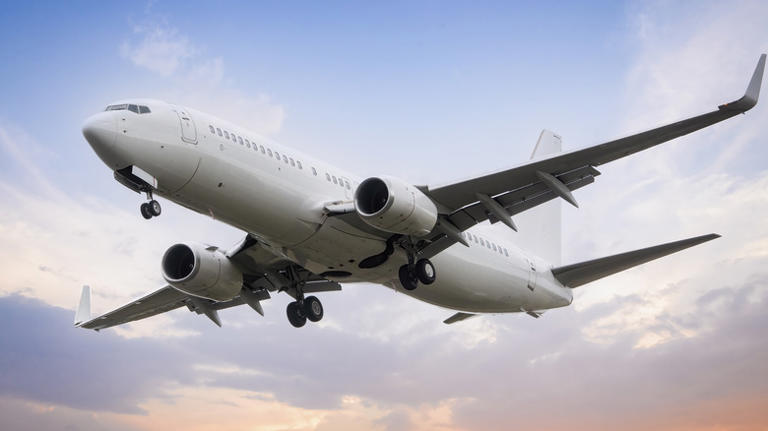
- Credit cards
- View all credit cards
- Banking guide
- Loans guide
- Insurance guide
- Personal finance
- View all personal finance
- Small business
- Small business guide
- View all taxes
You’re our first priority. Every time.
We believe everyone should be able to make financial decisions with confidence. And while our site doesn’t feature every company or financial product available on the market, we’re proud that the guidance we offer, the information we provide and the tools we create are objective, independent, straightforward — and free.
So how do we make money? Our partners compensate us. This may influence which products we review and write about (and where those products appear on the site), but it in no way affects our recommendations or advice, which are grounded in thousands of hours of research. Our partners cannot pay us to guarantee favorable reviews of their products or services. Here is a list of our partners .
The Guide to Air Canada Wi-Fi

Many or all of the products featured here are from our partners who compensate us. This influences which products we write about and where and how the product appears on a page. However, this does not influence our evaluations. Our opinions are our own. Here is a list of our partners and here's how we make money .
Table of Contents
Does Air Canada have Wi-Fi?
How much is wi-fi on air canada, does air canada have free wi-fi, how to save on air canada wi-fi costs using credit cards, how to connect to air canada wi-fi, if you want to connect to air canada wi-fi.
For some travelers, staying connected in the air is essential to flying. Whether you respond to business emails before arrival or keep up to date with your social networks, Air Canada generally offers some level of Wi-Fi access, depending on your flight details.
If you're planning an Air Canada trip soon, here’s what you should know about in-flight Air Canada Wi-Fi.
» Learn more: The points collector’s guide to Air Canada Aeroplan
All Air Canada Rouge (Air Canada's low-cost subsidiary) customers can access high-speed Wi-Fi during their flight. Premium Rogue customers can enjoy complimentary Wi-Fi, while economy customers have Wi-Fi available for purchase.
Air Canada is working on growing its Wi-Fi capable aircraft. Currently, the carrier offers Gogo-equipped Wi-Fi, but connectivity is limited to certain North American and international flights.
Nearly all of Air Canada’s wide-body planes have streaming-quality Wi-Fi and most of Air Canada’s narrow-body aircraft are also equipped with Wi-Fi.
The exception is the 737 MAX 8 (7M8) fleet, where connectivity is still in progress. As of this writing, just 25% of Air Canada’s 737 MAX 8 (7M8) aircraft have Wi-Fi connectivity.
You can check if Air Canada in-flight Wi-Fi is available on an aircraft before booking your flight. Simply check that the Wi-Fi logo is present in the flight details to confirm that the aircraft is Wi-Fi connected. Keep in mind that you’ll need to verify in-flight Wi-Fi for each flight on a multi-leg trip.
Additionally, you can use the Air Canada Wi-Fi tool on the airline’s website to check if your upcoming flight has Wi-Fi access. You can check this detail using your flight number and departure date, or using your flight route and departure date.
» Learn more: Getting elite status on Air Canada with the Aeroplan credit card
Air Canada passengers can pre-purchase one of three Wi-Fi pass options or purchase a pass at in-air pricing — possibly at a higher cost — after boarding. The pass options include:
Air Canada 1-Hour Pass $4.77 ($6.50 CAD). Offers one continuous hour of Wi-Fi access during the flight.
Air Canada 1-Way Pass $15.41 ($21.00 CAD). Offers internet connectivity during the entire length of your flight.
Air Canada Monthly Plan $48.40 ($65.95 CAD). A monthly subscription for internet access on all Air Canada Wi-Fi capable aircraft between Canada, U.S., and Mexico.
With a pass you can browse the internet, check email, scroll updates on social media and send text messages via Wi-Fi. However, in-flight Air Canada Wi-Fi doesn’t support Voice Service and Voice over IP.
Air Canada’s Aeroplan loyalty program offers complimentary Wi-Fi access for its 75K Status and Super Elite Aeroplan members. Specifically, this benefit offers a 12-month plan for Gogo Wi-Fi for up to five devices. Only one device can be logged into in-flight Wi-Fi at a time.
Additionally, Aeroplan members have access to free texting. To access this complimentary feature, members must add their Aeroplan number to their booking information before checking in to the flight.
Unfortunately, Air Canada’s Aeroplan® Credit Card doesn’t offer free or discounted Wi-Fi access as a travel benefit. However, one way to cover all or part of the cost of Wi-Fi is through a travel rewards credit card.
If you carry a card that provides an annual travel credit you haven’t claimed yet, you can subsidize the cost of a Wi-Fi pass using your card’s benefit. Some credit cards that offer travel credit that can be applied to in-flight Wi-Fi charges include:
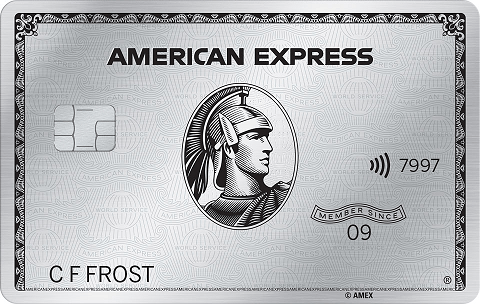
on American Express' website

on Bank of America's website

on Chase's website
Up to $200 annually with your preferred airline. Enrollment required. Terms apply.
Up to $100 annually.
$300 annual statement credit for travel purchases.
» Learn more: The best travel credit cards right now
Once comfortably in your seat, you can connect to Wi-Fi on Air Canada flights in three simple steps.
Go to “Settings” on your mobile device. Set your device to “Airplane mode” and turn on Wi-Fi.
Select “ACWiFi.com” to connect to the airline’s Wi-Fi network.
Launch your browser and go to “acwifi.com” and follow the instructions from there.
If you need technical support during your flight, select “Wi-Fi Onboard” for assistance from Air Canada’s Wi-Fi service provider.
Unless you have 75K or Super Elite Aeroplan status, chances are Air Canada Wi-Fi will cost you. You might be able to save a few bucks by purchasing your pass ahead of time if you’re sure you’ll need to be connected.
The good news is the airline is focusing its efforts on getting free in-flight Air Canada Wi-Fi for all its passengers in the future. It’s testing out “full, fast and free” Wi-Fi for its regional flights and plans on expanding that to its other customers.
How to maximize your rewards
You want a travel credit card that prioritizes what’s important to you. Here are our picks for the best travel credit cards of 2024 , including those best for:
Flexibility, point transfers and a large bonus: Chase Sapphire Preferred® Card
No annual fee: Bank of America® Travel Rewards credit card
Flat-rate travel rewards: Capital One Venture Rewards Credit Card
Bonus travel rewards and high-end perks: Chase Sapphire Reserve®
Luxury perks: The Platinum Card® from American Express
Business travelers: Ink Business Preferred® Credit Card
On a similar note...

Watch CBS News
U.S. issues travel warning for Israel with Iran attack believed to be imminent and fear Gaza war could spread
By Debora Patta , Tucker Reals
Updated on: April 13, 2024 / 5:25 PM EDT / CBS News
Update: Iran launched drone attacks against Israel on Saturday. Read CBS News' latest coverage here .
Tel Aviv — Israel is bracing for a worst-case scenario that U.S. officials believe could materialize within just hours — the possibility of a direct attack on Israeli soil by Iran in retaliation for a strike almost two weeks ago that killed seven Iranian military officers. Iran has vowed to take revenge for Israel killing its commanders, who were hit by an April 1 strike on the Iranian embassy in Syria's capital.
Two U.S. officials told CBS News that a major Iranian attack against Israel was expected as soon as Friday, possibly to include more than 100 drones and dozens of missiles aimed at military targets inside the country. Sources have told CBS News the retaliation could include attacks carried out both by Iranian forces, and proxy groups around the region that it has been funneling additional arms to for weeks.
The officials said it would be challenging for the Israelis to defend against an attack of that magnitude, and while they held out the possibility that the Iranians could opt for a smaller-scale attack to avoid a dramatic escalation, their retaliation was believed to be imminent.
Asked Friday how imminent he believes an attack is, President Biden responded, "I don't want to get into secure information, but my expectation is sooner than later." The president urged Iran not to move forward, saying his message to Tehran was: "Don't."
Tehran has not indicated publicly how or when it will return fire, so it's unclear how far Iran's leaders will go. If they decide to carry out a direct attack on Israel, there's fear it could blow Israel's ongoing war against Iranian ally Hamas up into a much wider regional conflict.
With the Iranian retaliation expected at any time, the U.S. State Department on Thursday warned Americans in Israel not to travel outside major cities, which are better protected from incoming rocket fire by the country's Iron Dome missile defense system. The latest guidance noted that travel by U.S. government employees in Israel could be further restricted with little notice as things develop in the tinderbox region.
"Whoever harms us, we will harm them," Prime Minister Benjamin Netanyahu vowed Thursday as he visited troops at an Israel Defense Forces airbase. "We are prepared … both defensively and offensively."

On Saturday, all U.S. embassies in the Middle East were put on high alert and required to hold emergency action committee meetings. Diplomats in Lebanon and Israel were specifically told not to travel to certain areas within those countries.
Sima Shine, a security expert and former official with Israel's national intelligence agency Mossad, told CBS News it was a dangerous moment for the region, and the "most worried" she has been. She said anxiety over an all-out war was likely just as high "on both sides, in Israel and in Iran."
If Iran does choose to strike Israel directly, it could involve a complex missile and drone attack similar to the one Iranian forces launched against a Saudi oil facility in 2019 .
"They will try to do it on the military or some military asset," Shine predicted. "But the question will be the damage. If there would be many injured people, killed or injured … I think it has the potential for a huge escalation."

Shine stressed, however, that she still believes neither side actually wants a regional conflict.
U.S. "really trying to avoid war"
The U.S. sent a senior general to Israel this week to coordinate with the close American ally on any response it might make to an Iranian attack. Speaking Friday on "CBS Mornings," America's top military officer said, "we're really trying to avoid war."
"This is part of the dialogue that I have with my counterparts within the region, to include the Israeli chief of defense, who I talked to yesterday," said Joint Chiefs chairman Gen. Charles Q. Brown, Jr., adding that the U.S. military was "doing things not only to prevent a war, but at the same time, one of my primary things is to make sure all the forces in the region are protected."
"My role, as the chairman of the Joint Chiefs, is to plan and prepare," Brown said. "That's one thing we do very well."
Brown's Israeli counterpart, Chief of the General Staff Lt. Gen. Herzi Halevi, "completed a comprehensive situational assessment on the readiness of the IDF for all scenarios," Israel's military said Friday.
"The IDF is very strongly prepared, both offensively and defensively, against any threat," Halevi was quoted as saying in the statement. "The IDF continues to monitor closely what is happening in Iran and different arenas, constantly preparing to deal with existing and potential threats in coordination with the United States Armed Forces."
The IDF said the visiting U.S. general, Central Command chief Gen. Michael Erik Kurilla, was taking part in the IDF's situational assessment.
The dilemma for Iran, said Israeli expert Shine, is to figure out how to deliver its promised response to Israel's attack in Syria, but in a way that does not lead to further escalation. Likewise, Shine said Israel could choose to show restraint when it responds to whatever Iran eventually does.
If either side gets the balance wrong, the consequences for the region, and even the world, could be dire.
Weijia Jiang, David Martin, Margaret Brennan and Olivia Gazis contributed reporting.
- Middle East
- Benjamin Netanyahu
Debora Patta is a CBS News foreign correspondent based in Johannesburg. Since joining CBS News in 2013, she has reported on major stories across Africa, the Middle East and Europe. Edward R. Murrow and Scripps Howard awards are among the many accolades Patta has received for her work.
More from CBS News

Body found of missing teen whose disappearance sparked deadly settler attack
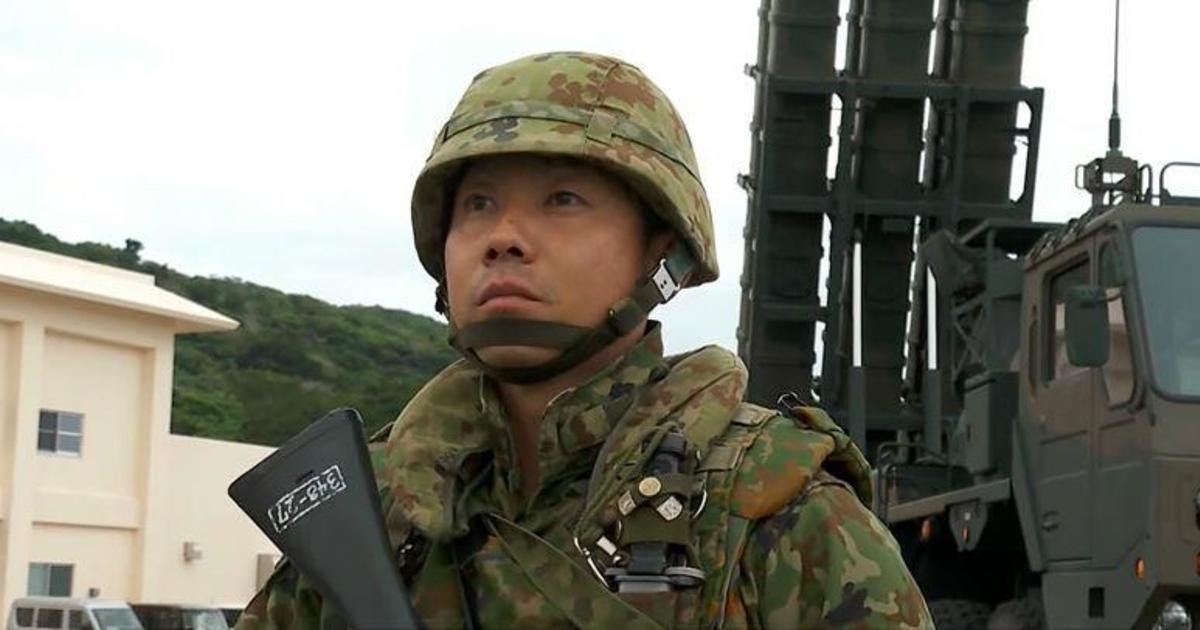
China-Taiwan tension brings missiles and anxiety to a Japanese paradise
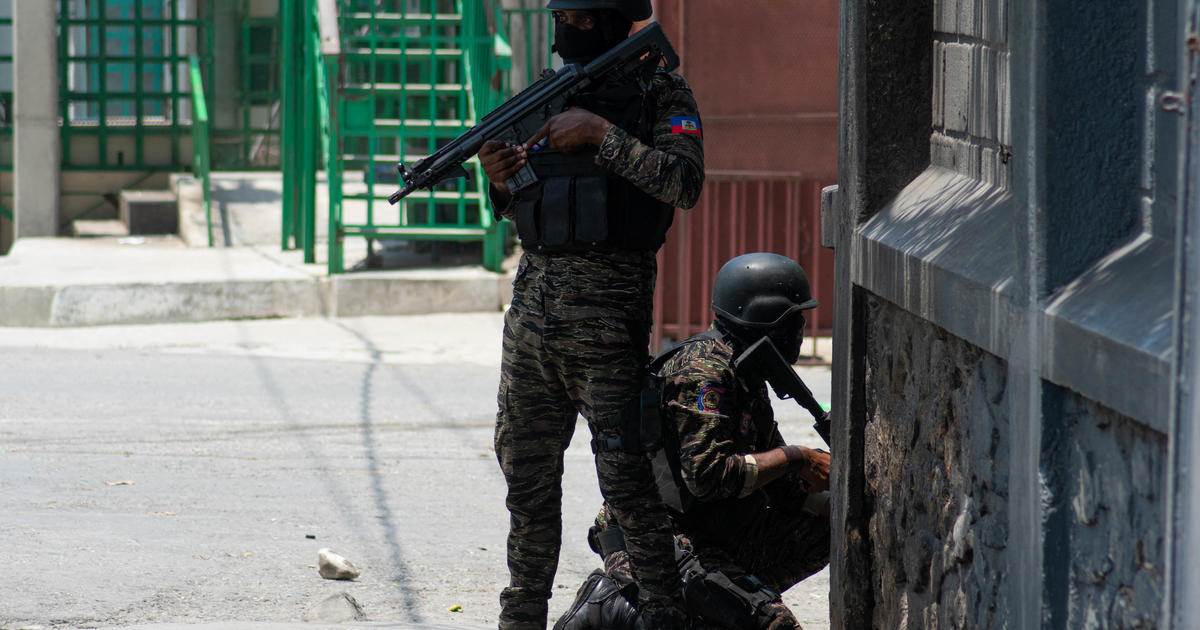
Time runs out for Americans hoping to flee chaos in Haiti
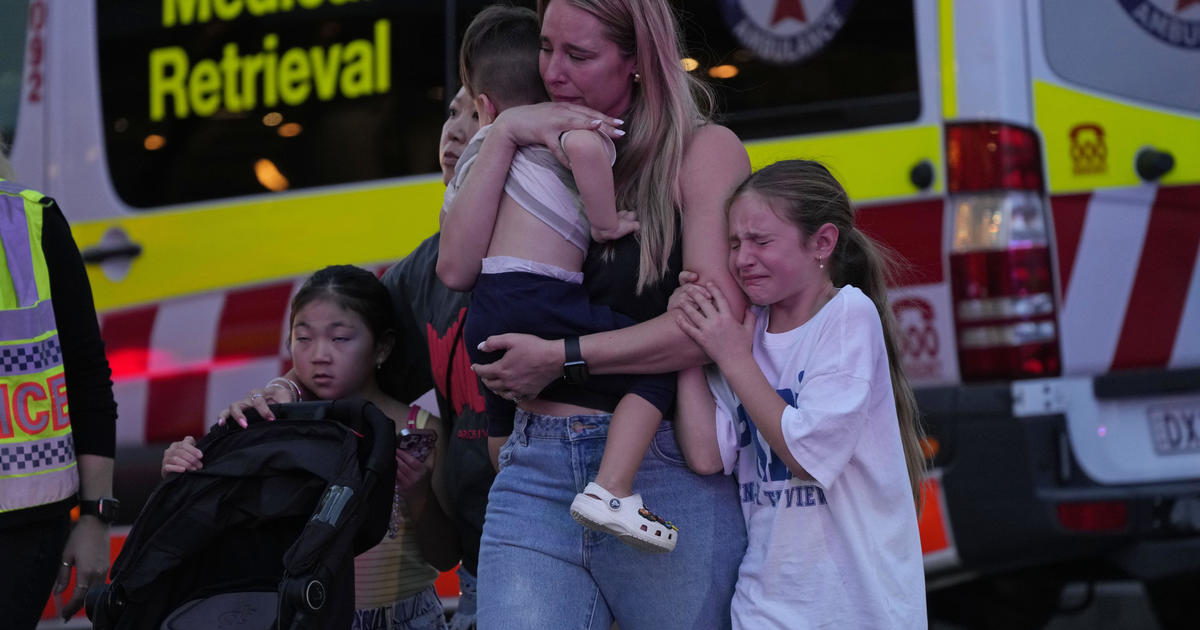
6 dead after stabbing attack in Australia; suspect killed

Solar eclipse 2024: Photos from the path of totality and elsewhere in the U.S.
Images show the Great American Eclipse, seen by tens of millions of people in parts of Mexico, 15 U.S. states and eastern Canada for the first time since 2017.
Millions gathered across North America on Monday to bask in the glory of the Great American Eclipse — the moment when the moon passes between the Earth and the sun.
The path of totality measures more than 100 miles wide and will first be visible on Mexico’s Pacific coast before moving northeast through Texas, Oklahoma, Arkansas, Missouri, Illinois and upward toward New York, New Hampshire and Maine, then on to Canada.
Total solar eclipse 2024 highlights: Live coverage, videos and more
During the cosmic spectacle, the moon’s movements will temporarily block the sun’s light, creating minutes of darkness, and will make the sun's outer atmosphere, or the corona, visible as a glowing halo.
Here are moments of the celestial activities across the country:
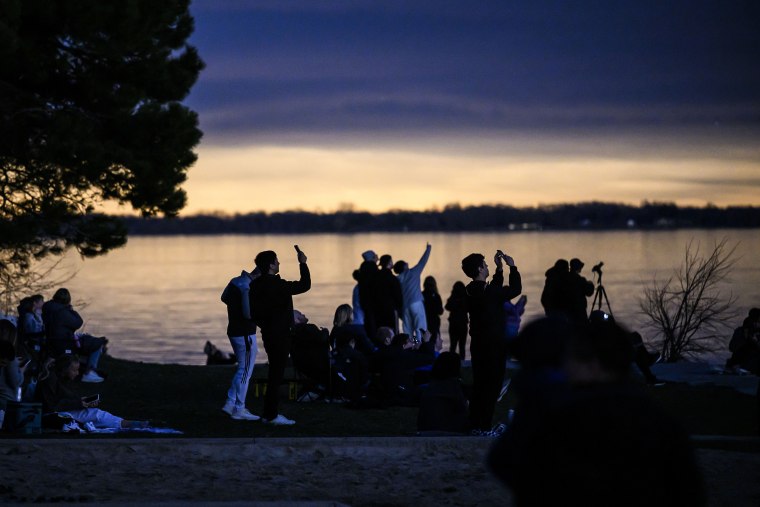
Breaking News Reporter
Elise Wrabetz is a Senior Photo Editor for NBC News digital
Chelsea Stahl is the art director for NBC News Digital
- Share full article
Advertisement
Supported by
F.B.I. Examining Free Airfare Upgrades Received by Adams
Federal prosecutors and F.B.I. agents are scrutinizing international flights taken by Mayor Eric Adams of New York aboard Turkey’s national air carrier, Turkish Airlines.

By William K. Rashbaum , Michael Rothfeld and Dana Rubinstein
Federal authorities investigating Mayor Eric Adams’s campaign fund-raising have been examining valuable flight upgrades they believe he received from Turkish Airlines that elevated him to its highest class of seats available on international trips, according to people with knowledge of the matter.
The scrutiny is part of a broad corruption inquiry that has already led the F.B.I. to search the homes of the former top New York-based executive of Turkish Airlines and aides to Mr. Adams, who has frequently traveled abroad and has made no secret of his affinity for flying on the Turkish carrier.
The investigation burst into public view in November after F.B.I. agents searched the homes of the former airline executive, Cenk Öcal, the mayor’s liaison to the Turkish community, Rana Abbasova, and his chief fund-raiser, Brianna Suggs — and seized Mr. Adams’s electronic devices.
The inquiry has shaken an administration that has become increasingly mired in investigations and beset by legal and ethical problems .
The broader investigation has focused at least in part on whether the Turkish government conspired with Mr. Adams’s mayoral campaign to funnel foreign money into its coffers, and whether Mr. Adams pressured the New York City Fire Department to sign off on Turkey’s new high-rise consulate in Manhattan despite safety concerns.
Mr. Adams’s relationship with Turkish Airlines has extended beyond that of simply being a passenger. He has attended meetings and events with representatives of the air carrier, which is half-owned by the Turkish government’s sovereign wealth fund. Some of those interactions took place in the presence of Turkish business leaders and diplomats with their own close ties to Turkey’s government and its president, Recep Tayyip Erdoğan.
Federal prosecutors in Manhattan and F.B.I. agents conducting the inquiry have developed evidence that Mr. Öcal helped arrange at least some of the upgrades in coordination with Ms. Abbasova, two of the people familiar with the federal investigation said. They and others interviewed for this article spoke on condition of anonymity to discuss the ongoing federal investigation.
Mr. Adams, who extolled Turkish Airlines in 2017 when he told a pro-government publication that the carrier “is my way of flying,” received the upgrades both while serving as Brooklyn borough president and as mayor, on both official and personal trips, some of the people said.
Brendan R. McGuire, a lawyer for the mayor and his 2021 campaign, said there was nothing wrong with Mr. Adams’s receipt of the upgrades.
“As borough president, the mayor consistently disclosed his official travel to Turkey, did not receive any improper upgrades and did nothing inappropriate in exchange for an upgrade,” Mr. McGuire said. “Speculation is not evidence. We look forward to a just and timely conclusion to this investigation.”
The F.B.I. searches on Nov. 2 prompted the mayor’s abrupt return from a trip to Washington, D.C., where he was seeking federal aid for the city’s migrant crisis. They were followed by weeks of news coverage focused on the corruption inquiry, but agents and prosecutors have made few public moves since then.
Mr. Adams has not been accused of wrongdoing, and it remains unclear whether the investigation will lead to criminal charges against him, Mr. Öcal, Ms. Abbasova or anyone else.
A lawyer for Ms. Abbasova, Rachel Maimin, declined to comment. After repeated attempts to reach Mr. Öcal, including visits to his New Jersey home and messages left with his wife, he declined to answer questions or provide the name of his lawyer.
A representative of Turkish Airlines declined to comment, as did spokesmen for the F.B.I. and the federal prosecutors from the U.S. attorney’s office for the Southern District of New York, who are jointly conducting the inquiry.
Mr. Adams has long boasted of being an avid traveler, and he has taken trips in recent years to Turkey, the Dominican Republic , Trinidad and Tobago, Ecuador, Colombia, Mexico, Monaco , Ghana , Azerbaijan, Greece, Israel , Jordan, Saudi Arabia, Qatar , Senegal and China . He has talked about retiring to Azerbaijan, Israel and Lebanon.
It was unclear how many free upgrades Mr. Adams accepted while flying Turkish Airlines or what their total value was. In 2023, round-trip business class seats on Turkish Airlines between the United States and Turkey generally cost at least $3,400 apiece — or about four times as much as an economy class seat, travel industry experts said.
It was also unclear what, if anything, Mr. Öcal, the airline or the Turkish government might have gained from awarding the upgrades.
But Mr. Adams received the upgrades during a period in which he and the airline were developing a close relationship, a New York Times review of city emails suggests.
Mr. Adams has flown on Turkish Airlines since at least August 2015, when as Brooklyn borough president he took an official trip to Turkey and the carrier funded travel that his aides valued at about $1,500.
Mr. Adams took a second official trip four months later, justifying it by saying he needed to speak about “city marketing” at a conference, meet with local officials and visit a refugee camp, city records show. Mr. Adams flew Turkish Airlines on that trip as well, according to the records.
On another trip to Turkey in 2017, this time in a private capacity, he gave an interview praising Turkish Airlines to The Daily Sabah, saying that it accommodated his dietary needs and lauding its security protocols.
Sent from 2015 to 2021, while Mr. Adams was borough president, the emails reviewed by The Times make reference to a series of private meetings between Mr. Adams, Turkish Airlines executives and Turkish government officials and businesspeople, as well as appearances with them at public events.
Often the meetings and appearances were arranged through Ms. Abbasova, Mr. Adams’s liaison to the Turkish community.
More than a few involved Mr. Öcal, who appeared to be on a first-name basis with Mr. Adams. “Cenk from turkish airlines opening,” Mr. Adams wrote to his staff in response to one invitation to an event, possibly referring to Mr. Öcal’s speaking slot. Mr. Öcal would later serve as one of several hundred people on Mr. Adams’s mayoral transition team.
The first meeting described in the emails was scheduled for May 2016, when Ms. Abbasova inquired if he could attend a “dinner w Turkish Airlines.” The emails did not specify with whom he would be meeting, but his assistant responded that he would be available.
He agreed to another meeting, a dinner with Mr. Öcal at Liman, a Turkish restaurant in Brooklyn, in April 2017, the emails show. Also scheduled to attend were the chairman and treasurer of the Türken Foundation, an American charity with close ties to the Turkish government. It was incorporated in 2014 by a son of Mr. Erdoğan and another man, who at the time was a board member of Turkish Airlines. Mr. Erdoğan’s daughter currently sits on its board .
The Türken Foundation’s chairman, Behram Turan, its treasurer, Memiş Yetim, and another board member would go on to give a total of $6,000 to Mr. Adams’s mayoral campaign from 2018 to 2021, contributions that were first reported by The City . Mr. Adams’s campaign refunded $1,000 to Mr. Turan to comply with the rules of the city’s public matching funds program.
Reached late last year, Mr. Turan, an engineer who lives in New Jersey, said he was an American citizen who has lived in the country for 30 years. He added that there was nothing inappropriate about his donation. On Thursday, Mr. Yetim said he could not remember the dinner with Mr. Adams. Mr. Turan declined to comment.
In September 2017, Mr. Adams attended a Türken Foundation dinner and event with Mr. Erdoğan at the Mandarin Oriental hotel in Manhattan. Mr. Adams would later present Mr. Yetim with a proclamation honoring the Türken Foundation for “outstanding achievements and contributions to society.”
In December 2017, Mr. Adams was scheduled to attend another dinner, this time with Turkish consular officials, at a Brooklyn seafood restaurant run by two of his close friends . Mr. Öcal and another top Turkish Airlines official were on the guest list, the emails show.
In 2019, the emails show, Ms. Abbasova passed along an invitation from Turkish Airlines for Mr. Adams to attend a gala at the Metropolitan Club in Manhattan. Mr. Adams had another event that night but an internal staff memo noted that he would do his best to attend, the emails show. Ms. Abbasova would be on site and provide frequent updates, the memo said.
Mr. Adams did make it to the event, which featured Turkish dishes, a raw bar and high-end cocktails. He even took the microphone to speak, according to an article in Elite Traveler, a luxury lifestyle publication, which published photos of the event, including several of Mr. Öcal in a shiny blue tuxedo. Mr. Adams was the only city official listed in the account of the night, along with Turkish consular officials and diplomats, business leaders and Martha Stewart.
Mr. Adams won the Democratic mayoral primary in June 2021. Soon after, he contacted the commissioner of the New York Fire Department at the time and urged him to allow the opening of the Turkish consulate building, which had been held up over fire safety concerns. The building received a temporary certificate of occupancy that September — shortly before Mr. Erdoğan presided over the consulate’s grand opening in Manhattan .
Mr. Adams previously said it was part of his role as borough president “to notify government agencies of issues on behalf of constituents and constituencies.”
In May 2022, the Turkish Philanthropy Funds , a New-York based nonprofit devoted to supporting social investments in the Turkish and Turkish American communities, held its 15th anniversary gala at the Metropolitan Museum of Art. Mr. Adams, who made remarks at the event, was there in a dark suit, posing with the foundation’s chairman and the night’s honoree, the billionaire founder of the strained yogurt company Chobani.
Mr. Öcal was there too, and was photographed in a tuxedo with the Turkish ambassador to the United States and their wives. It is unclear if he interacted with Mr. Adams that night. Their fortunes had gone in opposite directions.
Mr. Öcal had been fired by Turkish Airlines by then, according to a Turkish news report, and Mr. Adams was newly ensconced as the mayor.
Susan C. Beachy contributed reporting.
William K. Rashbaum is a senior writer on the Metro desk, where he covers political and municipal corruption, courts, terrorism and law enforcement. He was a part of the team awarded the 2009 Pulitzer Prize for Breaking News. More about William K. Rashbaum
Michael Rothfeld is an investigative reporter in New York, writing in-depth stories focused on the city’s government, business and personalities. More about Michael Rothfeld
Dana Rubinstein covers New York City politics and government for The Times. More about Dana Rubinstein
Explore Our Coverage of the Adams Administration
Contacting the Mayor’s Office: Mayor Eric Adams is now requiring any elected official, including members of Congress , to submit a lengthy online request to speak to an administration official.
Campaign Inquiry : Federal authorities investigating Adams’s campaign fund-raising have been examining valuable flight upgrades they believe he received from Turkish Airlines that elevated him to its highest class of seats available on international trips.
Burger King and Baptisms: Adams keeps finding eye-catching ways to seize the spotlight on the issue of public safety , even when the narrative turns against him.
Gun-Detecting Technology: Adams announced that New York City planned to test technology to detect guns in its subway system as officials seek to make transit riders feel safe after a deadly shoving attack.
Grappling With Acts of Violence: Adams was recently confronted with two tragic events that crystallized some people’s persistent fears about the city: the shooting death of Police Officer Jonathan Diller and a man being fatally pushed into the path of a subway train in an unprovoked attack.
Sexual Misconduct Accusations: A woman has accused Adams in a lawsuit of asking her for oral sex in exchange for career help in 1993 and sexually assaulting her when she refused. Adams said the accusation was completely false .

COMMENTS
It's worth keeping in mind that boarding the plane isn't a free-for-all, either. Airlines typically start boarding passengers 30 minutes before takeoff in groups. Generally, a boarding time ...
Arrive at the airport early. Most airlines recommend arriving at the airport three hours before an international flight or two hours before a domestic flight. If you're a first-time flier, give ...
FIRST TIME FLYING - THIS IS EXCITING! You will never forget your first flight. The moment the flight attendants welcome you on board for the first time, the butterflies in your stomach as you take off and meet the person sitting next to you. You'll always remember your seat number and the first safety demonstration by the cabin crew.
43. Getting on the Plane. When you get on the plane, there is usually a flight attendant at the front who will guide first-time flyers to their seat or answer any questions. Otherwise, just walk to your seat and make sure to check above the seat for the letter that corresponds to the window, middle, or aisle seat.
Before your flight: 1. Add your flight to your calendar. Set the alarm for your flight and include the flight details on your smartphone. Make sure you have the correct date, time, and departure gate. Let others know you will be flying and give all the flight information in case of an emergency.
24 Keep your passport, ID and boarding pass handy. There are many first time flyers tips and this one is important. You want to decide on one place to keep your passport, ID and boarding pass and keep them there at all times. This needs to be someplace that you can easily retrieve and then put away quickly.
The Transport Security Administration ( TSA) recommends checking in at least 90 minutes before a domestic flight and three hours prior to an international flight. Prepare all required documents (passports, visas, vaccine cards, etc.) for check-in. Collect your boarding passes, luggage tags, and original documents before leaving the counter.
Best Tips for First-Time Flyers. 1. Check-in online. Most airlines allow you to check in online up to 24 hours before your flight. This will help you avoid long lines at the airport and give you a better chance of avoiding a middle seat assignment.
During the Flight. A first flight can be thrilling and a tad daunting. Commercial airplanes cruise at about 575 mph at altitudes of 35,000-40,000 feet. While this might sound intimidating, remember that air travel is one of the safest forms of transportation. You'll likely experience a few bumps (turbulence) during the flight, but these are ...
Tip 2: Jet Lag is Real. For long haul flights, adjust your sleeping and eating schedule to the destination time zone before you travel. Now you're ready to face your first flight with confidence. Don't forget to savor the experience. After all, you only have one first flight.
First things first. The first step in airline travel is booking your flight. Start by choosing your destination and preferred travel dates. Visit airline websites or online travel agencies to compare prices and flight options. Consider factors such as layovers, airline reputation, and baggage allowances when making your decision.
Airport Tips. 10. Arrive Early. If it's your first time flying, arriving early at the airport can help reduce any stress and anxiety. Unexpected delays, like long lines for check-in or security, can occur, so it's wise to give yourself extra time to handle them without worrying about missing your flight.
Give yourself at least a 2-hour layover between connecting flights. Add more time to your layover if you want to eat, freshen up in the bathroom, etc. Red-eye flights are often cheaper but at the expense of traveling at night. RED-EYE FLIGHTS: You might see a "+1" on some flights, or see flights that fly overnight.
It's Normal to Feel Some Nerves When Flying For the First Time. It's natural to feel nervous when flying for the first time, so there are a few things we recommend to ease the nerves. Arrive at the airport early. Before your flight, eat a light meal, stay hydrated and avoid caffeine and alcohol. If possible, travel with a friend or family ...
Tips for first-time flyers before your travel date. You're about to fly to a new country- yay congratulations!! ... First time flight: Tips for when you board the airplane. Only sit on the seat number allocated to you on your boarding pass. Seat numbers look like 35A, 1B, & 27C and they are always located on the overhead bin above the plane ...
While fares to Louis Armstrong New Orleans International Airport (MSY) totaled $94, fees for "perks" like a carry-on bag and seat selection caused the total price for a round-trip flight to jump to $322. On Spirit's website, some of the fares from Newark were astonishingly low, starting at $27 one-way.
Advice for First Time Travelers Part 1. Tuesday, October 13, 2020. Even if you're a frequent flyer, the screening process can be overwhelming at times. For the uninitiated first-time traveler, it can be even worse. Follow along in our short blog series where we will share tips for first time flyers, frequent travelers and people who just want ...
This first section of tips for first-time flyers covers planning a trip and booking your first flight. While it can be as easy as going to an airline's website and booking the first flight you can find, there are lots of ways to save money and ensure that you're getting the best deals. Check Current Promotions for Travel Credit Cards
Here are our top ten tips for your first time flying. 1. Double-check required travel documents. If you're planning to fly for the first time, you'll need to produce the necessary documents to travel by plane. Those leaving the country must retain a passport in order to leave the U.S.
Airplane Travel; 19+ Super Helpful First Time Flying Tips; 19+ Super Helpful First Time Flying Tips. By Riley / June 10, 2020 . If you've never flown on a plane before and have only done road trips, thinking about it can be both exciting and nervewracking.
But, for your first trip - give yourself two hours. yeah, it's probably overkill, but better safe than sorry. For more tips on how early to get to the airport check out our entire guide here.. As you get more proficient at traveling you will start to dial in a time frame that fits your rhythm and "travel skills.". Air Travel Tip #2: Don't over pack (and don't check your bag!)
9. Sit near an exit to calm your nerves. If you're very nervous about flying for the first time, it may calm your nerves to be close to an exit. It depends on which airline you're flying on, but certain airlines allow you to pick your seat before boarding. See if you log on to the airline's website with your reservation number and view a ...
Whether you're a frequent jet-setter or first-time flyer, there are plenty of common air travel mistakes that can add turbulence to your flight experience.
In order to avail such tax exemption/reduction, passengers must declare their correct nationality at the time of booking. In case citizens of Nepal or Maldives intend to travel with any foreign nationals, such citizen (passenger) are requested to kindly book tickets for accompanying foreign national (passengers) in a separate PNR/ticket.
Unfortunately, Air Canada's Aeroplan® Credit Card doesn't offer free or discounted Wi-Fi access as a travel benefit. However, one way to cover all or part of the cost of Wi-Fi is through a ...
XB-1's first flight met all of its test objectives, including safely reaching an altitude of 7,120 feet (2,170 meters) and speeds of up to 238 knots (273 miles per hour).
SFGATE contributor Jim Glab rounds up air travel and airport news for our weekly column Routes By Jim Glab April 13, 2024 FILE - A passenger plane passing over the full Beaver Moon before ...
U.S. issues travel warning for Israel as Iran expected to attack any time Hamas says 3 of leader Ismail Haniyeh's sons killed in Israeli strike Biden calls Netanyahu's handling of the war in Gaza ...
Images show the Great American Eclipse, seen by tens of millions of people in parts of Mexico, 15 U.S. states and eastern Canada for the first time since 2017. Print April 8, 2024, 6:24 PM UTC
Federal prosecutors and F.B.I. agents are scrutinizing international flights taken by Mayor Eric Adams of New York aboard Turkey's national air carrier, Turkish Airlines.